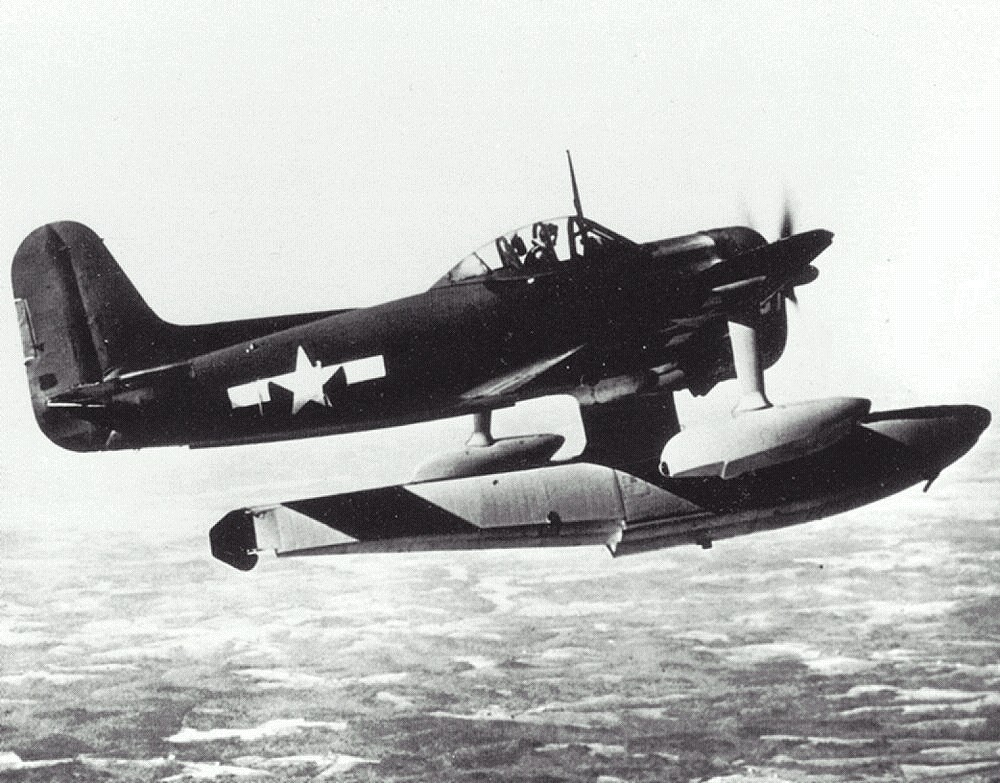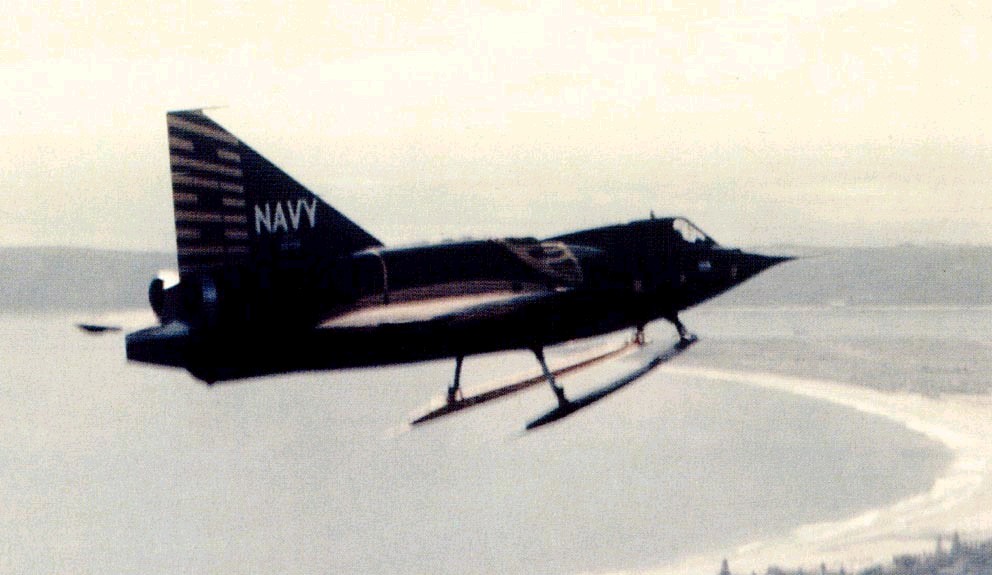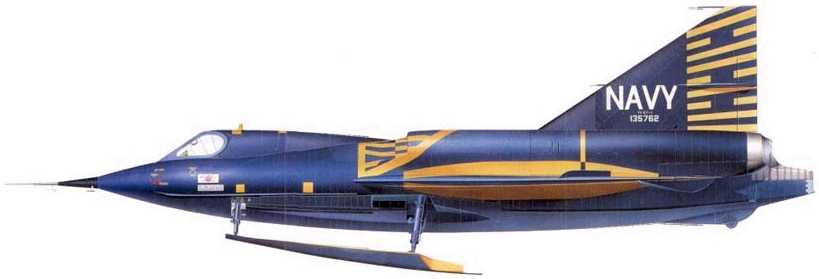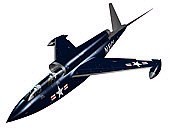 Retro-Look: What if the U.S. Navy had continued Operating Fast SeaPlanes from Destroyers, Cruisers and Battleships after WW2?
Retro-Look: What if the U.S. Navy had continued Operating Fast SeaPlanes from Destroyers, Cruisers and Battleships after WW2?
 Retro-Look: What if the U.S. Navy had continued Operating Fast SeaPlanes from Destroyers, Cruisers and Battleships after WW2?
Retro-Look: What if the U.S. Navy had continued Operating Fast SeaPlanes from Destroyers, Cruisers and Battleships after WW2?
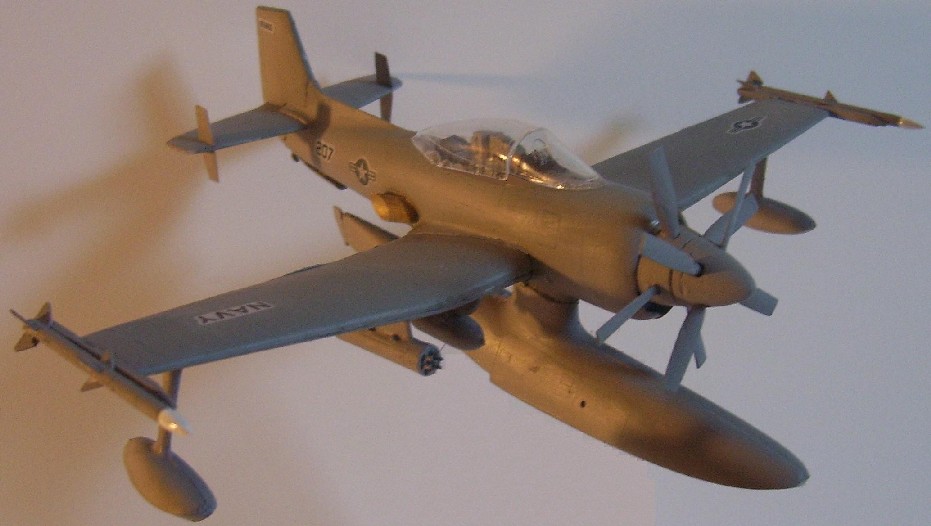
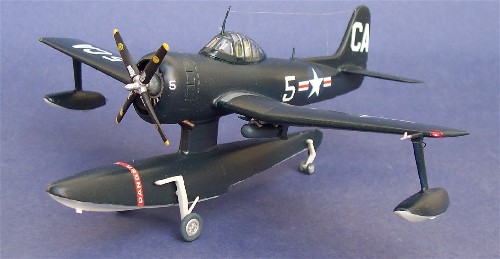
Seaplane: any aircraft that can operate at sea
One of the reasons why naval warfare like land and air warfare is so screwed up is because those involved do not properly see the FUNCTIONS of their equipment and try to label them according to just their composition. This narrow-minded view fails to appreciate in actuality, seaplanes are more than just planes that can land on the water by boat hull fuselages, floats or skis, but also aircraft that are salt-water hardened and can take-off and land from the deck of ships and submarines via tail-hook or vertical hovering/landing.
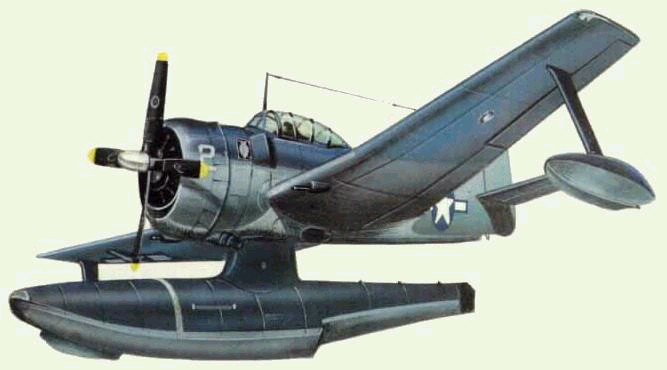
The bottom line here is TO GET AIRCRAFT TO SEA any way we can so the 3rd dimension of battlespace above the water can be leveraged. In this web page we will focus in on SMALL seaplanes operating from ships but refer to LARGE seaplanes that can operate from land bases or pit-stop from ships on the web pages below:
The mythology of WW2 holds that the U.S. Navy was at its best; close examination reveals that the service that let its ass get kicked at Pearl Harbor with its snobby mentality was just a white uniformed version of the "From Here to Eternity" mentality of the Army at nearby Schofield barracks. The only movie that even hints at how screwed up the snobby U.S. Navy was, is Otto Preminger's "In Harm's Way" made in 1965. The little things that saved the U.S. Navy in the early days of WW2; the PBY Catalina seaplane, the Gato patrol class submarine, PT boats, blimps and seaplanes were quickly discarded after the war in a frenzy to exalt the aircraft carrier worship mythology.
 Take a peek at U.S. Naval Aviation News from 1945:
Take a peek at U.S. Naval Aviation News from 1945:
www.history.navy.mil/nan/backissues/1940s/1945/15jan45.pdf
Not only are they doing COMBAT RESCUE of Sailors in the water from long-range ASW blimps, they were making important, tangible, physical capability improvements resulting in them able to do things we CANNOT DO TODAY. Naval Aviation News is online and is a treasure trove of "reality 101". Compare 1944's CONTENT (Each January issue has the INDEX for the year before's articles) to 2004's CONTENT:
www.history.navy.mil/nan/currentissue/currentnd04.htm
You are going to notice today's CONTENT is a bunch of fascist lemming PR crap which is very weak in comparison to the 1944 magazine's IN DEPTH and DETAILED professional technotactical information.
We are getting weaker not stronger when we can't even fukin tell the truth candidly in our own professional magazines.
Submarines were only saved by the lifelong crusade of Admiral Rickover and a helpful common-sense Congress. The big things that made the USN successful, her 25 x heavily armored battleships whose mighty guns cleared the way for beach landing of Army/marine troops and the almost 100 escort carriers made from cargo ships that swept the seas clean of enemy surface ships and aircraft were scrapped or turned into museums DESPITE THE FACT THAT WW2 MYTHOLOGY IS INCORRECT: ONLY 2 AMERICAN BATTLESHIPS WERE LOST IN ALL OF WW2; the USS Arizona and USS Oaklahoma both OLD 1916 World War 1 battleships at that, and only because they were caught stationary at Pearl Harbor. Once moving NO AMERICAN BATTLESHIPS or heavy Balitimore or Alaska class cruisers were ever sunk by ANYTHING, and no foreign nation battleships were ever sunk if they were moving and had effective air cover SPOILING the aim of the attacking aircraft dropping bombs/torpedoes or guided munitions. "Sea Control" was a tangible goal and not a DoD buzzword at the time thanks to the enemy's pressure that made us do the right things. Once WW2 was underway and the Washington treaty 10, 000 ton cruiser limits were invalidated, the Navy got its act together under fire with the Baltimore class and after the war continued with the even better armored Des Moines heavy cruiser class. Each battleship carried 2-4 seaplanes to provide their own air cover like cruisers did. The seaplanes were shot off short catapults, an idea that an enlistedman came up with in 1912. His idea was for a catapult on top of battleship/cruiser gun turrets to save space but get seaplanes into the air!
www.history. navy.mil/ download/ car-1.pdf
"New York Navy Yard worker to design a light movable platform for installation above the turrets in battleships for the purpose of launching aircraft at sea. Some Navy officials were enthusiastic, but Chambers was not quite so ready for this innovation. 'Recognizing the practicability of Quarterman Joiner [E. C.] Keithley's idea," he wrote, he could not contemplate'..."
As you can see it was an uphill battle against snobby officers before catapult launched seaplanes were on every USN battleship and cruiser. It would be the British Royal Navy (RN) that would use seaplanes first into combat successfully in WW1. The RN also created the flat deck aircraft carrier during that time period to operate land airplanes with heavier wheeled landing gear and tail hooks to keep planes out of the water. Despite these defacto floating airfields delivering high explosives from longer ranges than gun-equipped battleships/cruisers, there is no guarantee that will will actually direct hit anything. The act of direct hitting a moving, armored target from moving aircraft using unguided bombs and torpedoes could be easily SPOILED if even a few friendly fighter aircraft intercepts them. Both the bomb and the torpedo require a direct line-of-sight all-the-way to the target to hit.
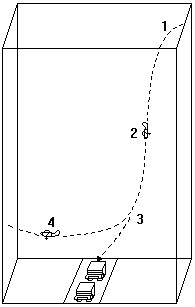
TORPEDO-DROPPING
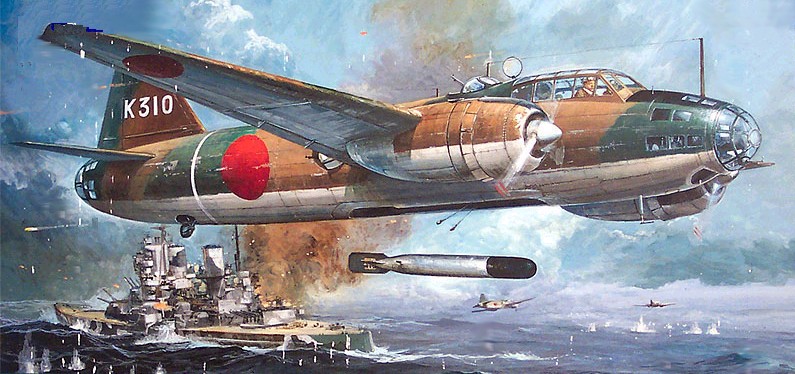
The Pearl Harbor mythology fails to recognize these facts that the battleships there were not moving and were actually easy targets not much different than General Billy Mitchell's tests in the 1920s.
Regardless, every battleship damaged in the shallow Pearl Harbor except for two were salvaged and put back into combat just as tanks in land warfare can be more often than not repaired after being knocked out (mobility kill). There is a huge difference between a mobility kill and a total kill (TK). Only the Arizona was TKed; the Oaklahoma capsized and was refloated; after this she was towed back to California to be scrapped when she broke her line and sank. With 23 other battleships, if we really needed her we could have placed her back into service. Take a look at the Des Moines class heavy cruiser armor protection:
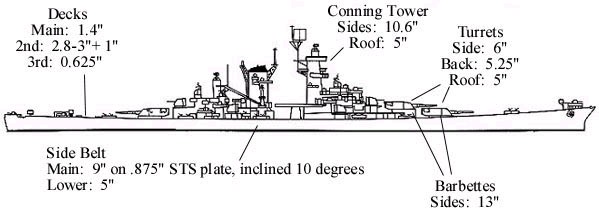
However, the Pearl Harbor-battleships-are-obsolete mythology played right into the hands of the aircraft carrier-as-the-only-capital-ship-we-can-have-in-the U.S. Navy crowd that ruins the sea service today. Battleships and cruisers are a threat to the weak ego aircraft carrier milicrats and they fight even as we speak to keep these heavily armored ships--the only ships we have that can sail into "Harm's Way" fast and smash an enemy invasion fleet in a guided missile age and survive with anything less than a perfect anti-missile-missile defense. While a couple heavily armored cruisers were converted into missile cruisers, the post-1960 Navy got cheap and lazy resulting in today's flimsy under 10, 000 ton Ticonderoga light cruisers and Arleigh Burke destroyers---if 10, 000 ton cruisers suffered too many losses in WW2, why in the world would we think they'd be ok today?
The "Hybrid" that works: Surface Ships + Seaplanes
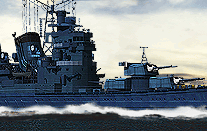
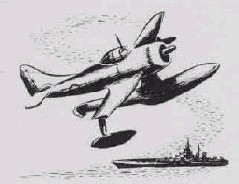
Seaplanes performed the following critical missions:
* FIND THE ENEMY FLEET (RECON)
* SPOT FOR NAVAL GUNFIRE SO IT HITS THE ENEMY FLEET AND SHORE TARGETS (NVGFS)
* PATROLS FOR ENEMY SUBMARINES (ASW)
* SEARCHES AND RESCUES MEN IN WATER/LAND (CSAR)
* WARNS OF AIR ATTACKS AND SHOOTS DOWN ENEMY PLANES (AAW)
The last mission, AAW became possible with the advent of the SC-1 SeaHawk which was a seaplane fighter-bomber. Early SOC SeaGull biplanes were replaced by Kingfisher monoplanes then the failed SeaMew and finally the fabulous SC-1 SeaHawk which was actually a seaplane fighter able to do the AAW mission!
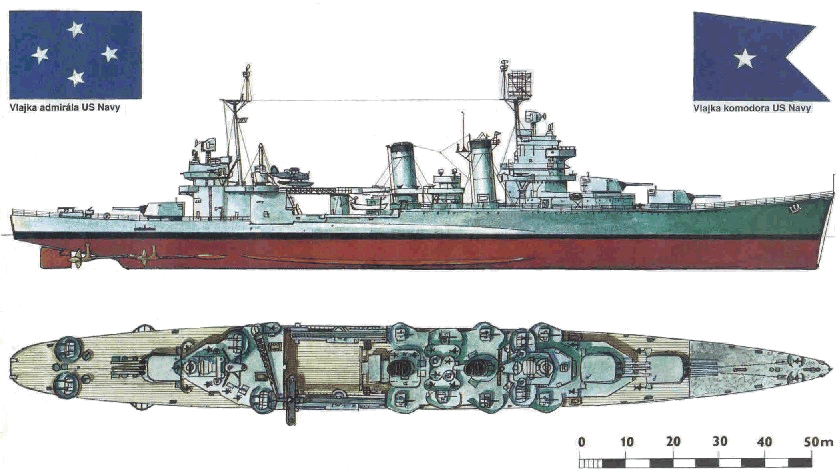
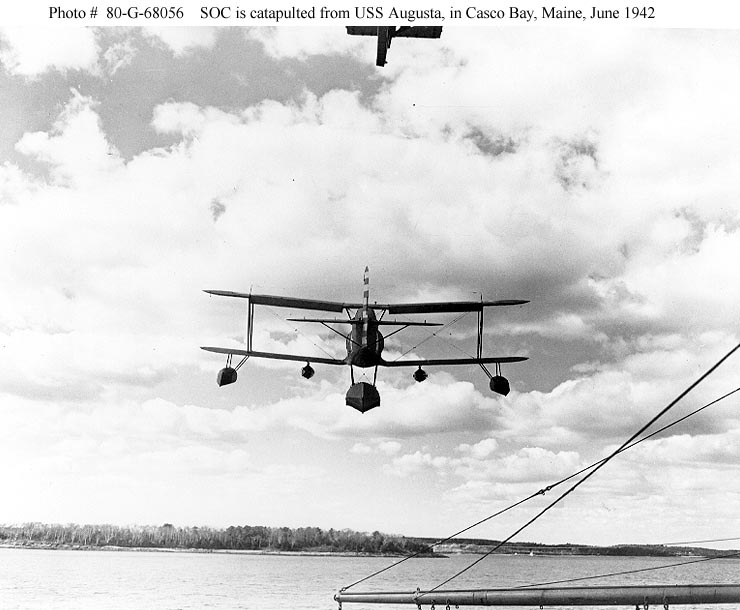
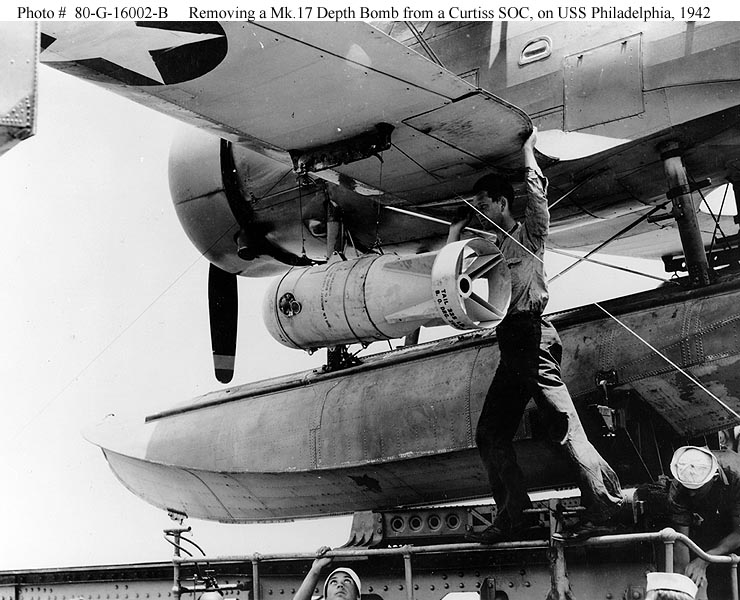
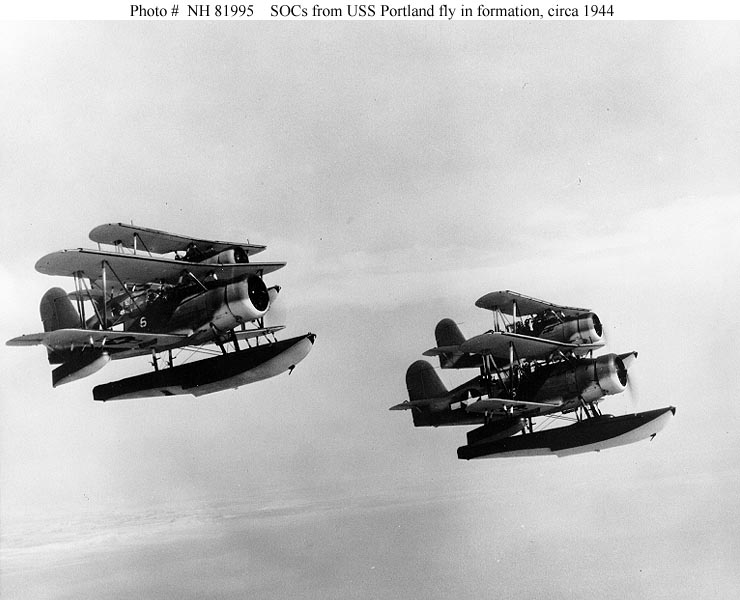
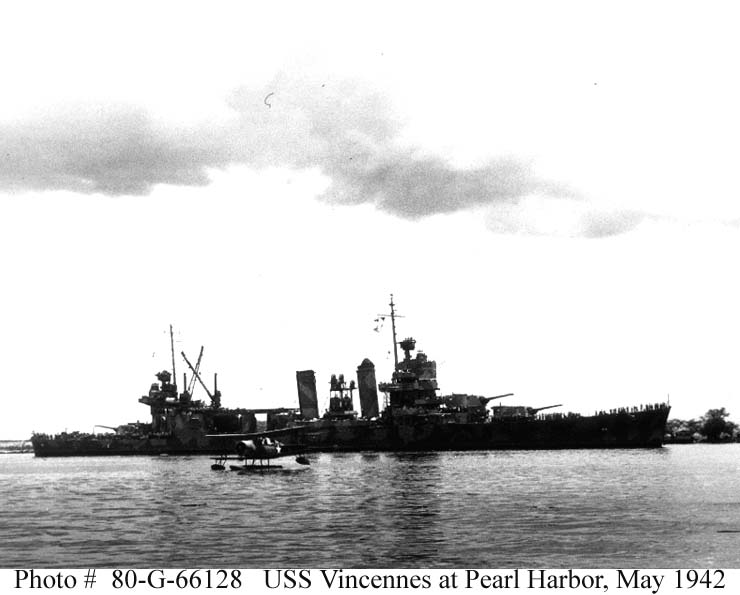
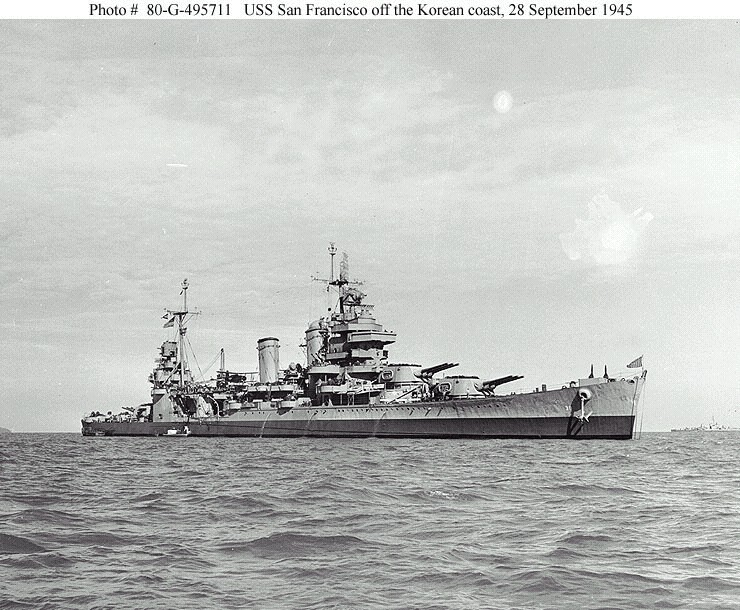
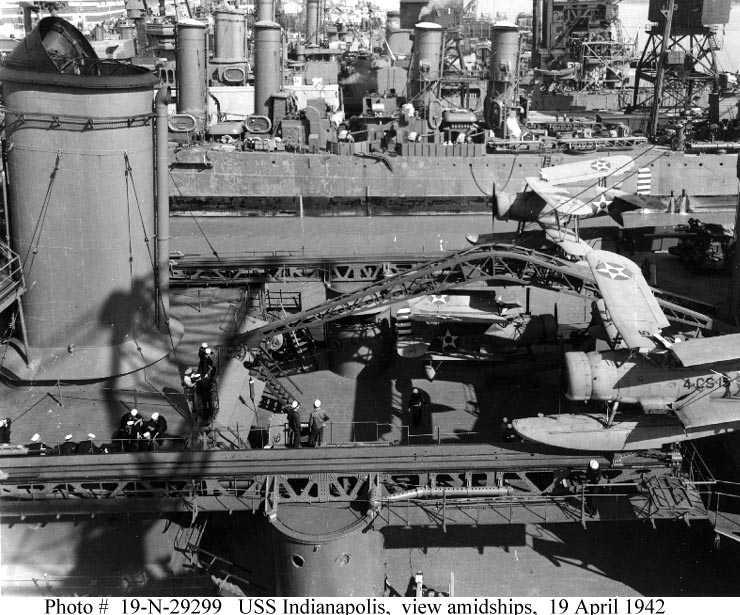
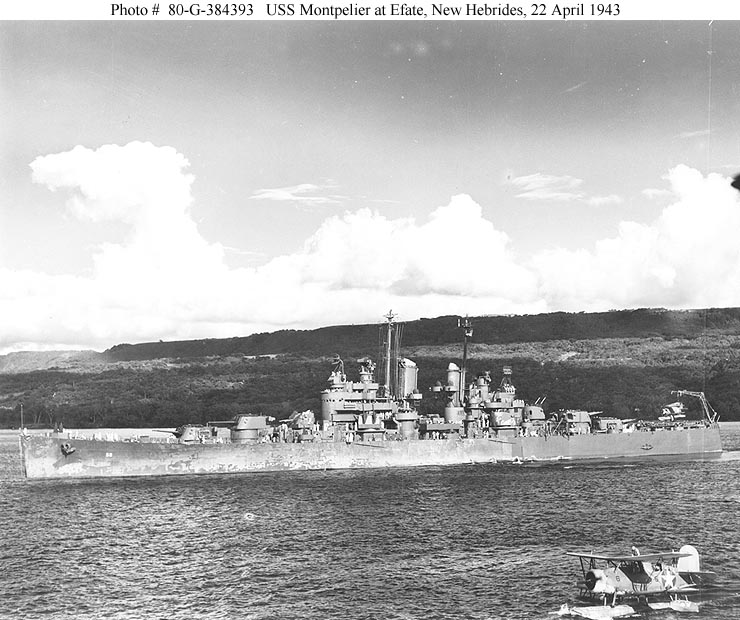
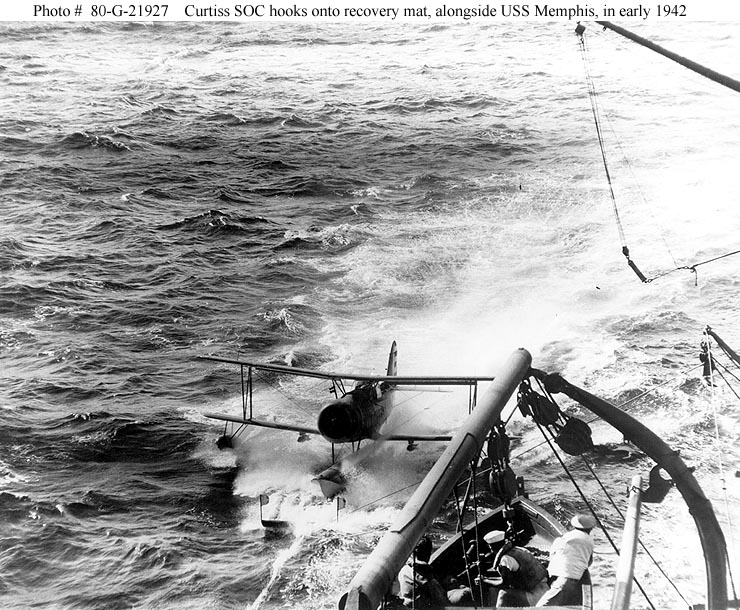
KINGFISHERS
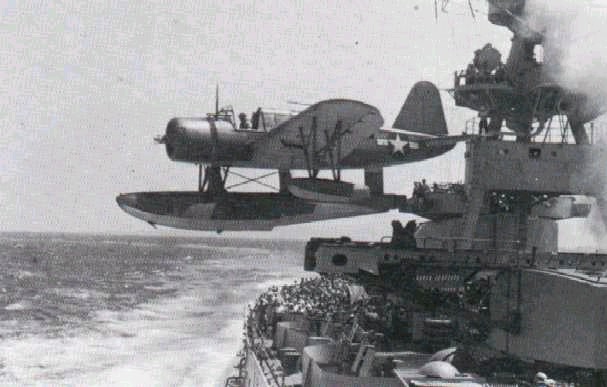
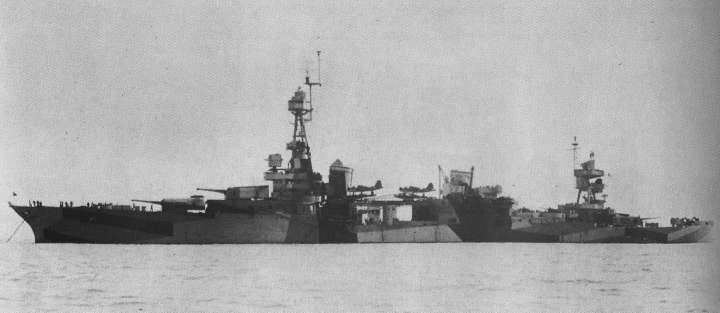
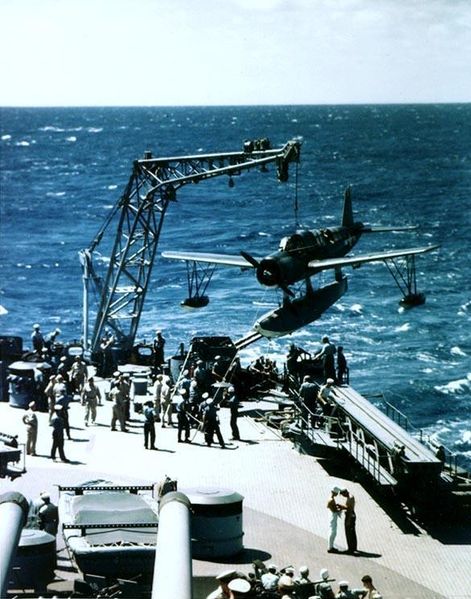
SEAHAWKS
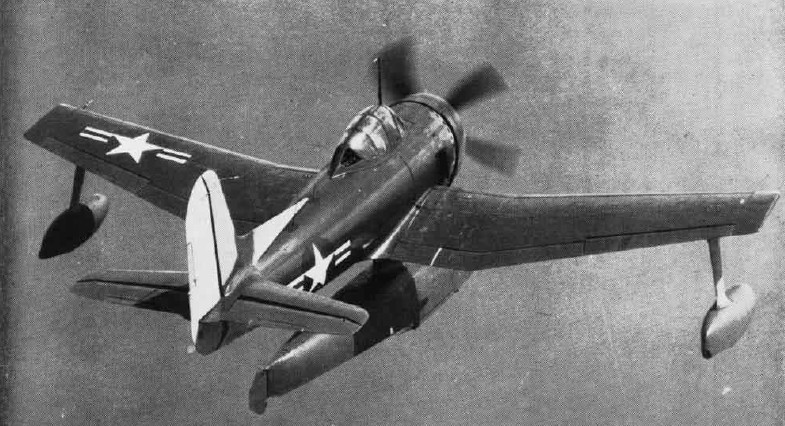
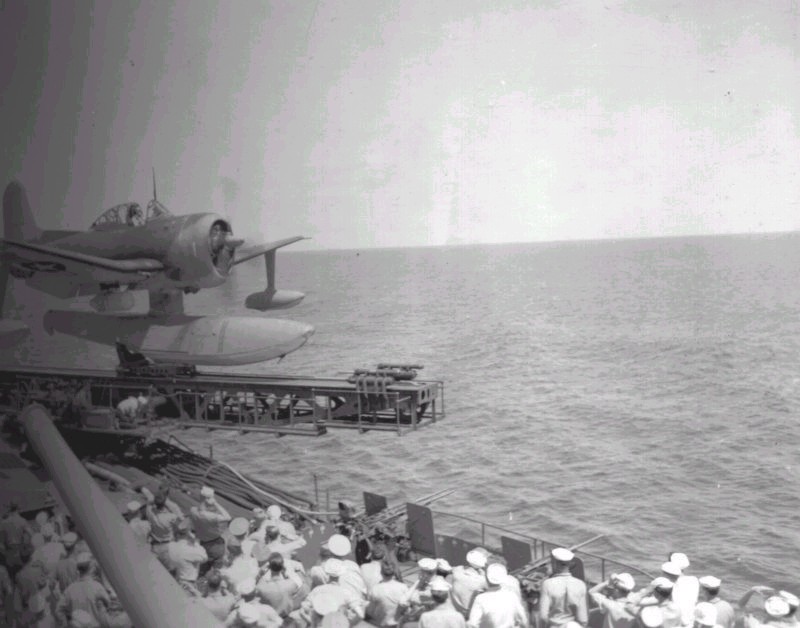
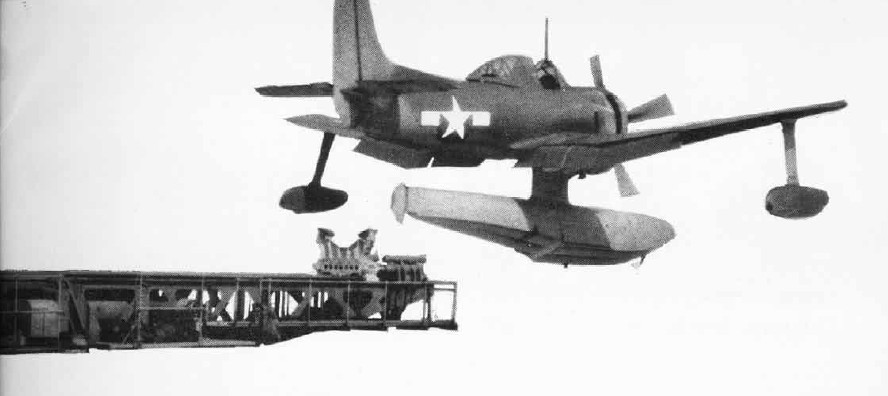
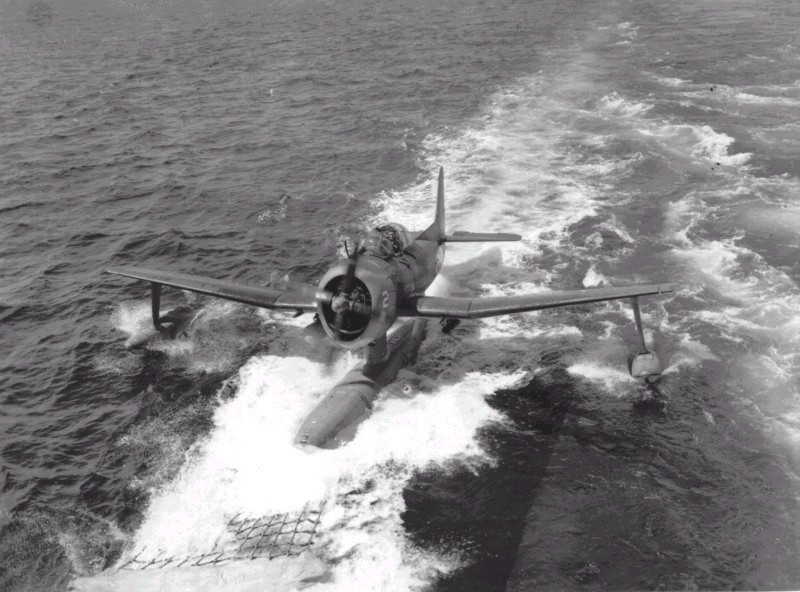
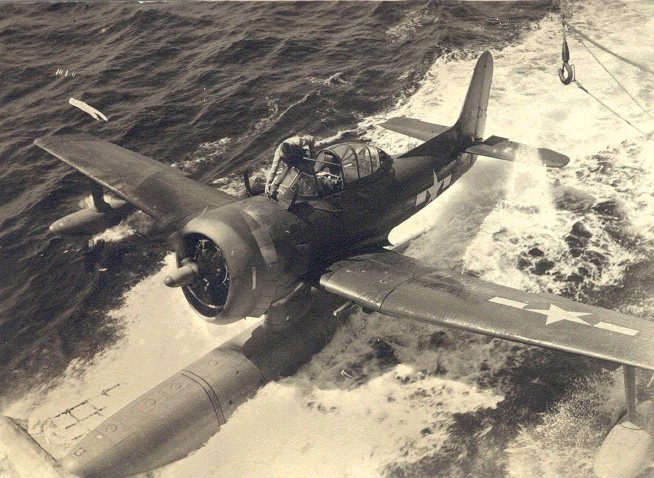
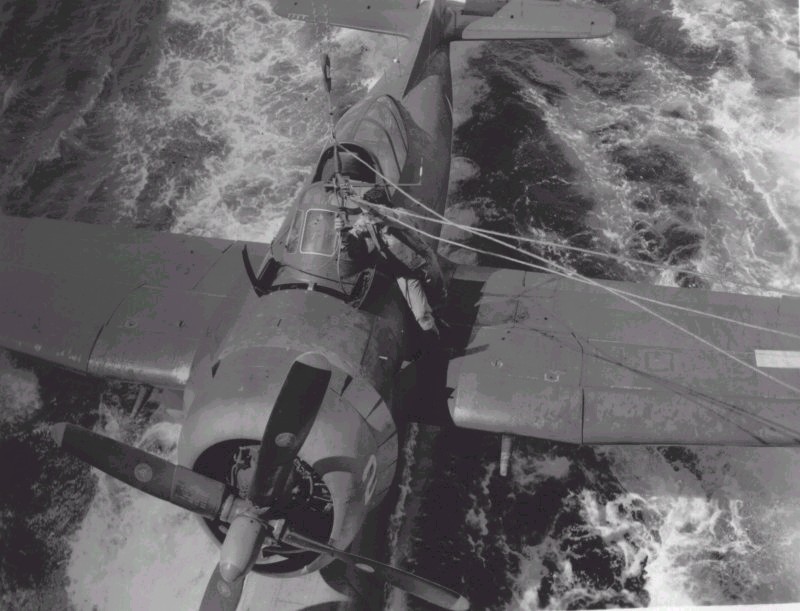
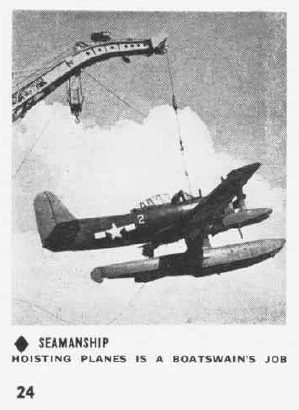
On Cruisers...

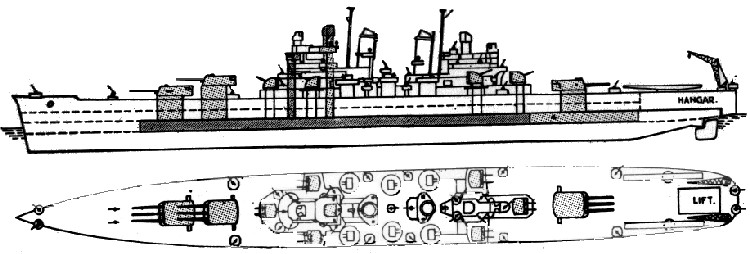
Notice the rear hanger under the fantail to store SeaHawks and do maintenance in the late model Baltimore class heavy cruisers...
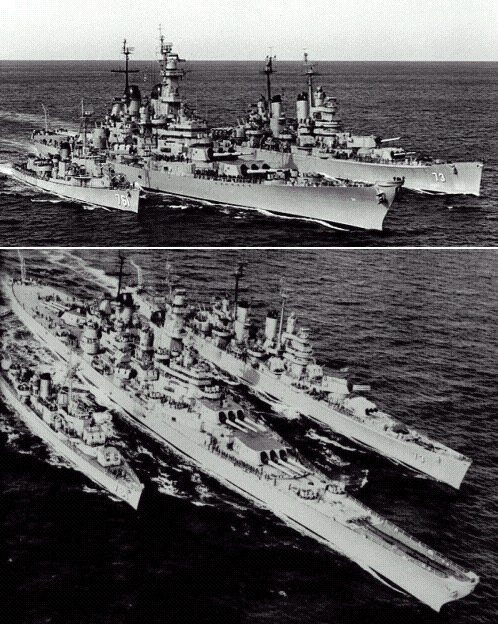
Size comparison of the destroyer to an Iowa class battleship to a heavy cruiser...
On Battleships...
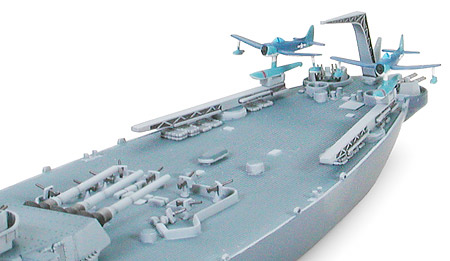
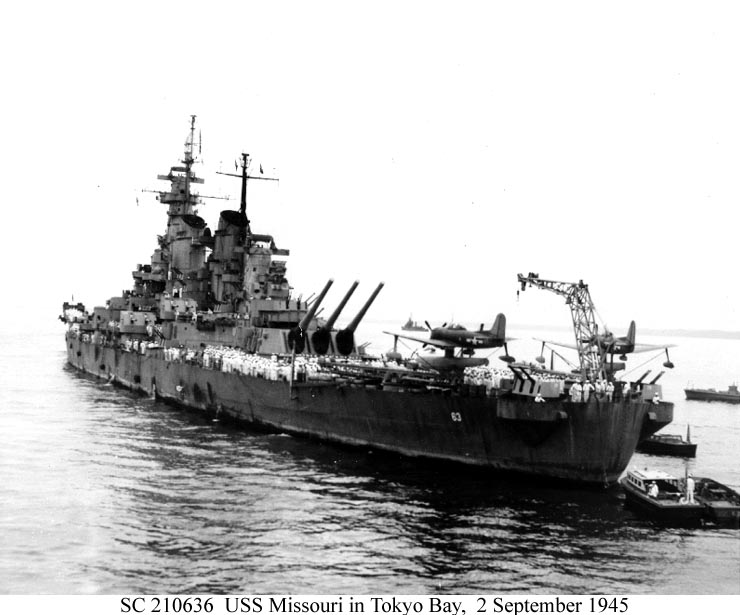
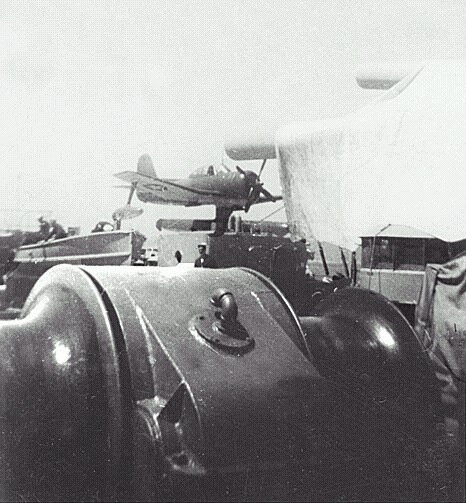
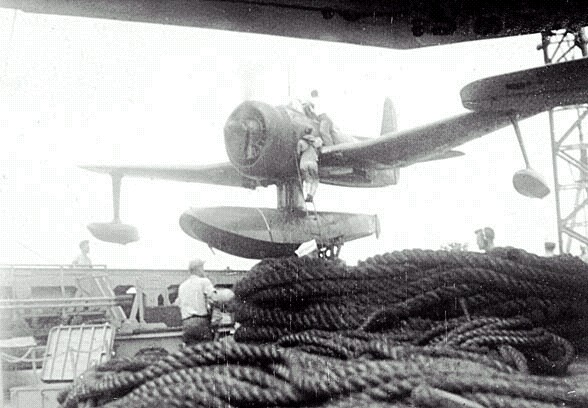
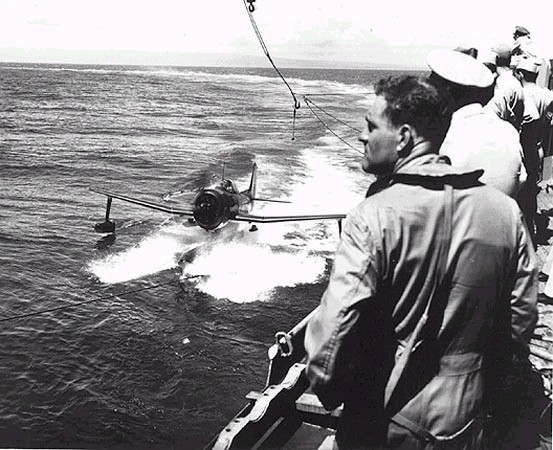
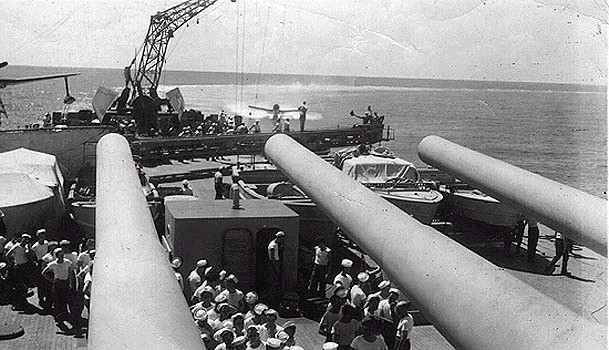
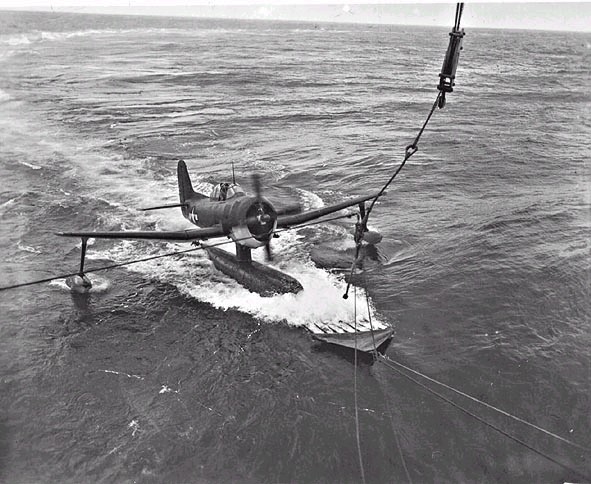
Even when we mass-produced "jeep carriers" (CVEs) from merchant ship hulls, we did not have enough carriers to escort every surface ship grouping so cruisers and battleships---and even destroyers carried their own "air cover" to do reconnaissance, anti-submarine warfare and even anti-war warfare when the excellent Curtiss SC-1/SC-2 SeaHawk fighter floatplane arrived.
The U.S. Navy from 1939-1945 operated:
25 x battleships with 2-4 seaplanes each (50-100)
37 x Heavy Cruisers with 2-4 seaplanes each (74-144)
59 x Light Cruisers with 2-3 seaplanes (108-177)
76 x Seaplane Tenders (keep up to PBY Catalina or PBM Mariner large patrol seaplanes on patrol)
3 x Destroyers with 1 seaplane (3)
_________________________________________
FACT: 99 cruiser/destroyers could put into the air a powerful force of 232-421 small seaplanes and 76-228 large seaplanes without need of aircraft carriers!
FACT: Out of 96 cruisers only 10 were sunk in the entire war! Compare this fact that they were ARMORED and had their own portable air cover to the destroyers (cans) that did not and their horrendous loss rates. We lost 82 unarmored destroyers in WW2.
FACT: 9 out of 10 of the U.S. cruisers that were sunk were attacked by torpedoes and/or large caliber gunfire (lots of HE); only 1 was lost to air attack---and that was an air-launched torpedo. Being armored works against unguided HE bombs.
FACT: ALL of the USN's battleships survived the war except two old, unlucky ones from the Pearl Harbor attack. Once our battleships were moving with air cover, they were unsinkable.
FACT: the U.S. Navy LOST 11 x AIRCRAFT CARRIERS IN WW2; these were totally destroyed/sunk; there was no salvage back to duty. 11-2, battleships win when it comes to surviving High Explosive (HE) attack combat damage. Yet, after WW2, with the large aircraft carrier "mafia" running the taxpayer-funded historical propaganda machines we have a public who thinks the war was won by the aircraft carriers (Midway) and all the ships getting sunk were our battleships at Pearl Harbor...and only 1 at that all the rest were repaired and put back into combat! Is it a surprise we have no heavily armored ships on active duty in the USN today?
FACT: seaplanes from cruisers/battleships rendered effective observation of their gunfire enabling hits on both land and sea targets
FACT: many downed aircraft carrier airmen and sailors of sunk ships were rescued by seaplanes from cruisers/battleships
 U.S./Allied Battleship/Cruiser Small Seaplane Exploits
U.S./Allied Battleship/Cruiser Small Seaplane Exploits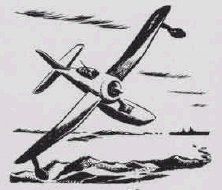
NOTE: the years 1900-1930 are suppressed history by the large aircraft carrier U.S. Navy for two reasons. You may wonder WHY you don't hear much about what it did in WW1 from the normally boastful U.S. Navy?
1. Maverick ship gunnery genius LT Sims was made into an Admiral and placed in charge of the Navy over the establishment assholes by no-non-sense, get-the-job-done President Teddy Roosevelt and the successors to these assholes still resent a smart winner being placed on top according to merit instead of the brown nosing ego-ocracy they perpetuate to this very day.
2. SEAPLANES kicked ass in the Atlantic and helped ward off German U-Boats and these were operated by ships other than large, bloated, expensive soak-the-taxpayers-dry "supercarriers" and the Navy/marine ego clubs don't want John Q. Public to know there are other, better ways for getting aircraft to operate at sea.
1911
U.S. Navy LT Eugene Ely lands and takes-off from the battleship USS Pennsylvania; the first naval aviator
1912
U.S. Navy Quarterman Joiner [E. C.] Keithley creates idea of catapult-launched seaplanes from battleships/cruisers
1914
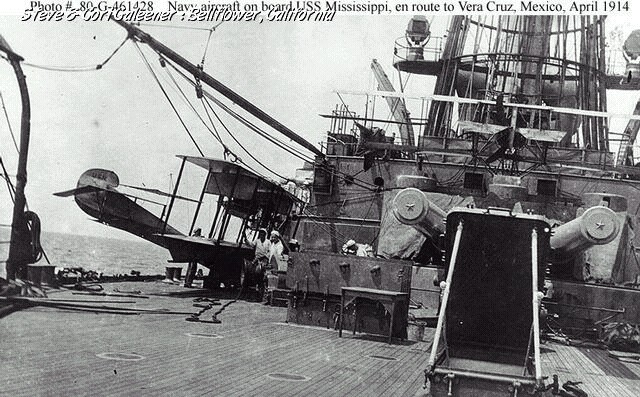
First COMBAT actions of U.S. Naval Aviation done by SEAPLANES over Vera Cruz, Mexico in 1914, NOT BY AIRCRAFT CARRIER AIRCRAFT.
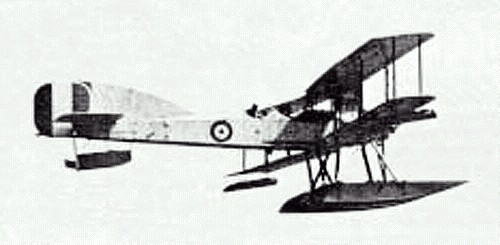
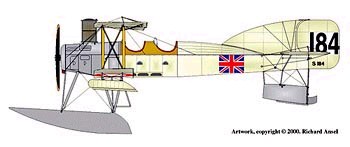
British Royal Navy SEAPLANES torpedo and sink the first ships in history to be destroyed from air attack (ASuW). They later on in the war sink German U-Boats (ASW-submarines) and do successful land air attacks (LA).
1918-1939

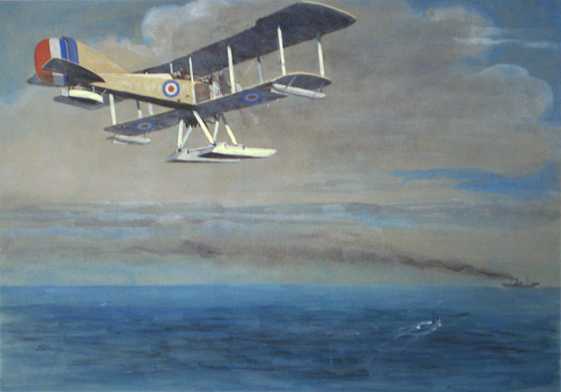
By WW1's end the RN had created the first dry aircraft carrier, but between the wars lagged in developing a seaplane fighter for battleship/cruiser self-defense and become overly dependant on their few aircraft carriers for air cover (AAW) and ASW. During WW2, a horrific number of British and U.S. Navy surface ships were lost to air attacks that could have been thwarted had they had their own seaplane fighters--and not relied on the bloated aircraft carrier to be there.
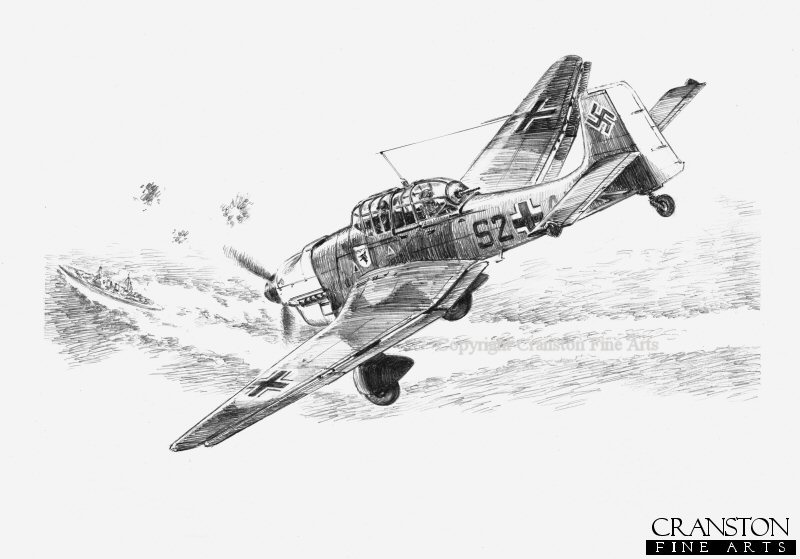
The British did employ the first submarine-launched seaplane observation/attack aircraft in the 1920s but did not continue with this desirable scouting capability as the French and Japanese did with their submarines.
 www.youtube.com/watch?v=-PGXyxZV62M
www.youtube.com/watch?v=-PGXyxZV62M
1937
 www.youtube.com/watch?v=Qcmm1nS1vn4#W06d92voG28
www.youtube.com/watch?v=Qcmm1nS1vn4#W06d92voG28
Once WW2 began, heavy supply ship losses to German U-Boats forces the RN to re-learn WW1 lessons of moving supply ships by ASW destroyer and long-range maritime patrol aircraft guarded convoys and desperately place "Hurricat" fighters that cannot land on water to be recovered on merchant ships to ward off FW-200 Condor patrol/reconnaissance bombers. The Americans provide blimps and mass-produce small escort aircraft carriers to get AAW/ASW protection for convoys to get through German Condors and U-boats.
Why did we buy the 175 mph, 2 x 7.62mm medium machine gun, 900 mile range Kingfisher in 1937 and not the 1400 mile range. faster, better armed N-3PB? Open-sea landing single floats were possible. Wings could have been made to fold. Why were N-3PBs not supplied to British CAM ships to ward off Fw-200 patrol bombers since they could land and be reused unlike Hurricats that ditched? Or was this yet another case of the aircraft carrier "mafia" trying to sabotage the seaplane community and keep it in its "place"?
1939 War in the Atlantic: British Seaplanes Win--Beware of the Lessons of the Graf Spee
Manned Royal Navy seaplane launches from her ship to direct naval gunfire against German and/or Italian targets
The concept of a pocket battleship--a cruiser's speed and range but with heavy armament and armor to be able to ward off enemy cruiser attacks while sinking civilian cargo ships during independent actions is a good one IF it has "hip-pocket" air cover in the form of seaplane fighters. We believe bringing our Iowa class battleships back to active duty with F-35B Lightning II stealthy STOVL fighter-bombers can achieve this. Moreover, if the Iowas were fitted with nuclear propulsion means, their fuel tanks could be used to store more JP-8 aviation fuel and they could sail at high speeds despite having a fat hull shape all over the world like a slim hulled cruiser--but without having to refuel except once every 10 years. Only the Iowas have the required armor to withstand precision guided munitions (PGM) attacks in the current era of flimsy ships fatalistically surrendered to the notion that everyone is going to be hit and there's nothing that can be done about it--except to hit first.
combatreform.org/battleships.htm
What is extremely fascinating in the account of the Graf Spee is the awareness on the part of both the German and British navies of the need to BREAK CONTACT in a surface action if not a part of a powerful surface fleet. As great as the Graf Spee was she had the fatal flaws of still being 7 knots (9 mph) slower than a Royal Navy cruiser and her AR-196 seaplane fighter was carried exposed and could be easily destroyed in combat if enemy fire were received---of course she should be up in the air before this happens to direct gunfire or attack or defend but this is not always possible. A nuclear-powered Iowa aircraft battleship would have raw power and have the combat seaplane fighters to not allow enemy ships to shadow her out of range as the Exeter, Ajax and Achilles did to the Graf Spee. The fascinating problem of independent actions is how to break contact on the surface; submarines can hide by being under the water. The clever German captain Langsdorff--a veteran from the WW1 battle of Jutland--had the Graff Spee fly British or French flags, call-in their name as other German warships and even built fake turrets and engine stacks from wood/canvas to appear like a RN battleship. A couple years later, the RN would trick the Germans by making the HMS Campbletown look like one of their destroyers by REMOVING engine stacks and reshaping her bridge for the St. Nazaire Raid! Flying false flags was SOP for the German armed civilian cargo ships.
www.bobhenneman.info/bhrcgs.htm
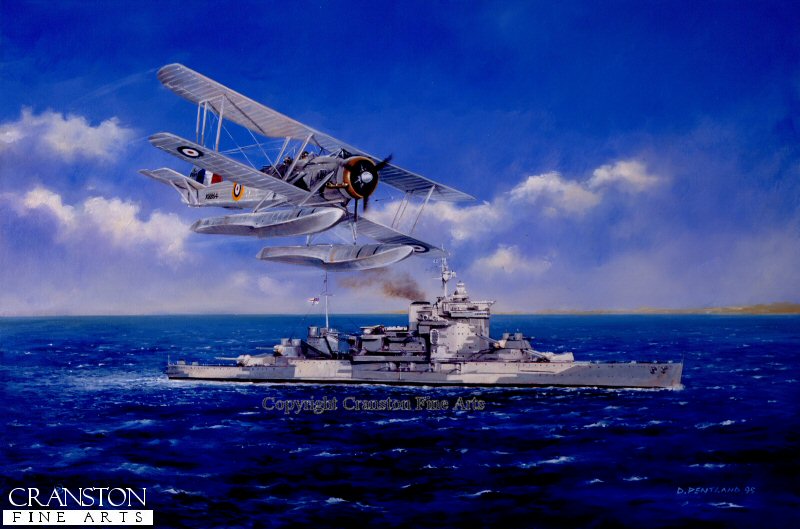
The Raiding Cruise of the Admiral Graf Spee
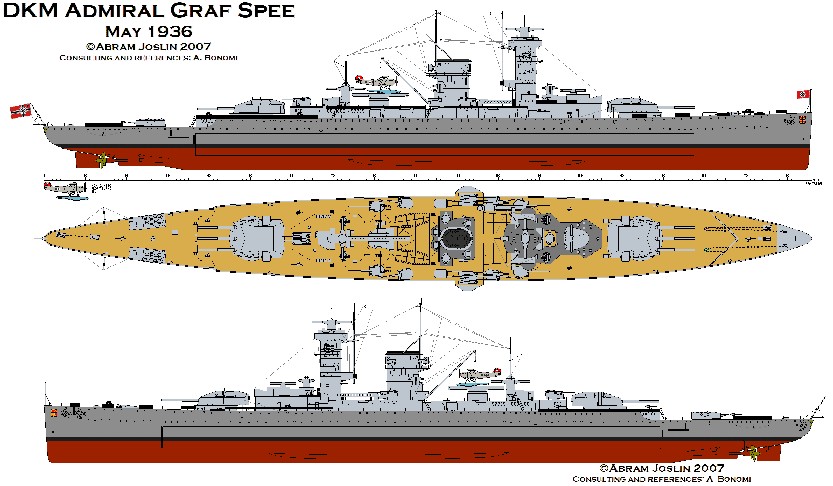
With the invasion of Poland pending, as war imminent, Germany dispatched her two available panzerschiffe into the Atlantic. Supply ships and tankers were dispatched also, to keep the warships at sea in the absence of German bases.
Admiral Graf Spee, under the command of Captain Langsdorff, slipped out of Wilhelmshaven on August 21, 1939, and sailed up the coast of Norway. The ship then turned west, passing unseen between the Faeroes Islands and Iceland on August 24. Graf Spee headed south, passing through the main Atlantic shipping lanes at night, to take up station northeast of the Azores. Here, on the 28th, Graf Spee met up with the supply ship Altmark, which, in the guise of an ordinary merchant tanker, had filled her holds in Texas with fuel oil for the raider. After topping of Graf Spee's bunkers, Altmark fell in behind the warship as they headed further south.
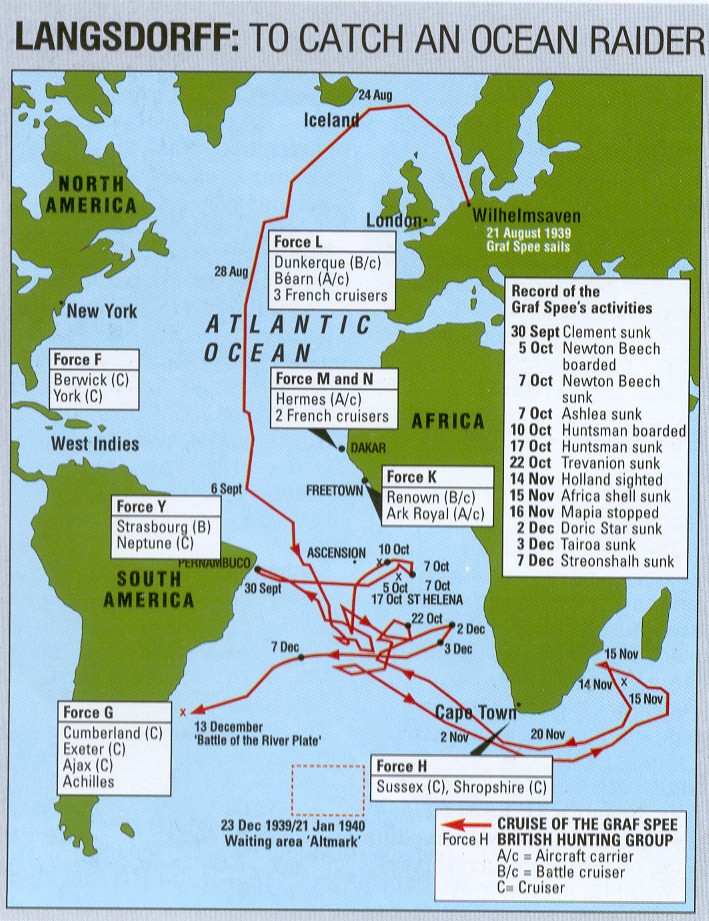
On September 3, 1939, British and France declared war on Germany over the invasion of Poland. Graf Spee and Altmark were west of the Cape Verde Islands, still heading south.
Despite the outbreak of hostilities, the raider was not allowed to commence warfare against Allied shipping, but was rather ordered on September 5 to avoid all contact with other ships. In the vain hope that a quick German victory in Poland and a lack of hostile action against British and French forces would lead to a very quick end to the war. So Langsdorff kept clear of shipping routes, crossing the equator on September 8 and taking up station in a seldom-frequented area of the South Atlantic.

On September 11, Graf Spee's Arado seaplane, on a routine recognizance flight, spotted the British heavy cruiser HMS Cumberland on an intercept course with the German ships. The British lookouts did not spot the plane, which was able to alert Langsdorff to change course and avoid detection. Cumberland continued on her way from Freetown to Rio de Janeiro, none the wiser. Graf Spee remained in a holding pattern north of the River Platte - Cape of Good Hope shipping route, refueling twice from Altmark.
On September 26, Langsdorff finally received new orders. Her was to commence hostilities immediately, but with several restrictions: he was to attack only British ships, and not French ships. Actions with enemy warships were to be avoided, so as to not risk his ship. He was also to conduct warfare within the rules of the International Prize Law, in that all ships needed to be stopped and searched, and their crews and passengers taken off before it could be fired upon. Lastly, he was to avoid any incident that would alienate U.S. opinion. Parting company with Altmark, Graf Spee went off to war.
As a lone unit in a hostile sea, Graf Spee would rely on cunning and confusion to avoid being cornered by enemy warships. She would display British and French flags to approach unsuspecting victims, and would change the name painted on her hull and her report signal ID several times, from Graf Spee to Deutschland to Admiral Scheer and back, so that any intercepted signals or reports of her sighting would cause confusion at the British Admiralty and lack credibility: a report from a neutral freighter of a "confirmed sighting" of a ship know to be in the Baltic would be looked upon skeptically.
Not being required to respect the U.S.'s self-declared "neutrality zone," Langsdorff headed towards the coast of Brazil, to disrupt the flow of meat and grain to Britain along the shipping routes off Pernambuco. 75 miles northeast of the Brazilian port of Pernambuco, Graf Spee found her first victim just before noon on September 30. The captain of the 5050-ton freighter SS Clement spotted an approaching warship, and thought it was the British cruiser HMS Ajax. But it was Graf Spee, who's Arado 196 seaplane was launched, and few machine gun bullets were sprayed at the bridge of the freighter. Clement's captain, F.C.P. Harris, stopped engines immediately, and ordered his crew to the boats after sending a distress message. Five rounds of 11" and 25 rounds of 5.9" gunfire then sank the abandoned freighter. The sea was calm, so Langsdorff took captain Harris, his chief engineer, and a hand injured while abandoning ship on board the Graf Spee, while the rest of the crew were given the correct course back to the South American port of Maceio, all reaching that location safely the next day. After treating the wounded man and questioning Harris, Langsdorff stopped the Greek steamer SS Papelemos. Her captain promised not to send a signal until reaching the Cape Verde Islands (a promise he kept), so the three British men were transferred to the neutral freighter and Graf Spee went on her way.
Knowing that Clement had gotten off a radio signal, Langsdorff took the Graf Spee off at high speed, choosing the Cape of Good Hope - Europe route as his next hunting ground. In that shipping route on October 5 Graf Spee found the British freighter SS Newton Beach (4650-tons) with a cargo of corn. The ship was stopped and a prize crew put on board so she could be used as a source of supplies, but not before a distress message was transmitted. Another British merchant ship heard this call, and passed it on later in the day to the HMS Cumberland. This was the worst case scenario for the Germans: a powerful British warship was in the area, the location of the raider was known, and heavy Allied reinforcements could be rapidly dispatched from Dakar, the West Indies, and Pernambuco to track down the raider within a few days. But Captain Fallowfield of the Cumberland, concerned with tipping off the position of his own vessel, incorrectly assumed that the radio call had been heard at Freetown, so he maintained radio silence. Graf Spee's luck had held out again.
Heading east in the company of her prize, Graf Spee surprised the British steamer Ashlea (4220-tons) on October 7, which was loaded with sugar. Her radio operator had no chance to send a message, and the ship was boarded. The Germans gained useful intelligence when her captain, C. Pottinger, failed to destroy his confidential instructions from the Admiralty. Clement's captain had made the same mistake, and the German raider was now in possession, among other valuable documents, of a complete copy of the code given by the Admiralty to merchant ships. Langsdorff now had Ashlea's crew was put onto Newton Beach, and Ashlea was sunk with scuttling charges.
On October 8, German High Command dispatched the battlecruiser Gneisenau, the light cruiser Koln, and nine destroyers into the North Sea. They were to simulate a sortie into the Atlantic, going only as far as the south coast of Norway, attacking any light craft or merchant ships they encountered. After being sighted by Coastal Command, they would slip back to Germany. This had the effect of the Home Fleet being put to sea immediately, and the Admiralty, fearful of a German breakout into the Atlantic, was dissuaded from sending heavy units to join the hunt for Graf Spee.
On October 9, aircraft from the [aircraft carrier] Ark Royal sighted Altmark southwest of the Cape Verde Islands. Captain Dau of the Altmark indicated that he was the American ship Delmar, and unwilling to take his flagship too far off its course for Freetown, Vice-Admiral Wells chose not to investigate, and the German supply ship was allowed to go on her way without even a cursory check. Altmark met with Graf Spee later that day, and received the transferred the crews of the two British ships. Having gotten all he wanted off Newton Beach, Langsdorff ordered her scuttled.
On the evening of the 10th, Graf Spee approached the British liner Huntsman (8200-tons), on passage from Calcutta to London with a cargo of tea. The liner's captain, A.H. Brown, mistook Graf Spee for a British cruiser, and allowed her to approach. The Germans then sent a signal threatening to open fire if the radio were used. Unwilling to risk the lives of his crew, Brown complied, and a prize crew took over Huntsman.
Returning to the waiting area outside the sea-lanes, Graf Spee refueled from Altmark. Though the Huntsman would make a good addition to the German war effort, Langsdorff realized that the chances of sailing her to Germany past the Royal Navy blockade were slim. Her captain joined the Graf Spee, while the rest of her crew was put on Altmark, and the ship was scuttled.
Using intercepted radio transmissions and his captured codebook, Langsdorff headed south for another try at the Cape - UK trade route. On October 22 Graf Spee, flying a French flag, approached within a mile of the 5300-ton Trevenion. Her captain, J. Edwards, recognized the pocket battleship and sent off a distress call at the last minute, completing it despite machine gun fire to the bridge of his ship. The Germans boarded the vessel, took off the crew, and scuttled her, but a British liner relayed her message to the C-in-C at Freetown. Realizing that his game was up, Langsdorff left the shipping lanes once again. He rendezvoused with Altmark on October 29 to refuel and transfer all of his prisoners. Admiral Raeder in Berlin suggested new hunting grounds, and Langsdorff agreed: the Indian Ocean. It was time for the wool harvest in Australia, and the Cape of Good Hope - Australia trade route should be both filled with valuable prizes and poorly defended.
Heading southeast, Graf Spee sailed for over 3000 miles, staying far south of the cape of Good Hope, which the raider passed on November 3. A message from Berlin commended the Graf Spee for her efforts and 100 Iron Crosses were awarded to her crew.
But the Cape - Australia trade route in the Indian Ocean did not bring the prey the Germans anticipated. The wool clipping in Australia came late that year, and the ships carrying it were sitting in Australia, not yet loaded. For 10 frustrating days Graf Spee slowly cruised in search of ships, sighting none.
So Langsdorff headed to the Mozambique Channel, between the African coast and Madagascar. On November 15 Graf Spee took the tiny British tanker Africa Star (700-tons) by surprise, capturing her before a distress call could be sent. The captain, P. Dove, and his crew were taken on board Graf Spee and the diminutive tanker, loaded only with ballast, was scuttled.
The next day Graf Spee closed on another vessel, only to find that it was the neutral SS Mapia, of Dutch registry. Her neutrality was respected and she was allowed to go, but Langsdorff decided that between her inevitable report upon reaching port, and the Africa Star being eventually reported late, he had just about worn out his welcome in the Indian Ocean. He sailed back to the Atlantic, passing the Cape on November 21.
Two days later Graf Spee arrived back at her original South Atlantic waiting area, where four days were spend in company with Altmark making repairs and adjustments to Graf Spee's engines. To confuse any ships that may have stumbled upon him in such a vulnerable state, Langsdorff ordered a second forward turret and second funnel constructed out of wood and canvas, radically altering the silhouette of his vessel to resemble HMS Renown. To pull British warships away from the area, the battlecruisers Scharnhorst and Gneisenau put to sea for a feint into the North Atlantic, disrupting Allied shipping and trying up the Home Fleet for a week before returning unseen to Germany.
Langsdorff decided that his ship and crew were about ready to go home. Having sailed over 30,000 miles, Graf Spee's engines were in need of more repairs than could be made at sea. Langsdorff decided to make one more sweep of South America to disrupt trade along the coast to the UK, and then head back to Germany for a well-deserved overhaul for his ship and R&R for his crew. He would first hunt the Cape-UK trade route until December 6, and once the enemy was aware of his presence he would take his ship to the River Plate area for a final sweep against beef and wheat from Argentina, and head for Germany with the New Year. Refueling and provisioning from Altmark on November 26, Langsdorff decided to redistribute his prisoners. Captains and first officers would return to Germany on Graf Spee, while Altmark would land the rest at a neutral port. Ironically, Langsdorff wrote that because Graf Spee's period of commerce raiding was nearing the end, it was no longer absolutely necessary to avoid action with enemy warships. Should an enemy warship sight and attempt to follow Graf Spee, he would close the range and use his ship's powerful guns to at least damage it so as to eliminate the threat of a shadowing warship calling in reinforcements.
The two ships separated, and Graf Spee made her presence known off Africa on December 2. The liner Doric Star (10,100-tons) was sighted bound for Britain from New Zealand with mutton, butter, cheese, and wool. Rather than use disguise, Langsdorff opened fire from long range, which allowed the liner to send a distress call before being overwhelmed. This properly stirred up a hornet's nest in the area, and the Germans planned to put a prize crew on the liner for later use as a supply ship before dashing across the Atlantic. But just as German seamen boarded this valuable prize with her rich cargo, Graf Spee's seaplane ran out of fuel and had to make a forced landing. Recalling his crew, he ordered the liner scuttled, and raced off to recover his valuable aircraft and its crew, which were located just before nightfall.
At sunrise on the 3d, Graf Spee captured the steamer Tairoa (7980-tons), sinking her after taking off the crew. But Tairoa's captain Star had gotten off a distress signal before is radio room was wrecked by gunfire.
On December 6, Graf Spee met up with Altmark again. After exchanging prisoners for fuel and provisions, Graf Spee headed westward to the River Plate area. Captains Star and Brown (Huntsman) were also transferred to Altmark, so that they might look after the captive crewmen.
On the evening of December 7, Graf Spee sighted the freighter SS Streonhalh (4000-tons) bound for Britain from Montevideo. Her captain, J. Robinson, hoped that Graf Spee was a British cruiser and delayed sending a distress call until it was too late. Robinson attempted to dispose of his secret documents in weighted bags, but a German sailor saved one before it sank. From this packet Langsdorff learned that British shipping leaving Buenos Areas and Montevideo steered for a point 300 miles east of the River Plate, before turning north-northeast past Pernambuco for Freetown. Langsdorff now knew where to find rich pickings before heading back to Germany. After taking off the crew, the ship was scuttled, bringing Graf Spee's total to nine vessels totaling more than 50,000 tons, without a sailor on either side being killed or wounded.
Langsdorff was warned of the great numbers of British and French warships hunting for him, but German High Command indicated that all the heavy units were at Freetown or Cape Town. Four British cruisers were known to be off South America, but they were expected to be operating independently either on patrol or escorting merchant ships. Alone, each was no match for Graf Spee. Langsdorff headed for the newly discovered British shipping route, and planned to intercept a convoy of four ships that would sail from Montevideo without escort on December 10.
On December 11, Graf Spee's seaplane took off for its usual dawn patrol, sighting nothing. But the plane suffered another in a series of cracked engine cylinders, and Graf Spee was fresh out of spares, so Langsdorff would no longer have the benefit of his eyes in the sky.
December 13, Graf Spee reached the point 300 miles from Montevideo where she expected to find her final four victims. The lack of aerial recognizance caused Graf Spee's luck to run out: dawn broke, but no merchant ships were sighted. Instead, at 0552, two, and then four masts broke the horizon. Graf Spee went to action stations at 0600, and by 0610 her lookouts had correctly identified the newcomers: the heavy cruiser HMS Exeter, and the light cruisers HMS Ajax and HMAS Achilles.
Outnumbered and with a speed disadvantage of seven knots, Graf Spee had no chance to outrun her opponents. Langsdorff turned his ship at the British cruisers, ran his ship up to 24 knots (the most it could do with a fouled bottom), and engaged the enemy. The raiding cruise of the Graf Spee was about to come to a dramatic end at the Battle of the River Plate.
The important of naval air reconnaissance cannot be under-stressed. The old adage, "Look, before you leap" if not followed is often fatal. With today's over-reliance on even more mechanically unreliable helicopters than fixed-wing seaplanes, the chances of a repeat of the fate of the Graf Spee are high. www.bobhenneman.info/bhbrp.htm
Battle of the River Plate
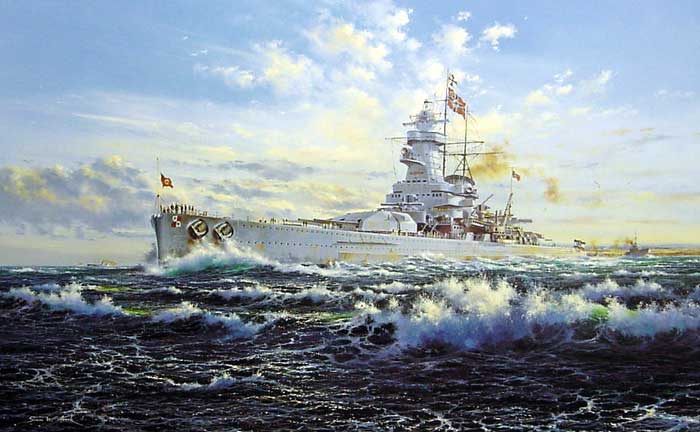
Near the end of a successful raiding cruise the panzerschiff Graf Spee, under the command of captain Langsdorff and searching for merchant ships sailing from Montevideo to the UK via Freetown, was some 150 miles east of the estuary of the River Plate. Her lookouts spotted masts on the horizon at 0552, off the starboard bow. These were the masts of British warships--not unarmed merchant ships. Graf Spee went to action stations, and turned to engage, as the lookouts at first identified at least two of the newcomers as destroyers. Near the end of her cruise, Graf Spee no longer had to avoid enemy warships at all costs, and Langsdorff planned to engage and disable any warship capable of shadowing his ship. Destroyers were ships Graf Spee could not hope to outrun, but could easily destroy. More importantly, destroyers were used to escort convoys. The German lookouts soon corrected their mistake, identifying the heavy cruiser HMS Exeter at 0600, and correctly identifying two light cruisers by 0610. But Langsdorff continued the approach, knowing that he could not outrun, but did outgun, the British ships.
The British warships were under the command of Commodore Henry Harwood, along with a fourth ship under Harwood's command, were collectively known as Force G. Harwood had previously had his ships spread out to cover a wide area of the ocean: The light cruiser HMS Ajax watched the River Plate estuary, the light cruiser HMAS Achilles patrolled further north off Rio de Janeiro, while the heavy cruisers HMS Exeter and HMS Cumberland guarded the Falkland Islands to the South. Harwood flew his flag from the Ajax, to be closest to the center of the patrol areas.
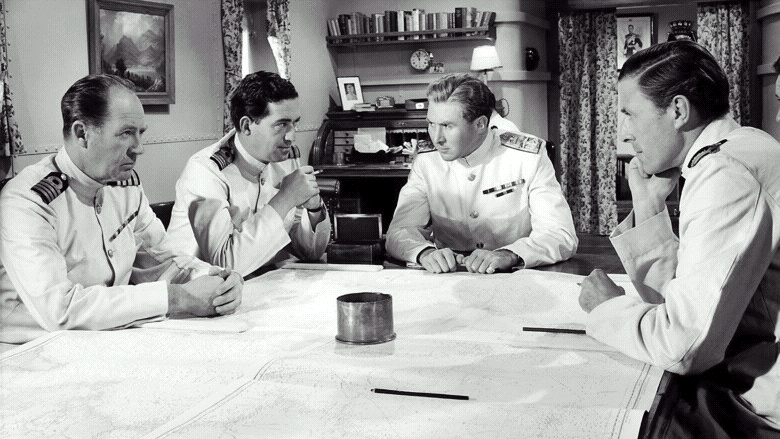
Graf Spee had attacked the Doric Star some 3000 miles from Harwood's patrol area on December 2, he was certain that the raider would return to the rich hunting grounds of the River Plate-UK shipping routes, on which the Germans previously enjoyed success before diverting to the Indian Ocean. Alone, none of Harwood's three operational ships could hope to defeat the Graf Spee, but together they were more than capable. Harwood did some calculations from Doric Star's location when attacked, and figured that the Graf Spee could reach the waters off Rio by the 12th, the River Plate area by December 13, or the Falkland Islands by the 14th. Harwood gambled that the raider's captain would prefer to intercept merchantmen sailing to the UK than to avenge his ship's namesake by attacking the Falklands, and further deduced that the traffic off Montevideo/ Buenos Aries was more tempting that that off Rio, so he planned to concentrate his ships off the River Plate.
He sent his orders out on December 3: Ajax and Cumberland were to seek and capture the SS Ussukuma, a German freighter in the area capable of resupplying German raiders. Following this interception on the 5th, where the German ship was intercepted but managed to scuttle itself to avoid capture, Cumberland would return to Port Stanley in the Falklands to perform refit and repairs to herself as best she could due to boiler problems. Exeter would leave Port Stanley on the 9th, and the three operational ships would meet at a point 150 east of Montevideo on December 12.
The next morning, the three ships were steaming in line ahead, at the moderate speed of 14 knots, patrolling roughly east-northeast. Like his German counterpart, Harwood did not have his recognizance aircraft patrolling, though for different reasons. While the German plane was inoperable due to a design flaw (the Arado 196 tended to land fast and hard, splashing cold water up on the engine that cracked the hot cylinders, so eventually the ship simply ran out of spares and what cylinders could be cannibalized from the spare aircraft), the British commander simply chose not to operate his.
Harwood had guessed right: soon after dawn his lookouts spotted smoke on the horizon, caused by Graf Spee's diesel engines, which were badly in need of overhaul. At 0604 Exeter reported sighting smoke, and at 0616 signaled, "I think it is a pocket battleship." Thanks to the trickery of the Germans, the British did not know if the vessel they were about to engage was Graf Spee or Admiral Scheer.
Langsdorff was faced with three opponents, the slowest of which had a speed advantage of seven knots over his tired vessel. Avoiding combat was not an option, so the question became how to best engage his numerically superior, but smaller-gunned opponents. He could turn away and keep his distance as long as possible, firing his 11.1" guns at long range, hoping to disable at least one of the enemy vessels before they could get into range to reply, and then use the superior weight of his larger guns to disable or drive the remainder off. But in doing so he would waste tremendous amounts of his limited ammo: hits were rare at long range, especially firing only the three guns of the aft turret, and he might expend all 300 shells in the aft magazine without disabling all three British cruisers. So instead, Langsdorff ran toward the enemy at full speed, closing to 20,000 yards, and then turned broadside to bring all six main guns and half his secondary guns to bear, hoping the greater weight of fire at shorter range would more quickly tell on the most powerful British ship, Exeter. At 0618, Graf Spee opened fire, expecting her weakly armored and armed opponents to shadow or retreat.
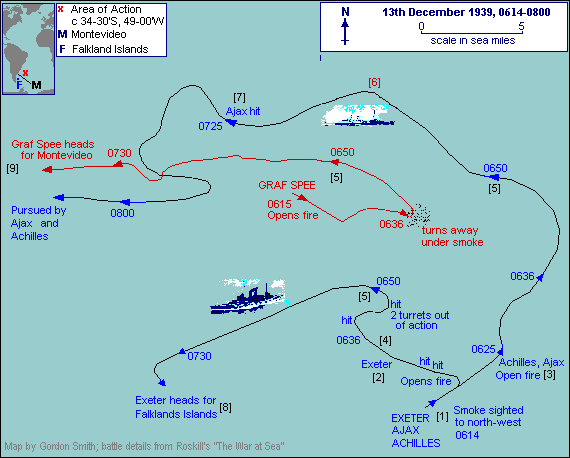
Harwood also had a choice to make. He had no plans to shadow, as attack to end the raider's days was his only option, but he could attack in one of two ways. He could keep his ships together to face his more heavily armored and armed opponent as a single group, or he could split them up and attack from two angles, but risk putting one of his ships in a position where it might face the superior German one-on-one. With a great speed advantage and in a daylight action, Harwood chose to divide his ships into to divisions: Ajax and Achilles would close one flank, while Exeter attacked on the other. He had previously communicated these instruction to his captains, so as soon as the enemy was sighted on a bearing of 320 degrees, Captain Bell took Exeter off at high speed on course 280 degrees allowing all three main turrets to bear on the stern of the enemy, while Captains Woodhouse and Parry took Ajax and Achilles to full speed on course 340 degrees.
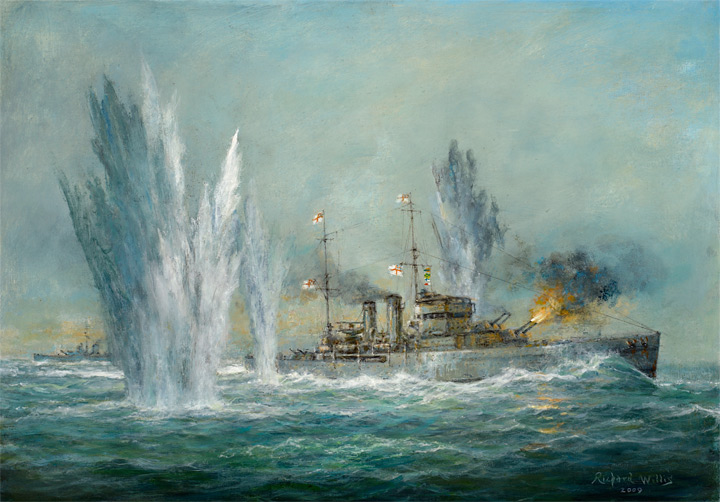
Ajax led, with Achilles 800 yards behind, as the two smaller ships converged with Graf Spee's bow.
At 0620, Ajax and Achilles returned Graf Spee's fire at a range of 19,200 yards, and a minute later Exeter followed suit, at a range of 19,400 yards. Their fire was coordinated by radio from Ajax.
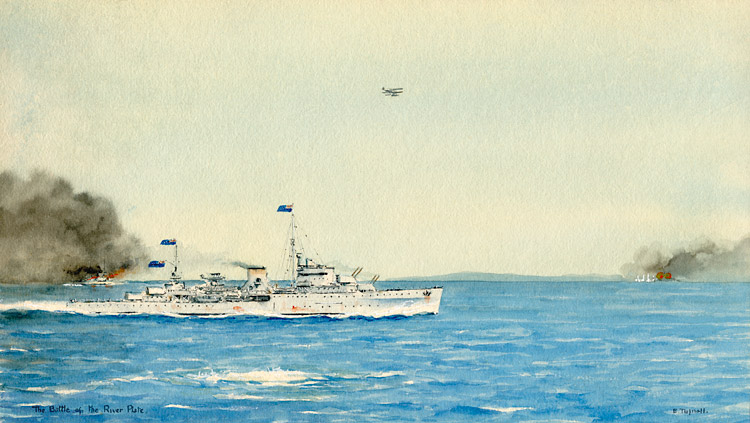
Graf Spee drew first blood, though her gunnery officer underestimated Exeter's protection and ordered High Explosive, impact-fused shells instead of Armor Piercing. Her third salvo straddled Exeter and scored one hit, amidships where it killed the crew of the starboard torpedo mount and disabled both of Exeter's Walrus seaplanes, denying Harwood their use during the battle. A few seconds later, another shell struck the heavy cruiser, passing through the deck and out the side of the ship near "B" turret--without exploding. Soon a third hit, from the German's eighth salvo, struck the front of "B" turret, putting it out of action and sending splinters across the bridge, killing everyone except the captain and two other officers, all of whom were wounded. The wheelhouse was damaged also, severing communication with steering and engineering; the ship went out of control, and fell off to starboard. Captain Bell, bleeding from a wound to the face, set up command in the secondary conning position and passed orders with messengers, getting his ship back on course. Meanwhile, two more shells struck the ship forward, one of which blew a six-foot by eight-foot hole in the bow after striking an anchor, the other of which started a fire in the forecastle. Soon another sprayed splinters across "X" turret, temporarily disabling it. In exchange, Exeter's gunners scored but on hit on Graf Spee, which struck her control tower killing several officers and instrument operators, damaging communications, and destroying the main rangefinder.

By 0630, Ajax and Achilles had closed to nearly 13,000 yards, putting out a great volume of shells with their smallish but rapidly-firing guns. Langsdorff was obliged to shift targets, giving Exeter a reprieve while he turned his guns on the light cruisers. With communications down and the main director gone, the turrets fired on local control. The secondary guns, 5.9" and 4" weapons, had engaged the light cruisers--but scored no hits.
The British cruisers changed course rapidly, weaving in and out, avoiding the German shells and suffering only light damage from the splinters of near misses. Exeter fired off her starboard torpedoes and the Germans altered course 150 degrees to port at 0636, under cover of a smoke screen, to avoid them and open the range from Ajax and Achilles to 17,000 yards. The secondary guns continued to target the light cruisers, but main gun's fire shifted back to Exeter. Freed from heavy fire, Ajax flew off her spotter aircraft, only to find that radio difficulties prevented communications with it.
The British heavy cruiser scored a second hit on Graf Spee, but soon began to suffer. An 11" shell slammed into the deck near a firefighting team, causing many casualties. Bell swung his ship to starboard, to bring his port torpedoes to bear. Three more 11-inch shells found their mark, one destroying "A" turret, one causing heavy casualties in the armament office, and the third passing through the ship's side and three bulkheads before blowing a twelve-foot by sixteen-foot hole in the chief petty officer's quarters.
Exeter was in bad shape. Fires raged all over the ship, she had a 10-degree list and was trimmed down by the bows from flooding, communications were down, power was out over most of the ship, and only "Y" turret rained in action. The gyro-repeaters were out of action, so Captain Bell had to con his ship using only a hand compass from a lifeboat. 61 officers and men were killed, and 23 wounded. But the ship kept her speed, and stayed in the fight. A grim faced signalman on Ajax, looking at the burning and listing Exeter, commented to his officer, "It looks, Sir, as if it is going to be another bloody Coronel."
Meanwhile, Graf Spee had continued to be target to the light cruisers' guns. Many simply ricocheted off her armor belt, and Harwood later commented that, "We might as well have been throwing snowballs at her." But the rapid fire of the 6-inch guns was having more effect than Harwood thought, and Graf Spee was suffering many casualties among the crews of her weakly protected secondary battery. Rather than press home his advantage and attempt to finish off the British cruisers, Langsdorff decided to open up the range: he had not expected the inferior British ships to slug it out at short range, and he was suffering more damage and casualties than was acceptable: his ship, after all, still had to get past the Home Fleet and travel 12,000 miles to get to the nearest friendly base.
Graf Spee continued to swing around to the west, and Harwood feared that she would double back and finish off Exeter, so he turned west also to once again close the range with his light cruisers. Exeter suffered a short-circuit which eliminated her last turret from action. She was now a lame duck, and her crew watched the battling ships disappear over the horizon.
Graf Spee turned her fire once again to the smaller ships, while continuing westward to try to keep the range open. At 0720, Langsdorff swung his ship to port to bring all guns to bear again. 6-inch shells found their mark, starting fires on Graf Spee. Achilles was straddled by a salvo of large shells, splinters from which damaged the control tower, killed several officers and men, destroyed the wireless gear, and wounded Captain Parry. Ajax fired her torpedoes, but Graf Spee sighted them and took evasive action. Her 11-inch guns paid back Ajax for her insolence, with a hit that disabled "X" and "Y" turrets, killing six and wounding 2 before exploding in Harwood's cabin and destroying all his personal belongings. Graf Spee's own torpedoes were fired from her starboard tubes. Radio communication had been established finally with Ajax's Seafox spotter plane, and it signaled, "Torpedoes approaching; they will pass ahead of you." Harwood altered course, and the torpedoes sped by harmlessly.
The British guns continued to blaze, but it appeared that they were incapable of stopping Graf Spee. Ajax's guns had fired 3-400 rounds in rapid succession, and they would no longer return to the load position under recoil. The gun crews poured oil onto them and pushed them back by hand. "B" turret's ammo hoist failed, leaving her with only three operational guns. With the faster British ships closing the range to only 8000 yards, it appeared that they were coming out on the loosing end of the fight. Harwood learned that Ajax had fired 80% of her main rounds, and had to assume that Achilles was similarly short. Fearing that Graf Spee would turn and destroy first one, and then the other light cruiser, he fell back to break off the day action. He decided to shadow until dusk, lick his wounds, and try again after dusk. The British cruisers dropped back, a final hit from Graf Spee carried away Ajax's topmast, eliminating her wireless communication. Harwood made smoke and turned away at 0740, and eventually dropped back to 15 miles, one cruiser on each quarter of the Graf Spee. Captain Parry overestimated Graf Spee's speed, and accidentally closed to 23,000 yards at 1005, only to rapidly open the range under cover of smoke when two salvos from Graf Spee fell close alongside.
Langsdorff, however, had no desire to continue the action, even though he was sure that Exeter was sinking. Graf Spee had fired 60% of her ammo, and was still at a considerable speed disadvantage, so the British cruisers could remain at extreme range until the Germans ran out of ammo. His ship was also more seriously wounded than Harwood thought, having been struck 17 times. He himself was injured, being knocked unconscious by an exploding shell and cut by splinters from two other. Graf Spee was also short of ammo, so Langsdorff made occasional smoke as he retired to the west, making no attempt the turn on his pursuers. He received damage reports from all over the ship, did a tour of his command. What he found distressed him: a six-inch shell had penetrated the starboard quarter, destroying an ammunition hoist and cutting the electricity to the forward 11" turret; another had passed through the ship leaving a three-foot by six-foot exit wound as it passed out the port side; a third destroyed a 4" gun and its ammo hoist. A 5.9" mount, the ship's galley, the main rangefinder and the radar were destroyed by shellfire, and fire had destroyed the scout plane, three of the ship's boats, and Langsdorff's cabin. The onboard plant to purify her diesel fuel for her engines was damaged beyond repair, there were six leaks below the waterline, and a shell had wrecked the bridge as it passed through without exploding. There were 36 dead and 59 wounded, and there was much repair work to be done before the ship could attempt the long voyage home. Langsdorff told his navigator, Jurgen Wattenberg, "We must run for port, the ship is no longer seaworthy."
But where to go? The two only two choices were Buenos Aries or Montevideo. Both nations were neutral, but Argentina had better relations with Germany while Uruguay leaned towards the U.S. and UK. Many authors have criticized Langsdorff for choosing Montevideo; some even claiming his judgment was impaired due to his being in shock from his wounds. Perhaps Argentina would be friendlier, but it was not a good choice for several reasons. For starters, Montevideo was simply much closer. Secondly, the waters of the River Plate are some of the most dangerous in the world, and the estuary is littered with literally thousands of wrecks; Graf Spee would have to stop to take on a pilot, unthinkable with the British close behind. Also, the Panzerschiff drew 22 feet of water, even without any damage. This meant that she would have to stay in the narrow dredged channel to reach Buenos Aries, while the British cruisers, which drew only 16 feet, would have freedom of movement. The channel was only 23 feet deep at some places, so if the British scored a hit below the waterline Graf Spee would ground, unable to move. Even if she did not run aground, the German ship's water intakes for the cooling system of her diesels were at the lowest part of the ship's bottom, and any mud sucked in would cause the tired engines to overheat very quickly, immobilizing the ship. Disabled or stuck, Graf Spee would be easily destroyed, but would not sink, allowing the British to capture her. Buenos Aries was out; the ship would head for Montevideo. Langsdorff sent a brief action report to German High Command, and announced his intention to enter Montevideo. Admiral Raeder replied in agreement with the plan.
Langsdorff sent someone to check on his prisoners, 62 British officers and seaman who had escaped injury in their compartment deep within the ship. They were fed, and all breathed a sigh of relief at their mixed blessing: while they had wished the Royal Navy victory, the destruction of the Graf Spee would have meant their deaths. They were not yet free, but they were alive.
Harwood dispatched the Seafox to check on Exeter around 0800, fearing the worst when she failed to respond to calls from Achilles. The plane found Exeter, which signaled that she was hit hard and, was ablaze amidships, but not in need of immediate assistance. When Exeter finally rigged up some wireless equipment, Bell reported, "All turrets out of action. Flooded forward up to No. 14 bulkhead, but can still do 18-knots." She was of no further fighting value, so Harwood ordered her to Port Stanley. With some luck and fair weather, she would make the 1000-mile voyage without sinking.
Cumberland was ordered to leave the Falklands immediately to replace Exeter. The order came at 0916, and by 1000 she was clearing Port Stanley. Captain Fallowfield had put his ship's boilers back together and raised steam on his own initiative when he heard radio signals of the battle, and raved to the Plate area at best speed. He would arrive in 36 hours.
At 1104, Graf Spee sighted a merchant ship, the British steamer SS Shakespeare bound for the UK of Montevideo. Langsdorff altered course to intercept, intending to sink the ship with a torpedo as he went by and claim one last victim. Always chivalrous, Langsdorff signaled his intention to the steamer's captain, telling him to abandon ship, and also to Harwood, asking him to "Please pick up lifeboats from British steamer." The German captain used his ship's correct call sign, and for the first time the British knew what ship they had been fighting. Shakespeare's captain hove to, but did not abandon ship. Without the time to wait, and never being one to sink a vessel with unarmed sailors on board, Langsdorff turned Graf Spee back towards Montevideo without firing. [EDITOR: apparently a decent man and not a Nazi?]
Harwood signaled the British Naval Attaché' in Buenos Aries at 1347, saying that the German warship was heading towards the River Plate area. His cruisers continued to follow the German ship as it headed for Montevideo. At 1543 that afternoon, Achilles sighted a ship that was identified as a Hipper class heavy cruiser. For 20 minutes Harwood and Parry wondered how they could possibly face German reinforcements, until lookouts corrected their error and identified the ship as the British steamer SS Delane, who's streamlined funnel resembled those of German cruisers.
Late in the afternoon, long before any ships were sighted, the thunder of distant gunfire was heard in Punta del Este, on the northern edge of the River Plate estuary. The flagship of the National Navy, the 1,150-ton gunboat Uruguay under the command of Captain Fernando J. Fuentes, sailed out to investigate. The rest of the National Navy (consisting of three other gunboats) went on alert, ready to defend the nation's territorial waters and enforce International Law. While these craft with their diminutive guns were no match for a large warship in the open ocean, their shallow draft and torpedoes gave them an advantage in the estuary. Around 1800 hours, Uruguay's lookouts spotted Graf Spee, and settled in to watch the action.
The coast of Uruguay was sighted at around 1815, and by 1900 Harwood guessed that Graf Spee intended to enter the River Plate estuary. He ordered Achilles to follow Graf Spee into the wide estuary of the river, International Law allowing "hot pursuit" to override the respect for neutral territorial waters, while Ajax turned south to prevent the Germans from suddenly doubling back. At 1915, Graf Spee suddenly turned broadside and fired two salvoes at Ajax at the range of 26,000 yards, causing the cruiser to turn away and make smoke. At 2048, just after sunset, Graf Spee fired three salvoes at Achilles, compelling that vessel to keep her distance and reply with five salvoes of her own. In the gathering darkness Parry had to close to keep Graf Spee in visual range, and increased speed to get within 10,000 yards. Graf Spee fired three salvoes between 2130 and 2145, but Achilles did not back off. Parry could clearly see the silhouette of the German warship against the lights of Montevideo, and reported just before midnight that Graf Spee had dropped anchor. A quick estimate of the repairs needed for the long voyage home was two weeks, so the Germans needed an extended stay in Montevideo.
A few minutes late, a German officer unlocked the door to the compartment that held the British prisoners and told them that Langsdorff would release them in the morning. Under International Law, Graf Spee could not hold prisoners and claim "havarie," the privilege of sanctuary for damage caused at sea.
The British cruisers took up station in two separate channels along the 136-mile wide estuary, hoping that Graf Spee would stay put, as they were in no position to stop her. Ajax had half of her guns out of action, and had only enough ammo to keep the others in action for 30 minutes. Achilles had suffered only splinter damage, but carried only enough ammo for 15-20 minutes. The closest reinforcement, Cumberland, was still 24 hours away. Harwood would not be deterred; he informed his officers and crews that in the event of Graf Spee's sudden exit from harbor his policy was "destruction," prompting someone to mutter "Whose?"
Reinforcements were on the way, with Cumberland already en route and scheduled to arrive the next day. The battlecruiser Renown, the carrier Ark Royal, and the cruiser Neptune were a thousand miles away off the north of Brazil, and the heavy cruisers Dorsetshire and Shropshire were dispatched from Cape Town to arrive in 5 days time.
While the diplomatic and legal maneuvering began in Uruguay, there was celebration back in Britain. One of the few German heavy ships, and one of the most successful raiders, had been tracked down, engaged, and driven to harbor by inferior forces operating in the best tradition of the Royal Navy. Harwood was an instant hero, and was promoted instantly to Rear Admiral and awarded the Knight Commander of the Order of Bath (KCB), while Bell, Parry, and Woodhouse were awarded the Companion of the Order of Bath (CB).
Before daylight on the 14th, the German Minister Dr. Otto Langmann boarded the Graf Spee. He chastised Langsdorff for not going to Argentina, where the political climate was friendlier and Langmann's job would have been easier: while there was an active pro-Nazi minority in Uruguay, the vast majority of the people disliked authoritarianism and were profiting from trade with Britain.
General Alfredo Baldomir, President of the Republic of Uruguay, and his ministers of Foreign Affairs and Defense, Dr Alberto Guani and General Alfredo Campos, prepared to hear arguments from the British and German ministers before they decided the fate of the warship they now hosted in their harbor. At issue was the interpretation of the Hague Convention of 1907, the relevant International Law. This law stated that a belligerent warship could only stay in a neutral port for 24 hours before that neutral power was obliged to intern it for the duration of hostilities. However, a warship could extend their stay past 24 hours if it claimed "havarie," or the right of sanctuary, because it had suffered damage while at sea. If damage had been suffered, then the neutral power could not force the warship to go to sea until repairs were complete.
Langmann argued his case, pressing for the 15 days Langsdorff said it would take to make repairs to allow the Graf Spee to make a breakout, followed by a run past the Home Fleet for Germany.
The British minister, Eugen Millington-Drake, argued that because Graf Spee had sailed 300 miles at good speed to Montevideo after the battle she was indeed seaworthy, and should not be granted sanctuary for repairs that were to make the ship battleworthy--not seaworthy.
Guani and Campos listened to both sides, and decided not to decide. President Baldomir could not ignore the pro-German element of his population, but did not want to upset relations with either Britain or the pro-British USA, Uruguay's two largest overseas trading partners. They informed the German minister that Uruguayan technical experts would board the Graf Spee to inspect her damage and make their own estimates for repair. They also reminded the British minister that the British cruiser Glasgow had claimed "havarie" after the Battle of Coronel in 1914 and spent a week in drydock at neutral Rio de Janeiro.
Langsdorff kept his promise, and ordered all prisoners released. The British merchant captains Dove and Pottinger went to pay their respects and say goodbye to the German warrior, who had acted more as a host than a captor. Langsdorff greeted them, and gave each of them a cap tally from one of Graf Spee's dead, apologizing that they had been on board for the battle and expressing thanks that none of the British merchant seamen had been injured. A the British merchant officers and seamen mustered on the quarterdeck to be dismissed by the master-at-arms, they passed 36 coffins sitting under the guns of the aft turret; not everyone on Graf Spee had been as lucky as they.
Soon after Langsdorff freed his prisoners in the afternoon, and landed his dead and wounded for hospital treatment, the technical experts toured the ship. They inspected and prepared a report, which they forwarded to Guani and Campos. As they reviewed the report to reach a decision, the British minister, Millington-Drake, interrupted with a request to see them again. It would appear that the British minister had forgotten two of the golden rules of diplomacy: "Be careful what you ask for, because you just might get it." and "for expert advice, ask an expert."
Harwood, knowing that his beat up ships stood little chance of prevailing twice without reinforcements, refueling, and a fresh load of ammo, did not want Graf Spee turned out of Montevideo anymore than Langsdorff did. He needed a few more hours for Cumberland to arrive to give him a fighting chance, and more time past that for Renown, Ark Royal, and the other cruisers to reach the scene. Harwood asked Millington-Drake to use "Every means possible" to DELAY Graf Spee's departure! Harwood needed exactly the opposite of what the British minister had been fighting for.
Harwood's idea was to take advantage of the very law that Millington-Drake had wanted to use to expel Graf Spee from neutral waters. The Hague Convention had a clause in it to protect unarmed merchant ships from raiders: if a merchant ship belonging to a belligerent power left a neutral port, then a warship belonging to the other could not leave that same port for 24 hours, thus giving the merchant ship a fair chance to avoid capture.
Millington-Drake's naval advisor McCall quickly arranged for the British steamer SS Ashworth to leave Montevideo at 1800 on the 15th, and the minister went in to reverse his arguments to the Uruguayan ministers. Guani and Campos made their decision: Graf Spee could not sail before 1800 on the 16th, but had to sail before 2000 hours on Sunday the 17th.
Meanwhile, the crew of the Graf Spee had been busy. Repairs had been started as best they could be, as Montevideo's one shipyard and all local firms refused to help. Some local workers of German origin volunteered, as did the crews of two German merchant ships in harbor. A few civilian technicians from Argentina came to assist also, employed by the German Naval Attaché to Buenos Aries. But the crew of the Graf Spee labored not as men celebrating a victory over British warships, but as men preparing for a battle they knew they could not win.
In the evening of the 14th, Langsdorff met with his officers. The pro-Allied government must not intern the ship, nor could it fall directly into British hands. He intended to attempt a breakout at night.
The next morning Graf Spee buried her dead in a funeral attended only by a few of the crew and a handful of petty officers, as everyone else was busy working on the ship. A naval band let the procession from the dock to the Northern Cemetery on the outskirts of Montevideo. Crowds lined the streets to see the spectacle, including many of the British seamen formerly held on Graf Spee. In a scene that seems out of place in the 20th century, enemies approached each other and exchanged best wishes and handshakes.
After giving a short eulogy at the gravesite, Langsdorff walked down the row of caskets sprinkling dirt on each one. At the end of the row, he came face-to-face with captain Dove, who stood saluting his former captor. Langsdorff paused, looked him in the eye, and stood at attention to return his salute. Dove left a wreath, which said "To the brave memory of the men of the sea from their comrades of the British Merchant Service."
As a last salute to the fallen Germans was given, photographers immortalized the moment: Everyone stood with their arm outstretched in the Nazi salute, except Langsdorff who gave the traditional salute of the old German Navy. All eyes were on the graves, except minister Langmann's, who glared disapprovingly at Langsdorff.
The propagandists on both sides were distressed by this moment. The German media had portrayed Langsdorff as a hero dedicated to the Reich and its leader, boldly standing exposed on the highest point of the conning tower despite his wounds as he won a victory akin to Coronel. They also reported that the British had spat upon the coffins of the fallen German heroes along the funeral route. Their propaganda efforts went out the window when the crew of the Graf Spee vehemently denied these charges, and the photos of the funeral were splashed across the front pages of the world's newspapers.
British propagandists were equally annoyed, as their attempts to paint all Germans as heartless villains were dispelled by Captain Dove's radio interviews about how chivalrously the British sailors had been treated.
But British propagandists made up for their errors by spreading reports that Royal Navy reinforcements had arrived. As the Uruguayan Government informed the German minister of the 72-hour limit, radio reports told of the arrival of Renown and Ark Royal (actually still off Brazil), plus the French battlecruiser Dunkerque. With the departure of the SS Ashworth, Graf Spee's window to leave Montevideo narrowed to just one day. Langsdorff's hopes of a surprise exit from harbor that night were gone. To make matters worse, one of Graf Spee's lookouts sighted a large ship off the Plate, which he incorrectly identified as Renown.
The German Captain met with his crew, which one officer recorded in his diary as being ready to follow their captain blindly, even to certain death. Langsdorff told some of his sailors that he would fight if he could, but if he could not he would not let Graf Spee and her crew "become a target in a shooting match". One of Graf Spee's engine-room mechanics recorded Langsdorff's famous words to the effect that he would not let his ship be shot to pieces by a greatly superior force, and that to him a thousand young men alive were worth more than a thousand dead heroes. [AMEN].
Langsdorff reported back to Berlin: he was trapped, could not leave until at least 1800 on the 16th, and would be interned at 2000 on the 17th.
The German Captain continued, "no prospect of breaking out into the open sea and getting through to Germany. If I can fight my way through to Buenos Aries with ammunition remaining I shall endeavor to do so".
But Langsdorff knew that all of the reasons why Buenos Aries was a bad choice still held true, and that he had no hope of disabling Ajax, Achilles, and Cumberland, let alone Renown and Dunkerque, with his remaining ammo, a mere 20-30 minutes supply.
As this course of action, "might result in destruction [of Graf Spee] without possibility of causing damage to the enemy, request instructions whether to scuttle the ship...or to submit to internment".
The German minister, Langmann, commented, "I regard internment as the worst possible solution. It would be preferable in view of shortage of ammunition, to blow her up in the shallow waters of the Plate and to have the crew interned." The German minister pressed for another extension, but under pressure from the British Guani and Campos held firm.
The message was sent to Admiral Raeder, who consulted with Hitler, who forbid internment. Raeder answered "Attempt by all means to extend time in neutral waters", and responded to the plan to attempt to fight through to Argentina "Approved." It stressed "No internment in Uruguay. Attempt effective destruction if ship scuttled." In other words, as long as the ship was not interned, the decision was up to Langsdorff. The Captain then met with his officers to discuss options. There was a slim chance that the ship could make Buenos Aries without being destroyed, grounding in the channel, or being disabled by mud in the cooling system, but no guarantee that the government of Argentina would be any more willing to let Graf Spee stay past 24 hours than Uruguay had. But then the whole discussion became pointless: as a final insurance against a surprise exit by the German warship, the British steamer SS Dunster Grange had sailed from Montevideo: Graf Spee could not leave before 1800 hours Sunday. With only a two-hour window, there would be no chance to surprise the waiting British by leaving early.
The die was cast. On the night of the 16th, repair work on Graf Spee was halted. She was filled with the sounds of hammering and small explosions, as the fire control installations, radios, radars, and other equipment were blown up. Dials and electronics were smashed with hammers, gun elevation gear was destroyed, and the breach blocks from the main guns were removed and tossed overboard. The British would learn nothing when they boarded the wreck, and Graf Spee's guns would never be used against Germany. Secret documents were destroyed, and the ship's bell, battle ensign, the portrait of Admiral Graf von Spee, and other historically significant items were sent ashore to be carried home in a diplomatic pouch. Powder charges were stacked inside the turrets around a torpedo warhead, flash doors were opened, a torpedo was wired in the engine room, and detonator wires were rigged. Langsdorff instructed that the wires be run to the conning tower, where he would set them off manually. But his officers insisted that he must look after his men, and rigged up a timer instead.
As live radio carried real-time reports to the world, an estimated three-quarters of a million people crowded along the cost to watch the Graf Spee depart and face the waiting British. Tuning in to the radio reports was Harwood, who heard that men and equipment were being transferred from Graf Spee to the German tanker Tacoma. The German Naval Attaché learned that Renown and Ark Royal were still two days away, refueling at Rio, but it made no difference; British warships still hovered outside the channels, and Graf Spee had no chance of escape.
At 1830 Graf Spee ran up two large battle ensigns and weighed anchor. 700 of her crew had been transferred to Tacoma, which under Captain Hans Konow weighed anchor as well, following about a mile behind the warship as she entered the South channel to the sea. Just outside the breakwater, Tacoma stopped and transferred the German sailors to the Argentine tugs Gigante and Coloso, which had been hired out of Buenos Aries. The Uruguayan National Navy quickly turned Tacoma back into Montevideo where she would be interned for the duration for the war, as she had sailed without proper authorization and assisted in a hostile act.
In the south channel, just outside Uruguay's then three-mile territorial limit, Graf Spee swung west, turned out of the dredged channel, and dropped anchor. The timers on the charges were set for 20 minutes, and the order to abandon ship was given. Langsdorff and the last five officers hauled down the ship's ensigns, made sure the remaining crew was safely off, boarded the captain's launch, and moved about a mile away.
Just before sunset, Graf Spee shuttered from the powerful explosion of the torpedo warhead in her engine room. A second later she was ripped apart in a tremendous explosion. Her rear turret was blown clear of the ship, the stern was severed, and flame belched high into the sky. The forward turret did not explode, probably because the initial explosion damaged the firing circuit. But the ship was in flames from one end to the other, and quickly settled into the shallow water with her main deck awash. The fires would burn for two days.
Langsdorff ordered the final entry into the Graf Spee's log: "Graf Spee put out of service on December 17, 1939, at 2000 hours."
Langsdorff and the rest of the crew would reach Argentina, where the German community greeted them with hospitality, fresh fruit, and warm bread. But the Argentine Government's reception was not so warm. Confirming the suspicion that Graf Spee was no more welcomed there that in Uruguay, the officers and crew were not treated as shipwrecked sailors, but were rounded up and interned for the duration of the war. 16 officers escaped in the next two months, and 17 more in August, and a handful in 1942. A few ratings also escaped, and like the officers managed to return to Germany via a variety of routes, including through Japan and the Soviet Union. But the rest went to prisoner of war camps when Argentina joined the Allies in 1943. Six officers and 894 ratings were repatriated in February 1946, aboard the British liner Highland Monarch, fittingly enough escorted by HMS Ajax, while 168 chose to stay. Hundreds more returned, and some 500 of Graf Spee's crew eventually settled in Argentina.
Langsdorff was attacked in the press as a coward and criticized for not going down with his ship. He met with his crew one last time, telling them what the papers were saying, and that he had not lacked the courage to make a final stand, but rather had known that such a stand would have pointlessly killed many if not all of his crew. Dismissing approaching reporters he returned to their billet with his senior officers, were Langsdorff enjoyed their company until about midnight. Going back to his room, he lit a fine cigar, poured a glass of a favorite Scotch, and wrote a letter each to his wife, his parents, and the German Ambassador. After sealing and addressing the letters, Langsdorff spread the Graf Spee's battle flag out, laid on it, and shot himself in the head.
The next afternoon, he was laid to rest in Buenos Aries, at a funeral attended by his officers, crew, and Argentinean officials. SS Ahlea's Captain Pottinger, attended to represent the British merchant sailors once held captive on board Graf Spee.
British officers boarded the Graf Spee as soon as the fires were out, but found nothing of value. One of the Royal Navy's top divers attempted to enter the forward turret to recover the advanced gyro-firing system (actually destroyed before the scuttle), only to become trapped and drown. The wreck of the Graf Spee slowly sank into the mud, until by 1948 only the control tower could be seen above water. In a few years even that was out of sight, and the Graf Spee was just another of thousands of wrecks in the River Plate estuary.
In 1946, Uruguay extended their territorial waters out to 12 miles, later 200 miles, and Germany relinquished ownership of all wrecks inside territorial waters as part of the surrender agreement, so today the wreck is the property of the Government of Uruguay. One of the ship's 5.9" guns was salvaged in 1999 and put in a park along the harbor at Montevideo.
A major salvage operation was announced by a private German group and the National Navy of Uruguay in late 2003, and work began February 2004 to salvage the Graf Spee, drydock her at the Navy Yard for as much restoration and repair as possible, and turn her into a museum at Montevideo. The control tower and aft turret are the first objectives, to be followed by the complete forward section of the hull.
Therefore, despite the success their seaplane fighter provided them, the Graf Spee's AR-196 seaplane fighter was constantly broken and thus denied their captain and staff the ability to see over-the-horizon (OTH) and spoil enemy recon and air attacks upon them at the end of the mission.
At other times later in WW2, the AR-196 performed well and was even used to capture a British submarine the HMS Seal.
AR-96 seaplane fighters used to capture the HMS Seal in WW2
The Japanese had the best seaplane fighters until the advent of the amazing SC-1 SeaHawk by the USN at war's end. The Zero float plane (Allied code-name: "Rufe") was nearly as maneuverable and formidable in dogfights as versions without floats.

Formidable Rufe Seaplane fighter in WW2
Offensively, the lack of a German seaplane fighter enabled British cruisers to use their SeaFox seaplanes to stalk the pocket battleship outside range of her 11" guns and radio-correct in 6" gun strikes with devastating accuracy and then dart back outside of range, and radio-vector help from other ships and planes to corner it. In other words, the pocket battleship without a seaplane fighter that could ward off enemy scout seaplanes and attack other ships beyond her ship armaments cannot shake her followers and break contact. In war, the lighter platform that makes first contact with the enemy as an element independent of the main body must be able to disengage. The USN still hasn't learned this lesson that every individual ship must be self-sufficient as it deludes itself that it will always deploy in mini-fleets (surface action groups) with a bloated super aircraft carrier as base. The USN will claim that helicopters can fly out from destroyers/cruisers to see OTH and can attack with PGMs to be defacto seaplane fighters; but they cannot fly long and far enough without using up limited JP-8 aviation fuel stored--and they cannot ward off enemy fighters.
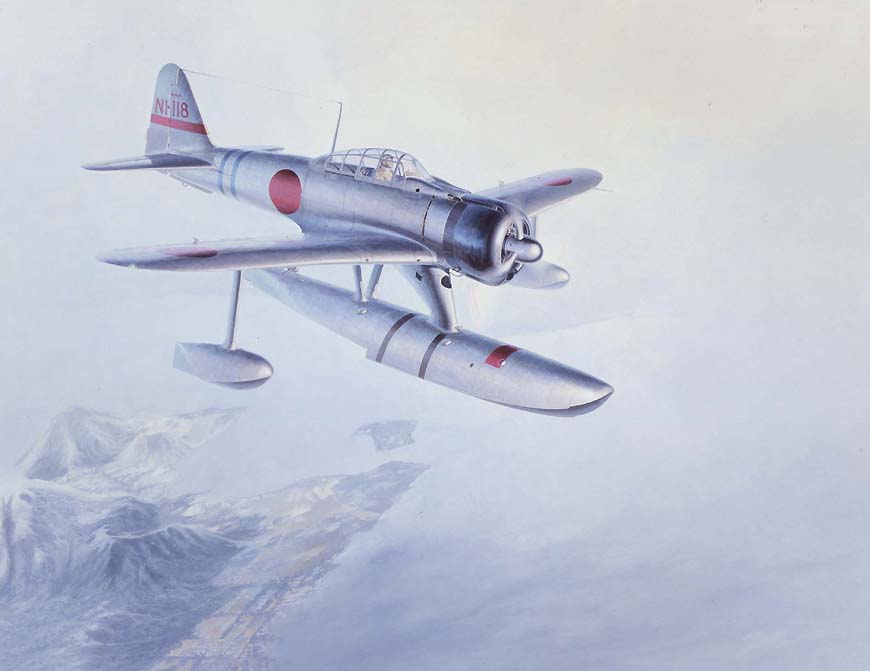
Piasecki VTDP modified UH-60
Current MH-60 helicopters operating from USN destroyers/cruisers need Piasecki VTDP propellers/wings to increase range, speed and flight duration. AMRAAM armament to shoot-down enemy air threats beyond visual range must be facilitated. Work must be done to MH-60 turbine engines to enable ship's fuel to be utilized to increase air coverage. When F-35Bs become available, the formula to operate them by VTOL from destroyers/cruisers rear flight decks must be ascertained. If none of the above can come to pass within the USN bureaucracy, then armed cropdusters like the FireBoss with floats should be put to sea via catapults and cranes to recover them after water landings. If the USN does not take drastic measures to increase both the quantity and quality of the air cover over its surface ships, in the future it is going to have entire fleets sunk like the individual Graf Spee was sunk in 1939 by enemies who know how to attack from a safe stand-off.
How Seaplane Fighters Sank the Graf Spee
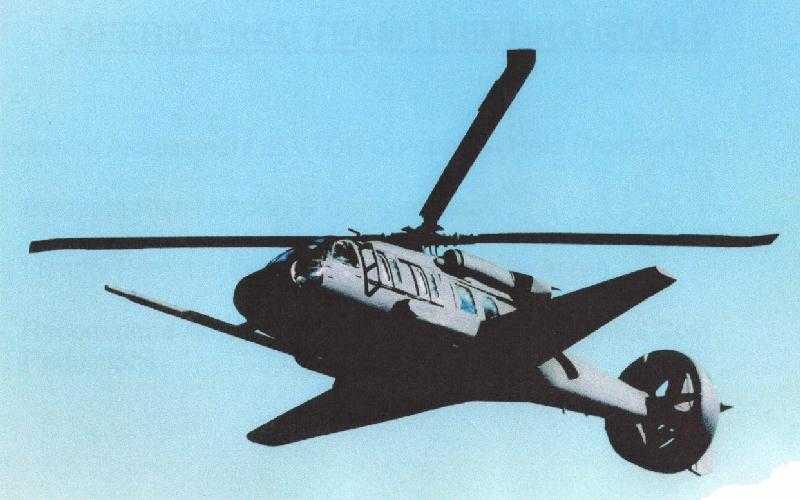
www.fortunecity.com/meltingpot/portland/971/Reviews/interwar/seafox.htm
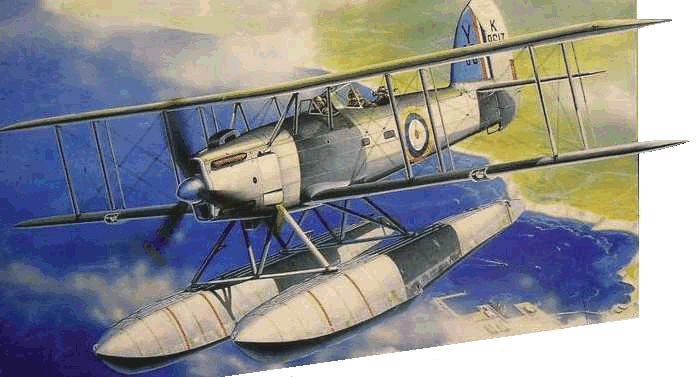
The Seafox's moment of glory came on the 13th December 1939. Flying from HMS Ajax it spotted for the Battle of the River Plate that resulted in the scuttling of the battleship Graf Spee on the 17th. Unfortunately, very little seems to be known about the aircraft. The Ajax carried two Seafoxes probably not camouflaged and possibly K 8581 and K 8582 with the crest of Ajax on the fin. As one was damaged only one spotted but no one seems to remember which or any other details except that Lt. Lewin received the DFC for his efforts and Lt. Kearney was mentioned in despatches. Sixty six aircraft existed, built to specification S11/32 and first flying on 27th May 1936. With a span of 40' and a length of 33' 5 1/2" they were powered by a 395 h.p. Napier Rapier "H" air-cooled engine which proved to be a bit under-powered. It's only armament was a Vickers or Lewis machine gun operated by the observer and it could carry 2 x 100 lb. anti submarine or 8 x 20 lb. bombs under the wings. A couple were also flown with wheels instead of floats.
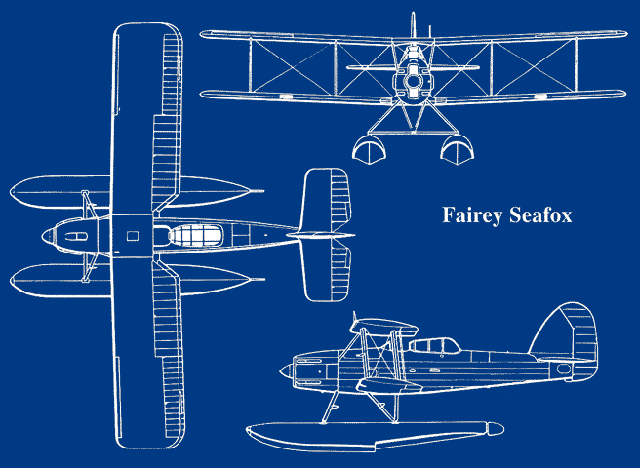

http://en.wikipedia.org/wiki/Fairey_Seafox
Operational history
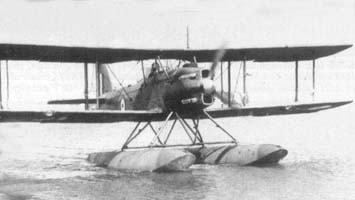
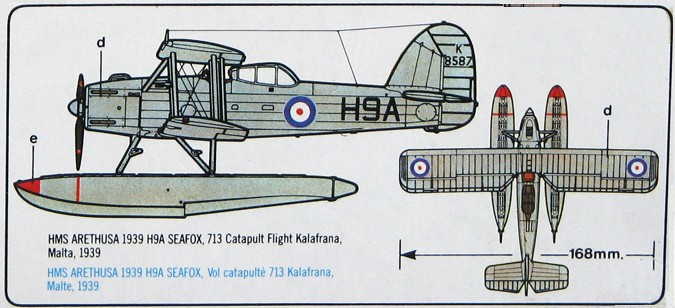
In 1939, a Seafox played a part in the attack on the German
pocket battleship Admiral Graf Spee by spotting for the naval gunners. This led to the ship's destruction after the Battle of the River Plate.
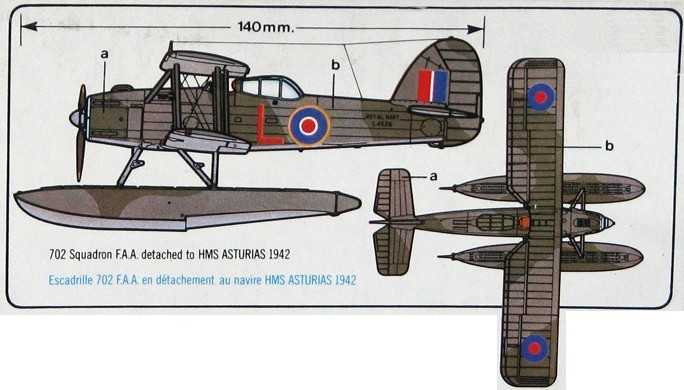
They were utilised up until 1943. The Seafox was operated during the early part of the war from the cruisers
HMS Emerald, Neptune, Orion, Ajax, Arethusa, and Penelope and the armed merchant cruisers HMS Pretoria Castle, Asturias, and Alcantara. The Royal Australian Navy deployed the Seafox aboard the cruisers HMAS Perth, Sydney, and Hobart.Operators
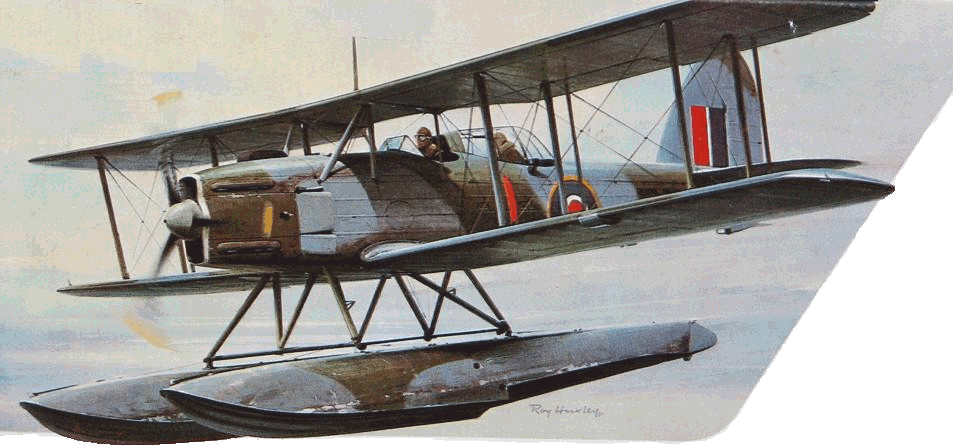
- United Kingdom
Specification
Data from Fairey Aircraft since 1915 [3]
General characteristics
- Crew: 2
- Length: 33 ft 5 in (10.19 m)
Wingspan: 40 ft 0 in (12.20 m) Height: 12 ft 2 in (3.71 m) Wing area: 434 ft² (40.3 m²) Empty weight: 3,805 lb. (1,730 kg) Loaded weight: 5,420 lb. (2,464 kg) Powerplant: 1× Napier Rapier VI piston, 395 hp (295 kW) Performance
- Maximum speed: 124 mph (108 knots, 200 km/h) at 5,860 ft (1,787 m)
- Cruise speed: 106 mph (92 knots, 171 km/h)
- Range: 440 mi (383 nmi, 710 km)
- Service ceiling: 9,700 ft (2,960 m)
- Endurance:4.25 hours
- Climb to 5,000 ft (1,520 m): 15.5 min
Armament
- 1 x 7.7mm medium machine gun
See also
Comparable aircraft
1940
7 November 40.
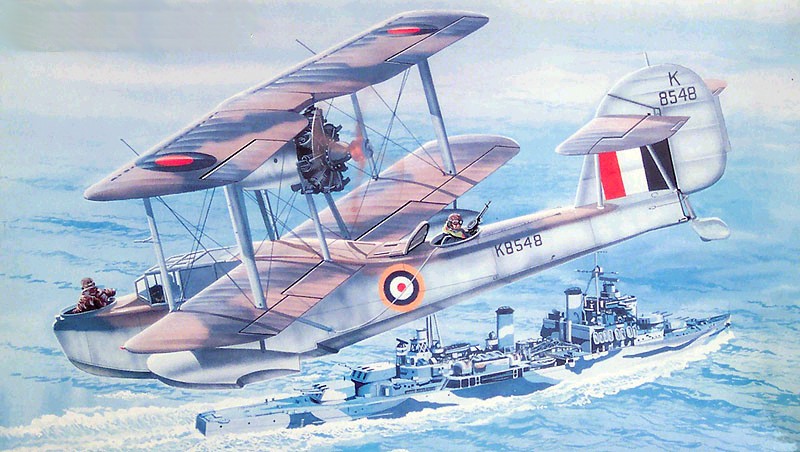
www.youtube.com/watch?v=4-2UAXblTUE
www.youtube.com/watch?v=OTHdb5DEM3g
The Supermarine Walrus was a single-engine amphibious biplane reconnaissance aircraft designed by R. J. Mitchell and operated by the Fleet Air Arm. It also served with the Royal Air Force, RAAF, RNZN, RCAF, and RNZAF.
The Walrus was initially developed for service from cruisers at the request of Australia, and was called the Seagull V; although there was little resemblance to the earlier Supermarine Seagull III. It was designed to be launched from ship-borne catapults, and was the first amphibious aircraft in the world to be launched by catapult with a full military load.
The lower wings of this biplane were set in the shoulder position with a stabilising float mounted under each one, and its horizontal tail-surfaces were positioned high on the tail-fin. The single Bristol Pegasus VI radial engine was housed in a nacelle slung from the upper wing and powered a four-blade propeller in pusher configuration. The wings could be folded on ship, giving a stowage width of 17 ft 11 in (5.5 m). One of the more unusual characteristics of the aircraft was that the control column was not a fixed fitting in the usual way, but could be unplugged from either of two sockets at floor level. It became a habit for only one column to be in use; and when control was passed from the pilot to co-pilot or vice-versa, the control column would simply be unplugged and handed over.
As the Walrus was stressed to a level suitable for catapult-launching, rather surprisingly for such an ungainly-looking machine, it could be looped and bunted, whereupon any water in the bilges would make its presence felt. This usually discouraged the pilot from any future aerobatics on this type.
Armament usually consisted of two Vickers K machine guns, with the capability of carrying 760 lb (345 kg) of bombs or depth charges mounted beneath the lower wings.
The Royal Australian Air Force ordered 24 examples directly off the drawing boards, under the Seagull V "A2" designation, which were delivered for service from cruisers from 1935; followed by orders from the Royal Air Force with the first production Walrus, K5772, flying on 16 March, 1936. It was also hoped to capitalise on the aircraft's successful exports to Japan, Spain, etc.
A total of 740 Walrus were built in three major variants: the metal-hulled Seagull V and Walrus I, and the wooden-hulled Walrus II. The Walrus was affectionately known as the "Shagbat" or sometimes "Steam-pigeon"; the latter name coming from the steam produced by water striking the hot Pegasus engine.
The first Seagull V, A2-1, was handed over to the Royal Australian Air Force in 1935, with the last, A2-24 delivered in 1937 and served aboard the HMA Ships Australia (MTO [Mediterranian Theatre of Operations]), Canberra (MTO, SWPA, lost at Guadalcanal in 1942), Sydney (MTO, SWPA, lost off the coast of Western Australia 1942), Perth and Hobart.
Walrus deliveries started in 1936 when the first example to be deployed was with the New Zealand division of the Royal Navy, on HMS Achilles (later a victor of the Battle of the River Plate). By the start of World War II the Walrus was in widespread use, and saw service in home waters, the Mediterranean and the Far East. Walrus are credited with sinking or damaging at least five enemy submarines, while RAF use in home waters was mainly in the air-sea rescue role. One Walrus, HD874, (Restored and exhibited at the RAAF Museum, Point Cook, Victoria) was still in service in 1947 with the Australian Antarctic Expedition.
The Irish Air Corps used the Walrus as a maritime patrol aircraft during World War II. One of the Walrus aircraft formerly flown by the Air Corps is preserved, albeit in Royal Navy colours. The aircraft was bought back by the Fleet Air Arm after the war as a training aircraft, and now resides in the RNAS museum in Yeovilton.
General characteristics
Crew: 3-4
Length: 33 ft 7 in (10.2 m)
Wingspan: 45 ft 10 in (14.0 m)
Height: 15 ft 3 in (4.6 m)
Wing area: 610 ft² (56.7 m²)
Empty weight: 4,900 lb (2,220 kg)
Loaded weight: 7,200 lb (3,265 kg)
Powerplant: 1× Bristol Pegasus VI radial engine, 680 hp (510 kW)
Performance
Maximum speed: 135 mph (215 km/h) at 4,750 ft (1,450 m)
Range: 600 mi (965 km)
Service ceiling 18,500 ft (5,650 m)
Rate of climb: 1,050 ft/min (5.3 m/s)
Wing loading: 11.8 lb/ft² (57.6 kg/m²)
Power/mass: 0.094 hp/lb (0.16 kW/kg)
Armament
2 x Vickers K .303 medium machine guns
760 lb (345 kg) of bombs and depth charges
There were at least 5 confirmed enemy submarines sunk or damaged by Royal Navy Battleship/Cruiser operated Supermarine Walruses during WWII, including the Vichy French submarine Poncelet which was bombed by Walrus L2268 of 700 squadron (HMS Devonshire) and attacked by HMS Milford off the Cameroons. They were fitted with ASV radar for ASW and ASuW duties on top of CSAR and gunnery spotting.
1941
8 May 41. Only one day after Krüder got his last victim, the German merchant ship cruiser the Pinguin was sighted by HMS Cromwell's seaplane. The British cruiser gave chase. Pinguin hoisted her battle flag and opened fire when Cromwell was 10,500 yards away, despite having 130 mines on board. The cruiser took some hits from the raider, but at 1726 a four-gun salvo from Cromwell found its mark. One shell detonated in Pinguin's mine compartment, resulting in a terrible explosion that ripped her into pieces. Only 25 of the 225 Allied prisoners were rescued, while 60 Germans survived and 342 others perished, including captain Krüder. Adjutant's captain Hemmer and his crew waited at the planned meeting point with Pinguin and when the bad news broke, said goodbye to their fallen comrades with three hurrahs and the record "Goodbye, Johnny".
1942
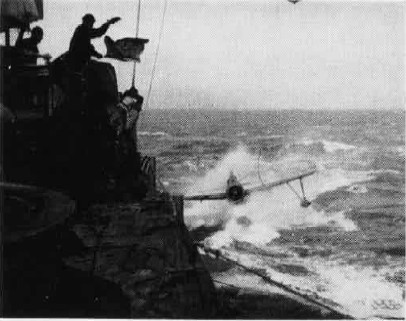
www.janeresture.com/rickenbacker/index.htm
13 November 42. Eddie Rickenbacker's downed B-17 crew is rescued by a Kingfisher seaplane
1943
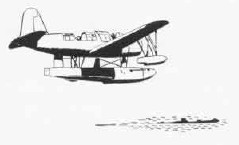
www.youtube.com/watch?v=HT_PClBc8vE
11 February 43. Destroyer Fletcher (DD-445) and seaplane from light cruiser Helena (CL 50) sink Japanese submarine I-18 in Coral Sea.
19 August 43. Kingfisher observation plane sinks Japanese submarine I-17 off eastern Australia
VO observer from seaplane directs gunfire to sink French battleship Jean Bart during the U.S. Army TORCH amphibious landings
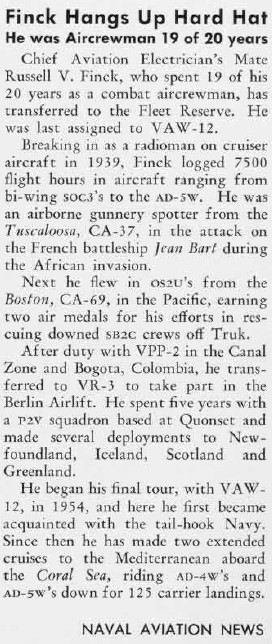
1944
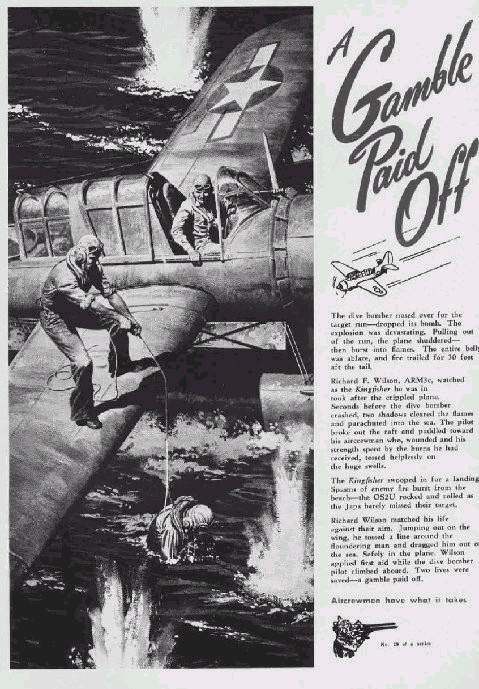
1945
Kingfisher rear gunner shoots down Zero over Iwo Jima
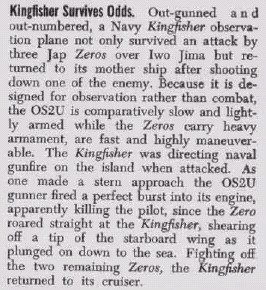
U.S. Naval Aviation News, January 1945, page 23
The U.S. Navy follows the lead of the excellent Japanese seaplane fighters and produces the best seaplane fighter of the war: the SeaHawk.
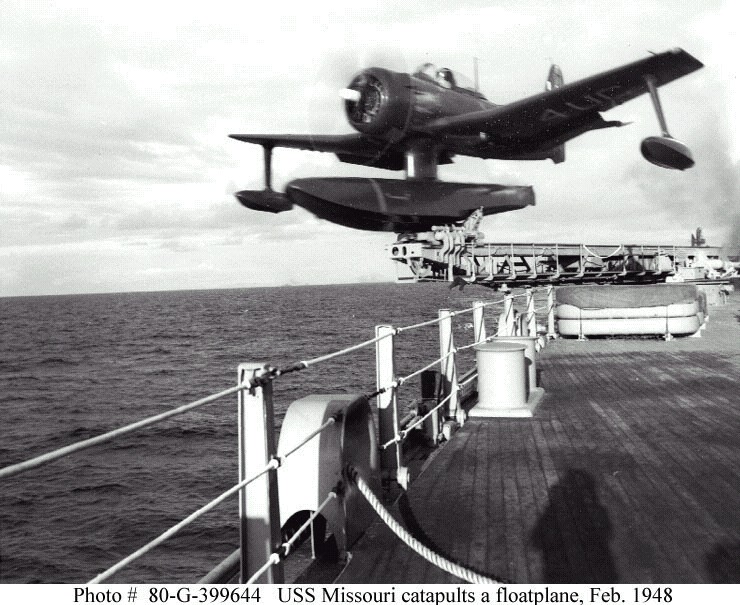
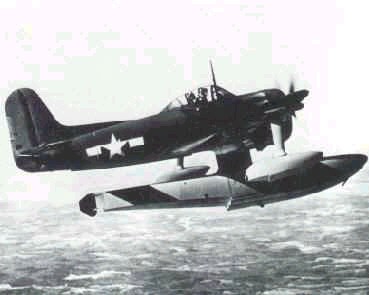
This way, American cruisers and battleships would not fall prey to aircraft attacks that sank the HMS Repulse and Prince of Wales in 1941.
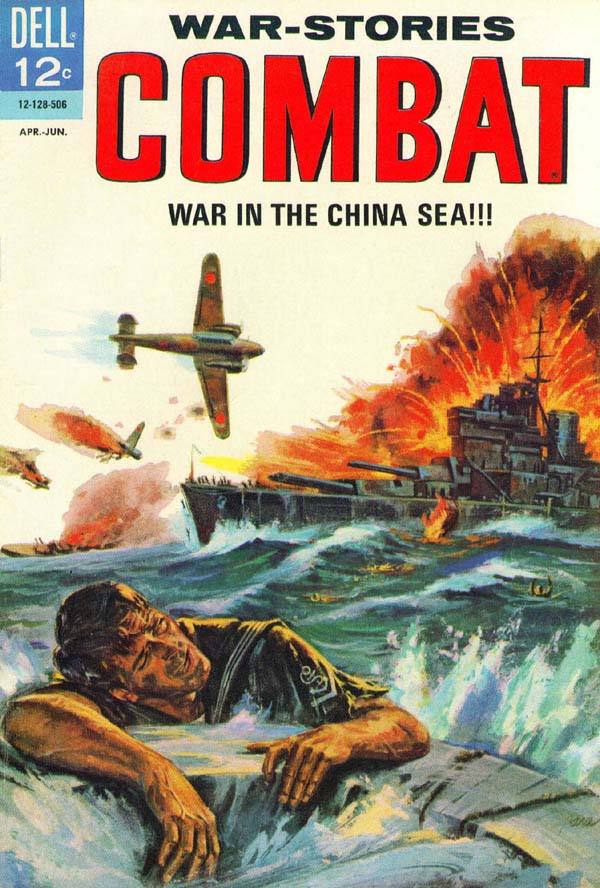
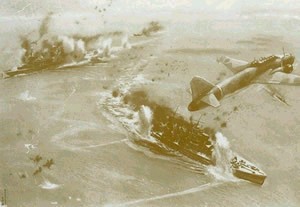
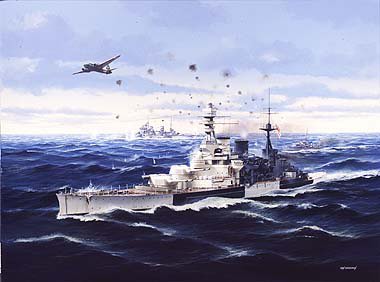
1946

New Small Seaplanes being considered...
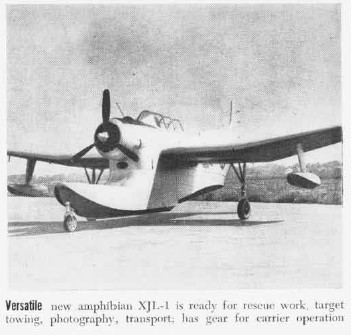
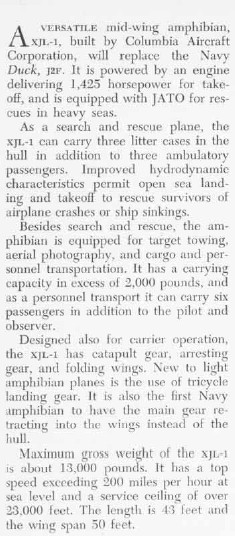
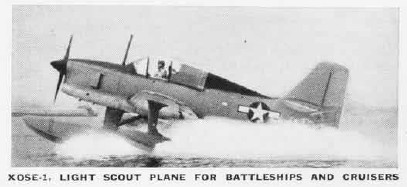
Seaplanes go to the South Pole!
Web link: www.violations.dabsol.co.uk/enigma/enigma.htm
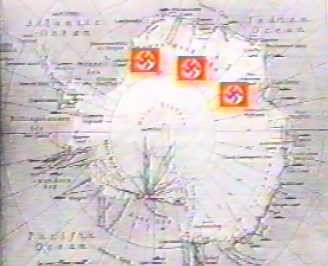
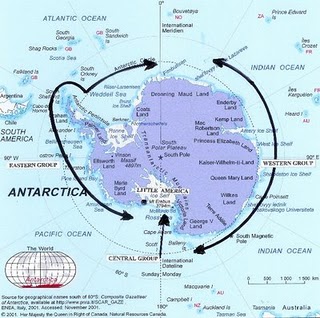
Admiral Richard Byrd invades the South Pole land mass of Antarctica (Operation HIGH JUMP) where under-ice and underground Nazi Germans in secret bases remain in hiding. Quasi-cover story is "Antarctic exploration". About 250, 000 Germans were missing at war's end who were NOT MIA from war combat. Germany had claimed Antarctica as their own territory beginning with their ship-launched seaplane expedition in 1938 (see below under German seaplane section). He uses twin-engined C-47s (R4Ds) launched by JATO rockets from the small escort carrier USS Philipine Sea and PBM Mariner large seaplanes from tenders to scout for clues where the German were hiding.
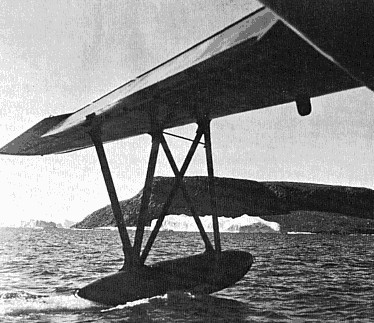
One PBM large seaplane lands and discovers a warm water inlet to the sea that advanced German Type XXI u-boats and other type submarines could covertly enter and exit into while submerged not unlike Captain Nemo's secret base in 20, 000 Leagues Under the Sea.
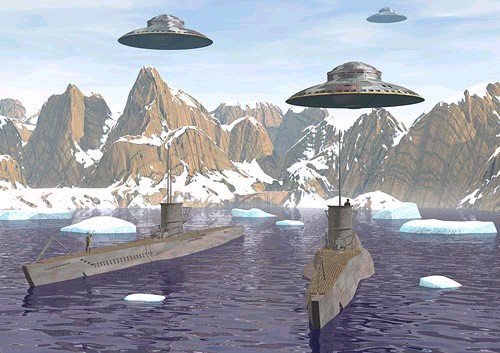
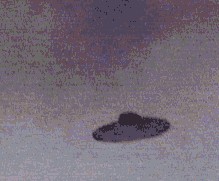
Several of his escorting carrier-based fighters are reported shot down by German anti-gravity flying saucers and the invasion force withdraws.
SeaHawk-in-a-Box!
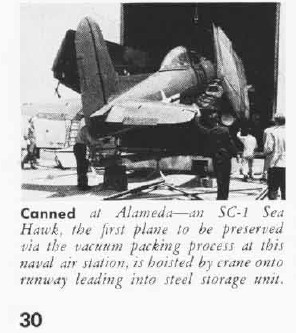
The amazing SeaHawk fits easily into a metal shipping container for long-term storage; clearly ahead of its time by several decades before SeaAirLand ISO containers become the way dry goods move around the globe! Fighters-in-a-Box are the only way land-based aircraft will be able to survive increasingly lethal guided high explosive attacks in the 21st Century.
1947
Downed Pilot rescued by alert SeaHawk pilot!
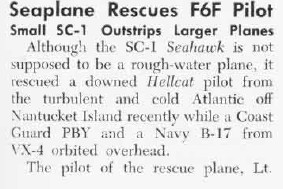
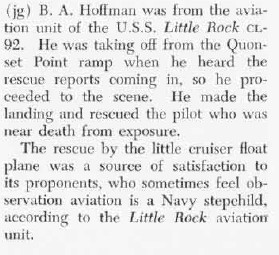
SC-1 SeaHawks take-off with JATO improving their rough sea take-off run capabilities
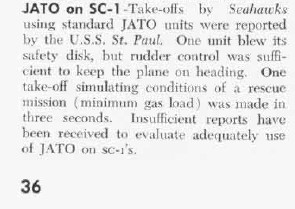
Navy large aircraft carrier brass marginalize the SeaHawk by taking away reminders of its COMBAT functions as a ship-board fighter and naval gunfired spotter for their hated rival cruiser/battleship gunnery faction; budget and ego come before winning wars and saving men's lives.
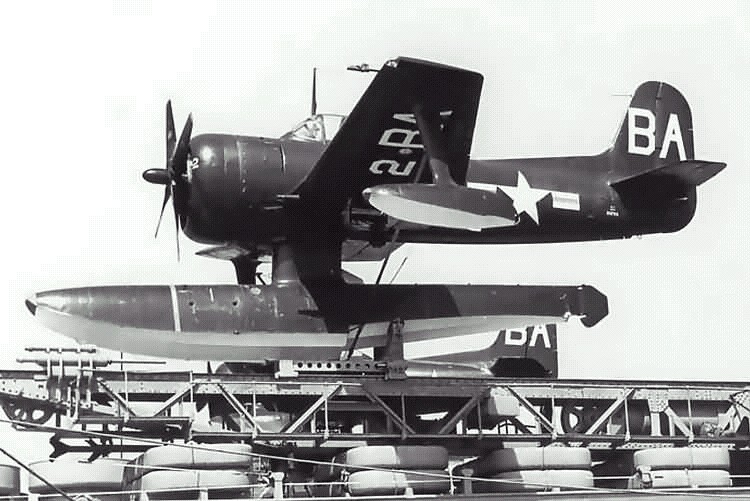
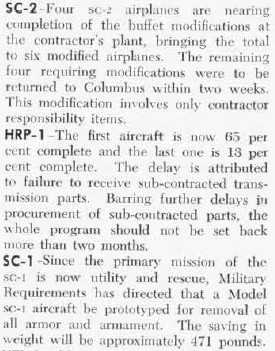
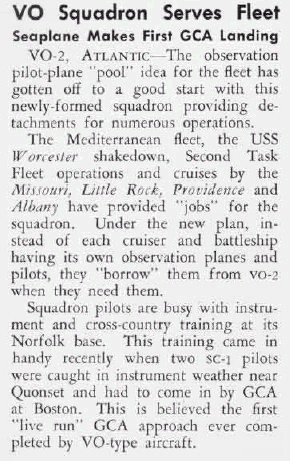
1948
New SC-2 SeaHawk taking lessons learned from fleet combat experience shows amazing rough sea water landing capabilities
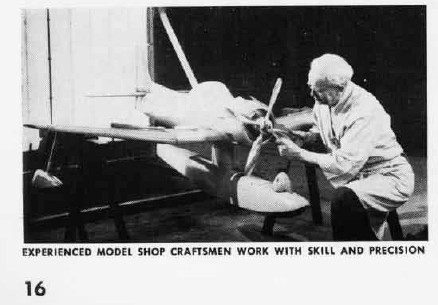
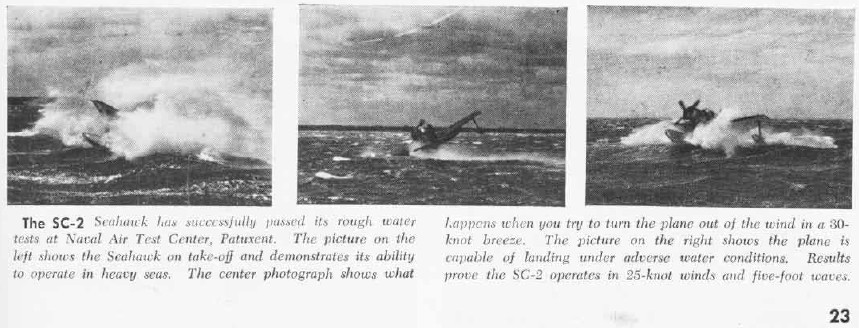
1949
SeaHawks in China occupation duty deploy from their cruiser, the USS Duluth to show their folding-wing truck ground mobility and adaptability to land base use via wheeled landing gear.
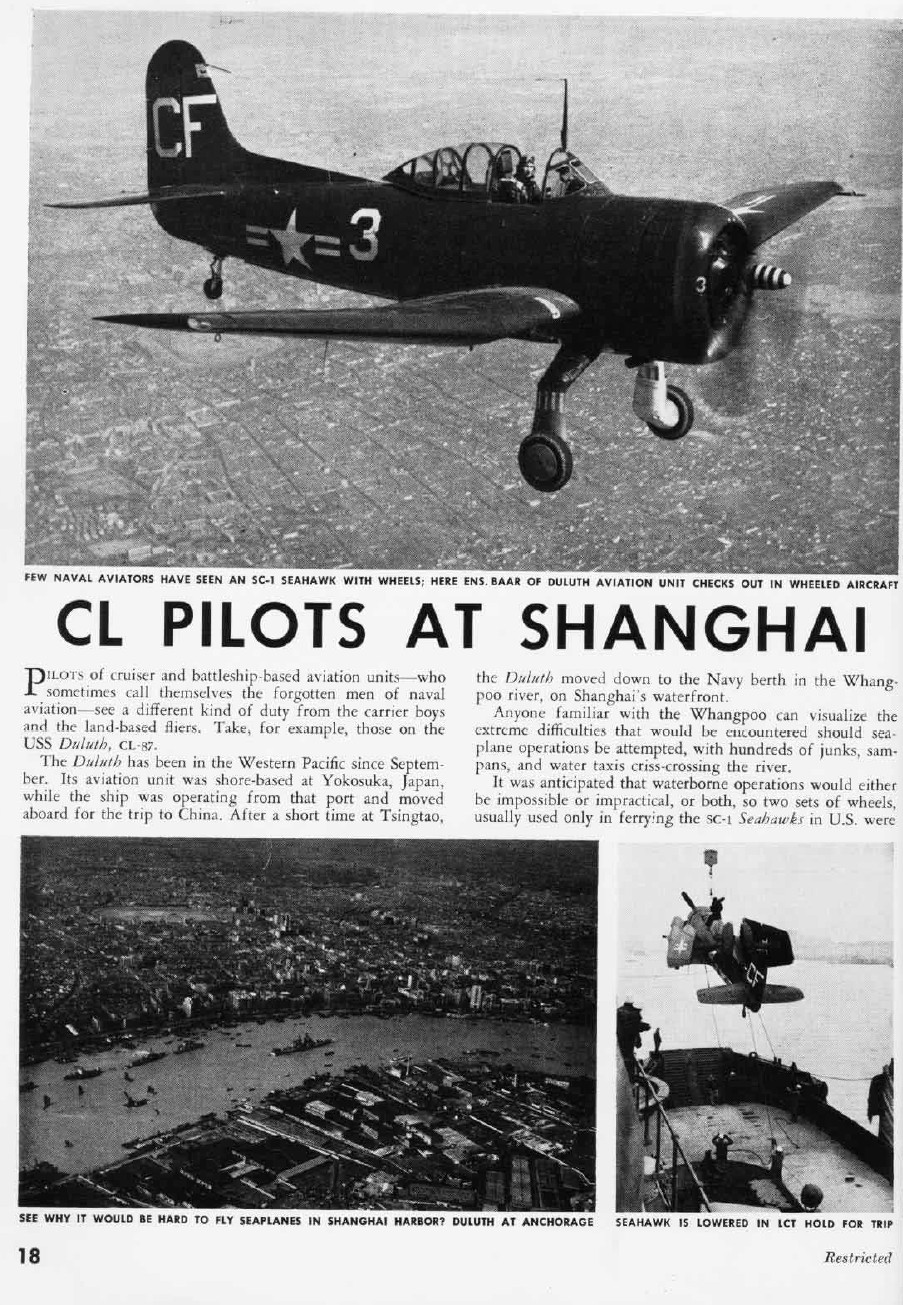
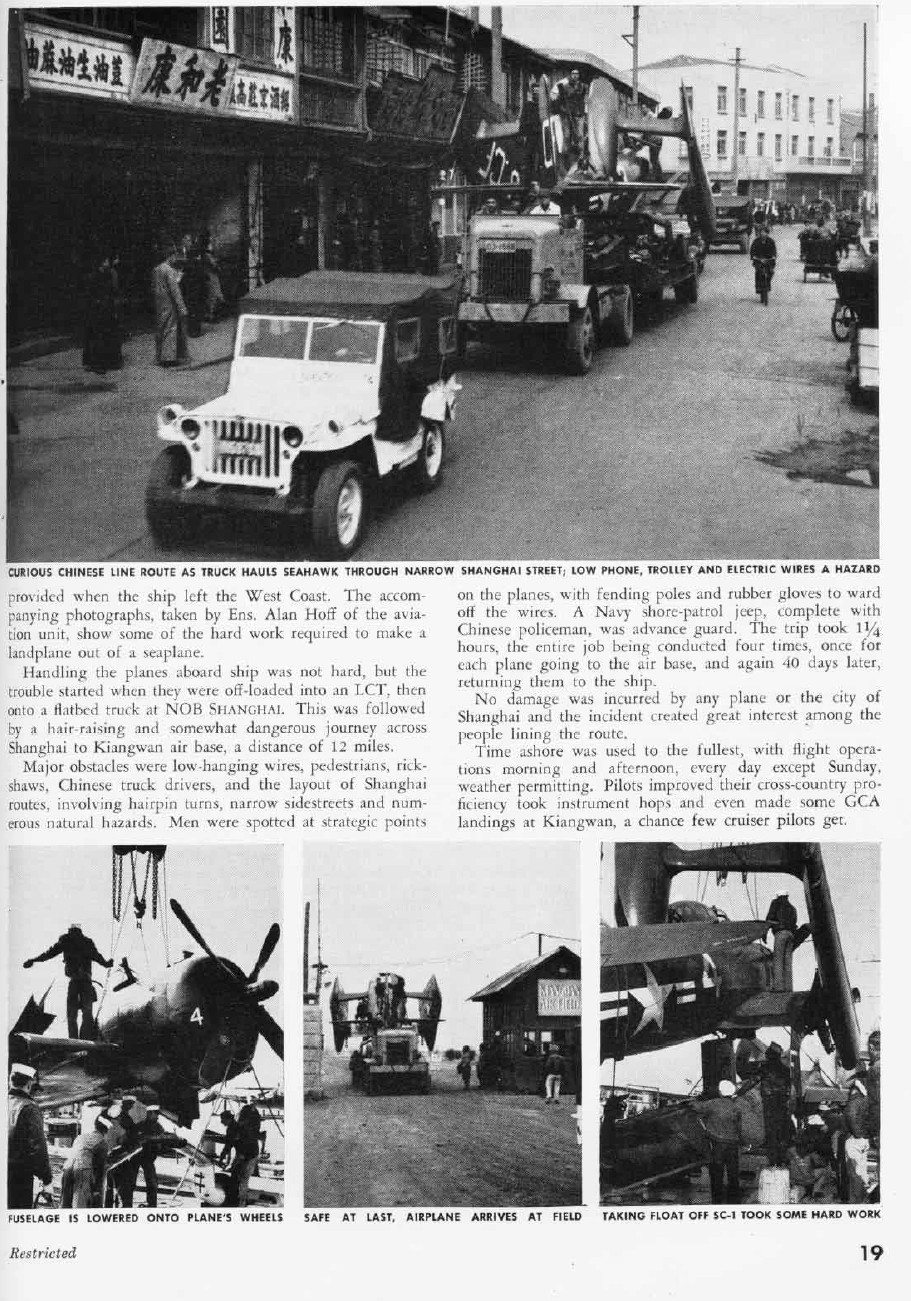
Back-Stabbing Navy Aircraft Carrier Egomaniac Brass Pull Switchero: get Rid of the SC-1/2 SeaHawk seaplane fighters that threaten their greed and ego for BS incapable helicopters; of course there's a dress uniform ceremony for them to spout off platitudes and worship their false tin god of alleged progress as they stab the men before them in the back...
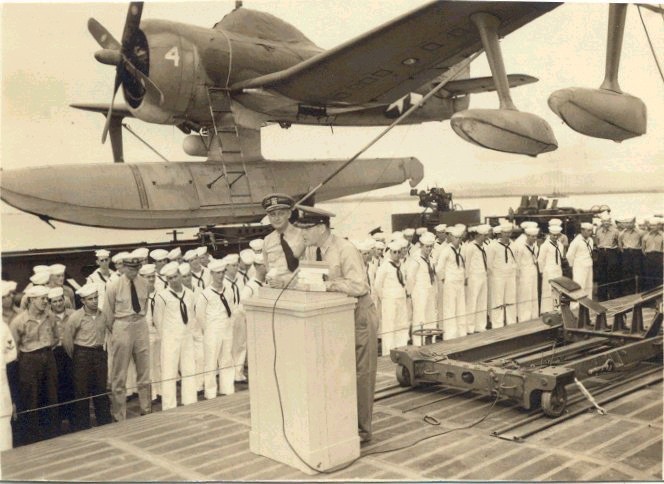
1954
U.S. Navy/Convair "SeaDart" is first seaplane to break the sound barrier in level flight
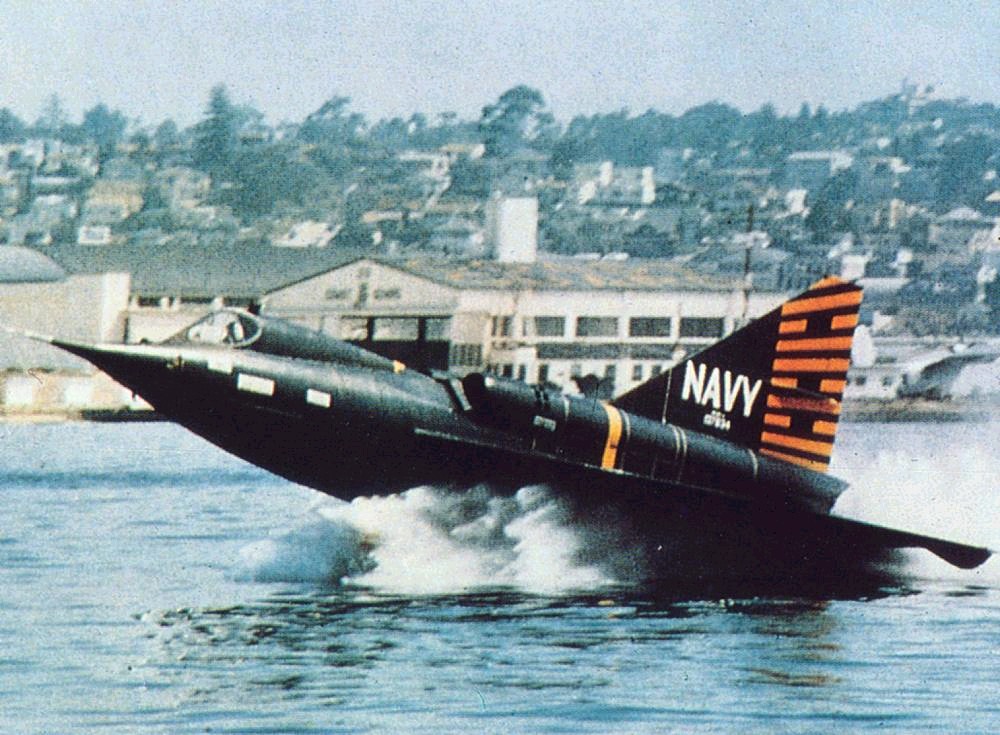
1963
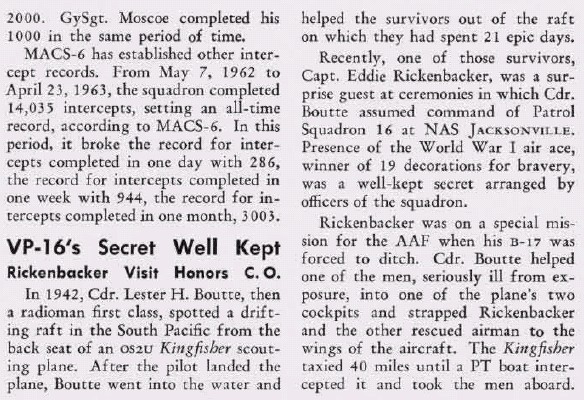
1966
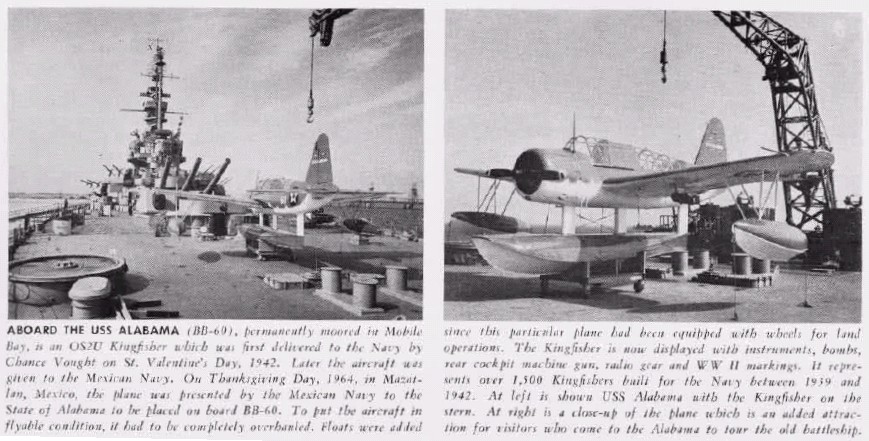
1967
The USMC LARA COIN aircraft competition selects the OV-10 "Bronco" twin-turboprop plane which had the capability to have floats fitted for water landings but this is never exploited operationally. OV-10s would take-off with wheeled landing gear from small amphibious carriers one-way during missions as long as land bases were available since they couldn't return to the ship. OV-10s are later retired in 1994.
1969
British Navy fields the first practical V/STOL subsonic jet fighter-bomber: the Harrier that can take-off and land vertically from small non-aircraft carrier ships decks. AV-8 "A" model's vectored thrust is too tricky to fly and dumb U.S. marines crash nearly every single Harrier they have. The British has ski jumps on the end of their small carriers to give a boost of lift for their Harriers, the USN that sees V/STOL as a threat to their catapult launch and tail-hook recovery seaplanes from large aircraft carriers refuses to put ski jumps on amphibious assault aircraft carriers marine AV-8s use.
1979
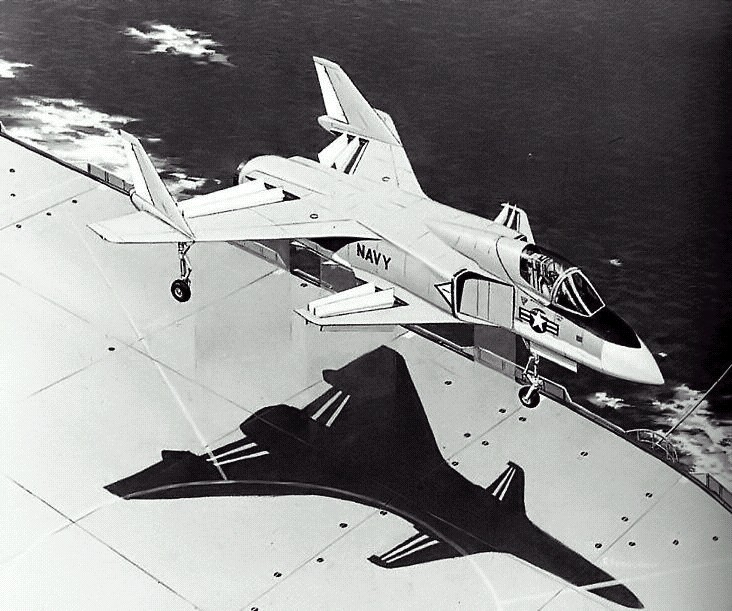
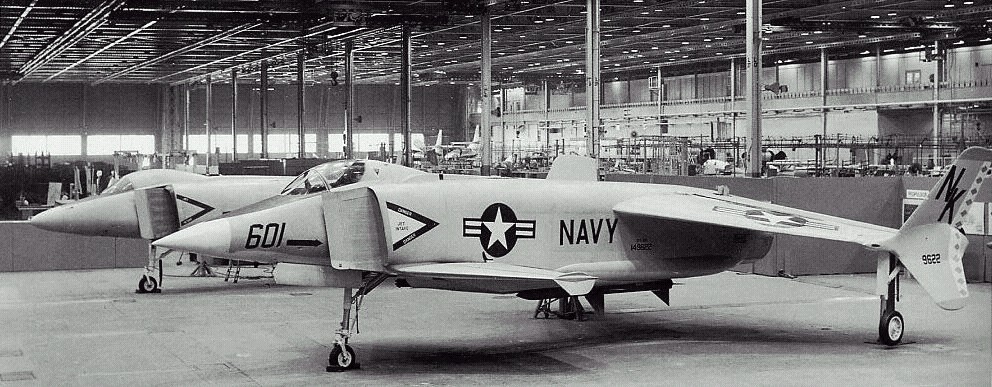
The supersonic XFV-12 V/STOL fighter is built in prototype form to fly much faster than the Harrier to provide adequate anti-air-warfare (AAW) capabilities and uses more spread-out ducted thrust for a safer vertical ascent and landing from small surface ships. Sadly, too much power is lost in the ducting and the XFV-12 cannot even take-off vertically so we remain stuck with the Harrier.
1983
The British drastically improve their Harrier and the "B" model is bought by the USMC, which proceeds to crash them at a high rate. No one even tries to operate Harriers from small ship fantail decks since they need a running take-off to carry a full ordnance load: they are actually STOVL aircraft.
Today
USMC has less than 120 x AV-8Bs and will in 5 years have less than 50% of these in service at current crash/loss rates. The safer lift-fan STOVL F-35B Joint Strike Fighter (JSF) program drags on and on with delays and Lockheed-Martin corporate greed hissy fits. USN/Mc's entire naval aviation future rests on the F-35 which can at any moment be cancelled since the USAF really doesn't want F-35As and wants more capable F-22s operated from pampered static land air bases. The USAF will not shed a tear if USN/Mc naval aviation collapses from their own stupid choices and mismanagement.
When we had a Navy that wasn't Afraid of Getting Wet
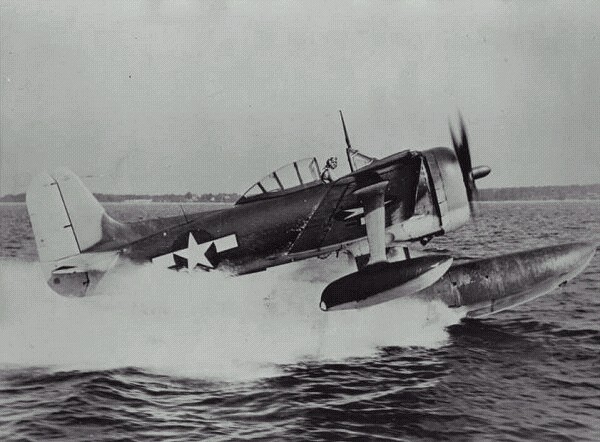
Compare the WW2 Navy that could actually go places, land there on the water and investigate to today's emasculated USN that doesn't even want to get its feet wet in huge, comfortable aircraft carriers operating planes that cannot even land in the water. No longer having the lost art of being able to operate seaplanes gives our enemies vast areas of the world where they can hide in, immune to air and sea search. If they cannot even be found, they cannot be targeted by either firepower or maneuver. Let's look at the art of how seaplanes can land in the ocean to enable effective sea-based reconnaissance:
http://findarticles.com/p/articles/mi_qa3834/is_200010/ai_n8917774
Profile of the SC-1

Wings of Gold, Fall 2000 by "Billy Jack" Long
In a career spanning 40 years in aviation, R.J. Long, Naval Aviator engineering test pilot and ANA member, logged 3, 000 hours in over 50 different aircraft. He flew in WWII and Korea, returned to civilian life and from 1953 to 1957 was an engineering test pilot for Convair in San Diego. He was project pilot on the Navy's SeaDart, the world's only supersonic seaplane, and also tested the F-102A, the USAF's first supersonic interceptor. He retired from the Navy as a CDR in the Naval Reserve, is a member of the Society of Experimental Test Pilots and for many years following Convair duty, was Director of External Affairs for Rockwell International Space Transportation Systems Division. In the following article he describes operations with the SC-1 Seahawk.
The single-piloted Seahawk was the largest, fastest, most powerful and heavily armed floatplane ever procured by the Navy for operation from battleships and cruisers. It was conceived and built for multi-requirements: scouting, ASW, directing Naval gunfire, storage in cruiser below-deck hangars, using existing catapults and recovery systems. It had no high altitude mission requirements. I flew the SC-1 in 1945 as a 22 year-old ensign (assigned to USS Santa Fe (CL-60)) but my experience involved no combat or heroics. The exposure, however, served as a valuable prelude to test work I later did on the Sea Dart.
The XSC-1's first flight was in February 1944; 566 x SC-1s and 10 x SC-2s were built with final delivery in the fall of 1946. The planes were flown from the Columbus, Ohio plant with fixed landing gear to west coast air stations where float systems were installed. The battle cruiser Guam received the first Seahawks in October 1944. The battleship Missouri had two Seahawks on the fantail catapults during the Japanese surrender in Tokyo Bay, September 2nd 1945. Despite the large number produced, only 22 x SC-1s on seven ships saw combat.
Powered by the Wright R-1820-62, it had a four paddle-blade prop which enabled the SC- 1 to achieve spectacular water takeoff and climb performance. Its combat radius was 290 miles at 110 knots.
Pilots had to be careful on water takeoffs because of the Seahawk powerful torque. [Editor: need counter-rotating props] Aerodynamic stability and control were excellent in flight even when strafing with the two .50-caliber [heavy machine] guns, and bombing. The cockpit and canopy were spacious and comfortable with good visibility. Controls, instrumentation and electronics were state-of-the-art. The folding wings had full-span leading edge slats, aerodynamically actuated which with the trailing edge flaps provided excellent flight characteristcs during approach and touchdown at 65 knots.
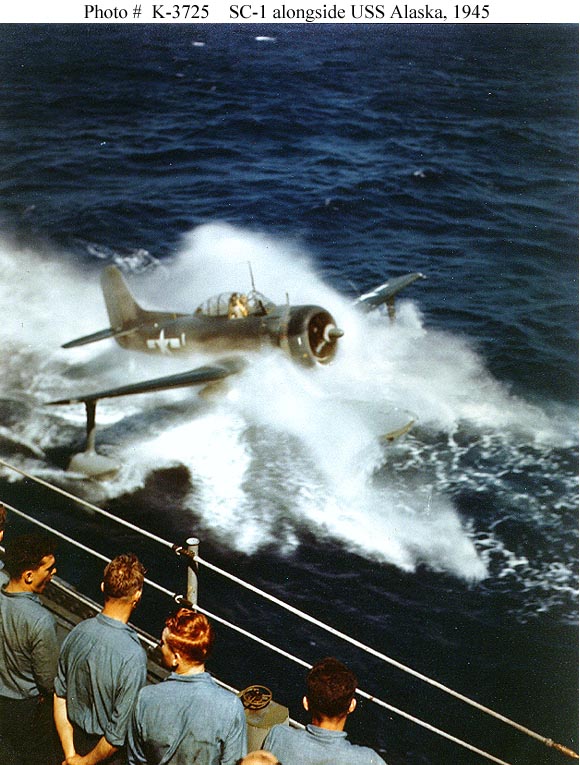
Catapult launches and recoveries, especially without a rear seat crewman to assist with ship-crane hook-ups, were challenges. There were four recovery techniques:
Able: After landing in the water, the aircraft was towed by motor whale boat into pick-up position.
Baker: The aircraft taxied under the crane, engine cut, and hoisted aboard.
Charlie: The ship executed a 90 degree turn across the wind line, creating a slick for touchdown and taxi to the sled which the Seahawk engaged with a hook at the bottom of the main float. The aircraft was then maneuvered beneath the crane for hook-up and hoisting.
Dog: With this method the ship made no course change, regardless of wind or sea conditions. This required good piloting and seamanship to land and catch the sled.
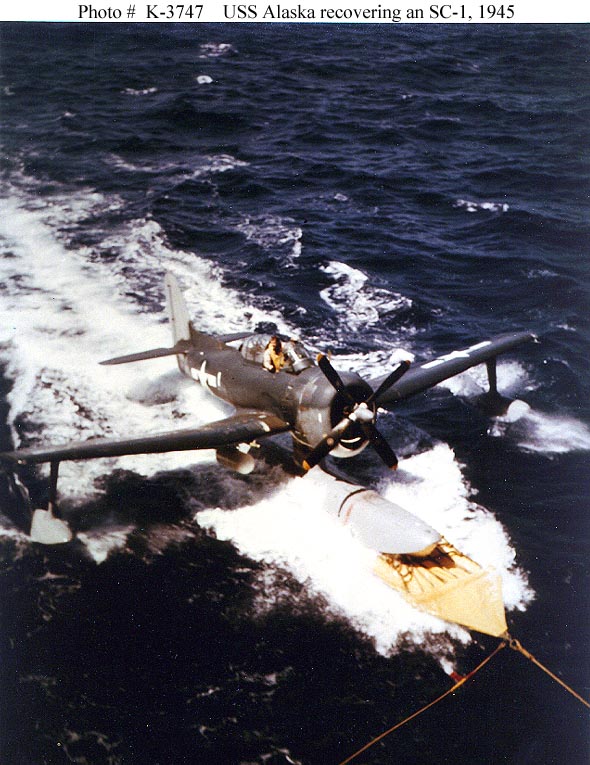
When the ship wasn't underway the Seahawk was lowered to the water with the engine off, The pilot unhooked from the crane, started the engine and proceeded to taxi and takeoff.
There were problems with the SC-1s. These included turbo supercharger impellers disintegrating causing extensive in-flight damage and autopilot hydraulic servo system failures which causing fatal accidents. The system was subsequently disconnected which made viewing the APS-4 radar cockpit scope while flying the aircraft more difficult and potentially dangerous. [EDITOR: need rear seater to watch the ASW/ASuW/AAW scope]
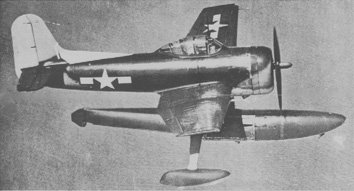
One bomb rack was under each wing center section; the right one could carry a radar pod or a bomb. Initial main float opening bays for bombs, depth bombs, or auxiliary tanks were later secured with only one auxiliary tank retained.
Rescues at sea were tough and dangerous without an aircrewman to help. There was a canvas cot inside the aft fuelage to accommodate up to two people.
The pilot seat armor could be tilted forward by the pilot on the wing root to provide access. We didn't have an on-board ladder but used a line instead. A folding metal ladder came along later. The SC-2, in fact, incorporated signficant changes.
Life aboard Santa Fe was great - a happy ship with a top war record. We had three Seahawks, four aviators, a CPO and 19 men - and a single port catapult. An aviator was required on the bridge during underway launches and recoveries. Maintenance was outstanding. I was the unit engineering officer, the ship's photo officer and stood watches underway and in port. Our flag officer on board was the senior U.S. commander for the initial occupation of Kyushu at Sasebo. We visited six ports from southern to northern Japan. I took many aerial photos including one of Nagasaki, from my SC-1. Liberty was interesting and peaceful. My last Seahawk flight was in November 1945 from USS Ominato Bay near Honshu.
I believe that no more than 300 of the 576 Seahawks produced ever saw service. With no other military or civil use, all were destroyed. None exist today. [EDITOR: how convenient of the carrier mafia to erase all memory of the competition!]
Because of my SC-1 and OS-2U floatplane experience I was hired by the Convair company to test the XF2Y and YF2Y SeaDart, delta wing, twin-jet, water based interceptors. Still, the SC-1 stands out as the most intersting of the more than 50 types of aircraft I flew. Single-piloted seaplanes, out of all the aircraft I flew, were my favorites.
Build a 1/72 scale model of the Mighty SC-1 SeaHawk!
 Order from Squadron Signal: www.squadron.com/ItemDetails.asp?item=AU2015 for just $4.99
Order from Squadron Signal: www.squadron.com/ItemDetails.asp?item=AU2015 for just $4.99
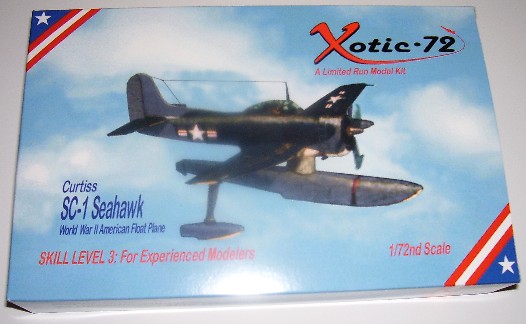
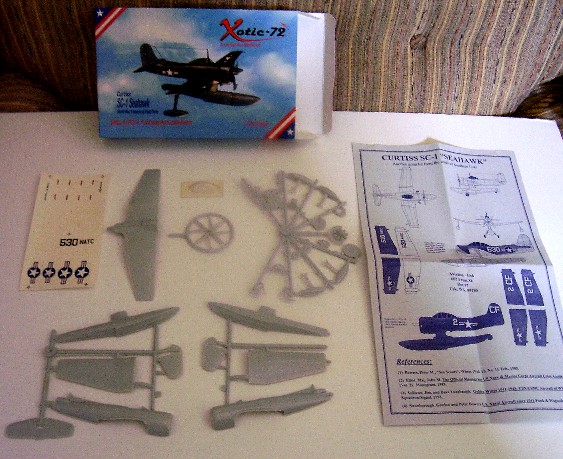
We just built our own SeaHawk II/III version of what it could have been like today had the Navy kept improving versions to the present day! Pictures are posted below!
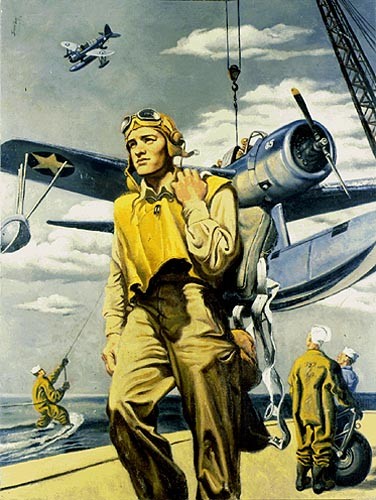
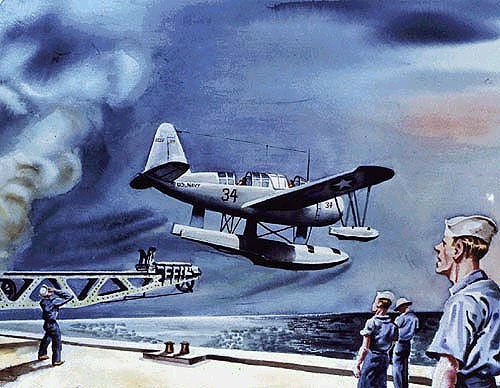
www.history.navy.mil/nan/backissues/1940s/1945/1aug45.pdf
U.S. Navy Aviation News, August 1, 1945, pages 17-27
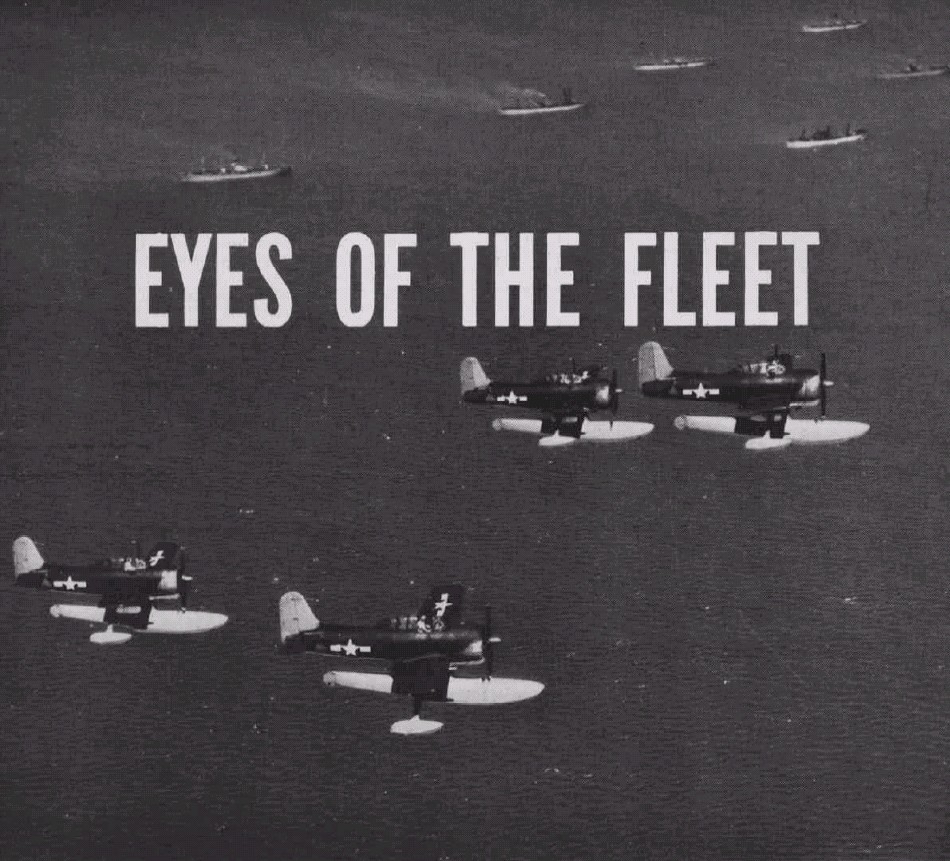

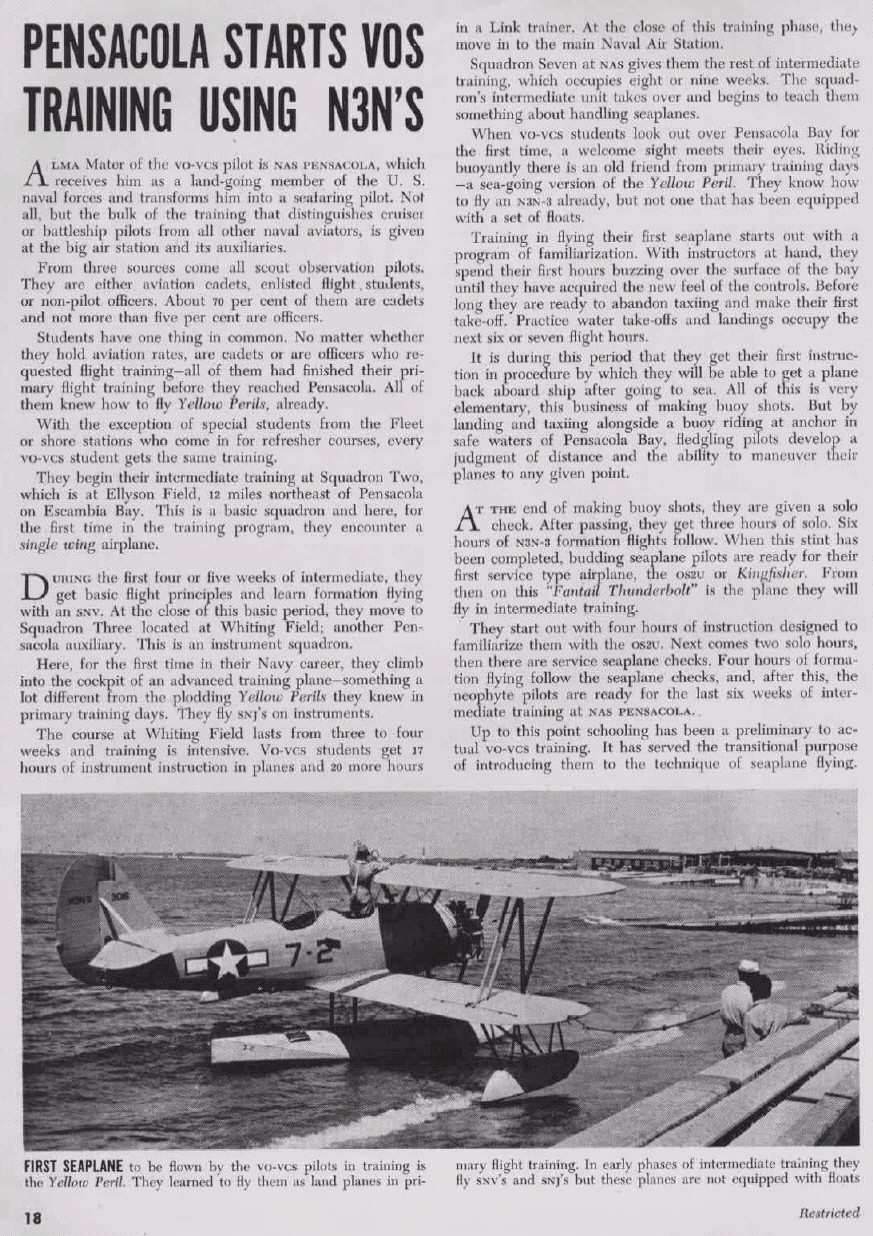
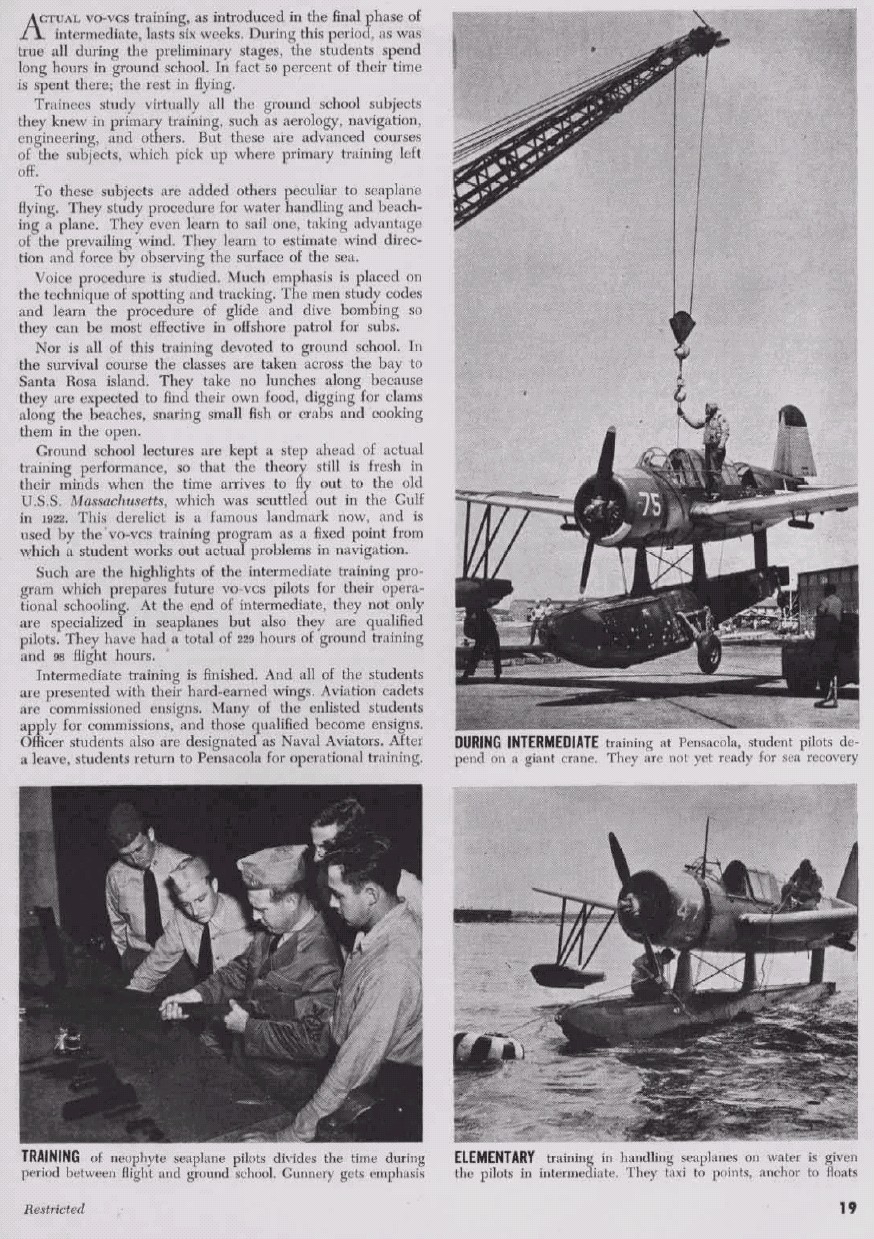
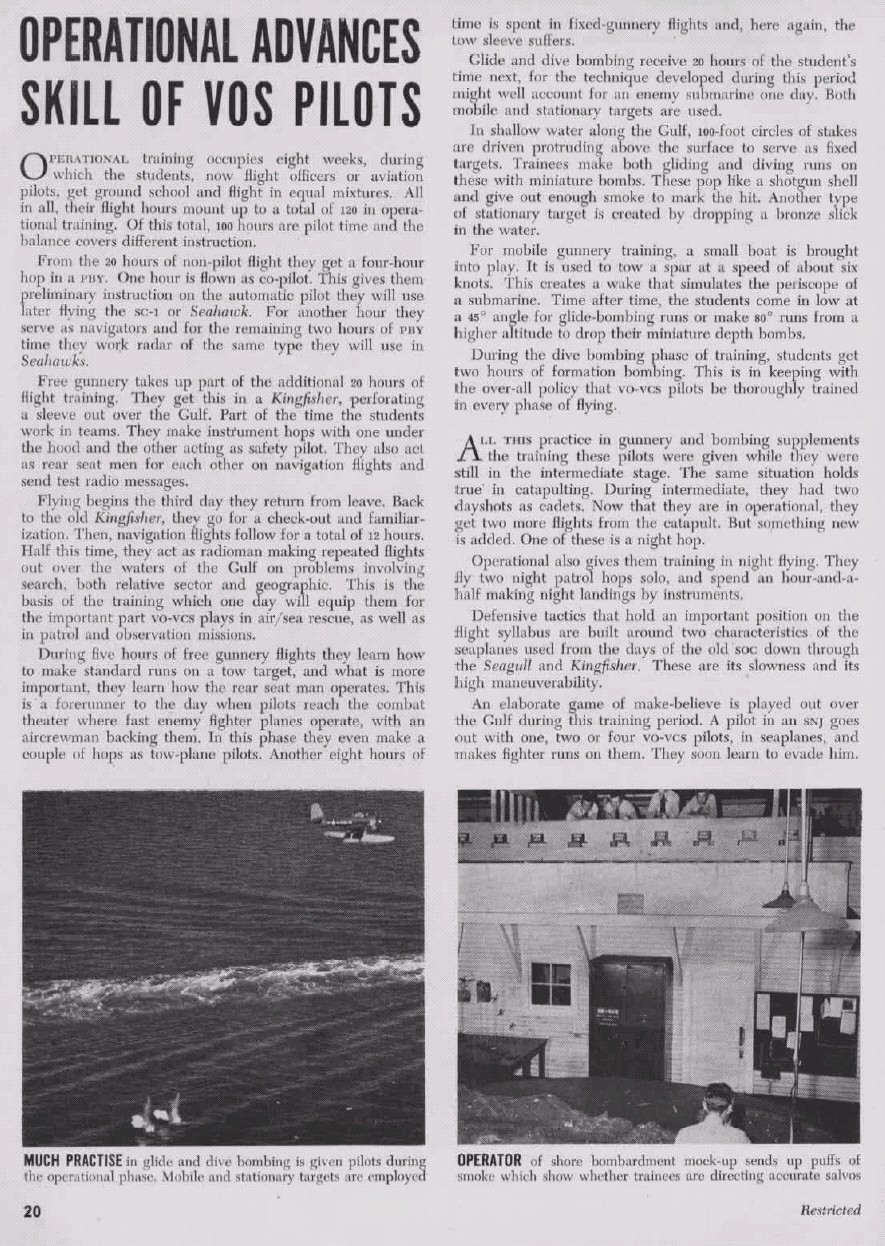
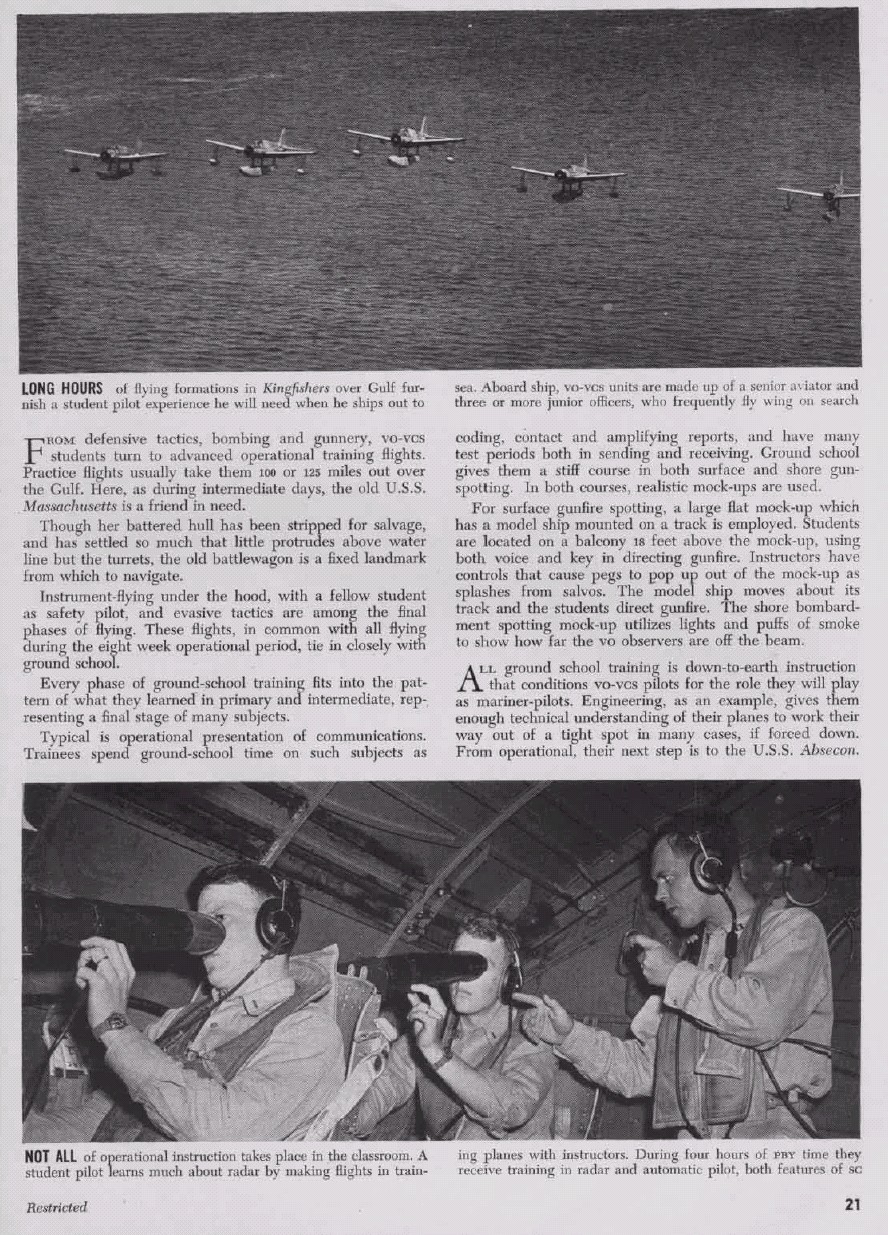
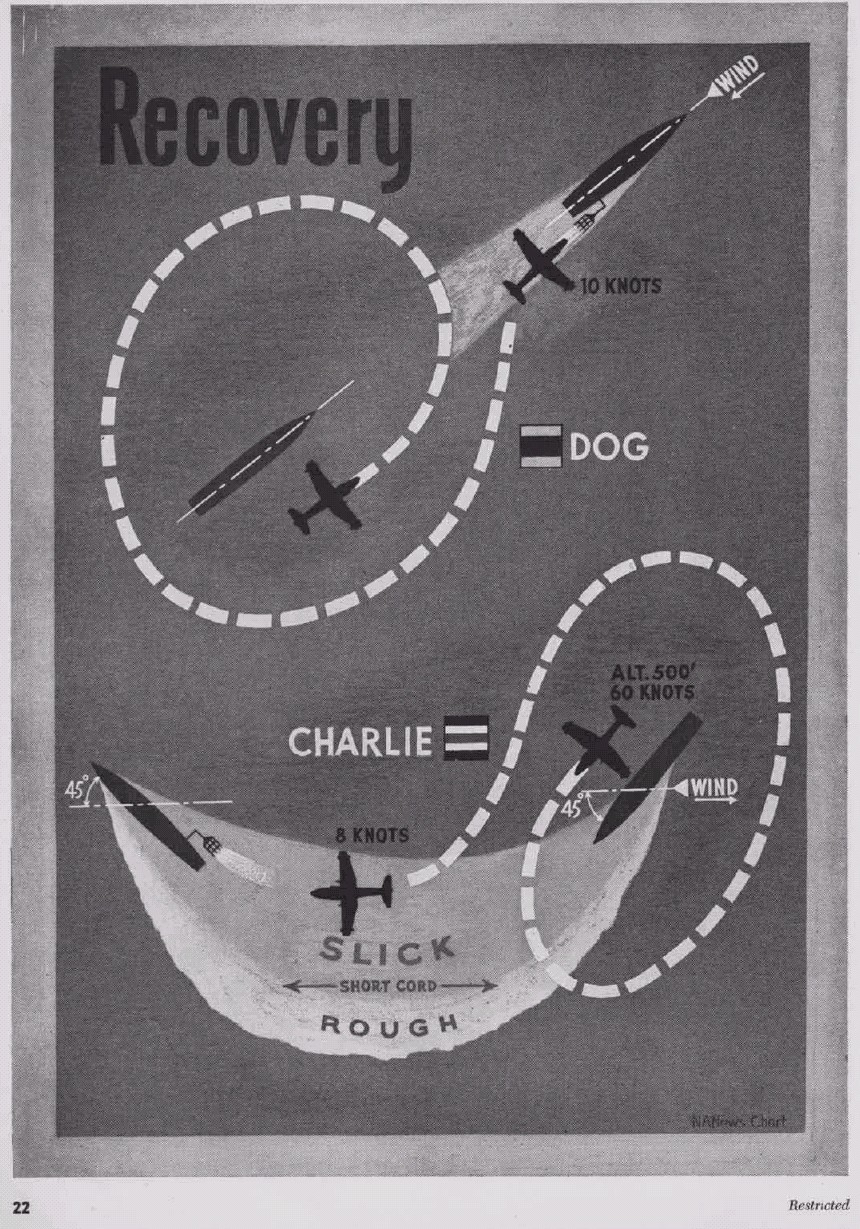
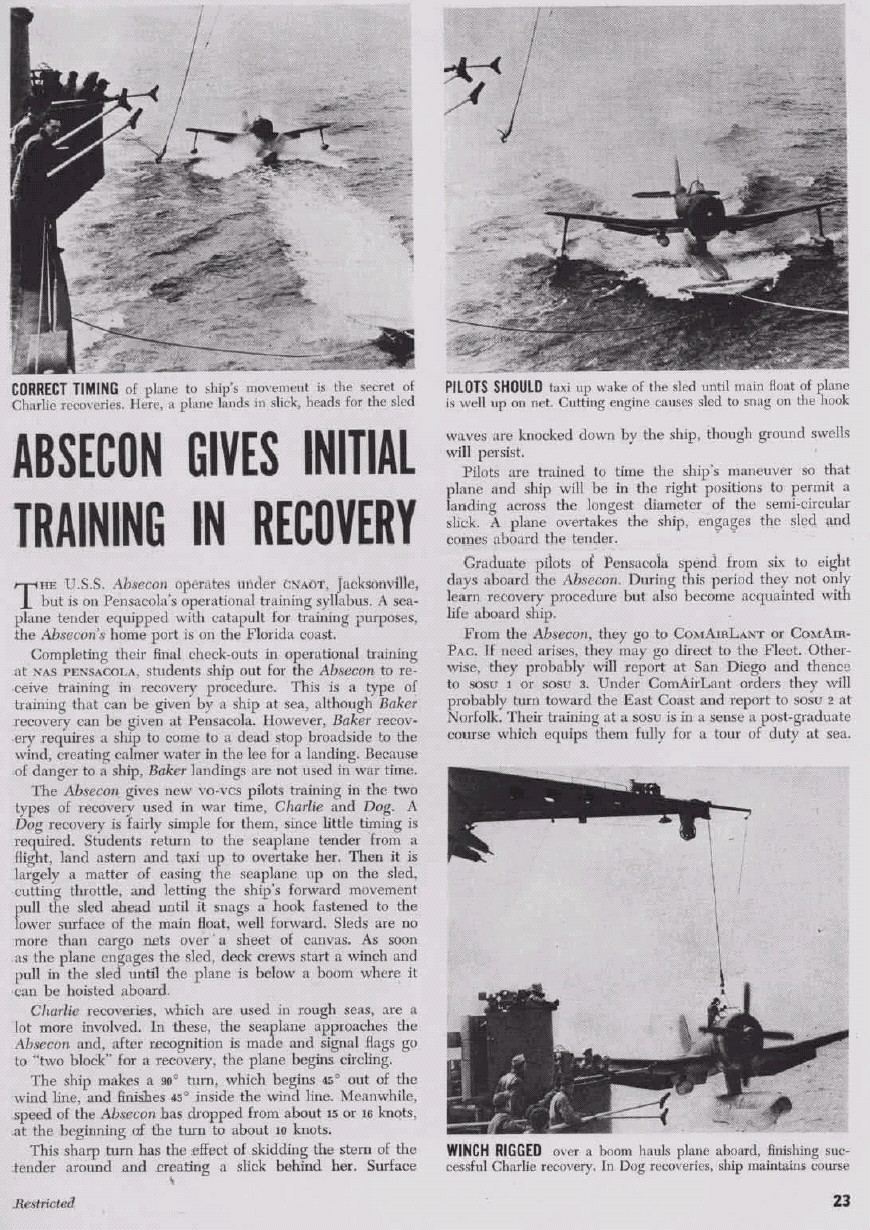
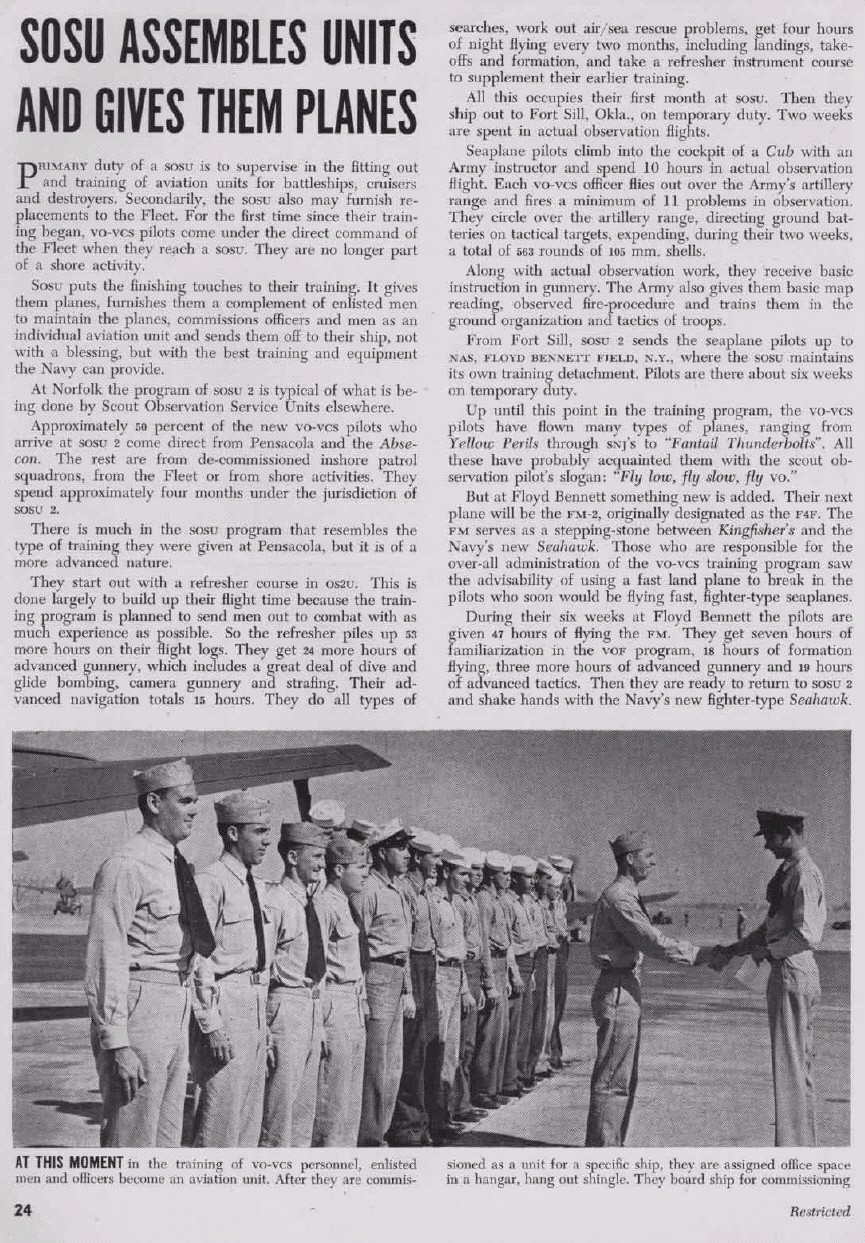
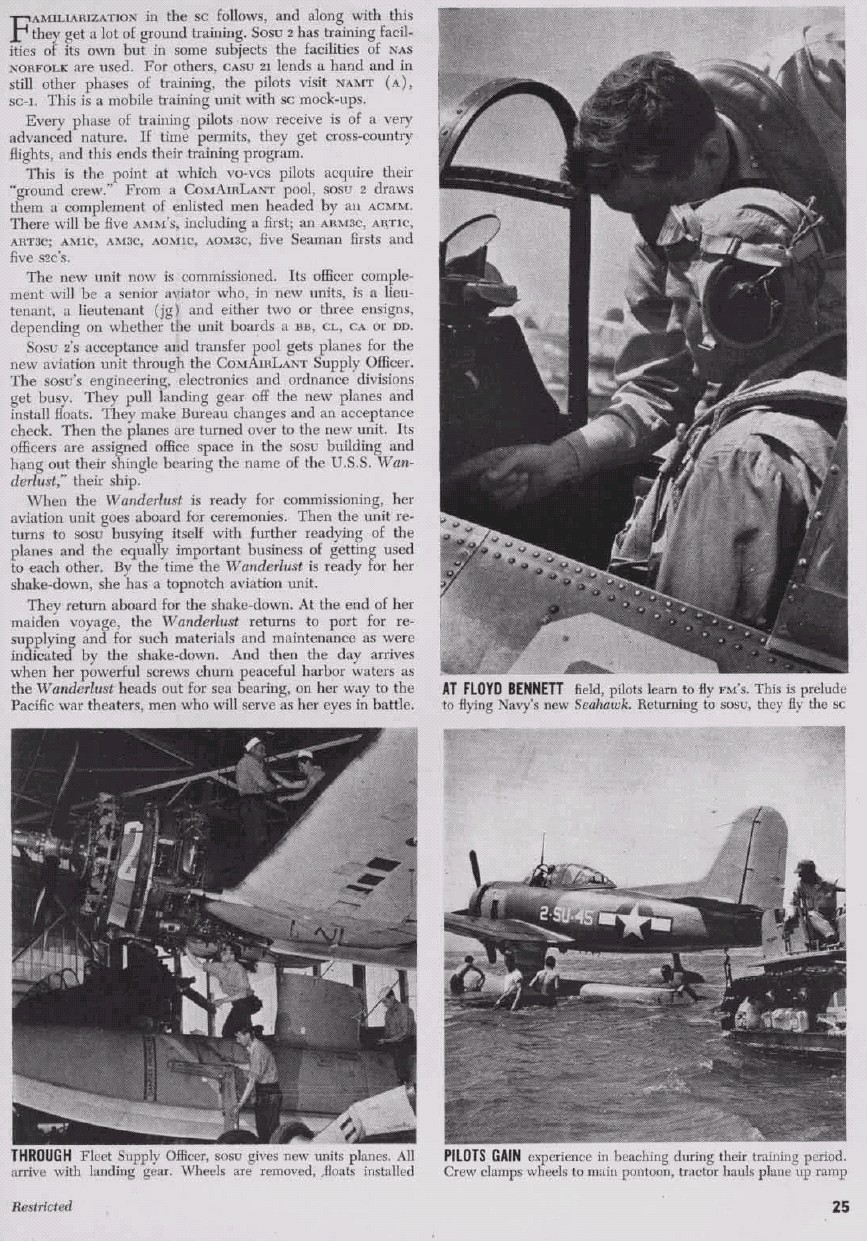
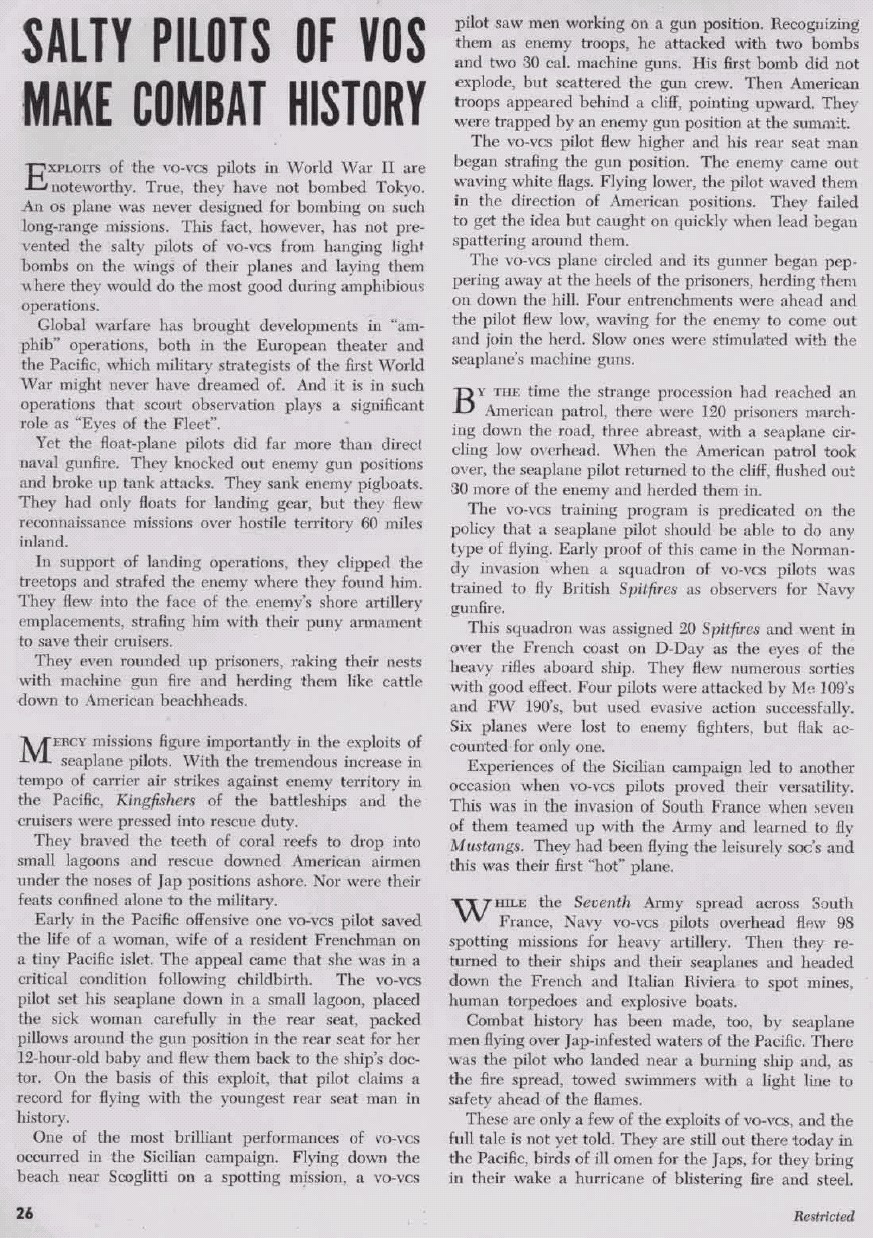
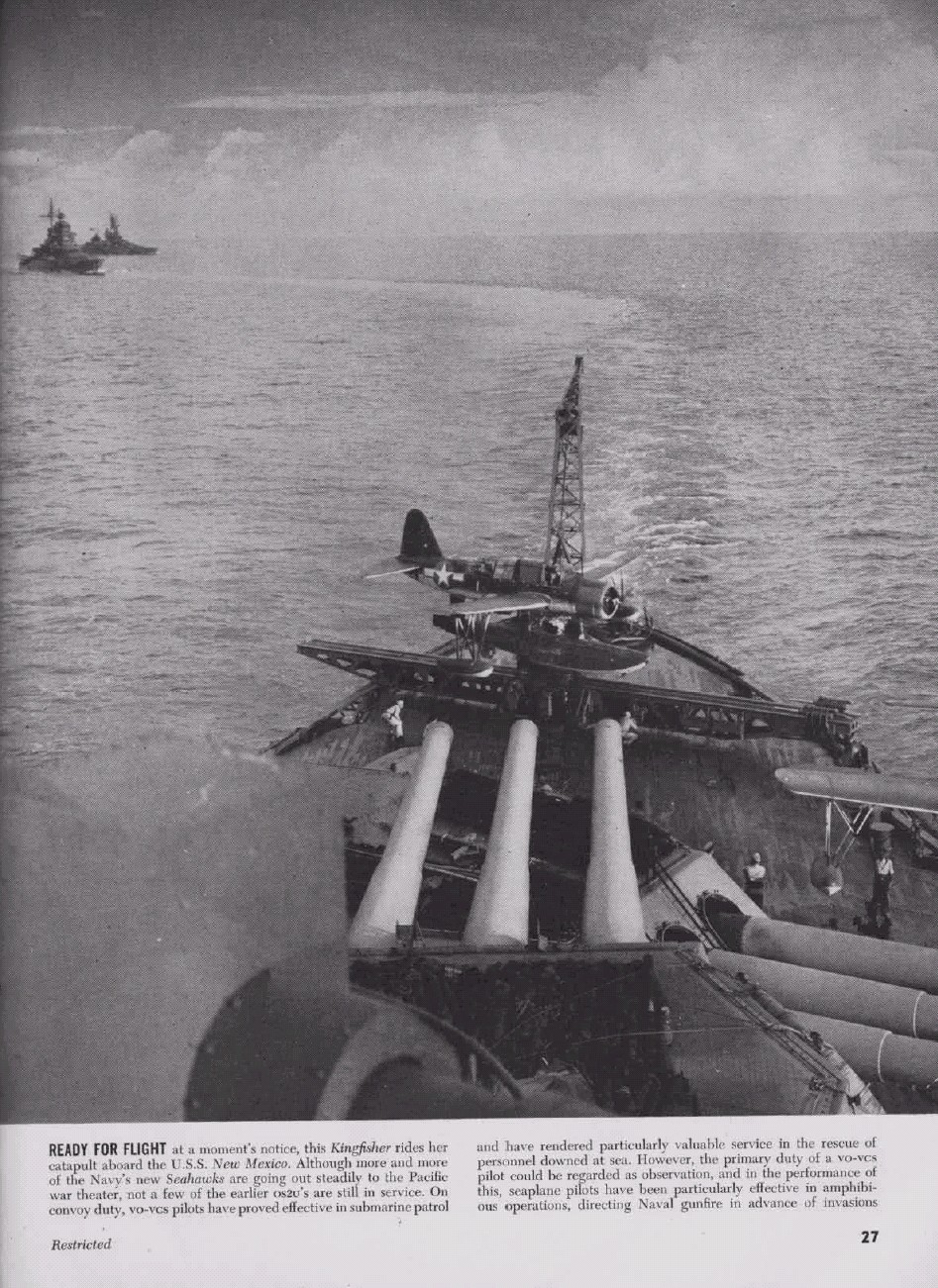
The problem with any egotistical, narcissistic organization is that only one thing can be in the limelight; in this case, the biggest ships---the aircraft carriers---eclipse all the smaller vessels just as in the Army the heavy tank stifles out lighter tanks. The problem is that big aircraft carriers cannot survive on their own, cannot do all required naval functions and we simply cannot make enough of them even if they could do everything. We are now down to just 11 aircraft carriers and this is exactly the number we lost in WW2. If they are sunk in the first days of a WW3, there will be no aircraft operating from our ships other than a few slow, short-ranged helicopters and maybe some subsonic, short-ranged marine Harrier jump jets from a handful of amphibious carriers. Our surviving surface ships will have to do a "Jutland" and flee the scene or stick around and get sunk like the HMS Repulse/Prince of Wales were without air cover in 1942. Either way, we lose the war at sea.
Imagine now if the U.S. Navy of 1949 were not snobby and lazy....
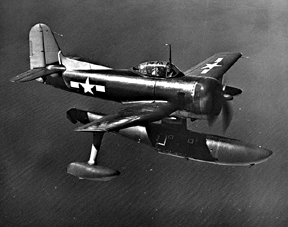
SC-1 has framing in the canopy
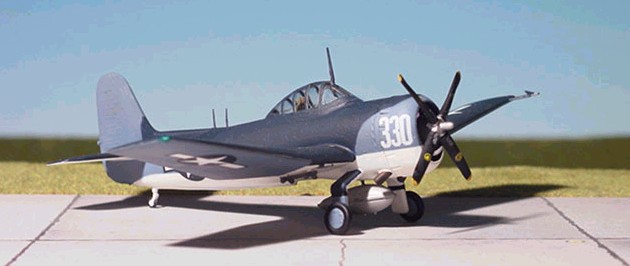
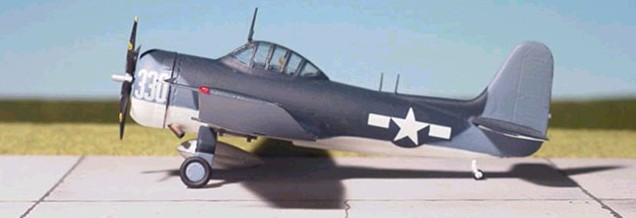
SC-2 had pure, clear bubble canopy
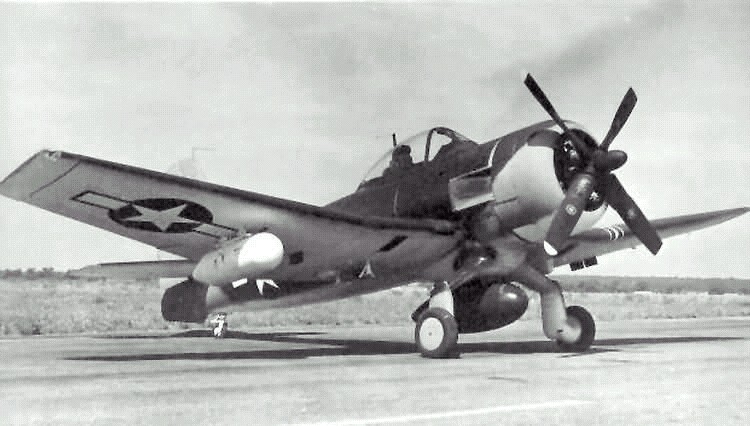
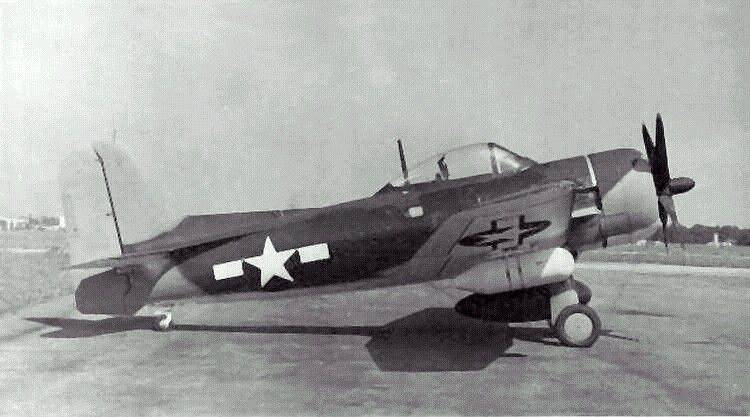
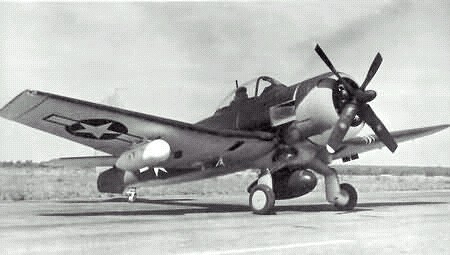
The helicopter would have been rightly seen as never equaling the 313 mph speed nor 1, 000 mile range of the SeaHawk floatplane fighter regardless if it would stay out of the water and require less salt water corrosion preventative maintenance. Could it dip sonar and rescue men in the water with a hoist? Sure. Make sure it can also land itself in the water with a floating hull and have them act as a SUPPLEMENT not a replacement for floatplane fixed-wing aircraft which could land on the water and dip sonar, too. Exploit helicopter VTOL capability to land on different pads on ships like on top of battleship turrets like we used to do in the 1950s for personnel and small supply runs.
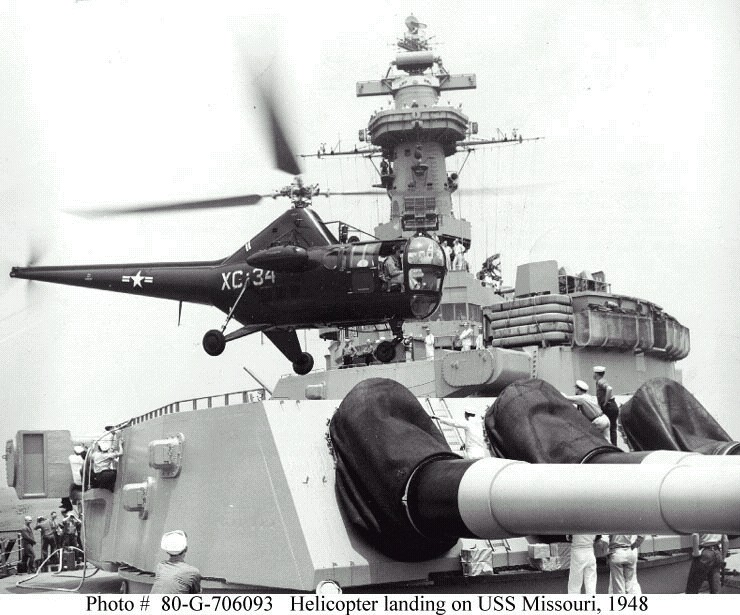
The guided-missile is the more lethal heir to the Japanese kamikaze planes that did so much damage in the latter parts of the war. Ships would still need to be armored. Jet aircraft at 600 mph would best the SeaHawk in a gun dogfight.
EXCLUSIVE! NEW PICS!
SC-3 would have contraprops, twin-turbine engined power, reliability and safe JP-8 fuel use
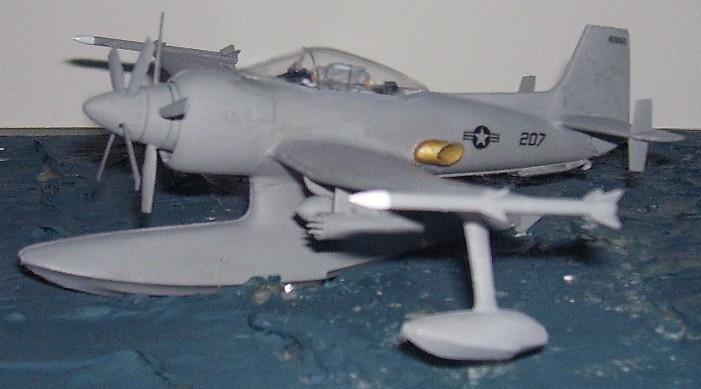
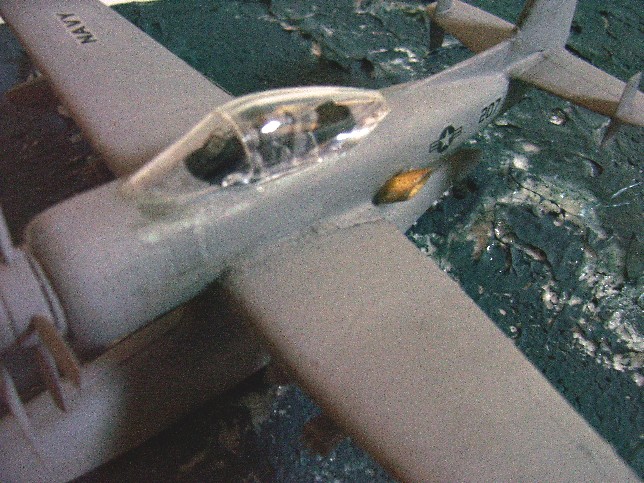
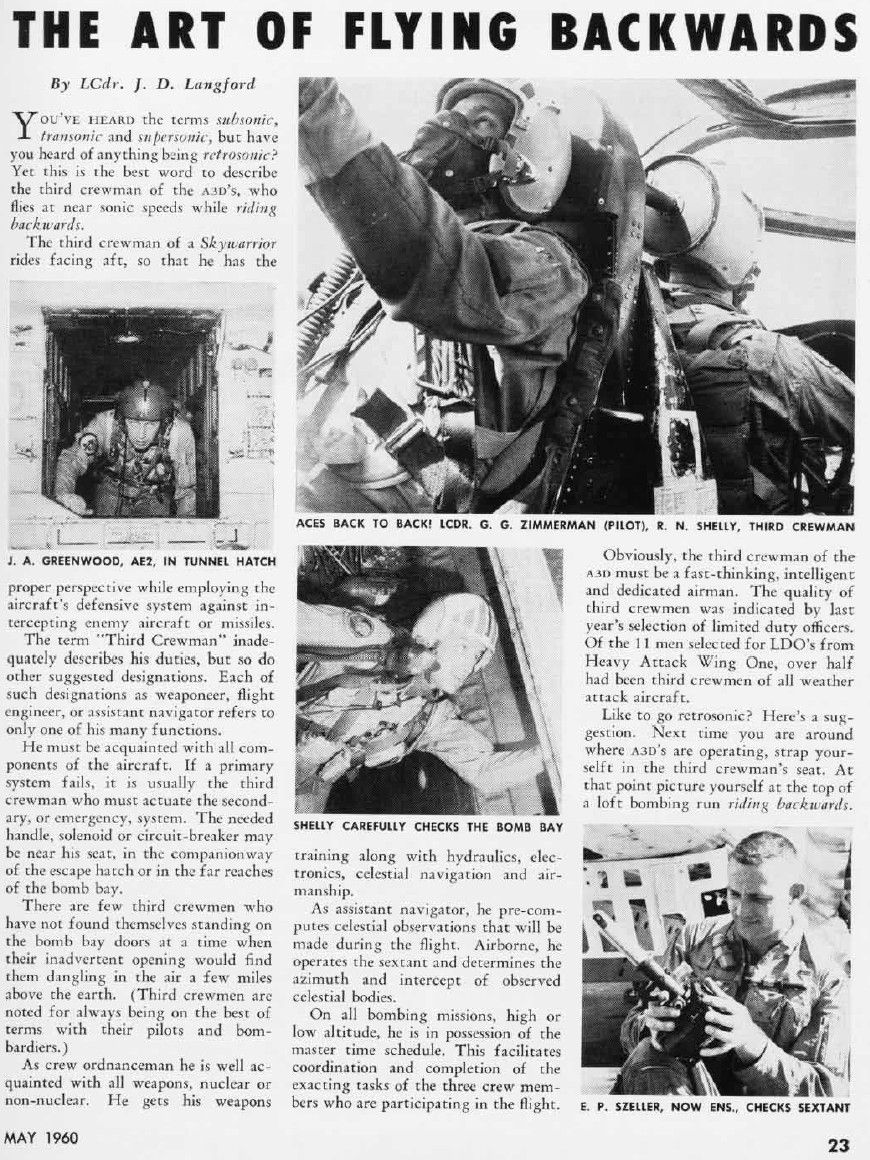
The rear observer would have radar and night vision/image intensifiers, infared to increase his visibility and awareness as well as an ability to fire rear-ward-facing AAMs against enemy MIGs. His ejection seat would swivel to the front if he needed to fly the aircraft in an emergency if the pilot is incapacitated.
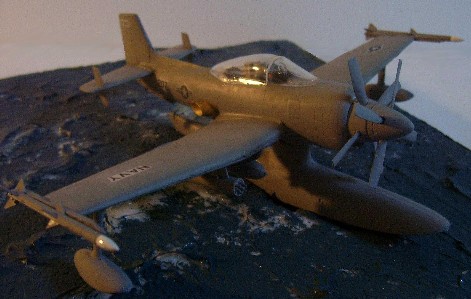
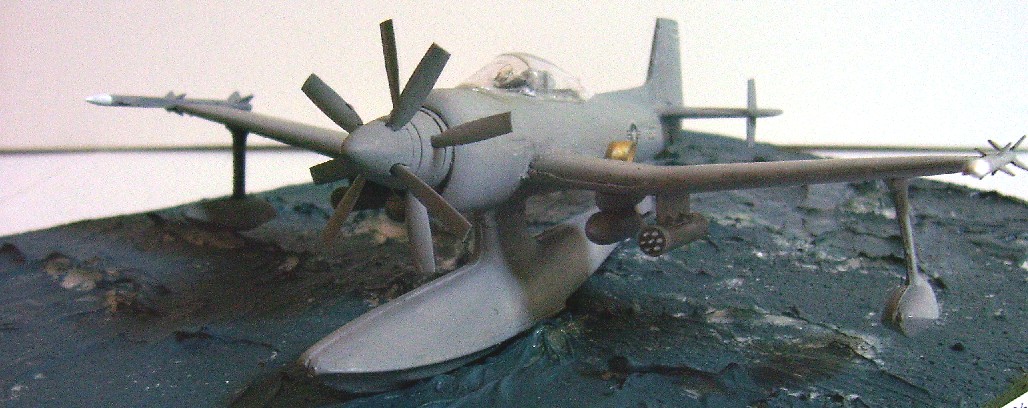
Modern SC-3s would have 15-to-1 ratio slender floats for better open sea landings and take-offs or even no floats at all using skis or hydroskis.
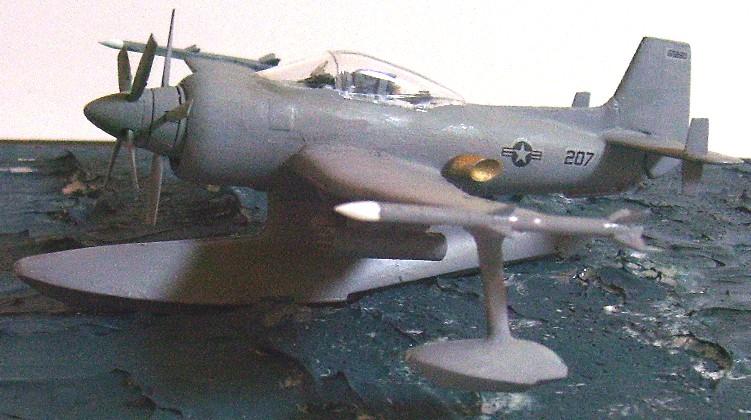
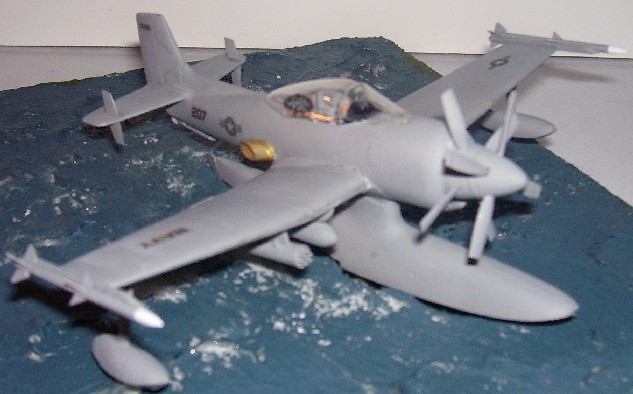
The smart USN would have made the wing floats retract to the end wingtips like the PBY to reduce drag and placed a turboprop engine with contra-rotating props in the SeaHawk II, getting a respectable 500 mph. To close the gap with 600 mph fighters, Sidewinder air-to-air-missiles would have been fitted by 1960. By the 1990s, fire & forget AMRAAMs would be available to extend kill range beyond a close-in dogfight with guns/Sidewinders.
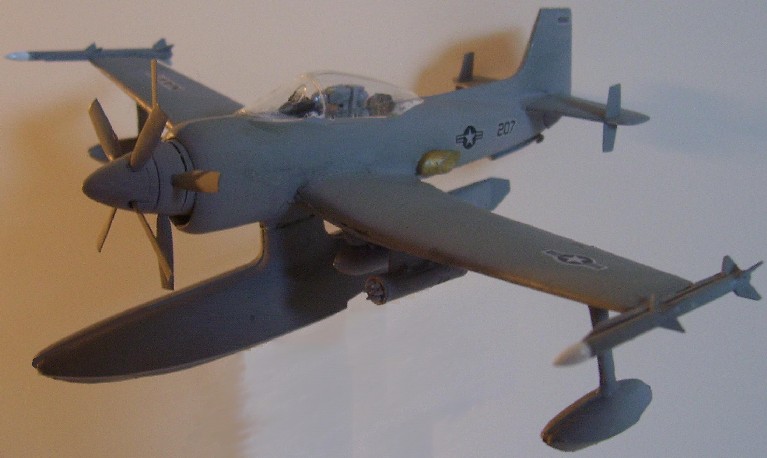
Wheeled landing gear enables the SeaHawk II to provide Maneuver Air Support (MAS) for Army and marines ashore during the Korean and Vietnam wars. Improvements in radar in a bulb on the right wing and a more comfortable radar operator rear seat position would make the SeaHawk III a "MINI-AWACS" extending fleet air cover by another 100 miles by 1970. Success with the contra-rotating props helps the R3Y Tradewind seaplane transport and the C-130 fly faster and farther, helping the SEALS insert/extract, the marines to deploy M113 Amphigavin light amphibious tracks and the Army Airborne to airdrop M113 Gavin light tanks further inland.

By the 1970s; a F-107-like turbofan floatplane or derivative (air intake on top of fuselage to avoid sea spray like the SeaDart) of the AV-8A Harrier would have been fielded as a "JetSeaHawk" but exploiting JATO for ZEL take-off from the catapult/rails located amidships on the cruisers and at the stern of the Iowa class battleships. R&D into an engine that can burn ship's JP-5 heavy fuel would have eliminated more volatile JP-8 from having to be carried by cruisers and battleships. We made these ships nuclear powered, so ALL the fuel would be for the SeaHawks/JetHawks to operate for weeks and weeks without need of refuel at sea. Future JetSeaHawks would be HYDROGEN powered with the ship only cracking sea water into oxygen and hydrogen AS NEEDED to fuel her aircraft so NO fossil fuels would be carried. The new Arleigh Burke class destroyers would have at least one mid-ship catapult/rocket rail for one JetHawk and the Ticonderoga class, two. However, the Navy was not stupid and followed up with the USS Long Beach in 1960 and fielded better heavily ARMORED cruisers than the current "tin can" destroyers/light cruisers that would be nuclear powered so this protective weight would be no burden. There was no Ticonderoga or Burke classes; the Long Beach and Bainbridge classes were modernized and kept in service. Each USN surface combatant would have at least one ASW/CSAR helicopter and one AAW/ASuW fighter for synergistic combined-arms effects when with other like-equipped USN surface combatants.
When the war in Kuwait flared up in 1990, the SeaHawk II/IIIs were brought back on duty to spot for the four Iowa class battleships and provide MAS for the Army/marines ashore since the JetSeaHawks fly too fast to see foes on the ground. The SeaHawks are rebuilt into SeaHawk IVs to extend their service lives and add countermeasures to enemy air defense weapons. When U.S. forces invaded Afghanistan, SeaHawk IVs flew 24/7/365 air surveillance missions and in concert with Army Airborne-mech forces in M113 Gavin tracks blocked all escape routes into Pakistan. This air-ground team located and then killed terror mastermind Osama Bin Laden and Ayman Z with Hellfire ATGMs that were laser designated from the ground. The remaining Al Queda operatives were exploded by SeaHawk IV .50 caliber heavy machine gun fire bursting their civilian SUV gas tanks. The "war" on "terror" was decisively ended in a U.S. victory in mid 2002. There would have been no excuse to invade Iraq and 3, 000+ dead and 23, 000 wounded American lives would have been spared.
2006: with the possibility of Red China blockading and invading Taiwan, the egalitarian, indomitable defiant, U.S. Navy, self-reliant and ready operates both JetHawks and SeaHawks from all its surface combatants and will not be forced from the scene if their carriers are lost.
Eyes Poked out of the Fleet: Sadly What Really happened...sorting it all out...Navy brass marginalize then retire seaplane fighters from cruisers/battleships...
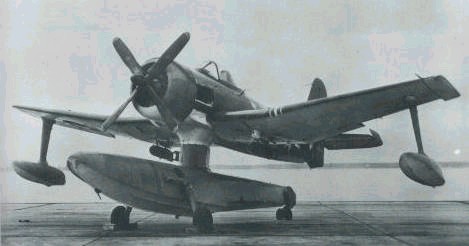
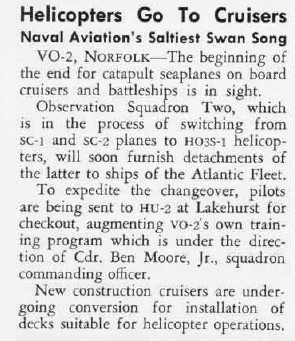
The Navy's flimsy excuses for the wimp-out into helicopters:
www.history.navy.mil/nan/backissues/1940s/1949/jul49.pdf
www.combatreform.org/bullshitnavydefeatism1.jpg
www.combatreform.org/bullshitnavydefeatism2.jpg
www.combatreform.org/bullshitnavydefeatism3.jpg
www.combatreform.org/bullshitnavydefeatism4.jpg
www.combatreform.org/bullshitnavydefeatism5.jpg
www.combatreform.org/bullshitnavydefeatism6.jpg
WW2 ends and the large aircraft carrier capital ship brass start squeezing out everything else. Suddenly in May 1949 the asshole Navy brass declare that bullshit 100 mph unarmed, unarmored Sikorsky 1947 HO-3S Dragonfly helicopters will somehow replace 300 mph, armored, armed SC-1/2 SeaHawk seaplane fighters....where was the outrage at this bean counter stupidity? If you want ONE helicopter to fly around the brass/VIPs on each battleship/cruiser, post one on the aft deck or on top of a gun turret, THERE WAS NO COMPELLING FUNCTIONAL SPACE-ON-SHIP REASON to stop using the SeaHawks seaplane fighters. This was pure Navy brass peacetime squeeze-out-anything-that-threatens-the-money-and-ego-of-the-supercarrier bullshit. This is perfect to keep the battleships/cruisers in their inferior social place as "support" for their fucking supercarriers...if handicapped with short-range helicopters battleships/cruisers can't go out on independent missions---nevermind that's their functional purpose...no they will have to take "big mama" along wherever they go. Did anyone even raise a stink about this pansification of the Navy from combat to peacetime bullshit? Or were all the adults gone from the Navy by 1949 replaced by lifer egomaniacs and bean counters? How many men are going to die soon in Korea because of the things the bullshit little helicopters can't do?
Sikorsky "Dragonfly"
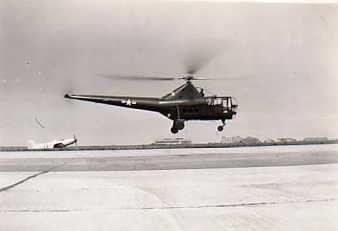
* CAN'T SCOUT FOR THE ENEMY FLEET
* CAN'T DO NAVAL GUNFIRE SPOTTING MISSION
* CAN'T DEFEND THE SHIP FROM AIR ATTACKS
* CAN'T DEFEND THE SHIP FROM SUBMARINE OR SURFACE SHIP ATTACKS
* CAN'T FLY CONTINUOUSLY FOR HOURS TO EVEN WARN VISUALLY OF ATTACKS
* CAN'T CARRY ASW GEAR AT ALL
* CAN'T DO COMBAT SEARCH/RESCUE EXCEPT VERY CLOSE TO THE SHIP
Establishment BS history of the Dragonfly: In 1946, the Navy placed an order for the four- seat HO-3S version of the Army R-5 helicopter. The Navy and marines used the aircraft on carriers and other ships to recover downed pilots on land and sea. The "Dragonfly" was the first Navy helicopter to replace the fixed-wing seaplanes operating with fleet. By late 1949 the HO-3S had replaced all non-carrier-based aircraft as well as taken over all carrier-based rescue operations. The HO-3S saw its finest hour during the Korean War and was utilized by all air operation commands. The helicopter also served as the original combat platform for feasibility tests of automatic pilot systems in helicopters. The tapered wood and metal rotor blades were one of the design flaws that led to the replacement of the HO-3S.
Manufacturer: Sikorsky Aircraft Division
Powerplant Engine Type : One Pratt & Whitney R-985-AN-5 450hp radial engine
Dimensions
Main Rotor span: 42 feet
Length: 57 feet 8 inches
Height: 12 feet 8 inches
Takeoff wt. empty/max. 3,810 lbs./4,390 lbs.
Performance: Maximum speed : 107 mph
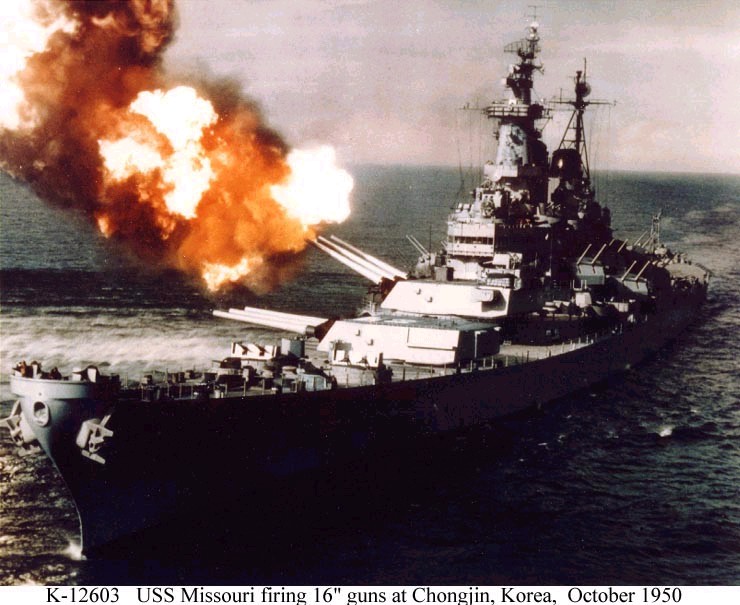
U.S. Navy Battleships - USS New Jersey (BB-62)
www.chinfo.navy.mil/navpalib/ships/battleships/newjersey/bb62-nj.html
EXCERPT:
"On 24 May, she lost one of her helicopters when its crew pushed to the limit of their fuel searching for a downed aviator."
Compare/contrast the pitiful helicopter flight performance to what the official U.S. Navy web sites says about what just a few of the thousands of fixed-wing seaplanes did in WW2 to get effective observed and corrected naval gunfire by virtue of their LONG-RANGE and ENDURANCE:
www.chinfo.navy.mil/navpalib/ships/battleships/tennessee/bb43-tenn.html
EXCERPTS:
At about noon on 1 August 1943, Tennessee was out on what all thought another routine patrol when the word was passed to prepare to bombard Kiska. At 1310, she began a zigzag approach through the usual murk to the island with USS Idaho (BB-42) and three destroyers. As the water grew more shallow, the ship slowed down and streamed mine-cutting paravanes from her bows. Tennessee approached the island from the east, closing to a range from which she could open fire with her 5-inch secondary battery. Her two OS-2U Kingfisher floatplanes were catapulted to observe fire; and, at 1610, the battleship commenced firing from 7,000 yards. Though the island's shoreline could be seen, the target area, anti-aircraft gun sites on high ground, were shrouded in low-hanging clouds and were invisible from the ship. Tennessee's aerial spotters caught an occasional glimpse of the impact area and reported the ship's fire as striking home...The task group continued along Kiska's southern coast Tennessee's 14-inch guns chimed in at 1624, hitting the location of a submarine base and other areas with 60 rounds before firing ceased at 1645. Visibility had dropped to zero, and results could not be seen. The battleship recovered her floatplanes, and the force turned back toward Adak.
Steaming by way of Pearl Harbor and Saipan, Tennessee was just in time to join Rear Admiral W. H. P. Blandy's bombardment force. Blandy, an ordnance specialist, had been Chief of the Bureau of Ordnance earlier in the war. With the expert help of Lt Col. Donald Weller, USMC, the pre-invasion bombardment was thoroughly planned and was modified to meet immediate needs as the shelling progressed. The Japanese defensive tactic called for the landing troops to be stopped on the beaches before they could move inland, and a heavy belt of defenses extended along the shoreline. The mission of the bombarding ships and planes was to break down the Japanese cordon and permit the landing marines to push through before they could be cut to pieces.
Blandy's gunfire force arrived off Iwo Jima early on 16 February 1945. The morning was cool, with occasional rain squalls, and low cloud cover hindered spotting planes. Shortly after daybreak, the warships deployed to their stations, with escort carriers in the near distance providing air cover. Minesweepers began to clear the approaches to the island at 0645, and gunfire opened at 0707. Tennessee's assigned firing course took her along the southeastern shore of Iwo Jima, and her 14-inch guns struck the slopes of Mount Suribachi while the secondaries aimed at the high ground at the north end of the beach. Floatplanes and fighters observing gunfire over the island were followed by dark puffs of anti-aircraft fire. Blandy ordered the ships to fire only when air spot could function effectively in the intermittent visibility. Whenever the airplanes could observe the results, the ships kept their fire up through the day. During the afternoon, an OS-2U Kingfisher seaplane from the cruiser USS Pensacola (CA-24) found a Japanese "Zeke" on its tail. The observation pilot, determined to put up all the fight he could, went at the fighter though his plane was much slower and less maneuverable, and armed only with one .30-caliber forward- firing machine gun plus a second flexible gun in the observer's cockpit. Against all the odds, the "Zeke" went down in flames.
Visibility was better the next day, and the ships began to approach beaches at 0803. Beginning at 10,000 yards, Tennessee, with Idaho and Nevada, soon closed to 3,000 yards and delivered heavy direct fire to assigned targets while assault minesweeping went on. At 1025, the battleships were ordered to retire to make way for UDTs supported by LCI(G)s. The defenders concluded that this was the beginning of the actual landing and unmasked guns and mortars in a heavy fire on the gunboats and frogmen. Casualties mounted; one gunboat was sunk, another set afire. The other LCIs returned fire but had to withdraw as the bombardment ships resumed firing against the defenses. Three damaged gunboats came alongside Tennessee to transfer their wounded to the battleship's sick bay.
Bombardment continued through 18 February under orders prescribing concentrated hammering of the landing beaches. Once more, Tennessee's big guns pounded Suribachi while her secondaries attacked gun positions overlooking the right flank of the objective area. While the heavier guns fired from ranges varying between 2,200 and 6,000 yards, the 40-millimeter battery raked other targets on cliffs at the north end of the beach and shot up the wrecks of several Japanese ships beached near the shore; these had been used as havens for snipers and machine gunners at Tarawa and in later landings, and were always treated as potential threats. Several fires were started ashore; an ammunition dump exploded spectacularly and burned for several hours. Coastal guns and anti-aircraft weapons were still firing when Tennessee retired for the night, even though she and Idaho had been able to demolish many massive masonry pillboxes with direct hits.
Vice Admiral Richmond K. Turner arrived off Iwo Jima at 0600 on the morning of 19 February with the main body of the invasion force and assumed command. Transports formed up in the darkness and, at daybreak, put their landing craft into the water as troops clambered down the ship's cargo nets. The loaded landing craft circled near the transports as they awaited the signal to land. Tank landing ships moved closer to shore, opened their bow doors, and launched LVTs carrying the first wave of assault troops. Shortly after daylight, a heavy bombardment was opened by the ships of Task Force 54 reinforced by the newer battleships North Carolina (BB-55), Washington (BB-56), and three cruisers lent for the occasion by Task Force 58. A total of seven battleships, four 8-inch gun heavy cruisers, and three light cruisers armed with 6-inchers laid their fire on the landing areas. At first, the fire was slow and deliberate. It was checked for an air strike, as planes from the fast carrier force delivered bombs, rockets, and napalm before the ships resumed a heavier fire. Beginning at 0850, fire was so adjusted that carrier fighters could strafe the beaches during the last few minutes before H-hour. One minute before H-hour, the turret guns ceased firing, and the secondary guns began to drop a rolling barrage just ahead of the marines as they landed and moved inland. Shore fire control parties (SFCP) accompanied the marines ashore; one SFCP was assigned to work with each of the supporting battleships and cruisers.
The first wave crossed the line of departure at 0830 and landed only a fraction before the scheduled 0900 H-hour. As the troops landed, the Japanese, who had waited out the bombardment in their deep tunnels, manned guns and mortars in protected emplacements and opened an increasingly heavy fire. The ships' guns were kept busy; main batteries took on gun positions as they were located while the lighter guns kept up their barrage ahead of the [exposed on foot unarmored] men on the ground. Tennessee's station was 3,000 yards from Suribachi at the southern end of the landing area, and the water around her was churned by hundreds of vehicles and landing craft as the successive waves moved in. By the end of the day, some 30,000 marines were on Iwo Jima, and some tanks and artillery had been landed.
Ground fighting on Iwo Jima continued until 28 March 1945, as the stubborn Japanese were slowly rooted out of the positions that they continued to defend to the last. Even before the struggle ended, though, Army engineers had patched up the island's battered airstrip; and damaged B-29s were able to seek refuge on dry land instead of ditching. Tennessee was a part of this struggle until 7 March, when she sailed for Ulithi. The days after the landing were a steady routine of call fire and counterbattery work as Japanese guns continued to reveal themselves by opening fire on the hovering support ships before being located and taken out. For this purpose, it had been found that single-gun salvoes at close range, using "pointer fire" (in which the gun is directly aimed by telescopic sight), were the most precise and effective. The notion of using a 14-inch naval gun for sniping was rather new, but it seemed to work very well. Tennessee left the area, having deposited 1,370 rounds of main- battery fire on Iwo Jima along with 6,380 5-inch and 11,481 40-millimeter projectiles. At Ulithi, she began to prepare for the Okinawa operation. Supplies and ammunition were loaded, and the tired sailors stretched their legs and drank beer on tiny Mog Mog Island, whose principal selling point as a vacation resort seemed to be that it did not move underfoot.
We know the Navy brass retired our excellent SC-1/s SeaHawk catapult-launched seaplanes from our cruisers/battleships around 1949...how convenient....now their guns wouldn't have any air observers (AFACs) watching the fall of the shells to adjust fire to hit the enemy to make this fire effective....what does the peacetime Navy and marines REALLY want to do?
They want to goof-off and chase wine, women and song and leave the war preparations to another day, when men will be dying and desperation measures required...
What the Navy and marines really have their "eyes" on
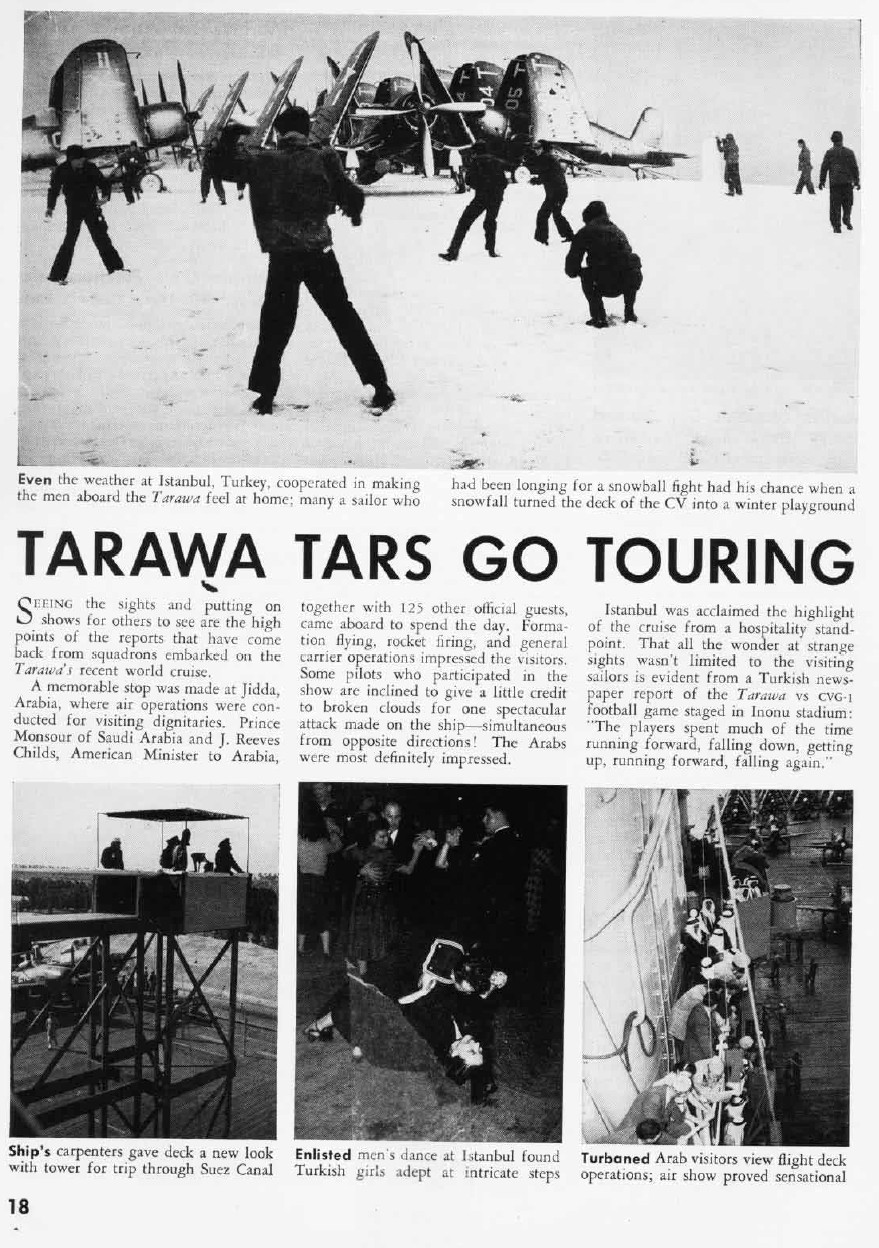
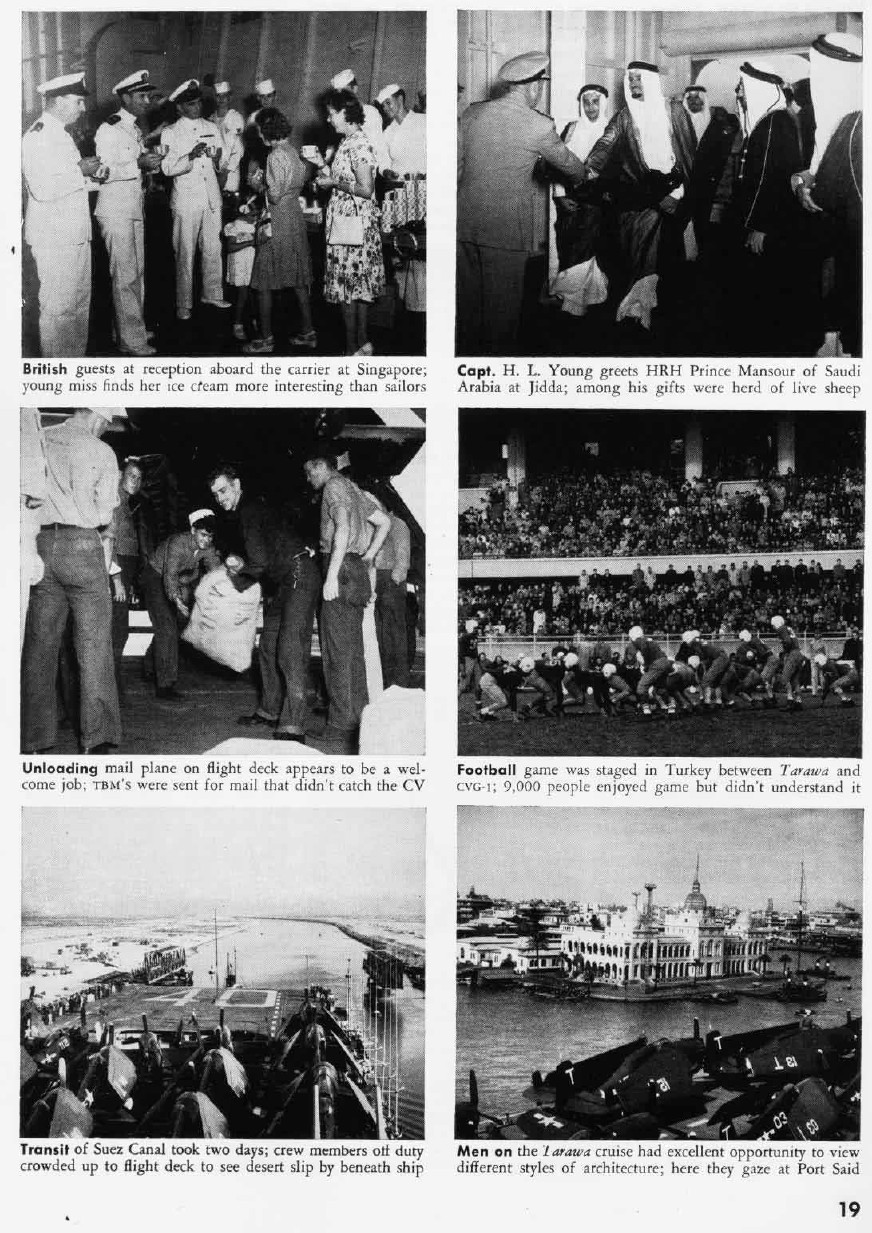
In response to a lack of naval gunfire control against shore targets (imagine that? what would cause that?), the Navy has Shore Fire Control Parties and the USMC creates ANGLICO units of ground FACs/gunfire observers..but how will this help if you are bombarding a North Korea or a North Vietnam where there isn't a major American ground force for the GFACs to be safe ashore? What if your ground radio doesn't work or reach? Here's one real-world example from the March 1951 issue of U.S. Naval Aviation News taken from thousands of incidents:
www.history.navy.mil/nan/backissues/1950s/1951/mar51.pdf
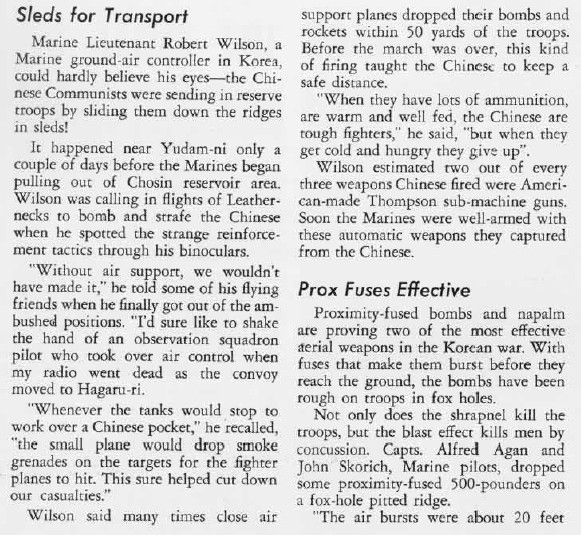
The SeaHawk backstab was to marginalize the effectiveness of naval guns so they couldn't compete for missions with the fighter-bomber jock/supercarrier mafia.
The official U.S. Navy history web site on "Korean War--Naval Gunfire Activities, July-September 1950", shows that cruisers like the USS Helena were able to drop bridges if their gunfire could be observed/corrected denying these routes over rivers to enemy forces attacking our troops:
www.history.navy.mil/photos/events/kowar/50-nkof/nk-3.htm
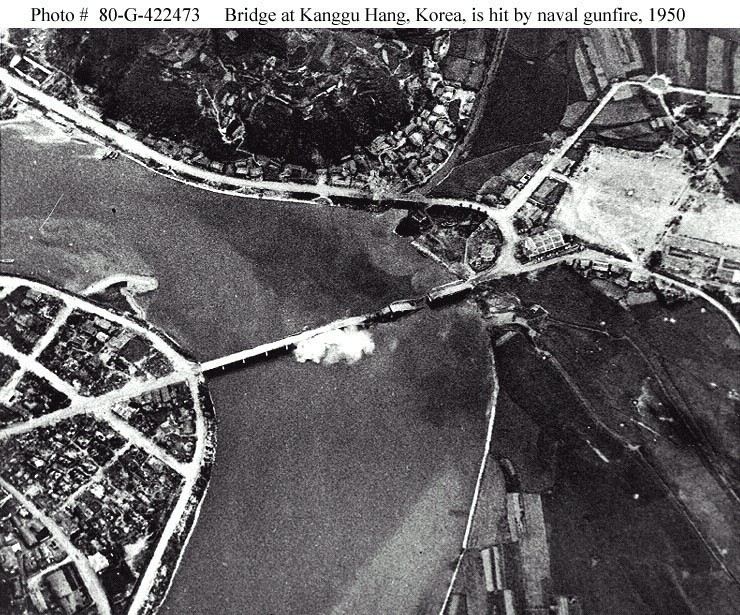
With manned observer guidance, battleship and cruiser guns can take-out vital targets like bridges without having pilots in aircraft getting shot down trying to deliver HE ordnance. Why have "The Bridges of Toko-Ri" (Korean War) or Than Hoi (Vietnam War) bridge type tragedies when we can cheaply take-out point targets with aiming corrected battleship/cruiser guns lobbing inexpensive HE shells? Cruiser/battleship seaplanes HELP NAVAL GUNFIRE get the glory and all the downed carrier pilots lives they saved from death in the water doesn't mean a "hill of beans" when it comes to GREED and EGO of the Navy supercarrier brass. Having all naval warfare forms under one bureaucracy is unsound and dangerous as in the end the many little things required to do naval warfare right will be marginalized, ignored and eventually squeezed out of existence.
1. SC-1/2 SeaHawk VO-VCs were intended and used for BOTH ship target and shore target observation to assist cruiser/battleship guns. That's a historical fact.
The truth behind this is that the enemy ships we want to sink are not under observation by friendly ships radioing in aiming corrections. Secondly, on shore, our Army and marines simply may be having their asses kicked by the enemy, pinned down by enemy fire for the GFAC to observe & radio back corrections or for an AFAC to exist. Cruisers/battleships should provide their own MANNED O/A plane grasshopper ie; a SeaHawk.
2. ANGLICO is for marines, too
I was enlisted and officer marine for about a decade while we had ANGLICO before the disbandment and revival. None of our Arty FOs or me or my company CO could call in naval guns, but we did get to call in a CAS A-4 SkyHawk strike at 29 Palms in 1983. We had an ANGLICO attached to my infantry company when we did semi-serious FTXes. He had a long-range AM radio, an AN/PRC-104. Today they have VHF/UHF AN/PRC-117Fs.
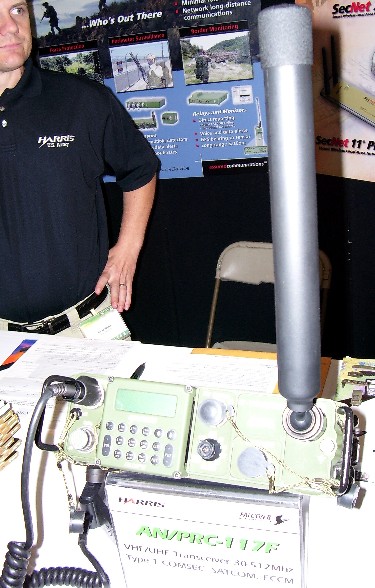
Today, with the advent of the "JTAC" mentality that its sort of tolerated if you go to the school; but not welcomed. Army Arty FOs (13Fs) should go to all the necessary JTAC schools to learn how to do CAS radio talk-ons and direct the current wimpy 5" naval guns we got available. Army CSA General Schoomaker wants a JTAC IN EVERY RIFLE PLATOON and an entire BATTALION made into a "RSTA Squadron" of sensor-shooter interfacers in his "modularity" reorganization to insure GFAC capabilities are there. In our artillery and tank study groups I reminded everyone that the key is having a LASER TARGET DESIGNATOR to shine coded laser beams to get an accurate GPS target location for GPS guided munitions and terminally guide laser-directed munitions in addition to talking on aircraft with guns, rockets and dumb bombs. How the USAF ETACs are going to handle this Army pitching-in will be very interesting. They may fall back on the fact that only they have laser designators to protect their "turf".
The lack of AFACS from cruisers/battleships was a deliberate marginalization of naval gunfire support since even if you have GFACS embedded throughout your ground maneuver force, the fact is they still may not be in a position to direct naval guns or CAS. We need naval manned O/A planes that can operate from small surface ships.
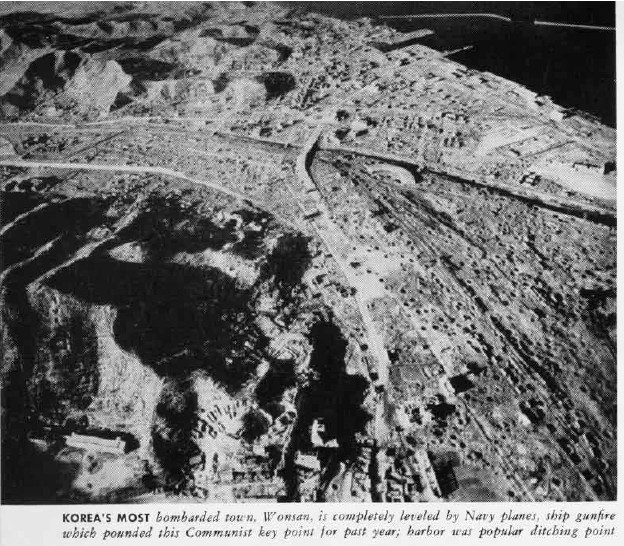
Here's two examples from the Korean War. In the first one, you can see that the target Wonson, was on the coast and cruiser/battleship guns could be directed from the ship itself.
Where are all those "observation" helicopters from cruisers/battleships now?: Navy has to use Corsairs to naval gunfire spot during the Korean War
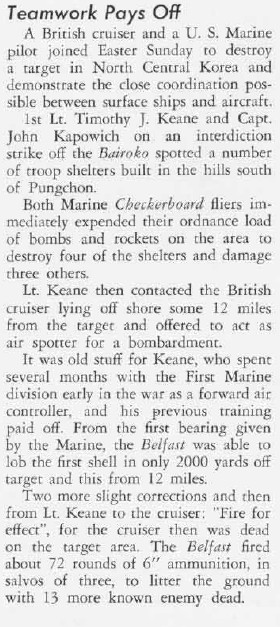
....slow helicopters cannot survive over North Korea to naval gunfire spot....
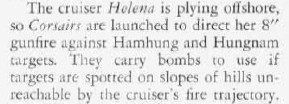
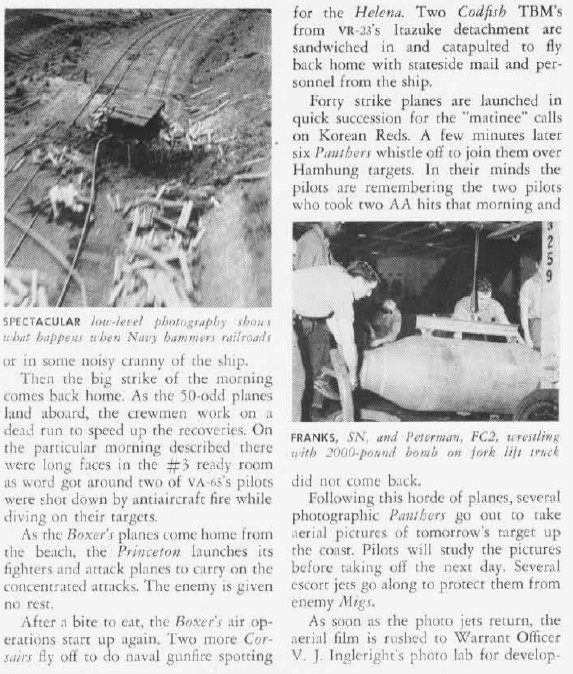
where are the BS helicopters?
The examples above from the June and September 1952 issues of U.S. Naval Aviation News show that helicopters cannot get the naval gunfire observation job done and naval guns are not being fully utilized since an attacking WW2 era Corsair carrier fixed-wing plane is the only platform in position or can get into position far inland to find the enemy and SURVIVE to act as a spotter; though its only a single-seater and lacks a back-seat observer to do it well. Many Corsair pilots would die doing naval gunfire spotting over Korea because of the large aircraft carrier Navy brass's backstab elimination of the SeaHawk seaplanes resulted in a lack of preparedness via unsuitable helicopters. Some may rightfully ask WHERE DID ALL THE MASS-PRODUCED WW2 AIRCRAFT GO? Can't we use them NOW to fight sub-national threats? Why can't the Navy operate its own prop SC-1/2 SeaHawk observation/attack planes to spot for their own cruiser/battleship guns and act as an airborne forward air controller (AFAC) like the highly successful USAF "Mosquitoes" using slower SNJ/T-6 "Texans"?
True, but ONLY IF THEY STILL EXIST. the Navy/marines in the 1940s were CRASHING 1, 000 WW2 aircraft each year! And what they were not crashing they were scrapping.
We only built roughly 10, 000 of the main types of WW2 fighter-bombers.
Let me be more clear: WE TRASHED OR CRASHED ALL OUR SAVED WW2 AIRCRAFT.
Where are these aircraft storage boxes and their aircraft?
They were used up and thrown away.
Now don't get me wrong...this is a CONSPIRACY.
There were about 600 x SeaHawks built AND NOT ONE SINGLE ONE SURVIVES OPENLY TODAY.
How "convenient" of the Navy brass.
Not even one SeaHawk for a naval museum somewhere. What assholes. They saved the NC-4 seaplane that was a part of the cross-Atlantic flight large aircraft carrier-worshipping asshole Mitscher participated in...and the Navy brass couldn't even respect the sacrifices of 5 decades of naval service from the catapult seaplane community? And this ISN'T a conspiracy to stamp out all memories that there IS other ways to get airplanes to sea other than their bloated, cash cow supercarriers?
If you still think helicopters are effective naval gunfire spotters in COMBAT where they are easily shot down, why then did the Iowa class battleships upon rec-commissioning in the 1980s get UNMANNED FIXED WING PLANES to do their gunfire spotting and not helicopters? Case closed on the "helicopter naval gunfire spotting" BS.
What I'm trying to reveal here is that ACTIVE DUTY MILITARY SERVICE IS A RACKET. Its composed of EGO CLUBS who keep secrets. An A-37 combat pilot just revealed a secret that a LOT OF PILOTS DIVE RIGHT INTO THE GROUND doing low-altitude attacks re: target fixation. This is but one example of the devil-in-the-details kept secret from us.
WE ARE NOT BEING TOLD THE TRUTH HERE!!!
MILITARY EGO CLUB BACK STABS ARE TAKING PLACE ALL THE FUCKING TIME!!!
I personally witnessed at Fort Bragg the 3/73rd Armor's M551 Sheridans being PLACED ON RAILROAD CARS BEFORE THE M8 Buford AGS non-build decision was made. This made it ohh so easy to disband the 3/73rd Armor Battalion with ready-made excuse: "we have no tracks". BULLSHIT. WE had and still have THOUSANDS OF M113 GAVINS THE 3/73rd COULD HAVE BEEN SUPPLIED. They were not because the heavy tanker assholes ("heavy mafia") ruining, eh running the Army DID NOT WANT THE AIRBORNE ("light mafia") TO HAVE ANY TANKS.
Don't you see it?
First, the Navy stops having SeaHawk units on every battleship/cruiser; only one "centralized" detachment (surface excuse: "to cut costs") to farm out AS NEEDED seaplane fighter floatplanes; this severs any loyalty ties of the ship to the SeaHawk unit's men.
Next, they rip off the armor and armament from the SeaHawks to not remind anyone of their COMBAT ATTACK PURPOSE, marginalizing them as JUST search & rescue means.
Then comes the bullshit fucking piece-of-shit helicopter doing highly sexy PR grabbing "rescues"--they can do this mission easier than seaplanes yadda yadda yadda.
VOILA!!!
Navy brass-to-peons: "We are taking your SeaHawks from you. They are umm, OLD, yeah that's right. We are giving you a NEW TOY to stroke your egos that mommy/daddy naval service loves you. Go back now into your corner and be subservient to us with your cruiser/battleship guns and little rescue choppers to rescue us real men in real fighter-bombers flying off our large aircraft carriers".
Nevermind there always was enough space for BOTH SeaHawk seaplanes AND a BS helicopter.
This was never about FUNCTION what works BEST. Its always been about EGO and GREED. And the fixed-wing seaplane fighter helping naval guns poses a DOUBLE THREAT to the bloated supercarrier cash and ego cow!
And already existing, proven equipment poses a threat to ego and greed to the Military, Industrial Congressional and Think-Tank Complex or MICC-TT.
More proof that the Helicopter Fails as Replacement for the Seaplane Observation/Attack Fighter...
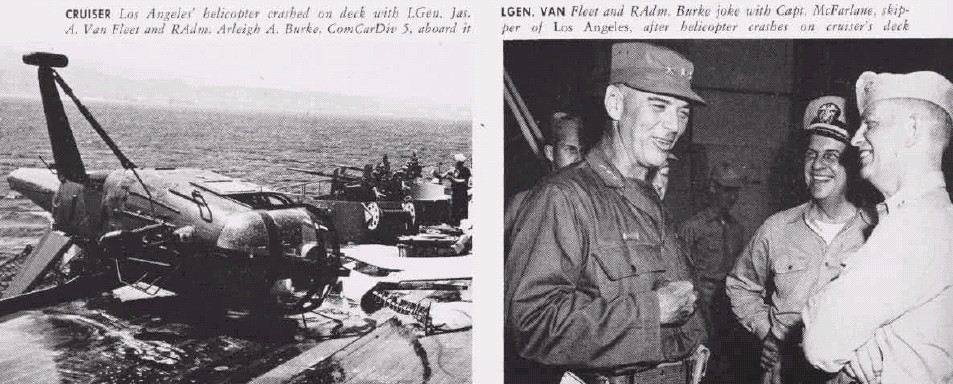
The following excerpts from U.S. Naval Aviation News reveals that replacing fixed-wing seaplanes on cruisers/battleships with helicopters has brought us much grief when we should have ADDED a helicopter to the seaplane fighters we had--that's PROGRESS but instead in the zero-sum small minds of our Navy brass we have had to suffer with REGRESS ever since 1949. We've not had real cruiser capabilities to scour the seas independantly ever since! Only clusterfucks around a few oversized aircraft carriers! Is it a wonder piracy is on the rise?
Problems that wouldn't have happened to SC-1/2 SeaHawks...
www.youtube.com/watch?v=qe0sRaXJqyI
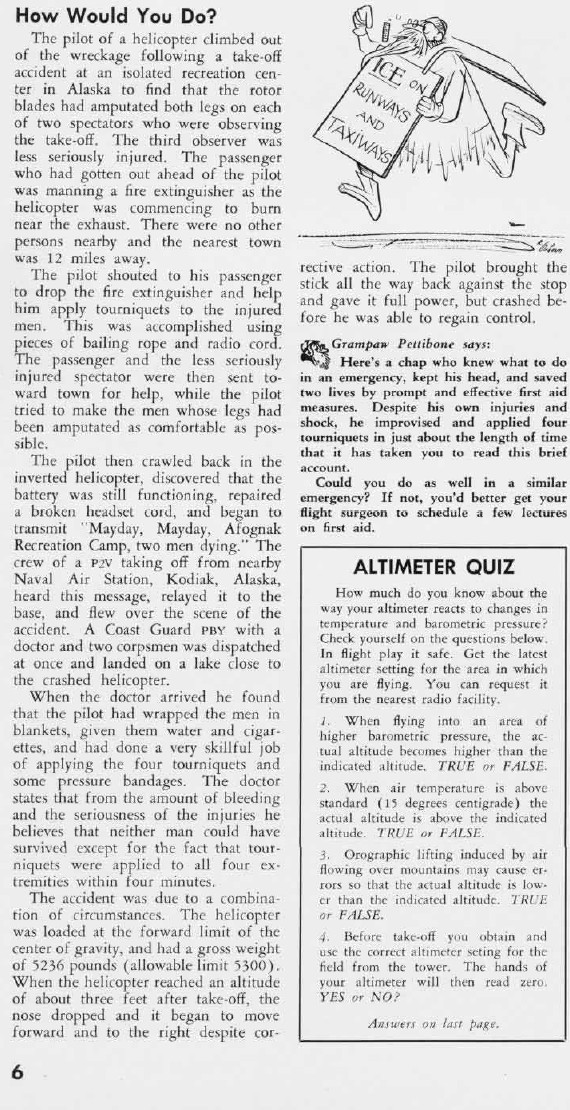
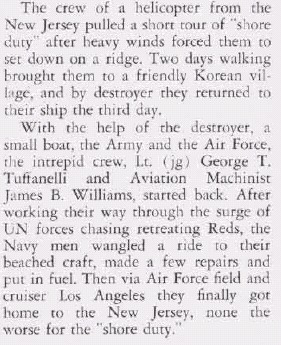
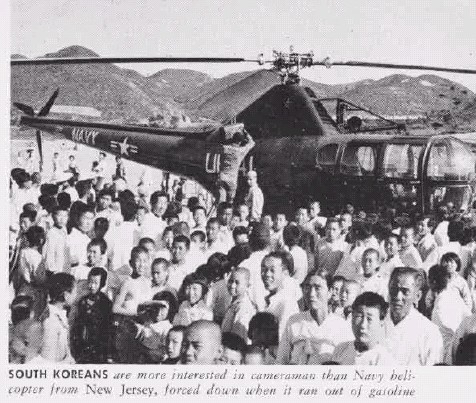
So much for human "progress" actually REGRESS at helm controlled by Navy brass; in a few years we will not have any large seaplanes, either.
Thoughts on Hurricat and MACs...
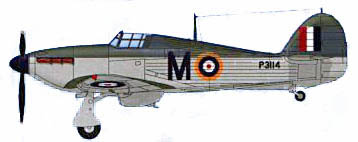
There were some level-headed types who saw that the war proved each surface ship needed some kind of its own aircraft for sea control protection notwithstanding the bogus claims of the carrier "mafia" that they would "protect them". However, the SeaHawks were retired and once a sound practice is no longer being done by an egotistical bureaucratic organization, its tough to bring it back as lies and excuses are allowed to harden in the minds of the stupid people elevated by groupthink and conformity to decision-making positions.
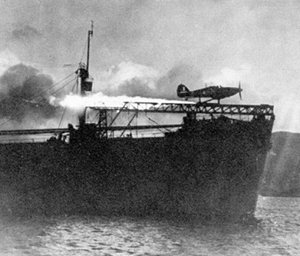
Why didn't you use this instead?
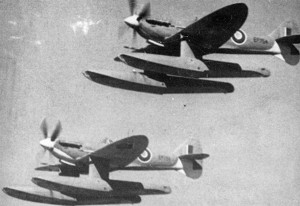
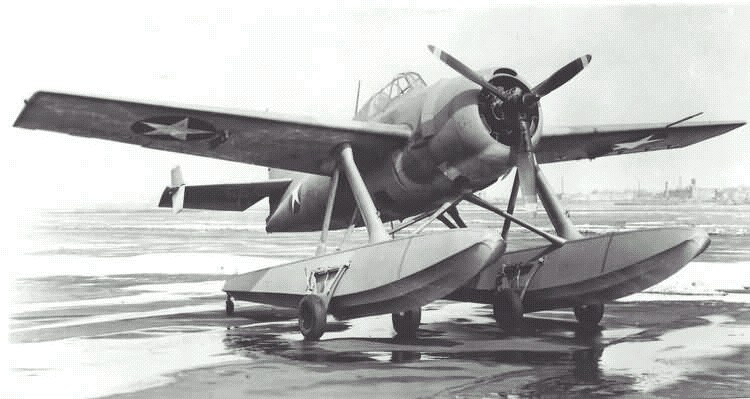
During the war, the British were so desperate to stop German FW-200 Condor long range maritime patrol plane and U-Boat attacks, they placed land Hurricane fighters on rails and shot them off merchant ships with rockets knowing the pilot after the mission would have to ditch into the extremely cold North Atlantic ocean! Why the British didn't rocket cat-launch fighters with floats that can be recovered and re-used during the whole duration of a convoy when the Spitfire was originally derived from a seaplane racing plane is a mystery...
The successful use of fabric-covered Hawker Sea Hurricane fighters rocket-catapulted from cargo ships to stop German Fw200 Condor maritime reconnaissance aircraft was both decisive and innovative with important air defense ideas we need to integrate today if our surface ships are to survive in the face of multiple, precision guided munitions attacks.
VIDEO
 www.youtube.com//watch?v=dtzWHDUtTJc
www.youtube.com//watch?v=dtzWHDUtTJc
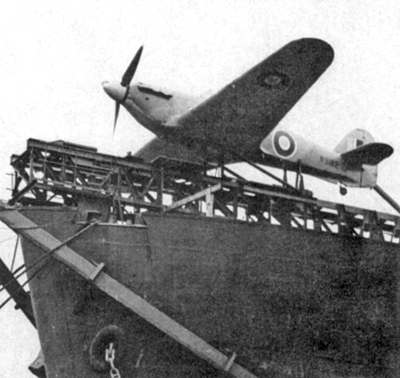
www.fleetairarmarchive.net/aircraft/seahurricane.htm
The Fleet Air Arm Sea Hurricane saw significant operational activities in many theatres of the war. They were involved in Operation HARPOON, Operation PEDESTAL to Malta, Operation IRONCLAD to Madagascar and in convoy duties where the aircraft claimed a high number of enemy aircraft shot down, the CAM ship Hurricats alone claimed six enemy aircraft destroyed in the last five months of 1941, the first success coming on 3 August 1941, when Lt RWH Everett intercepted and destroyed a Focke-Wulf Fw 200 Condor. Another typical operation was with FAA Hurricane W9215 flown by Sub Lt CW Walker of 804 squadron who took part in Convoy HG73. The aircraft was launched from Maplin on 14 September 1941 to drive away a Fw200, the pilot baling out into sea 100 miles southwest of Eire. He was later picked up by HMS Rochester and his aircraft lost.
http://en.wikipedia.org/wiki/CAM_ship
|
Date |
Ship/convoy |
Pilot |
Outcome |
| 3 Aug 41 |
HMS Maplin |
Lt Robert Everett |
Focke-Wulf Fw-200 shot down; pilot recovered by HMS Wanderer.[1][4] |
|
1 Nov 41 |
SS Empire Foam |
Flying Officer Varley |
Focke-Wulf Fw-200 chased off; pilot recovered by HMS Broke.[1][5] |
|
26 Apr 42 |
SS Empire Morn / QP 12 |
FO Kendal |
Blohm & Voss BV-138 chased off & Junkers Ju-88 shot down; pilot died from injuries received while bailing out.[1][5] |
|
26 Apr 42 |
SS Empire Lawrence / PQ 16 |
PO Hay |
two Heinkel He-111s shot down; Hurricane shot down, pilot recovered by HMS Volunteer.[1][5] |
|
14 Jun 42 |
SS Empire Moon / HG 84 |
PO Sanders |
Focke-Wulf Fw-200 chased off; pilot recovered by HMS Stork.[1][5] |
|
18 Sep 42 |
SS Empire Morn |
FO Burr |
two Heinkel He-111s destroyed; pilot flew to the Russian Keg Ostrov aerodrome.[1][5] |
|
1 Nov 42 |
SS Empire Heath / HG 91 |
FO Taylor |
Focke-Wulf Fw-200 shot down; pilot nearly drowned before recovery. [1][5] |
|
28 July 43 |
SS Empire Darwin / SL 133 |
FO Stewart |
Focke-Wulf Fw-200 destroyed; pilot recovered by HMS Leith.[1][5] |
|
28 July 43 |
MV Empire Tide / SL 133 |
FO Flynn |
Focke-Wulf Fw-200 destroyed; pilot recovered by HMS Enchantress.[1][5] |
In total, there were nine combat launches, eight aircraft and one pilot were lost for eight German aircraft destroyed and one damaged.
Re-Thinks...
The first thought is the whine that after launch, the Hurricat couldn't land back on the ship for re-use because it wasn't a seaplane. The first thought is MAKE A HURRICAT SEAPLANE FIGHTER ie; add floats. Of course this requires TIME and the Battle of Atlantic situation is desperate. OK, fine.
What can be done to make the Hurricat FLOAT?--so after the pilot does his job in the air, he can land alongside one of the convoy's cargo ships and possibly even have his plane recovered for re-use if the ship has a crane.
Why not coat the plane's underside with a thick water-tight paint/coating?
How about placing floatation foam all inside the insides to make it buoyant even if riddled with bullets?

www.fiddlersgreen.net/models/aircraft/Hawker-Hurricane.html
The early version's traditional fabric-covered metal frame, with wooden formers, gave it great strength. The thick wing not only produced a rate of climb higher than almost any aircraft of its time, but could also house eight .303" (7.70mm) machine guns, each with 500 rounds of ammunition, all firing outside the propeller arc. The retractable undercarriage was robust enough to withstand repeated bumping on grass airfields, and - due to the wide, split, trailing-edge flaps - landing speeds were little more than 57mph.
Refinements made to the Hurricane by the spring of 1940 included the fitting of a three-blade, constant speed propeller; an armour-plated bulkhead and bullet-proof windscreen; and metal-skinned wings (though the fuselage retained its fabric covering)
Just as the open girder work of Britain's radar towers made them immune to virtually anything but a direct bomb blast, the Hurricane's fuselage was able to withstand a tremendous amount of punishment from Bf-109 cannon shells exploding inside its structure. Like the Fury's the Hurricane's fuselage was made of steel tubing, around which was built a wooden frame of stringers and formers covered in fabric. This method of construction gave the Hurricane a distinct advantage over the Spitfire, whose stressed skin could better be compared with an eggshell.
While the Spit's eight Browning machine guns were widely spaced across its span, Camm put the Hurricane's punch in tight groups of four each side at little more than a quarter span. Inward-retracting undercarriage provided a wide, stable track for good landing qualities.
How about having the pilot wear a dry-suit so if he gets thrown into the water, he can survive exposure long enough to be picked up?
What about an inflatable one-man life raft that could deploy after he ditches?
Modern Applications
The USN needs to get off its ass and pronto--and start equipping some sort of long-range, long duration ASW seaplane fighters from EVERY ship it has to create an outer protective circle. Converting existing turboprop firefighting crop dusters like the AirTractor FireBoss with floats seems the fastest solution.
Note that Leland Snow's crop dusters are of METAL FRAMEWORK--just like the Hurricanes they will be far more combat damage rugged than stressed skin aircraft like trainers converted into observation/attack planes!
These aircraft or F-35B STOVLs fitted with air-to-air missiles (AAMs) must be able to provide air defense over surface fleets and civilian cargo convoys to prevent their complete destruction from PGMs.
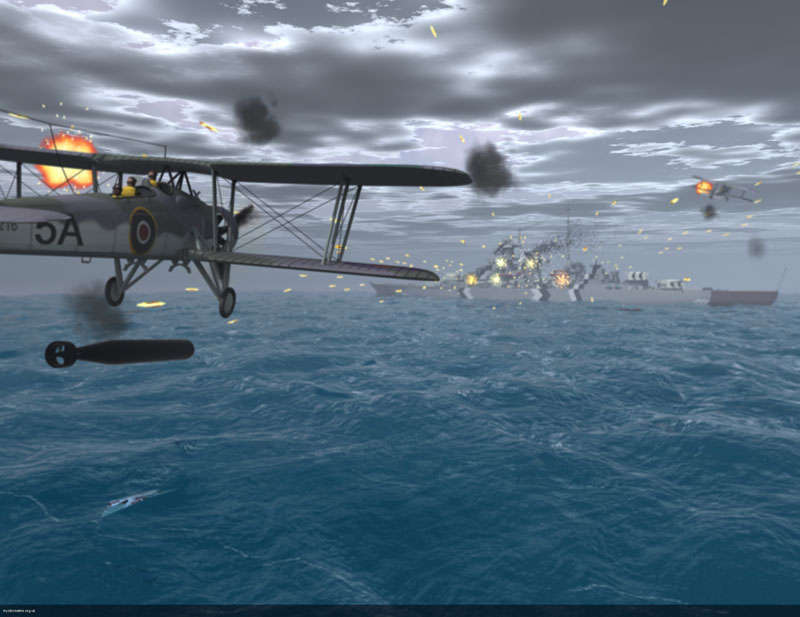
Swordfishes sinking the German battleship Bismarck whose AR-196 seaplane fighters did not take to the air to provide defense--combatant ships must have their own CAM-style seaplane fighters if they are to survive in the era of PGMs
Where were the German AR-196 seaplane fighters?
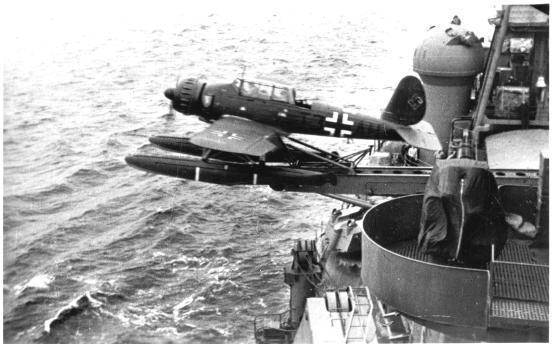
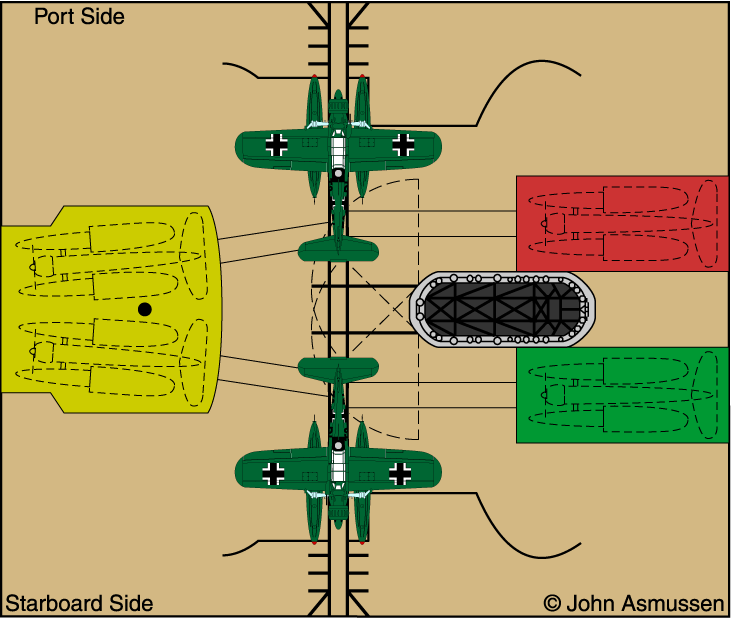
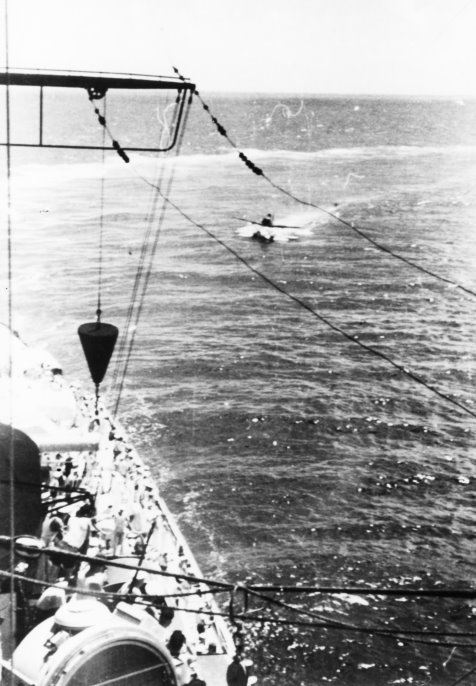
Merchant Aircraft Carriers (MACs)
www.combatreform.org/falklandslessonsnotlearned.htm
These are NOT escort carriers built from scratch at shipyards that also kicked ass!
These are exactly what we are proposing to get the required number of aircraft in the air today to thwart PGM attacks--convert existing container ships and supertankers into Merchant Aircraft Carriers (MACs).
The concept was 100% successful in WW2. The USN aircraft carrier racketeers want to continue to con you into thinking that the ONLY way to get aircraft at sea is by their expensive and bloated supercarriers--which means not enough quantity and quality of aircraft types will be put to see to prevent our surface fleets from being sunk.
http://en.wikipedia.org/wiki/Merchant_aircraft_carrier
Merchant aircraft carrier
From Wikipedia, the free encyclopedia
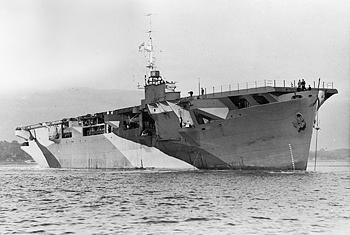
HMS Activity, formerly Empire Activity
Merchant Aircraft Carriers (MAC) were bulk cargo ships with minimal aircraft handling facilities, used during World War II by Britain and the Netherlands as an interim measure to supplement British and United States-built escort carriers in providing an anti-submarine function for convoys. The original intention had been that they would be an interim measure preceding the wider introduction of escort carriers.[1]
Contents [hide]
1 Gestation
2 Ship details
3 Air Party
4 Aircraft
5 Ships
5.1 Empire class grain carriers
5.2 Empire class oil tankers
5.3 Rapana class oil tankers
6 See also
7 References
8 External links
Gestation
The idea of simple adaptations of bulk cargo ships for aircraft had been considered by the Admiralty for some time. It would provide desperately needed air cover for convoys without losing valuable cargo capacity. There was, however, resistance to the concept arising from several technical issues; the 12 knot speed was considered too slow for aircraft operation, the design and development time was expected to take too long and aircraft movements on steel decks over highly flammable fuel cargoes was considered too dangerous.[1]
The then Director of Merchant Shipbuilding, Sir James Lithgow, made a rough design on the back of an envelope and offered to adapt two ships about to be built at his family's shipyard. This was on condition that "I am not interfered with by the Admiralty". Work started in June 1942 on two grain carriers, Empire MacAlpine and Empire MacAndrew. Ten more were ordered by October and a total of thirty-two were planned (cut back to nineteen with the delivery of escort carriers).[1]
Ship details
The Merchant Aircraft Carriers were modified bulk grain carriers or tankers built with flight decks and small island structures. Minimal aircraft handling and accommodation facilities were available. The bulk nature of the cargoes did not need deck mounted cargo-handling gear used for general cargoes. The MAC-ships were manned by a Merchant Navy crew, under merchant colours, the Royal Navy provided the air department and the guns were manned by DEMS soldiers. They carried their regular cargo in addition to operating aircraft. Tanker MAC-ships were able to carry about 80 percent of their original cargo, the remaining space being taken for Avgas stowage to Admiralty safety standards. Grain carrier MAC-ships suffered a reduction of about 3,000 tons (or 30 per cent) of the original cargo of grain. Their Fairey Swordfish aircraft carried out anti-submarine patrols around the convoy.[2][3]
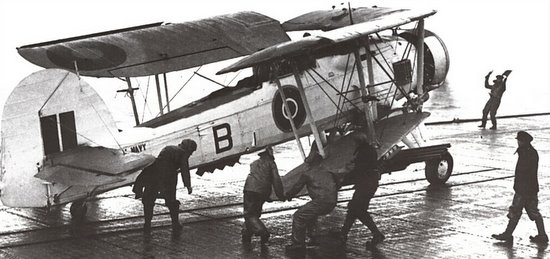
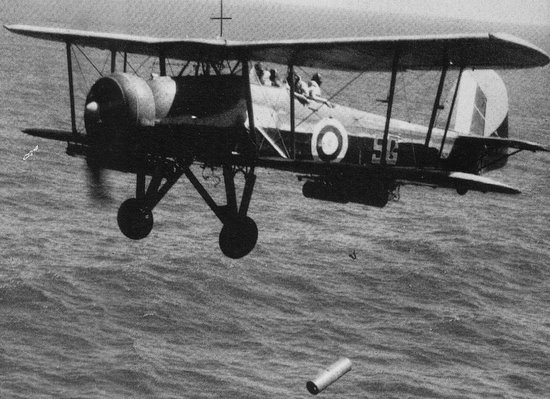
Swordfish
showing its folding wings and dropping depth chargesThe scale of the conversion was small, hence it could be completed in a short time; five months has been quoted as being typical.[1]
The fuel piping arrangements in a tanker made it impossible to build a hanger under the flight deck, so tanker conversions were limited to embarking three Fairey Swordfish which had to be kept on deck. Collapsible deck-edge wind breaks were fitted on the flight deck aft to provide some protection for parked aircraft. The grain carriers had a small hangar aft with a single lift which allowed the carriage of four Swordfish. Flight decks were around 460 feet (140 m) long on the tankers and between 413 and 424 feet for the grain ships, width was 62 feet (19 m) in all cases. All the MAC-ships were fitted with four arrester wires. The permanent deck park of the tanker MAC-ships required a barrier for aircraft recovery. Aircrew accommodation was minimal and ammunition and fuel stores were neither armoured nor partitioned.[3]
Many of the ships were given names with the prefix "Mac-", in a reference to their designation as MACs; the "Empire" prefix was used on ships built by the Ministry of War Transport to distinguish them from pre-war privately owned ships. Since these ships were owned by the Government and only on loan to the shipping companies it was easier to take them out of service for conversion.
Air Party
The 'Air Party' was the Fleet Air Arm personnel who flew and supported the aircraft, but was under the nominal authority of the merchant ship's commander. It consisted of an Air Staff Officer (Lt-Commander), the aircrew, a doctor, a batsman (landing control officer), ten ship's gunners, four signalmen, and three or four Able Seamen. The Merchant Navy part of the crew might have an extra mate and/or wireless operator but was otherwise unchanged and operated under Merchant Navy conditions.
The aircrew on each ship formed one flight of the MAC-ship Wing which consisted of 836 and 860 Naval Air Squadrons, based at HMS Shrike, RNAS Maydown, near Derry in Northern Ireland. 836 NAS was manned by the Royal Navy and 860 NAS was manned by Dutch personnel and assigned to the two Dutch MAC-ships.
An informal, illegal benefit for aircrews was their ability to smuggle contraband without paying import duties. Aircraft were flown off to RNAS Maydown laden with goods which were usually unloaded and hidden before HM Customs could intervene.[1]
Aircraft
Fairey Swordfish at an airshow in 1988. This aircraft was assigned to 'L' Flight of 836 Squadron on board the MAC ship Rapana during World War II. Two aircraft types were considered for use on MAC ships: the Swordfish and the Vought SB2U Vindicator (known in British service as the "Chesapeake"). Fifty Chesapeakes were delivered, but after a three month-trial, they were deemed unsuitable by the Admiralty and relegated to a training role.
However, there is evidence that Sea Hurricanes were deployed aboard MAC ships. The Fleet Air Arm web site states:
www.fleetairarmarchive.net/aircraft/seahurricane.htm
"The Sea Hurricane Mk I were followed by about 300 Mk Is converted to Sea Hurricane Mk IB configuration, these having catapult spools plus a V-frame arrester hook: in addition 25 Mk IIA were modified as Sea Hurricane IB or Hooked Hurricane II fighters. Their initial role was a considerable improvement on CAM-ship deployment, for from October 1941 they began to go to sea aboard MAC-ships, these being large Merchant ships fitted with a small flight deck."
In practice, the MAC ships were successful. The apparently antiquated, but robust, Swordfish aircraft were suited to the conditions and their patrols were very effective. They flew more than 4,000 sorties in all. Wartime records show that no convoy with an accompanying MAC ship ever lost a vessel to U-boats, nor was any MAC ship lost[1].
Ships
Empire class grain carriers
Aprox. 8,000 tons deep load, 12 knots, 4 aircraft, crew 107, launched December 1942-January 1944. Equipped with hangar and lift. Armament: x single 4 in (102 mm) QF MK IV, 2 x single 40 mm Bofors, 4 x single 20 mm Oerlikon cannons.[2][3]
MV Empire MacAlpine
MV Empire MacAndrew
MV Empire MacCallum
MV Empire MacDermott
MV Empire MacKendrick
MV Empire MacRae
Empire class oil tankers
Aprox. 9,000 tons deep load, 11 knots, 3 aircraft, crew 122, launched May-July 1943. BP tankers. No hangar and lift; aircraft maintained and stored on deck. Armament: 1 x single 4 in (102 mm) QF MK IV, 8 x single 20 mm Oerlikon cannons.[2][3]
MV Empire MacCabe
MV Empire MacColl
MV Empire MacKay
MV Empire MacMahon
Rapana class oil tankers
8,000 tons standard, 16,000 tons deep load, 12 knots, 3 aircraft, crew 118 (64 RN plus 54 MN), converted 1942-44. Anglo-Saxon Petroleum Company tankers. No hangar and lift; aircraft maintained and stored on deck. Armament: 1 x single 4 in (102 mm) QF MK IV, 2 x single 40 mm Bofors, 6 x single 20 mm Oerlikon cannons.[2][3]
MV Acavus
MV Adula
MV Alexia
MV Amastra
MV Ancylus: operated Swordfish II of 'O' Flight, 860 NAS
MV Gadila: operated under the Dutch ensign with Swordfish of 'S' Flight, 860 NAS
MV Macoma: operated under the Dutch ensign with Swordfish of 'O' (later 'F') Flight, 860 NAS
MV Miralda
MV Rapana: operated Swordfish II of 'L' Flight, 836 NAS
Amastra and Ancylus ceased operating Swordfish in late 1944, the empty decks often being used to ferry aircraft from the USA to the UK.[3]
See also
CAM ship
Armed merchantmen
References
^ a b c d e f Wragg, David (2005). The Escort Carrier in World War II. Barnsley, UK: Pen & Sword Books. pp. 12-24. ISBN 1-84415-220-0.
^ a b c d Mitchell, W H, and Sawyer, L A (1990). The Empire Ships. London, New York, Hamburg, Hong Kong: Lloyd's of London Press Ltd. ISBN 1-85044-275-4.
^ a b c d e f Hobbs, David (1996). Aircraft Carriers of the Royal and Commonwealth Navies: The Complete Illustrated Encyclopedia from World War I to the Present. London: Greenhill Books. pp. 231-248. ISBN 1-85367-252-1.
External links
World Aircraft Carriers List Photo Gallery: Dutch Aircraft Carriers
Misc: Merchant Aircraft Carrier Empire MacRae
Retrieved from "http://en.wikipedia.org/wiki/Merchant_aircraft_carrier"
Categories: Ship types | Merchant aircraft carriers
However, instead of seaplanes proven after years of service/combat success and simply placing a crane with at least one improved seaplane on every surface ship---to include merchant and sealift ones---and creating a force of seaplane fighter aviators and maintainers, NAVAIR went looking for a lazy technological solution since the uninspired conventional helicopter would never be an air-to-air threat any time soon---if ever.
The Flimsy Surface Ship is Doomed in the Era of PGMs:
www.combatreform.org/thendendofflimsysurfaceships.htm
POGO: Convoy Defense Fighter

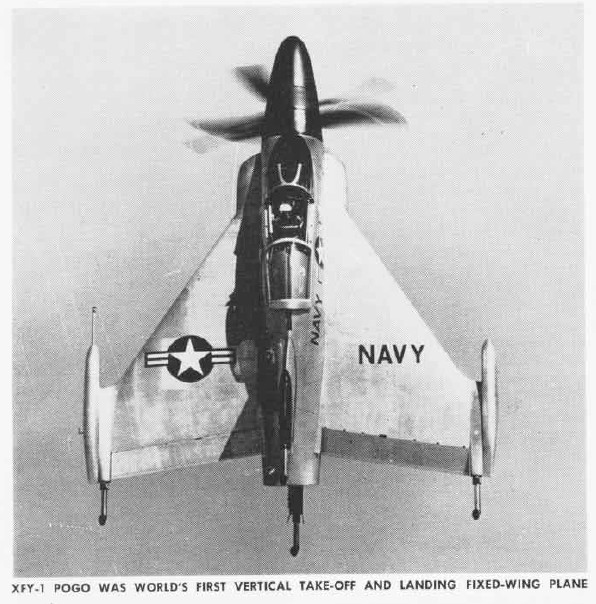
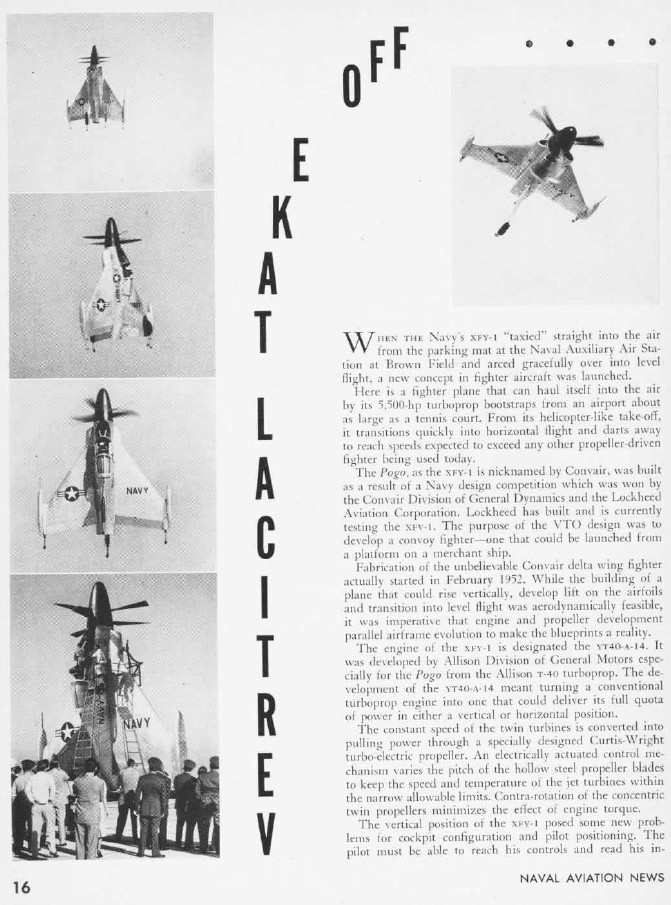
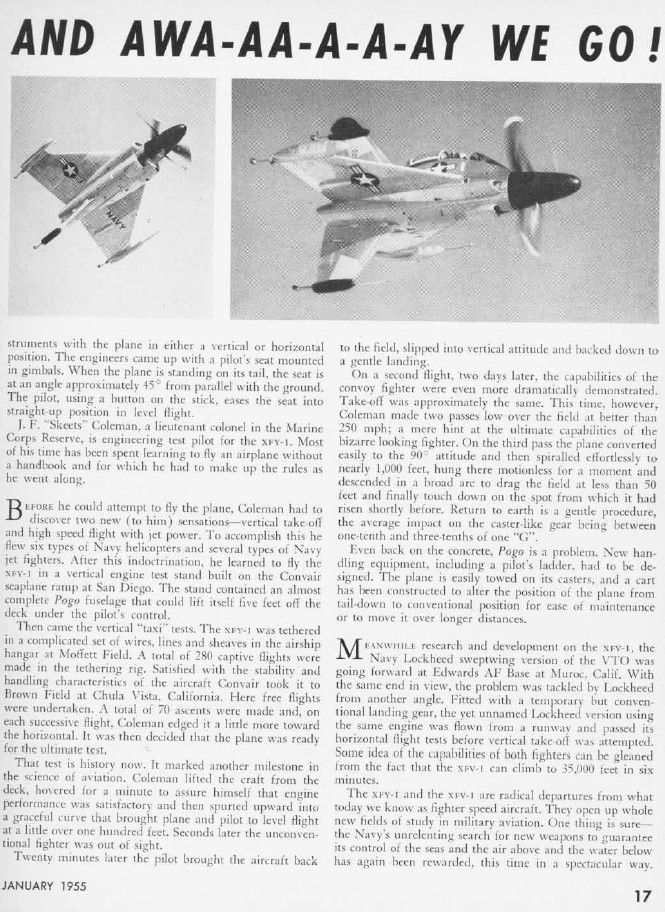
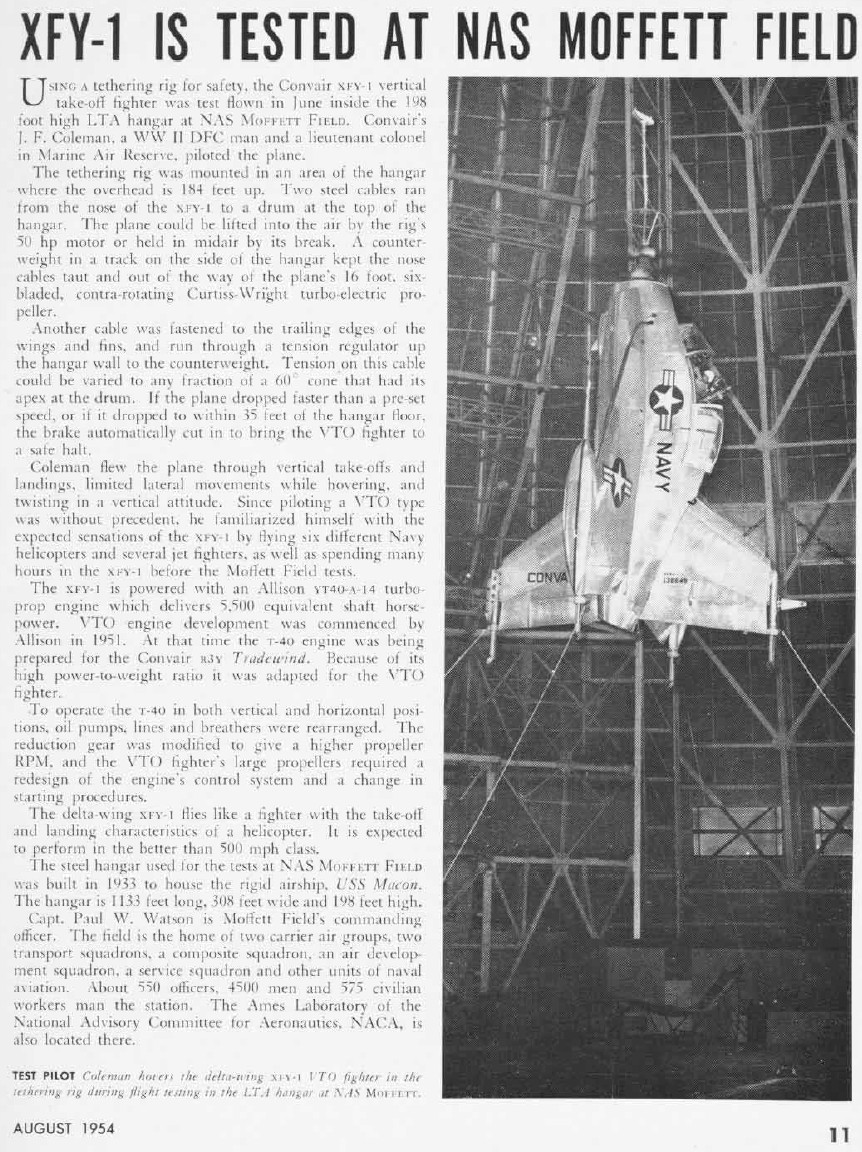
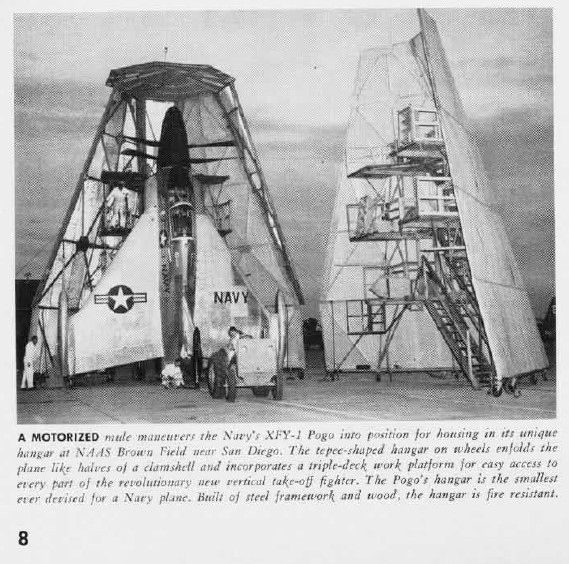
To avoid landing in the water and the aerodynamic penalty of floats or floating fuselages, VTOL was tried with the Pogo. Pogo would try to take-off and land with the plane standing on its end. Taking off was straight-forward, backing down looking over your shoulder was too much.
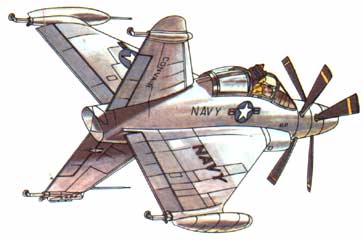
The U.S. Navy's Bureau of Aeronautics in 1951, after having ordered two prototypes of the revolutionary supersonic XF2Y-l seaplane, issued a Request for Proposals for a single-seat vertical take-off and landing fighter which could be used to escort convoys, based on cargo vessels which did not have flight decks. The U.S. Navy accepted Convair's submission and in March 1951 ordered the XFY-I as well as placing an order for Lockheed's project, which was designated XFV-1 (q.v.).
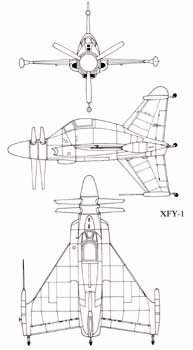
The Pogo, as the XFV-1 was called, had a short, stubby fuselage, on which were mounted two near-delta wings and two enormous fins, one ventral and one dorsal, giving the arrangement a cruciform appearance. A small wheel was attached to the apices of all four of these surfaces and when parked, the aircraft rested, nose in the air, on these four wheels.
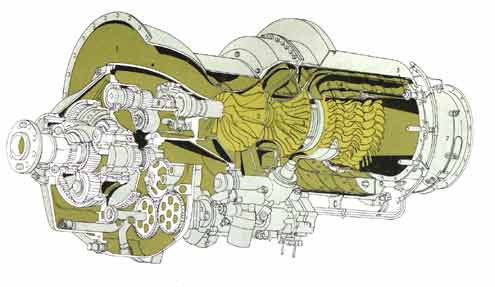
Power was supplied by a 5,850 shp Allison YT40-A-6 turboprop engine, driving two coaxial propellers and a large spinner. The ventral fin could be jettisoned in flight were it necessary to make an emergency belly landing (on land or sea).
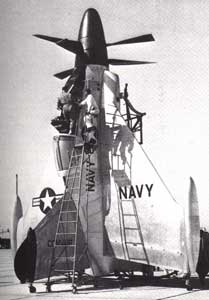
By March 1954 the prototype was completed and taken to Moffett Field naval base in Sunnyvale, California where, inside an enormous hangar, braced by a special rig to prevent any possible chance of the aircraft toppling over, powered tethered tests were carried out, during which the aircraft was allowed to lift itself a few inches off the ground.
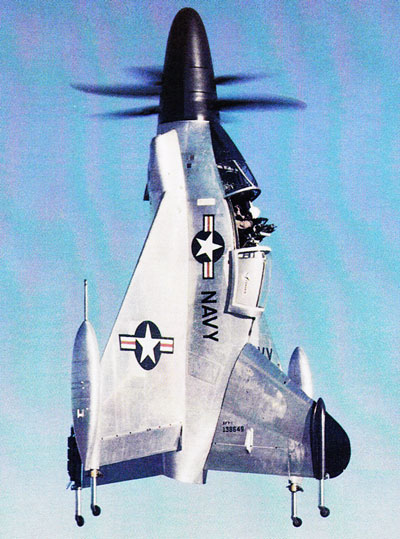
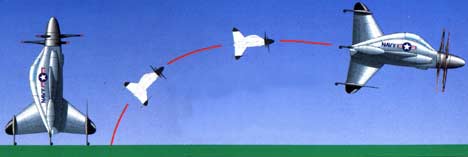
Finally on August 1, 1954, the XFY-1 was taken outside the hangar and it was up to the test pilot, J.F. (Skeets) Coleman to make the first vertical take-off; the plane rose to a height of 40 feet, followed by a trouble-free landing.

The XFY-1 was then taken to the Naval Auxiliary Air Station at Brown Field for further testing and this culminated, on November 4, in the first complete experimental flight: the aircraft achieved vertical take-off, subsequently carried out the transition from vertical to horizontal flight and flew normally for about 20 minutes, before lowering itself gently to the ground. "Skeets" Coleman was very enthusiastic about the XFY-1 and his verdict was that he found it easier to handle and more maneuverable than any other plane he had ever flown.


There was no doubt that the XFY-1 project was a success so far but the U.S. Navy did not feel it was a practicable proposition for series production and deployment as a warplane at that point. There were still many problems to overcome; not least the pilot's uncomfortable accommodation as well as the need to develop a zero-altitude ejector seat for his safety. Before the test program was halted, however, the XFY-1 flew for a total of 40 hours and earned itself the distinction of being the first vertical take-off and landing aircraft to fly successfully in the history of aviation.
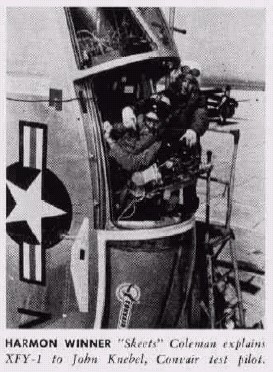
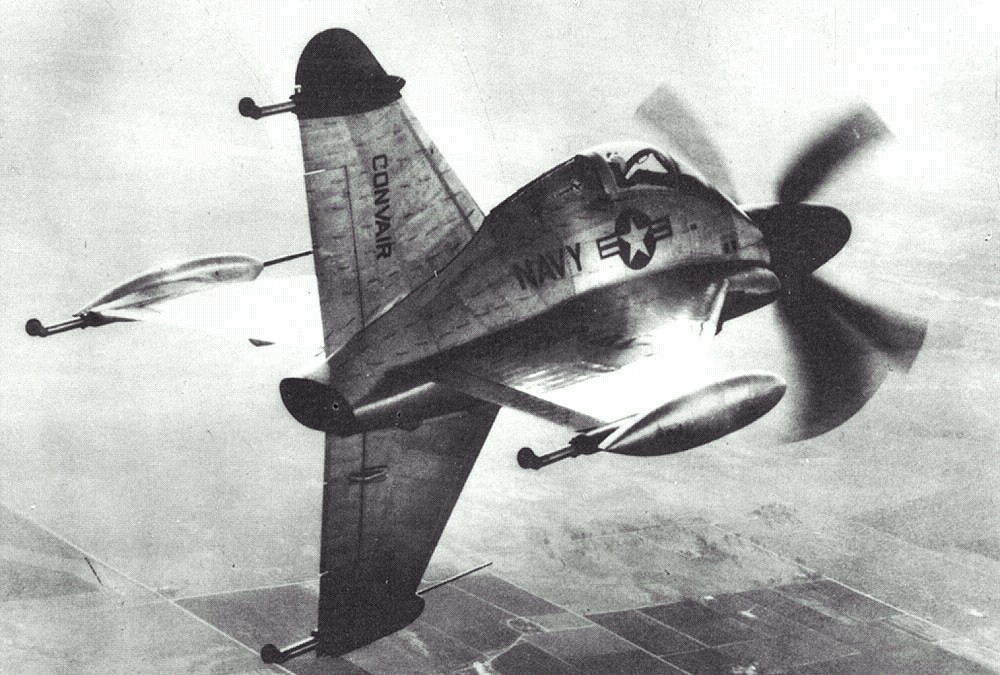
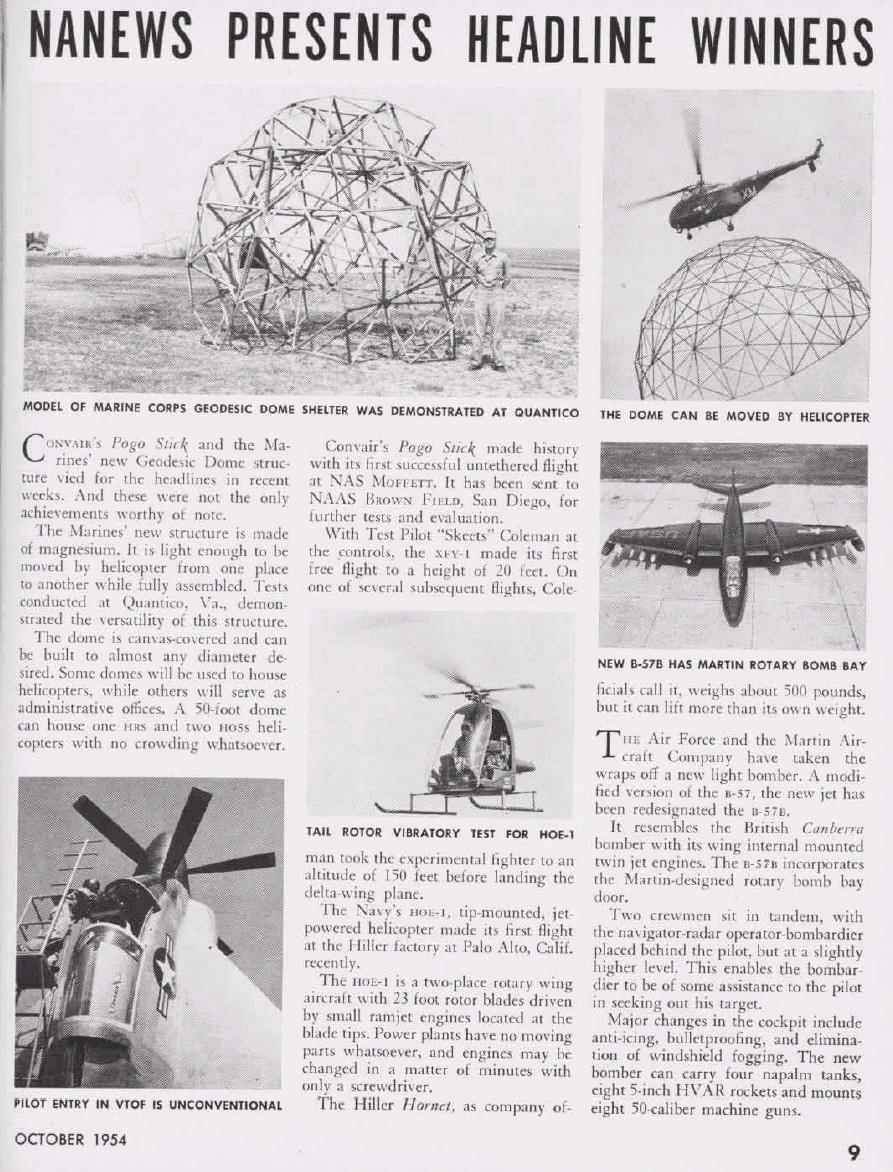
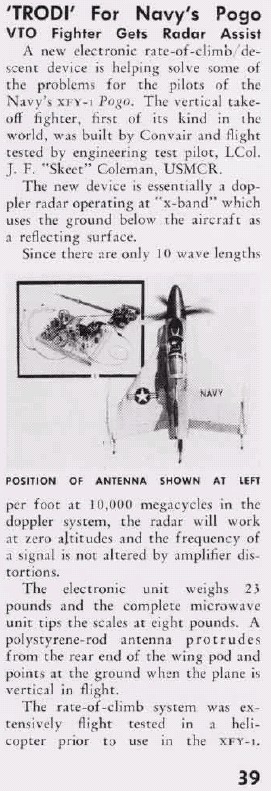
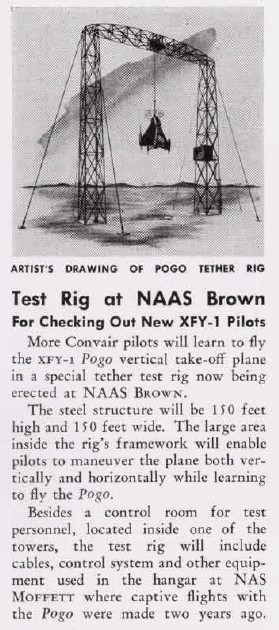
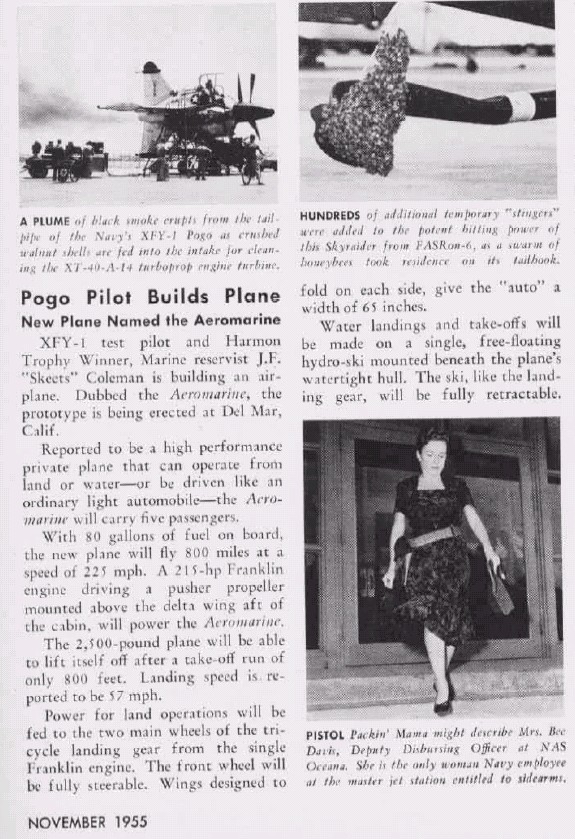
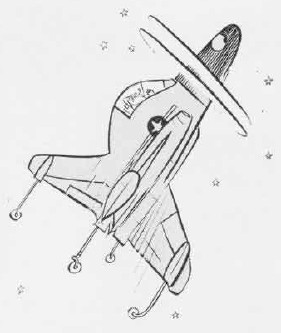
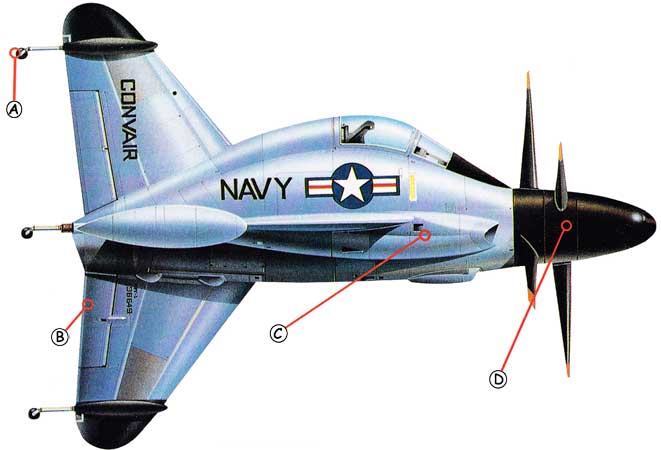
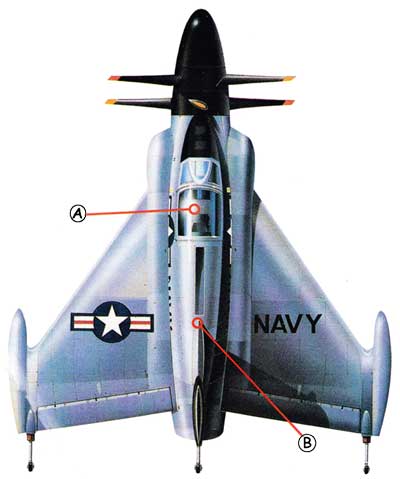
MODELS
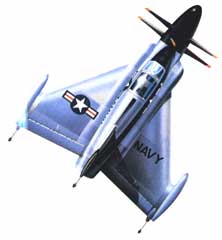


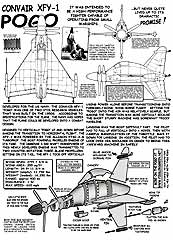

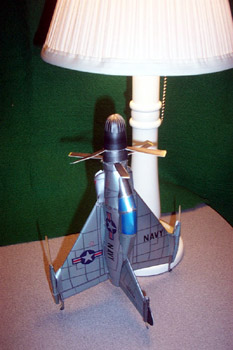
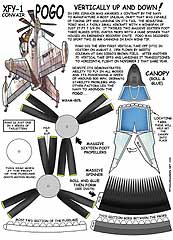
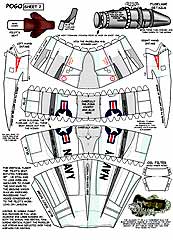
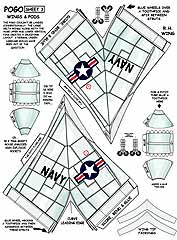
SATIRE
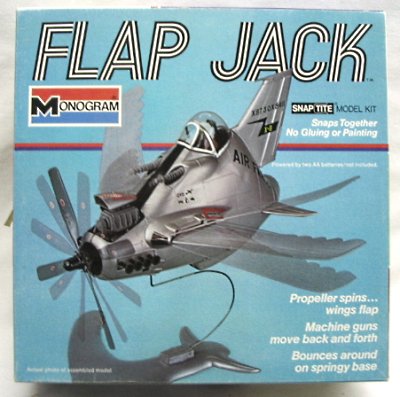
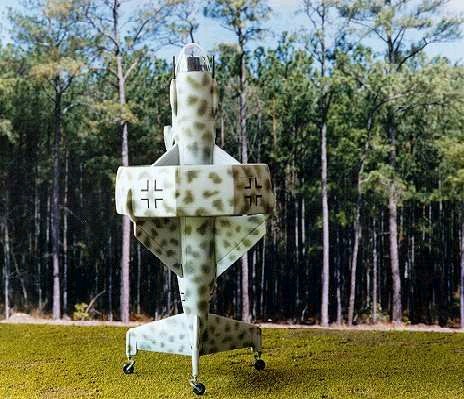
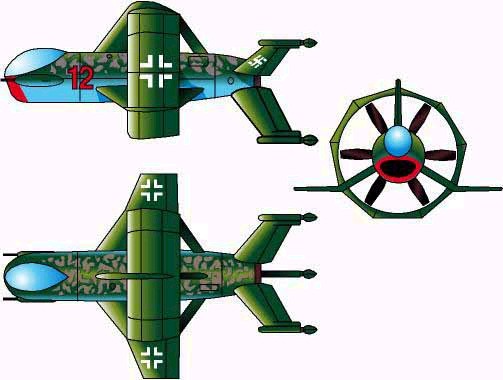
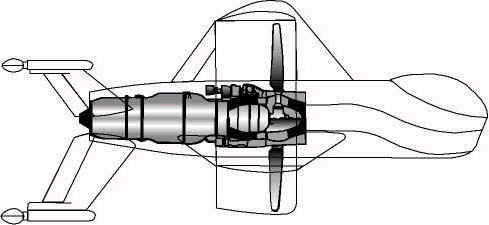
www.luft46.com/heinkel/hewespe.html
The Heinkel "Wespe" (Wasp) was designed in late 1944 at the Vienna Heinkel works as a VTOL (Vertical Take Off and Landing) interceptor. It was mainly to be used around factory complexes as a "point defense" interceptor, much like the Bachem Ba-349 "Natter". The Wespe was designed around a circular wing, with small wing tips protruding beyond the circular wing at the two lower wing support locations. A single He S 021 turboprop (the turboprop development of the He S 011 jet engine), driving a six-bladed propeller, provided 2000 horsepower plus 750 kp thrust and was fed by an air intake located below the cockpit. The Wespe took off and landed on three landing gear, which in flight were covered for aerodynamical purposes. The pilot sat in a normal seated position in the nose under a huge blown canopy, and two MK 108 30mm cannon mounted in blisters on each side of the cockpit were envisioned for the armament. Further development was not carried forth due to the approaching war's end, and that a more aerodynamic, cleaner VTOL project (the "Lerche II") was also in the design phase.
Span: 5 meters (16' 5")
Length: 6.2 meters (20' 4")
Max. Speed: 800 km/h (497 mph)
OBSERVATION:
Take-off
Why not just use catapults to launch regular fighters from essentially zero distances? Here's a picture of a F-6F Hellcat and TBF Avenger being launched like a seaplane from a short catapult from THE INSIDE HANGER OF A U.S. CARRIER IN WW2! Some WW2 carriers had this capability (still a good idea if you have prop planes with no jet back blast). Ship catapults could be on land.
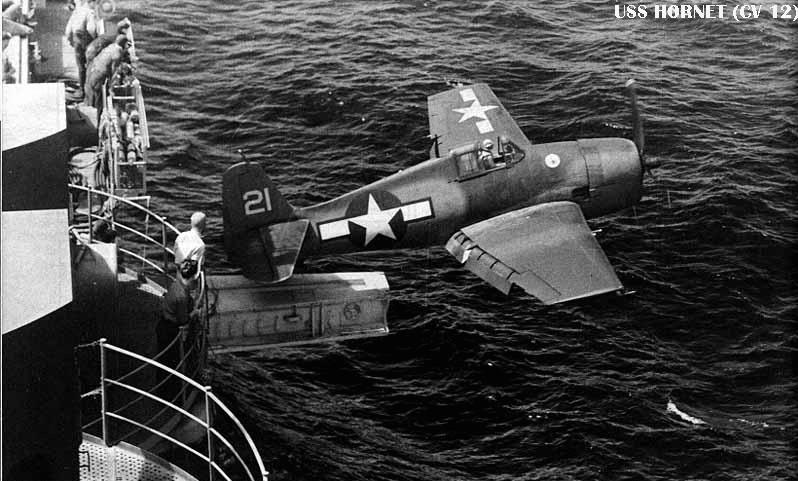
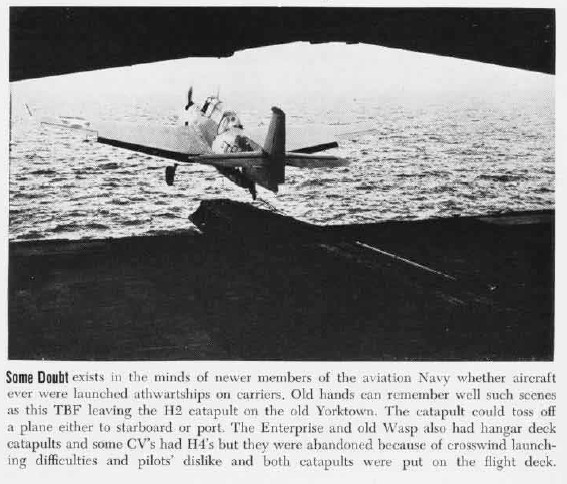
Or use ZEL rockets and a steep or vertical ramp to get into the air fast from the factories you want to defend.
Landing
Must the tail-sitter land back down on its end with pilot unable to see? Notice the Germans were not even thinking of trying this on a pitching ship at sea. Why not land the tail-sitter normally like Phil Carter proposes with his HUMMINGBIRD?
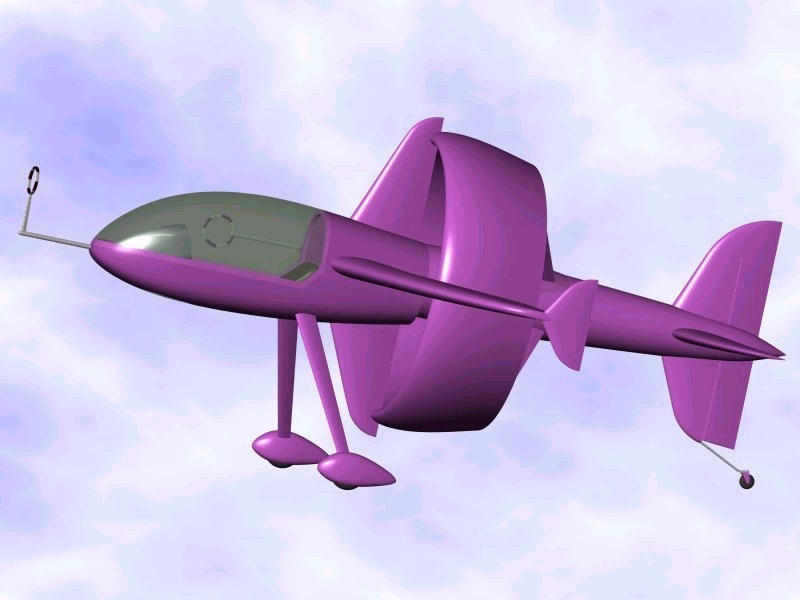
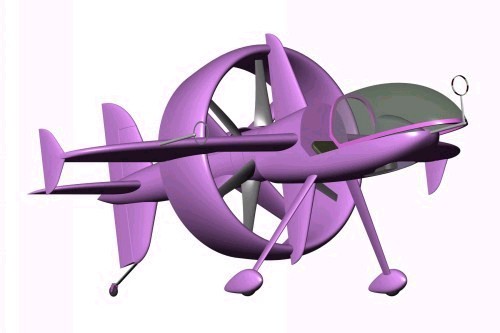
This doesn't get us a VTOL fighter at sea, though. Would a tail-sitter vertical landing work if the pilot had a TV camera feeding him a view looking down? How about a rear gunner/co-pilot in back to do the landings? Retired LTC Larry Altersitz writes:
"Today, you could do it with a radar/laser/IR system to measure ground distance. They are putting similar systems in vehicles to aid people in backing up and to see if there is someone/thing behind the vehicle."
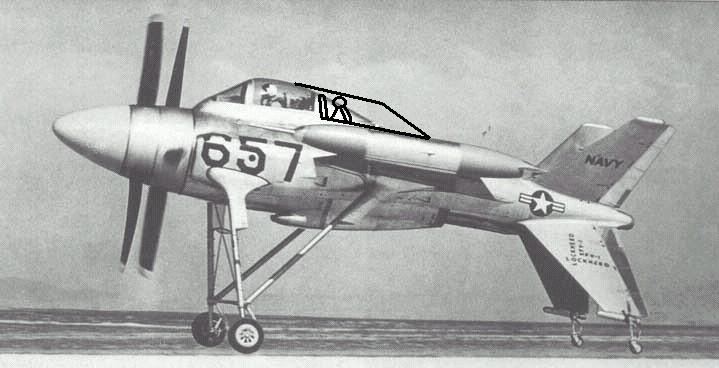
Above is a picture of the Lockheed tail-sitter candidate that I've drawn in a back-seat co-pilot/gunner who could LAND the plane vertically by his seat swiveling to face rearward so he can see what he is doing on the way down. The Lockheed XFV-1 and German Wespe have X shaped tails so a rear-facing pilot could see to the rear that the Convair POGO candidate's tail blocks.
Another idea offered was to have the pilot's canopy area to bend/hinge for landings/take-offs:
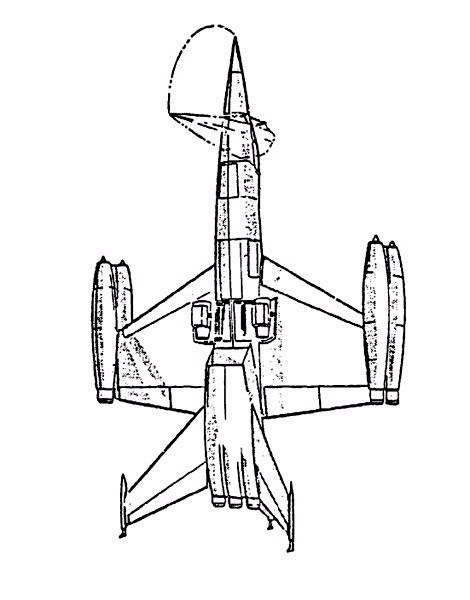
Just a thought.
Aircraft with a high-trust-to-weight ratio can be launched vertically without sitting on their tails if they are held into position. Here's a proposed sea control ship configuration that has them landing normally in a horizontal position.
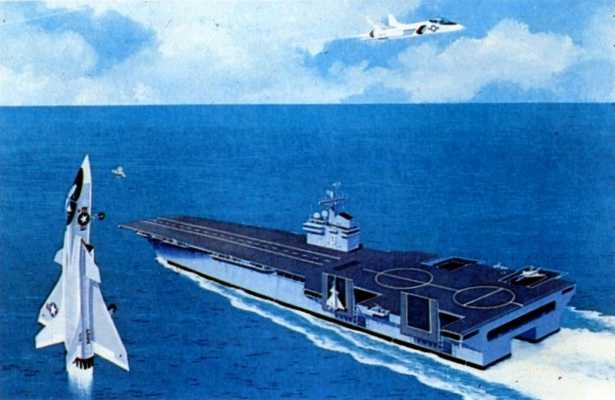
Skate
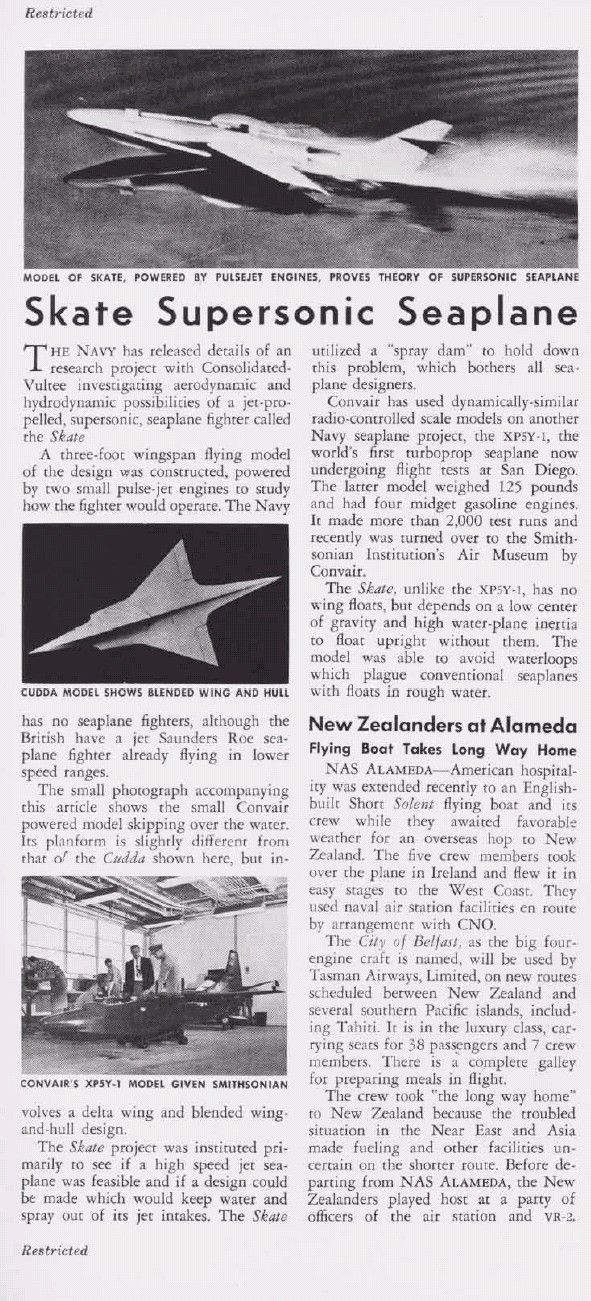
"If you believe in the future of a thing, you better be doing it in the present"
Here, the imaginations of common sense industry designers is in play while the actual Navy isn't even operating ANY seaplane fighters in the present tense, having thrown their fabulous SC-1/2 SeaHawks away.
Saunders-Roe S50
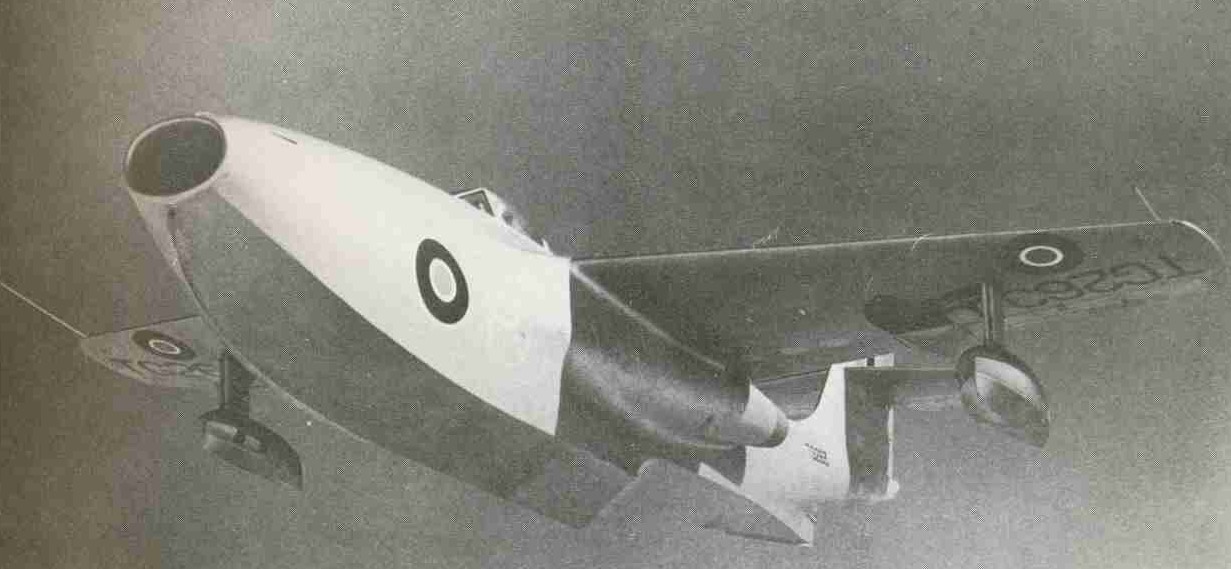
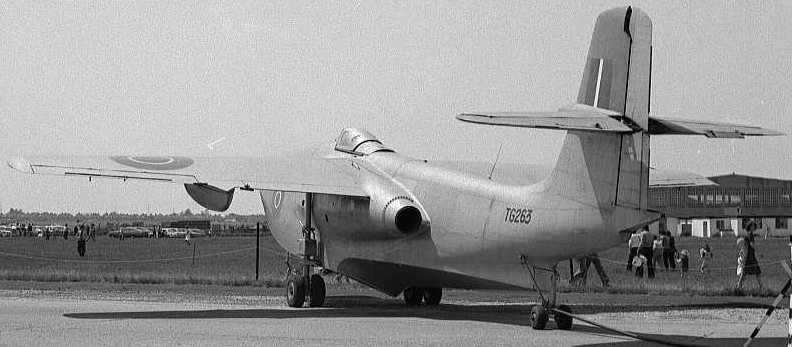
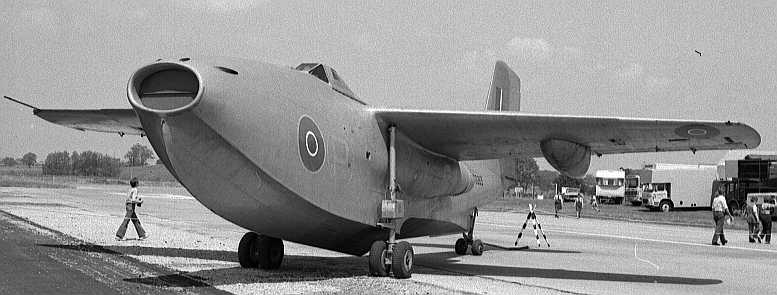
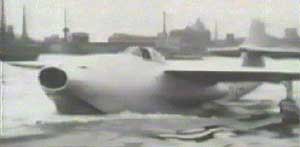
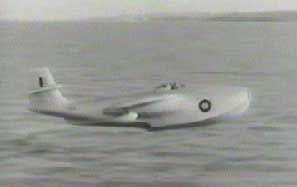
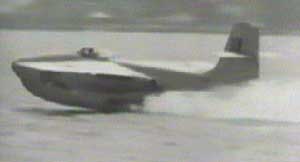
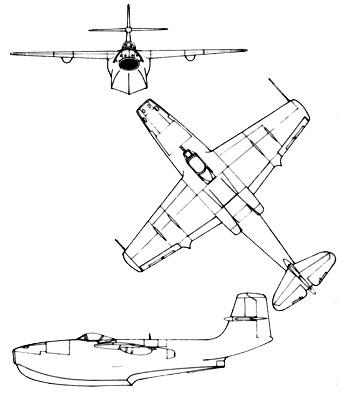
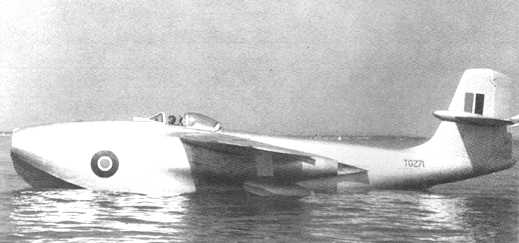
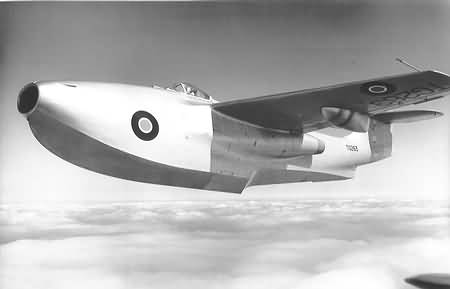
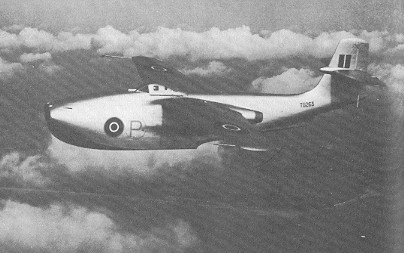
VIDEO
www.youtube.com/watch?v=d9ks7RF9TBM
The British more than anyone else remembered from WW2 how close they came to losing the war to submarines and maritime patrol aircraft sinking the cargo ships they needed to survive. Stung by MILLIONS of men lost in two world wars, they would never be an empire again. Full of inventive people, the British would come up with most of the ideas the Americans with a much larger land mass and population base would have the money to exploit. The dry deck aircraft carrier itself, the angled deck, the Harrier etc. were all British inventions the Americans took and perverted.
One of the British inventions the Americans ignored was the Saunders-Roe seaplane fighter of the early 1950s which could easily been catapulted from cargo ships and then land next to them and be craned aboard to effect convoy defense. However, WW2 was over and no U-Boats were threstening, so the Brits shelved the idea when they should have pursued it and developed a CONVOY DEFENSE BRANCH OF THE ROYAL NAVY (RN) that would specialize in converting cargo ships into defacto seaplane tenders in time of war. When the container ship arrived, this branch of the RN could have further developed the "Arapaho" concept of using ISO containers to make expedient dry deck aircraft carriers using VSTOL with light load aircraft like the Harrier which saved them during the Falklands war in 1982. In human organizations, important practices have to be sustained over time by organizations with budget and a mission mandate or else these capabilities will not be there when needed during a "rainy day" like a nation-state war where national survival is in jeopardy.
Douglas Model 640 Seaplane Fighter version of the A-4 SkyHawk
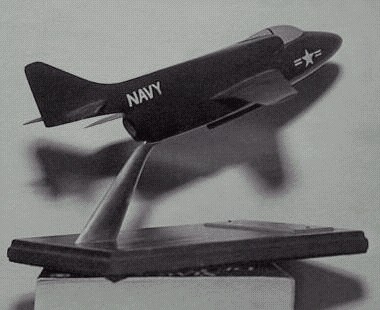
The USN also stole money dishonestly from Congress to allegedly create a SUBMARINE AIRCRAFT CARRIER capability; of course not giving any credit where credit was due to the Japanese for actually using submarine aircraft carriers in COMBAT in WW2. Why the low-risk, sensible seaplane SkyHawk was not also used as a SURFACE ship seaplane fighter just goes to show you how the Navy was not serious about seaplanes lest they infringe on their bloated large aircraft carrier scam.
SeaDart
www.youtube.com/watch?v=VT-N-ReR-ls
www.youtube.com/v/W1iJV4qgW9s
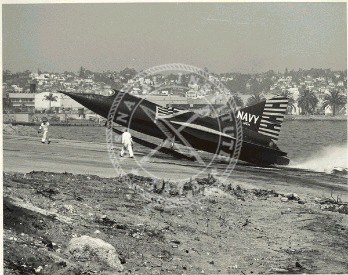
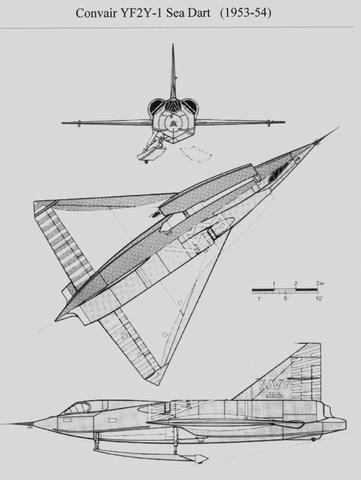
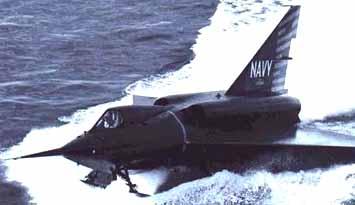
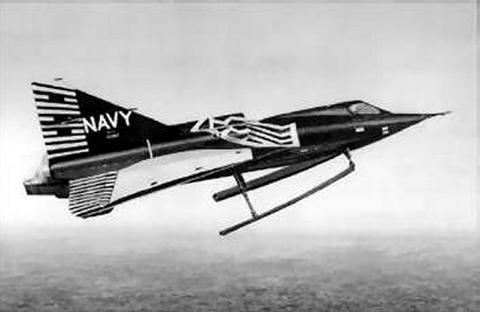
Bush pilots in the northwest USA/Canada discovered they could use snow skis to land on water as long as they kept moving and alerted the Navy.
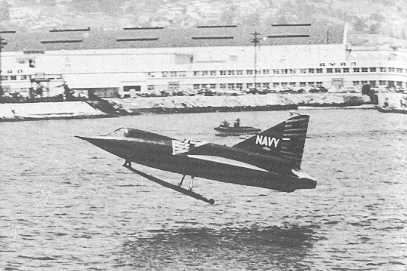
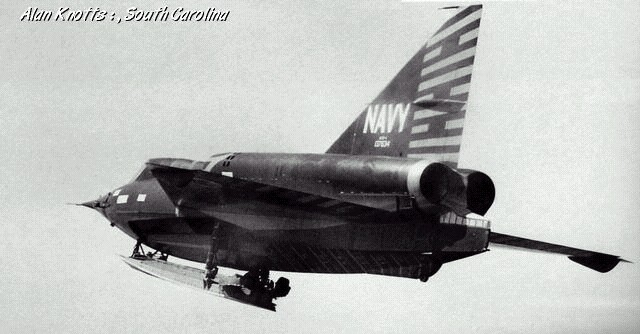
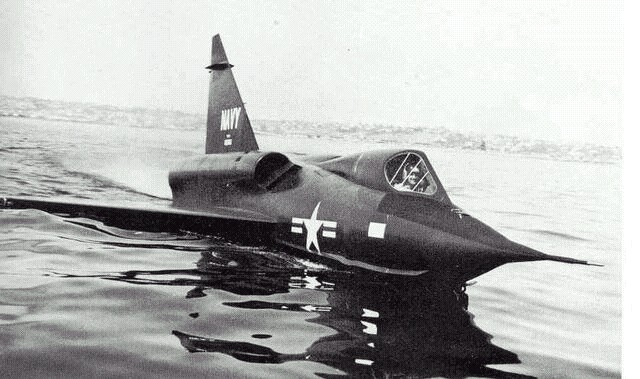
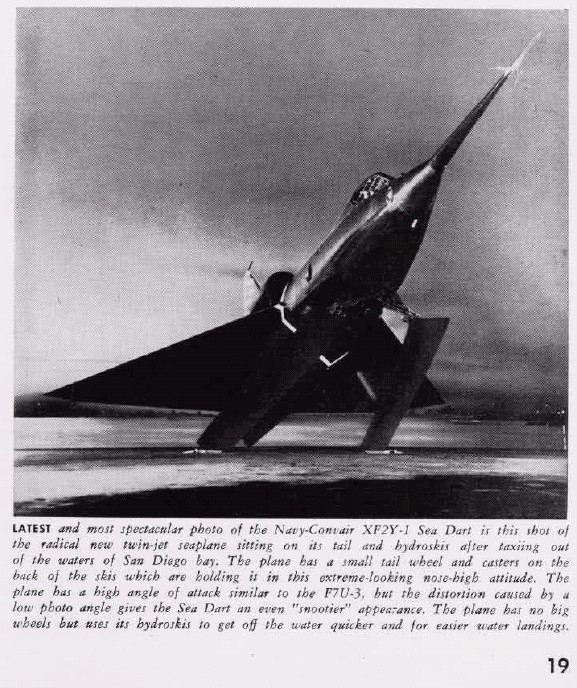
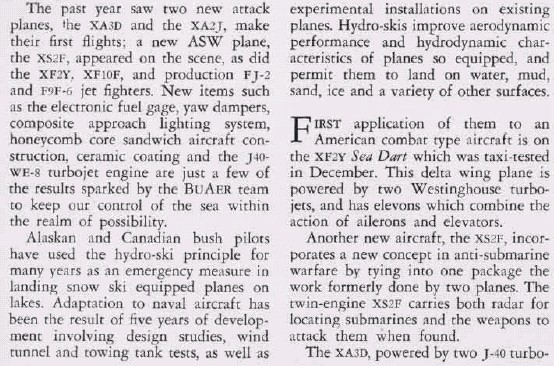
Skis as-is do not even harm the flight performance of aircraft by more than 10% and if they retracted into the aircraft would impact 0%. Without floats or even a boat-hull fuselage shape like the British S50, seaplanes would be identical to land plane speed, range, climb and maneuverability flight performances. A purpose-built jet seaplane fighter using skis and a floating fuselage/wings structure would be the next generation "JetSeaHawk" aircraft that should have supplemented the SC-1/2/3 series prop SeaHawks had the Navy not been corrupted by the Midway Myth. Nevertheless, in the 1950s there were still enough WW2 veterans that remembered the German U-Boat and enemy air threat in general to know that a handful of large carriers would not cut it and that a ship defence seaplane fighter was required. Another aspect was the technological enthusiasm for jets meant $$ from Congress that the selfish and greedy Navy would never say no to. They'd take the money and build some "golly, gee-wiz" seaplanes and have no intention whatsoever of ever building them lest they threaten their large aircraft carrier Midway Myth racket.
Thus, the amazing SeaDart was born with no intention of ever being a part of the Navy mafia "family".
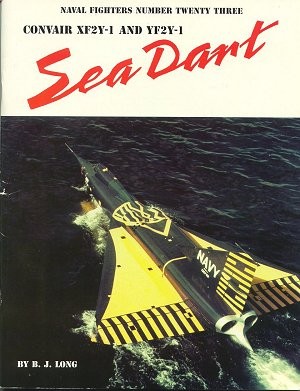
In contrast to the books written by real American patriots like above, here's the politically correct and flagrantly dishonest at the end "no operational requirement" BS short history of the SeaDart from the National Air & Space museum:
www.nasm.si.edu/research/aero/aircraft/convair_seadart.htm
Seaplanes (aircraft that use some form of pontoon rather than wheels) have played a major role in the development of aircraft. Waterborne craft were developed by many nations in the early years of flight because harbors were readily available and accessible as compared to airfields. Flying boats pioneered most international airline operations through the 1930s. The U.S. Navy relied heavily on them from 1911 through the Second World War and beyond. During the Vietnam war, for example, Martin P-5M flying boats were used extensively for coastal and shipping patrols.
On 19 January 1951, Convair received an order from the U.S. Navy's Bureau of Aeronautics to develop two XF-2Y1 aircraft to be equipped with twin hydroskis (the twin hydroskis were "planing" skis and derived lift the same as a person using water skis. They were not skis that provided lift in the same manner as hydrofoils.). They were to be prototypes of a definitive water-based, single-seat, afterburning supersonic interceptor/fighter. This action resulted in an experimental test program that began in December 1952 and continued through 1957. A total of five aircraft, dubbed SeaDart, were built. Only three ever flew. The last two were completed except for engine installation.
The first XF-2Y1 aircraft, Bu. No. 137634, is part of the Air & Space Museum's collection. The remaining four were YF-2Y1 aircraft, Bu. No. 135762 through 765, built and numbered consecutively. The SeaDart aerodynamic design is best illustrated by the No. 3 aircraft (763). Unfortunately, these aircraft were designed, built, and flown before the supersonic "area rule" was first incorporated in aircraft designs. The area rule revealed that streamlining the aircraft fuselage into an hourglass shape, to compensate for the wing area, reduced aerodynamic drag-the unseen forces that slow aircraft down and increase thrust requirements. Compounding the issue, high-thrust engines were not available at that time.
On 14 December 1952, E. D. "Sam" Shannon, Convair's Chief of Engineering Flight Test, took the XF-2Y1 SeaDart out into San Diego Bay for its first taxi tests. The aircraft "taxied" up the seaplane ramp after its first test run. Small wheels at the aft end of the skis plus a small tail wheel provided this land taxi capability. The airplane entered the water the same way. Taxi down the ramp was made with the ski oleos in the beach position for attitude purposes. Upon attaining flotation, the main wheels on the ski afterbodies were rotated 90 degrees by electrical switch and hydraulic action to place the tapered afterbody of the ski in the proper hydrodynamic position. Takeoff was accomplished by a combination of ski extension, retraction, afterburner thrust, and a rapid rotation at take off speed. Two Westinghouse J46 engines producing 4,000 lb. of thrust (augmented to 6,000 lb. with afterburner operating) powered the SeaDart during most of its testing. The characteristic sharp rotation and liftoff was necessary to achieve positive separation from the water allowing rapid acceleration. The skis could be retracted immediately as with any retractable landing gear.
On 9 April 1953, Shannon made the first flight of the XF-2Y1. The dark blue paint with yellow markings provided aircraft attitude reference in instrumentation photos of taxi tests including take off and landing. Two afterburning Westinghouse J34 engines were soon replaced by Westinghouse's more powerful J46. The second SeaDart exceeded Mach 1.0 on 3 August 1954.
The taxi tests revealed serious vibration and pounding that drastically increased with rougher water. In mid-1954, the first SeaDart was refitted with a single ski in an effort to reduce vibration during water operations. The final flight of the twin-ski version was made on 28 April 1955.
Normal landing and takeoff procedures for both the twin-ski and single-ski configuration were to maintain a heading parallel to the major wave or swell condition and into the wind as much as possible. Usually, this involved a crosswind component of 30 to 60 degrees. Landing or takeoff directly into any sizeable wave pattern or swells was unacceptable and not attempted. A smoke float deployed during operations indicated wind conditions. Except for being underpowered, the open-sea handling characteristics were considered excellent by the test pilots. This was despite the 120-knot takeoff speed and 125-knot landing speed.
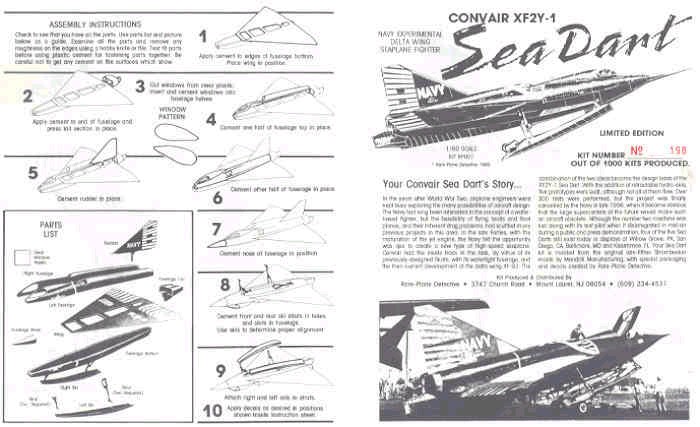
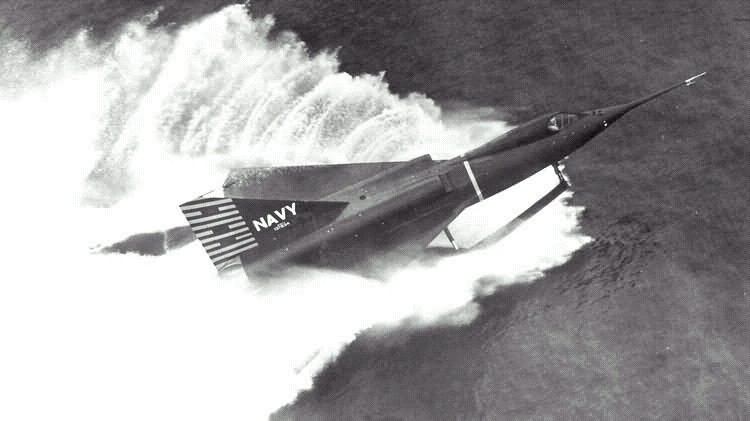
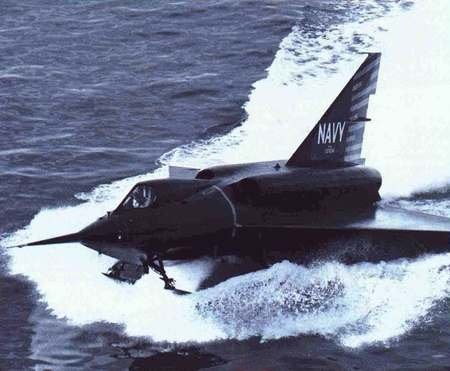
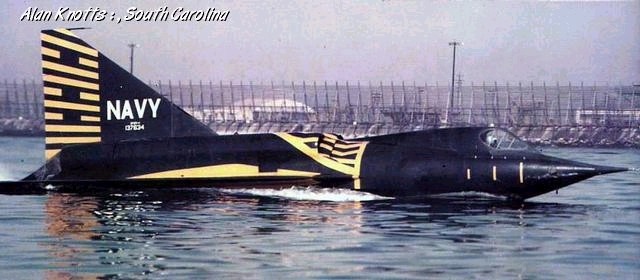
The large single-ski and oleo configuration finally derived for the XF-2Y1 aircraft was a very sound and satisfactory design for use on a delta wing, water-based, supersonic aircraft. The SeaDart test program also proved the feasibility of designing and developing supersonic water-based aircraft for support of Navy Fleet Operations. Because of the lack of an approved operational requirement and the lack of funds for such an aircraft, the U.S. Navy did not continue SeaDart development. [EDITOR: if there was no requirement to have ships defend themselves with their own seaplanes there wouldn't have even been a SeaDart or a POGO program to begin with. Duhh. This is an outrageous lie. The requirement is obvious from WW2 experiences and in writing. The money wasn't there because the BS carrier mafia didn't want it to be spent on anything but themselves]
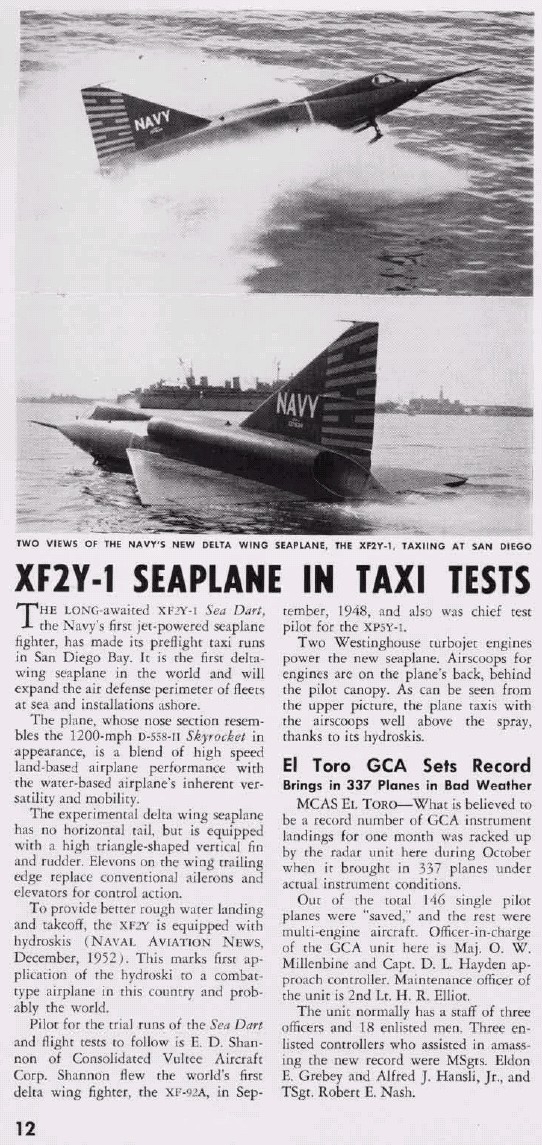
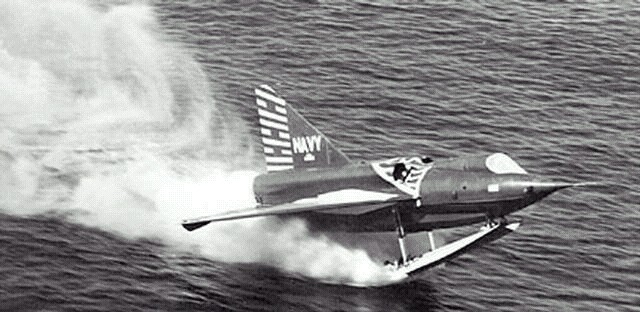
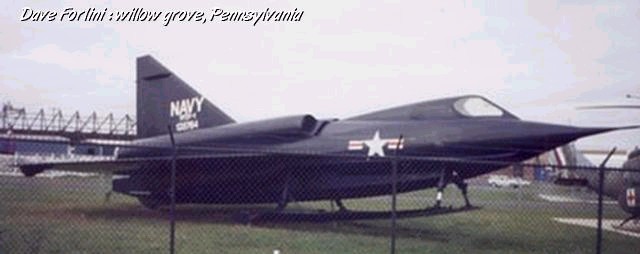
SeaDarts are on display at several museums reminding us what we should do if we ever got our Navy run by non-corrupt men with common sense.
SeaDart-on-steroids: Lockheed Hydrofighter
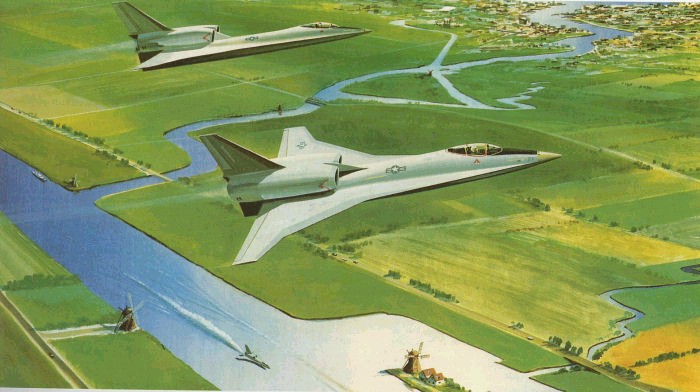
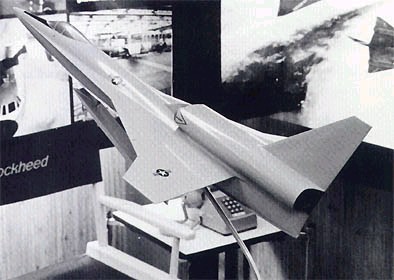
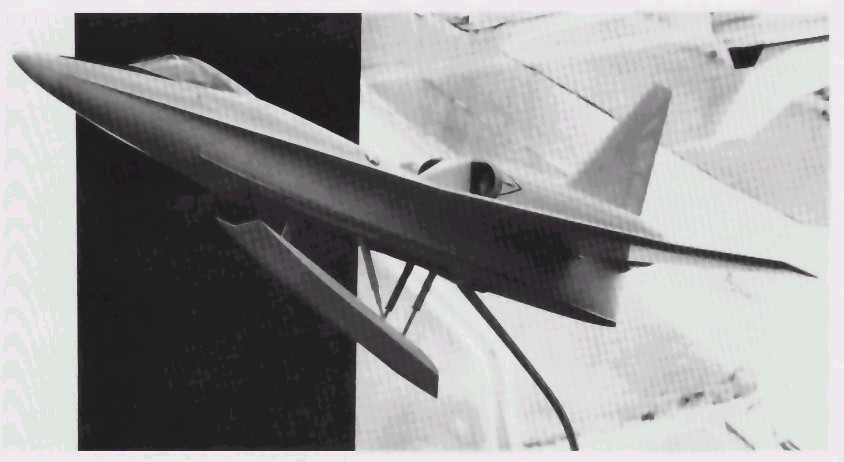
In the '70s Lockheed, which makes GREAT AIRCRAFT but is run by greedy assholes offered a Mach 2 SeaDart type seaplane which was ignored of course, by the USN/Mc.
As you can see the seaplane fighter was examined by using SKIS to land in the water and would retract in flight to eliminate the drag penalty. This succeeded with the amazing Convair SeaDart. However, now that the aerodynamic handicap of seaplanes were finally solved with the SeaDart, Tradewinds and SeaMaster, the Navy brass had to act quick to kill this threat to their multi-billion dollar aircraft carrier floating cash cows. All 3 seaplanes were cancelled using flimsy excuses to hide the fact that it was from sheer corruption and power that made the Navy reject seaplanes after they had flourished. The only evil comparable to the Navy's seaplane backstab is the Air Force's rejection of Jack Northrop's YB-49 "Flying Wing" and Burnelli's lifting body technology to persist with inefficient, unsafe tube and wing land-based aircraft. The thousands of people who have died post-WW2 from a lack of seaplanes and safer Burnelli designs is horrific and obscene.
When Pogo and SeaDart were cancelled, the PROBLEM was also forgotten; a problem now that threatens the entire viability of the partial WW2 re-enactment U.S. Navy!
Sea Control anyone? Reality Check! What do we do about the Mess we are in today?
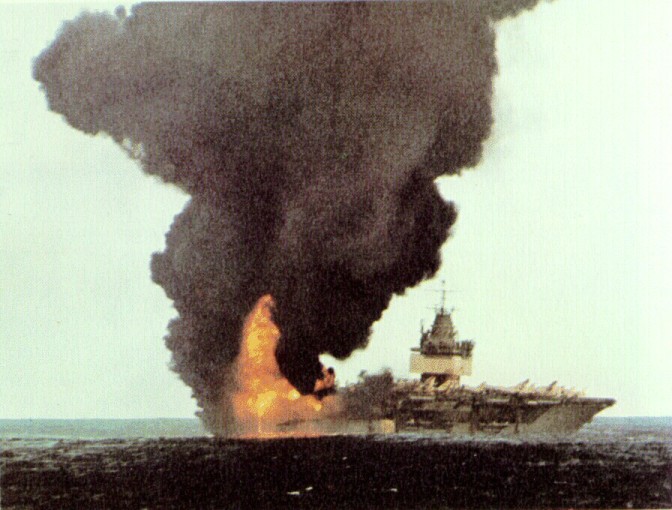
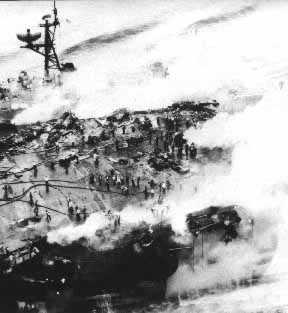
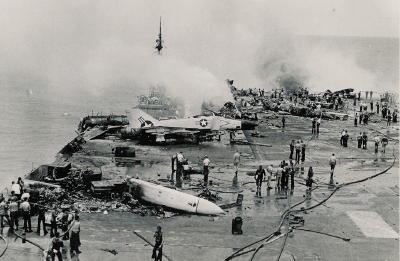
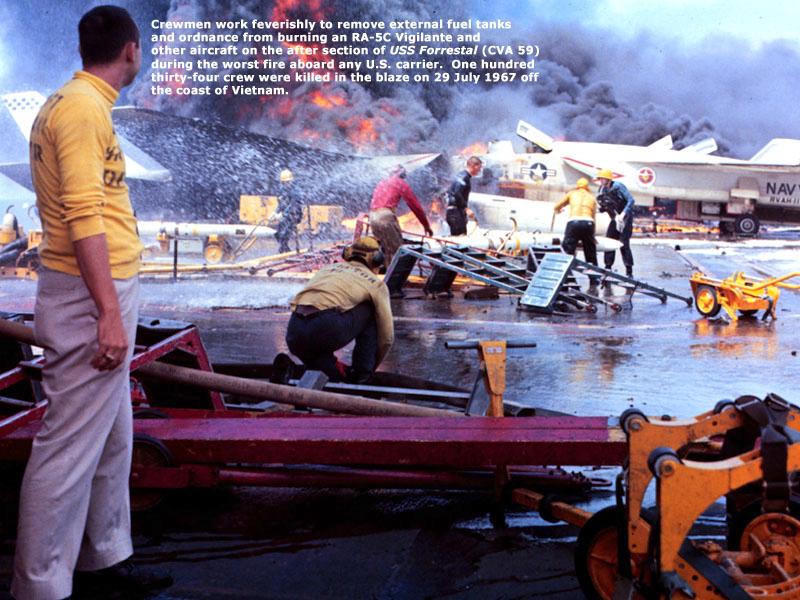
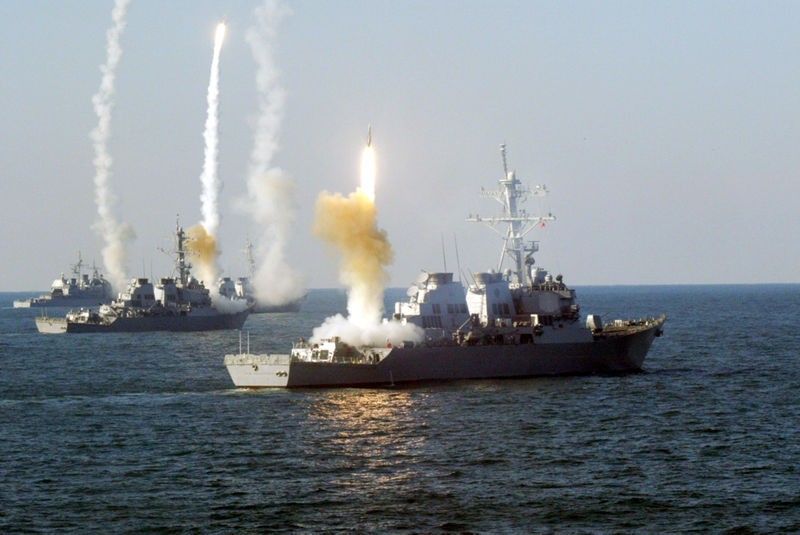
Its the height of hubris to think that our 11 aircraft carriers will be untouched and able to operate aircraft to fly CAP in an all-out missile war against a capable nation-state foe like Red China. We lost 11 aircraft carriers in WW2. Its down right fatal to make the same mistake of the Repulse and Prince of Wales and several other USN ships (see USS Pringle below) to think their onboard anti-aircraft weapons will be enough to ward off multiple enemy air attacks at the last second once they are upon you. The best way to defeat air attacks is to SPOIL them with your own aircraft.
Carriers eat aircraft. We should equip carrier plane fuel tanks with pop-out floats to at least salvage some of their expensive gear if they fail to land and go over the side.
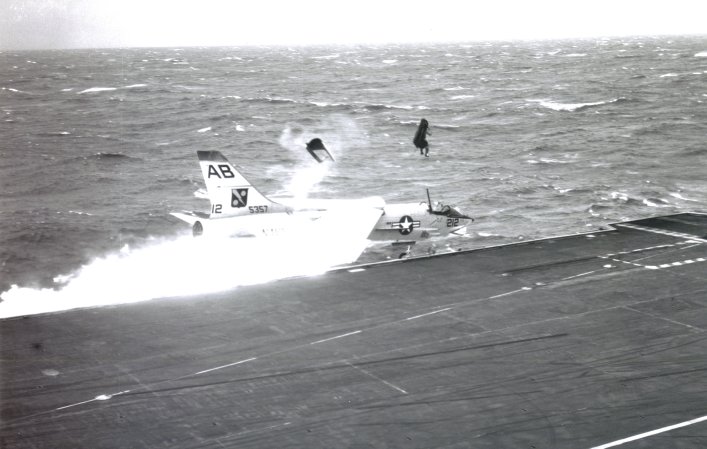
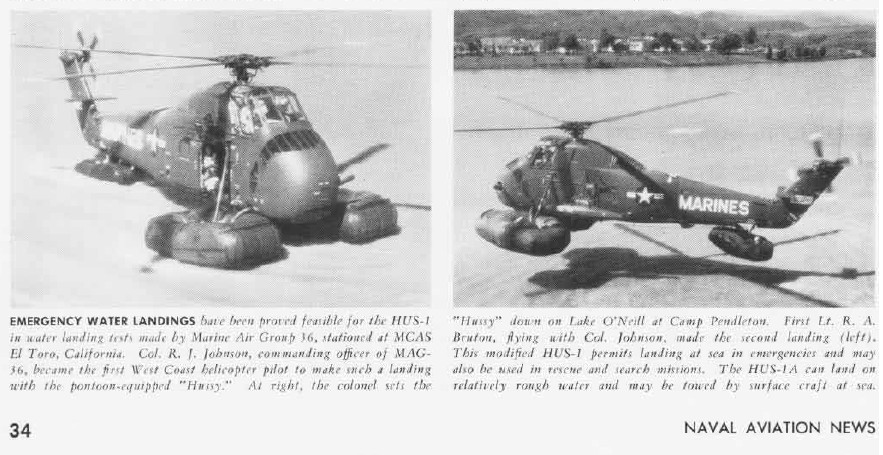

Zumwalt's Sea Control Ships: he was right all along
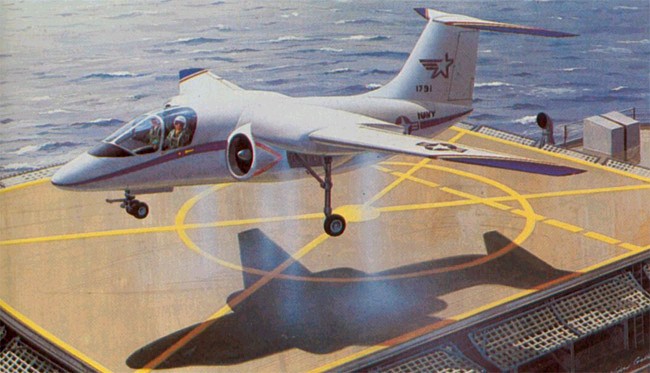
I guess we're playing catch-up...Zumwalt had this figured out long ago with his sea control ships (SCSs) in the 1970s...we need LOTS of ships with LOTS of aircraft to control the sea.....smaller aircraft carriers and V/STOL or STOVL seaplanes threatened the BS egomaniac aircraft carrier "mafia" who wanted and still want to do things the old warmed-over WW2 way and as soon as he was gone they went back to the crap handfuls of overly large aircraft carriers that can't put up enough or the quality of aircraft we need to control the sea...
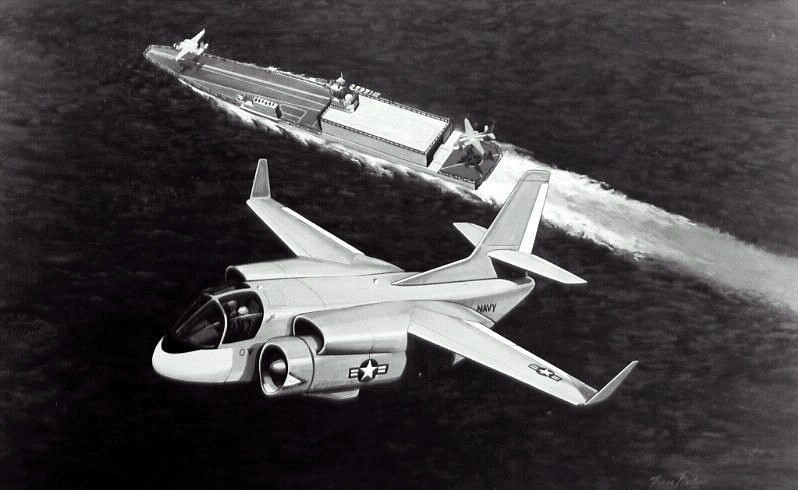
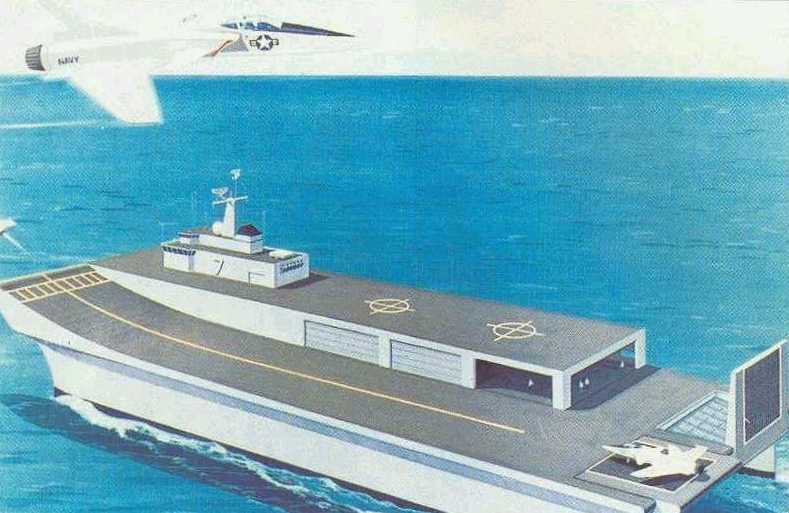
This web site below has an AMAZING documentation of the V/STOL sea control ship effort....
www.secretprojects.co.uk/forum/index.php?topic=103.75
The Grumman 698 tilt-engine V/STOL aircraft would have been a great way to accomplish multiple missions without even needing a SCS small aircraft carrier. ASW, AEW, ASuW and land attack delivering SEALS or marines could have been done from the fantail landing pads of existing cruisers, destroyers and frigates at far greater speeds, ranges and combat power than the current slow and short-ranged ASW helicopters now in use. The problem is egomaniac moron marine rotorheads opted for the V-22 flying death trap when we could have had 500+ mph 698s.
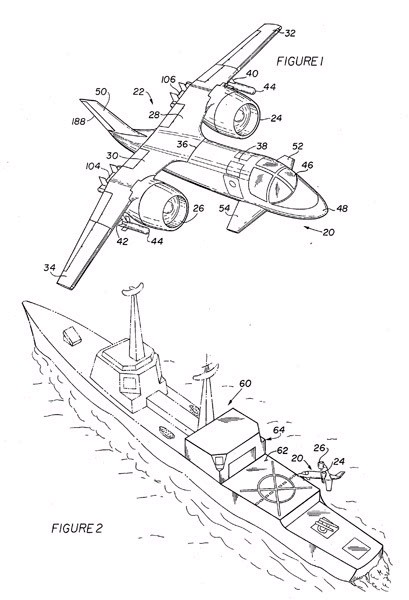
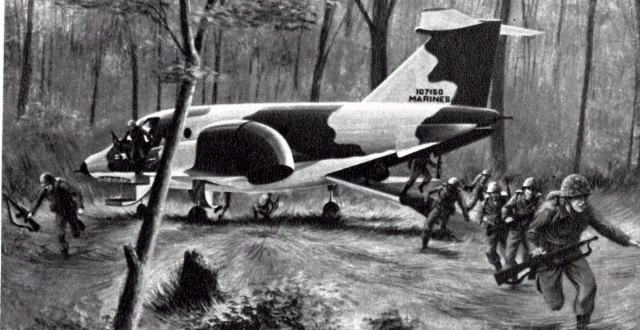
http://findarticles .com/p/articles/ mi_qa3897/ is_200306/ ai_n9262064/ pg_1
The last frontier: VTOL
Flight Journal, Jun 2003 by Robert Kress
The Ups and Downs of Vertical Takeoff and Landing
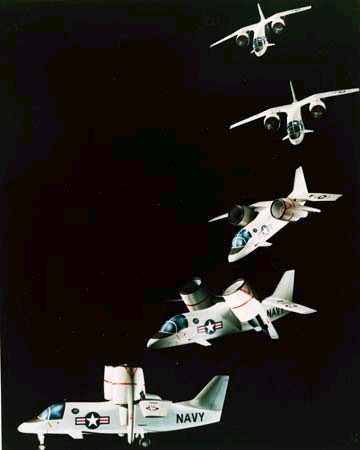
This is my insider's look at the sometimes frustrating world of creative aerodynamics and the difficulties associated with getting a new design concept adopted. Two decades or so ago, Grumman had an idea that we thought would fill a national need, but it was not to be. Politics doesn't always understand the rationale behind technical progress. Today, the idea in question is still viable. The national need for it is still unsatisfied. So, this old engineer soldiers on.
Since the laws of physics refuse to bend for anyone, we engineering types are reaching the point of diminishing returns with much of our design work. For instance, the progression from the Wright Flyer to Spads to Mustangs to Tomcats represents enormous strides, but since the F-14/F-15-type aircraft came on the scene, we've been bumping our heads against technological ceilings. Does the absolutely state-of-the- art F-22 represent the same progression as we saw from Mustang to F-86? Of course not. Does it offer anything hugely different from its predecessors? No, it doesn't. It does, however, improve the breed, but it doesn't redefine it.
So, have we seen all there is to see with respect to the development of flying machines? Here, too, the answer is no because at least one frontier hasn't been efficiently conquered: vertical takeoff and landing (VTOL). VTOL represents the last frontier primarily because, although we've poked our toes into those aeronautical waters, with the exception of helicopters, we really haven't waded all the way in and learned to swim. For the most part, we have retreated to the shore when we found the going tougher than we expected.
VTOL
A ton of VTOL aircraft (not helicopter types) have been invented and some were even tested as full-scale prototypes. Seth Anderson of NASA-Ames constructed a wonderful "pinwheel" chart, later named the "wheel of misfortune," that presented all of the VTOL configurations tested up to about 1980 (there haven't been many since then). Some flew without crashing. Some were inventors' dreams. Some attempted to defy the laws of physics and suffered the consequences. However, with the exception of the Harrier and the XV-15 (V-22 prototype), nothing came of them.
WHY?
When you study most of these aircraft knowing what we know now, it's obvious that they were technically flawed. The most obvious problems included inadequate control authority in hover, mechanical complexity, poor structural integrity, erratic stability and control during transition and that they had to try to lift too much weight with too little thrust.
It's important to understand the history of VTOL aircraft in terms of the principles of aerodynamics. Thrust-per-shaft- horsepower in VTOL aircraft is determined by the amount of horsepower applied to the tube of air being accelerated by the powerplant. Power could come from a reciprocating engine ducted fan, a jet engine or a turbofan. As long as the horsepower is there-it could be generated by a rubber band-the column of air doesn't care.
At the low-disc loadings typical of helicopters (that is, the weight the disc is required to lift measured in pounds per square foot of disc area), the thrust produced per input-shaft horsepower is very high. Aircraft in this class lift large loads, have long hover duration but not enough downwash to chew up the ground as a jet does. Their speed, endurance and ceiling are generally much lower than the higher-disc- loading vehicles. A good modern example of low-disc loading was the XV-15 (which became the V-22 Osprey). At the other end of the disc-loading spectrum is the low-bypass turbofan AV-8 Harrier. This thing is really loaded! The Harrier made the concept work but not without paying a price: high fuel flow in hover. Airshows excluded, Harrier pilots don't want to hover for long, or they'd better hover right over to a gas station.
If all of the VTOL concepts, those that have been proposed and those that have flown, are compared, it would be noticed that there is a distinct gap between the lightly loaded birds and those that carry a lot of weight on a small disc. This gap indicates that little effort has been expended on developing VTOL turbofan transport-type aircraft, with one exception-Grumman' s Design 698 Tilt Fan VTOL. The goal of Design 698 was to fill this gap with a Learjet class, high-speed, long-endurance and high-altitude aircraft that would also have USN surface-combat applications. A lot of work was done on the 698 and, considering that the niche for which it was designed still exists, more needs to be done on this and other promising turbofan VTOL concepts. If we could just get our VTOL act together, the payoff could be huge in terms of highly versatile civil and military aircraft.
Grumman started blasting away at the last frontier in the early '70s. I was the primary player along with a couple of other fugitives from the lunar module (LM) program. Our first concept was the Nutcracker.
IN THE BEGINNING THERE WAS THE NUTCRACKER
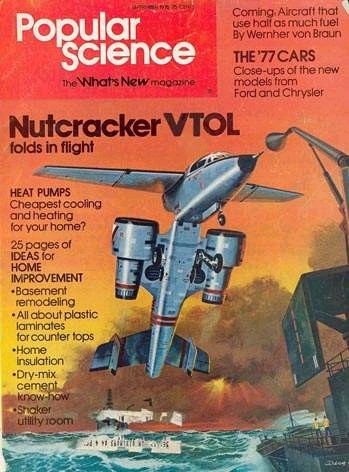
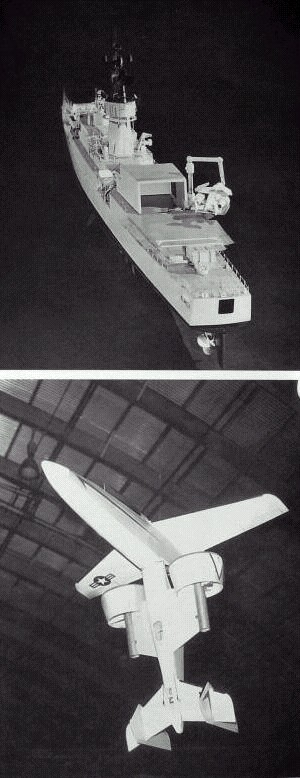
Another radical concept was to have a V/STOL aircraft like the bending fuselage "nutcracker" hover next to the ship and be snatched by a crane and brought on board.
o fully savor the essence of the Nutcracker, look at the photo above. If you don't exclaim, "What is that?" you're one of the few who don't. It is exactly what it appears to be:
* a VTOL aircraft that folds in the middle;
* a VTOL aircraft attempting in-flight docking on a destroyer.
Regardless of how weird it looks, the space guys had a reasonable aircraft concept. The VTOL breaking in half cured all of the ills associated with the "tail-sitter" VTOLs (they had to reverse into a landing tail first), which were:
* poor visibility for pilot;
* wing stall during transition when the wing had to plow through the high-angle-of- attack regime, usually with serious stability and control problems;
* when they are hovering, they present their entire profile to the wind, so gusts can blow them all over the place; this makes precision maneuvering difficult, particularly at sea and over oil rigs.
A benefit of the seemingly strange configuration was that the Nutcracker could make conventional takeoffs and landings with the fuselage unbent. We had created a "perch sitter"essentially, the Nutcracker came in like a hovering hummingbird and plugged into its landing nest.
The Nutcracker was not small. It was designed for antisubmarine warfare (ASW) and ocean surveillance/ attack roles. On hot days, takeoff gross weight (TOGW) was 21,500 pounds. For attack, the Nutcracker could carry one harpoon missile. Powered by two cross-shafted GE TF-34 engines, it could hit 500 knots and 45,000 feet and it had a 400nautical- mile-radius of action. The cross-shaft provided engine-out control in transitional flight. We had put a lot of thought into our strange-looking creation.
We conducted extensive hover and conventional- flight radio model tests and realistically simulated the docking procedure. To answer questions about how the tail would work while being beaten to death by the engine blast, we tested an A-6 stabilizer behind a Hamilton Standard T-55 Q-fan engine.
THE USN WAS LOOKING FOR ANSWERS
Between 1973 and 1975, substantial USN/NASA activity was devoted to design and to small-scale testing of what were known as lift-fan vertical/short takeoff and landing (VSTOL) concepts. In 1976, CNO Adm. James L. Holloway III announced a bold new USN program that would lead to two new types of VSTOL aircraft. A "Type A" utility class would be developed first, and a "Type B" fighter class would follow. The object was to deploy a large number of combat aircraft on various combat ships (destroyers, etc.) rather than to cluster them all on carriers. This would make air operations more flexible, and it would be harder for the bad guys to nail a lot of airplanes at one time.
A single Type A aircraft would replace a bunch of conventional carrier aircraft. The grand plan was that one basic VSTOL airfrarne would replace E-2, C-Z, S-3 and EW types and the USMC H-46 helos. Obviously, this would be a very big ball game.
And where was Grumman while all of this was going on? We were working on a "perching" bird that was as simple as all get out but useless for the tasks at hand because it needed a special apparatus to land. It was time to change direction.
ENTER SON OF NUTCRACKER
At Grumman, our first objective in VSTOL design was always simplicity, and we asked ourselves how we could retain the simplicity of Nutcracker while getting it off its perch. We had to make it compatible with ship decks without having the special gear needed to land it. The answer came when we reflected on the Nutcracker's control power, which was very large about all three axes owing to the long tail length of the surfaces immersed in the fan blast. We designed a configuration in which tilt nacelles rotated about the wing's leading edge and had horizontal and vertical vanes in the fan blast. These were hung as far below the airplane's center of gravity (CG) as they could be and still use a reasonably long landing gear.
Our initial calculations indicated that we could more than meet USN control power specs, but we had to prove it. To turn theory into reality, we built a full-scale "iron monster" test rig next to the Bethpage runway. Essentially, it was a huge bed frame with a Hamilton Standard T-55 Q-fan mounted horizontally with control vanes (almost like Venetian blinds) in the jet blast at the proper locations. Our estimates of vane lift and drag were verified by this rig's performance, but we certainly killed a lot of grass in the process.
We kicked around a lot of names for the new design, and "short-tailed Nutcracker" was just too much to say easily; besides, it sounded like an exotic bird. We settled on Design 698, which existed in several configurations. The earliest version of 698 had a canard up front that was changed to a tailed configuration when we discovered that the fan cowls acted like ring wing canards. This was a fortuitous turn of events that resulted in high-speed airflow through the cowls, making the cowls themselves act like endless wings.
THE TILT-FAN ROADSHOW
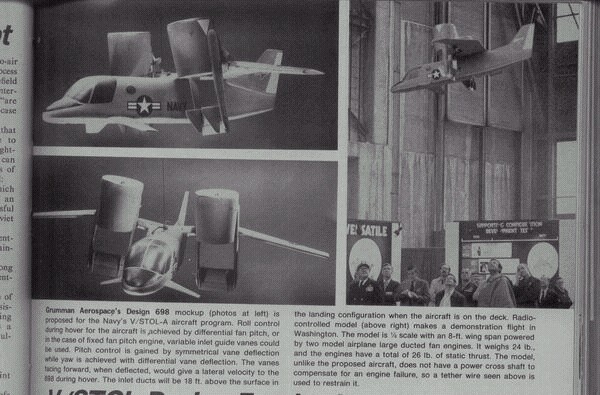
We at Grumman had a late start in the Type A VSTOL ball game, but we launched an intensive and rather different promotional campaign. A large, radio-controlled, tethered, hover model was constructed by Nick Ziroli of model fame and was demonstrated at every government facility that would let us on its grounds. The tether was there to save the model in the event of an engine failure, which happened only once in roughly 100 demo flights.
While the airplane was flying, a "barker" provided a colorful commentary on what was going on and kept up the excitement level up. We had everything but dancing girls. The whole thing was known as "Baron von Kress flying circus." Among other places, the "circus" went to NASA-Ames, the Naval Air Development Center and the Naval Air Test Center.
Our highest-profile demonstrations were when we rented the Butler Aviation Hangar at Washington National Airport for one week and flew three demonstrations every day (preceded by the usual barker on the PA system extolling the virtues of our design). Grumman bussed military and civilian personnel from all over O.C. and charged them 50 cents a bus ride to keep it all legal. Hey, when you market at this level, you have to stretch the boundaries if you expect to be noticed.
Perhaps the strangest 698 flight demo was the one in Grumman Calverton's huge anechoic chamber that deadens sound. As I started my preflight talk, I realized that there was absolutely no sound feedback, and I couldn't hear my own voice; I wasn't sure whether I was making any sound at all. I was more unhinged than usual, and the model sounded as though it were rubber-powered instead of powered by two screaming model engines.
DESIGN 698 EMERGES
As is the case with many government programs, the Type A VSTOL faded from view, but that didn't faze us in the Nutcracker suite. We continued as if nothing had happened, and in the process, we refined the 698's design.
* The canard became a horizontal tail.
* A simpler and more producible way to hang the engines was invented; they were mounted on the ends of a wing leading edge cross-member that could be rotated.
* Strakes added to the lower fuselage were carefully designed with respect to angle and length to effectively control the downward blast that bounced off the ground.
* Vertical vanes were installed in the jet blasts for roll control; they replaced the variable inlet guide vanes that had been added earlier for thrust modulation.
* A new landing gear was designed and optimized for operations off rolling, pitching carrier decks.
From about 1978, we concentrated on putting high-performance surveillance/ attack aircraft on surface combatants. Also, the idea of a small Learjet-class VTOL seemed very attractive. We envisioned a 20,000-pound- class aircraft with two TF-34 turbofans. At the time, there was skepticism about the 10,000-pound- thrust output of the TF-34s for the application. Today, one can buy CF-34s rated at 14,500 pounds, which will shortly be upgraded to 18,500.
698 FLIGHT DEMONSTRATOR PROGRAM
By 1978, there was enough interest in the project for us to obtain USN R&D funding. A vigorous program funded by NASA and Grumman was set in motion; it built on the progress already made in 698 Type A work.
One interesting test involved piloted flight through transition by using a radio-controlled model on the end of a 50-foot whirling arm rig. The Grumman Research Department constructed an extremely light whirling arm that was inflated to 200psi for stiffness and had gossamer guy wires. Its function was to restrain the model's centrifugal forces without corrupting its mass and inertia. Nick Ziroli sat on a whirling chair and flew the model with throttle and vane control. The effects on Nick were the subject of much mirth; he survived, but he still walks a little funny!
The program's crowning achievement was the construction of a full-scale, 43,000-pound test model of the 698. It was tested in NASA Ames' 40x80-foot wind tunnel and was later the first unit tested in the new 80x120-foot test section.
WHAT'S IN THE FUTURE
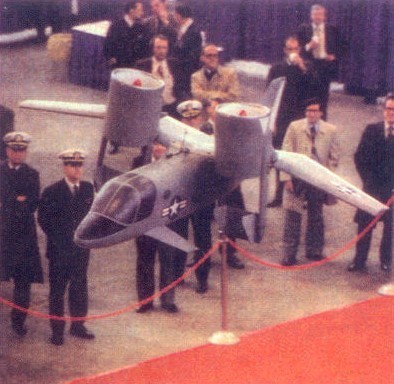
The full-scale Design 698 was exhibited in the Great Hall at the 1981 Paris Air Show. It had completed more feasibility and proof-of-concept testing than was usual; it had reached the point at which a flight demonstrator would be a reasonable proposal, and much of Grumman's work focused on that.
Also, at the Paris Air Show, however, was the XV-15 tilt rotor, and it flew morning and afternoon shows with all sorts of precious human cargo on board. Predictably, the proposal to build the JVX won strong NASA support. The 698 was perceived to be a threat to the development of the JVX (later known as the Osprey). This aircraft was for USMC use, and our design did not fit the operational missions envisioned because its jet blast was too fierce. No government thought was given to anything other than the marines' needs, even though there were lots of obvious other VTOL applications.
Nevertheless, Design 698 shriveled "like a salted slug," as P.G. Wodehouse once put it. Flashing ahead to today: maybe now, with the Osprey's poor track record and the tilt-rotor concept behind us, it is time to move forward with a Nutcracker variant. The VTOL niche is still vacant, and the Design 698/Nutcracker technology is still there.
Who would build a new VTOL design? Not Grumman, obviously; it has long gone. Still, there is money to be made and a service to be rendered to the country. Who would profit? Not me. But, you know the saying, "Old engineers never die ..."? Well, you can't get us to shut up either!
Our 2 cents is we need to make "SCSs" from container ships so we can keep costs down and actually get enough...and employ seaplanes from every other ship we have before its too late.
We must GET MORE AIRCRAFT (IT) and DRIVE ON (GIDO) out to sea by using ALL our surface ships as platforms and as soon as we can, our submersible ships AKA submarines. The threat since Zumwalt's days has increased at least by a factor of 100x and the anti-progress large aircraft carrier mafia must be over-ruled before we have a national tragedy at sea.
The first question we have to ask is, what do we have to work with "off-the-shelf" since the SCS experience shows the Navy/Mc cannot develop aircraft from-scratch in a timely manner?
FireBoss 600
AirTractor of Texas offers turboprop crop duster float planes that would make excellent seaplane fighters if their wings were made to fold...
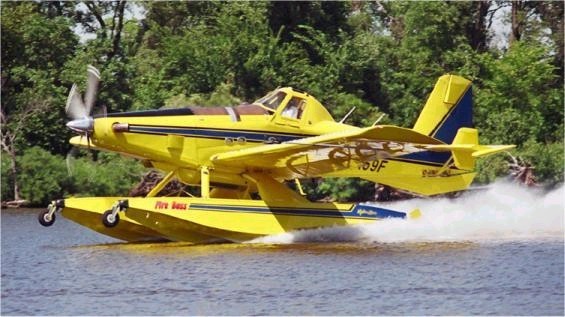
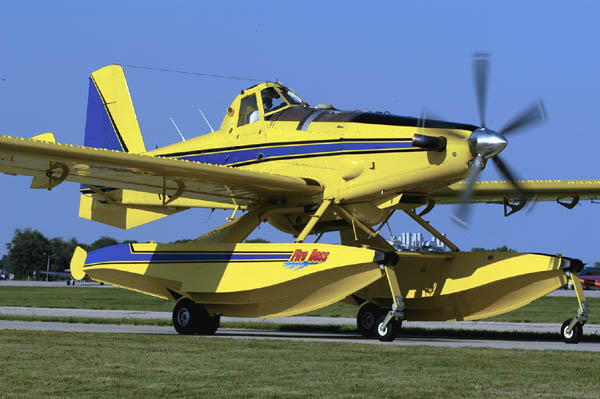
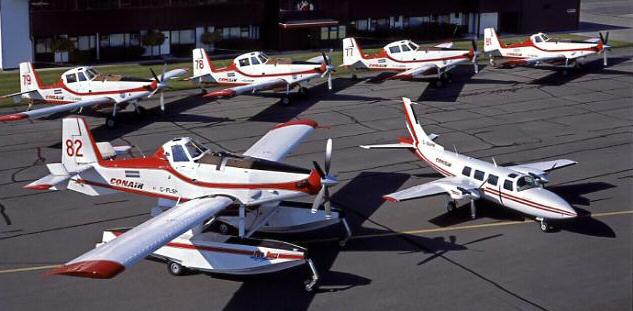
The Centaur seaplane from England folds and could fit into USN special operations submarine watertight capsules.
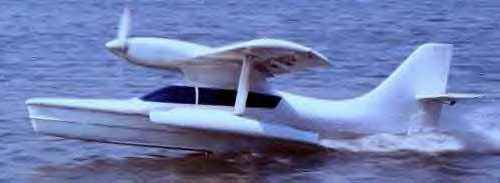
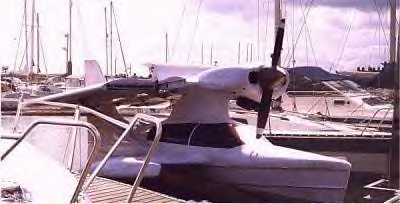
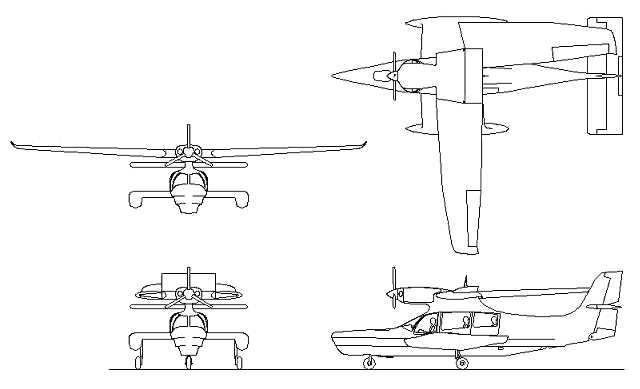
F-35B Lightning II STOVL
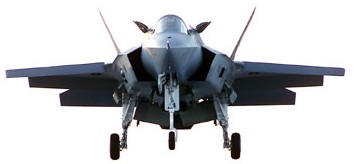
How much space do we have on USN destroyers and cruisers? (LOTS)
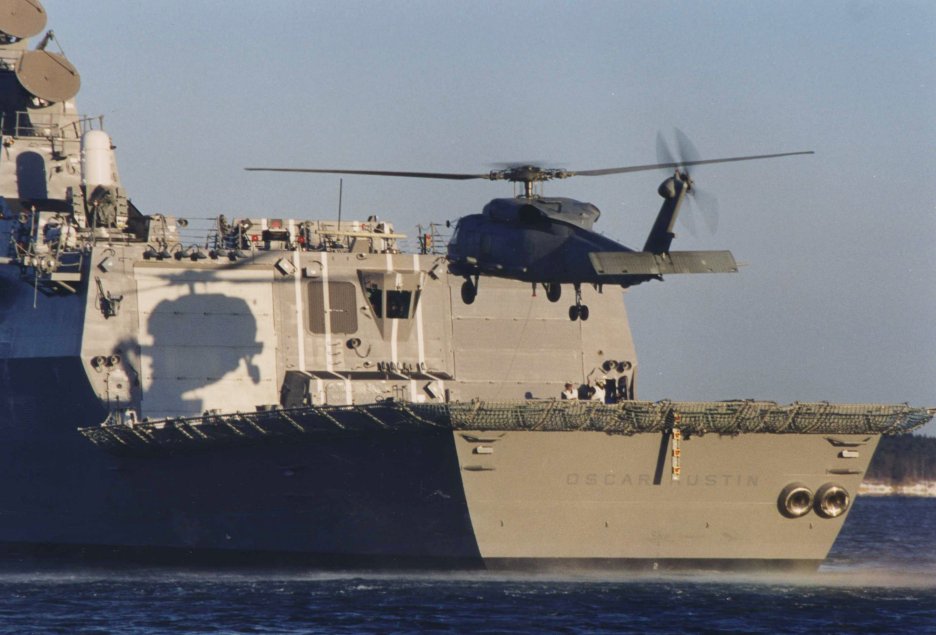
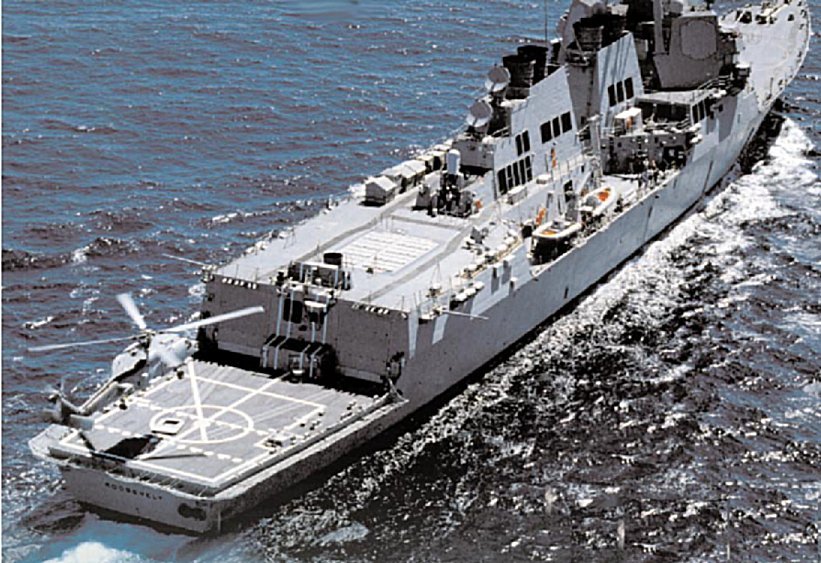
Ticonderoga class cruisers
![]()
![]()
![]()
Non-Aircraft Carrier Seaplane Defense of Surface Ships
Sub-National Conflict 101 FUBAR: We shell Somali rebels with 5" popguns without spotter aircraft
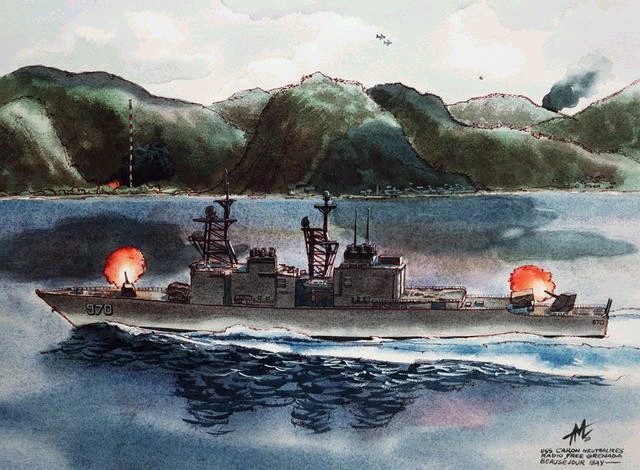
PROBLEMS
1. rebels hiding in closed terrain using vegetation to keep inept narcissist government troops on foot/wheeled trucks from reaching them (dummies need to be in M113 Gavin light armored tracks with low ground pressures)
2. With no nearby overseas bases we have no sexy unarmored fighter-bombers nearby to try to strike the hiding rebels and even if we did, they too fly and too fast to spot the enemy and there's no one to hold their hand to shine a laser beam or give a GPS coordinate to effect SODAS (Stand-Off, Directed Air Support)
3. our multi-billion dollar stupor carriers are too whatever (you fill in the blank: "expensive", "too big" ie; draw too much water, too few in number ie; maybe we should have affordable aircraft carriers made from container ships etc.) to be offshore doing this gunboat diplomacy
SOLUTIONS
1. Imagine instead that instead of or in addition to the slow, loud, short-ranged SH-60 SeaHawk ASW helicopters on board U.S. Aegis destroyers/Tico cruisers we had a TURBOPROP (can burn ship's DF-5 fuel if filtered carefully) floatplane like a two-seat FireBoss with back-seat observer/sensors that could fly low enough with agility/armor protection actually FIND AND MARK THE ENEMY and spot for puny 5" guns so they can HIT to have effect...or...
www.geocities.com/usnavyindanger/seaplanefighters.htm (this web page)
2. the FireBoss type seaplane BOMBS the rebels with its own bombs, rockets, missiles and gunpods....(Maneuver Air Support) or...
3. We have an Iowa class battleship's 16 inch guns with plenty of high explove power bombard rebel positions with the help of the Fireboss-type seaplane to spot for them
We were better equipped in WW2 than we are today to render naval gunfire support...some "stupor power".
Artwork above is of a 5-inch gunfire mission during the 1983 Grenada invasion against a clearly visible point target. Too bad rebels are not such easy strawmen to hit!
http://news.aol.com/topnews/articles/_a/us-hits-militant-base-in-somalia/20070602023009990001?cid=2194
Updated:2007-06-02 06:05:30U.S. Hits Militant Base in Somalia, Officials Say
By MOHAMED OLAD HASSAN
APMOGADISHU, Somalia (June 2) - At least one U.S. warship bombarded a remote, mountainous village in Somalia where Islamic militants had set up a base, officials in the northern region of Puntland said Saturday.
The attack from a U.S. destroyer took place late Friday, said Muse Gelle, the regional governor. The extremists had arrived Wednesday by speedboat at the port town of Bargal.
Gelle said the area is a dense thicket, making it difficult for security forces from the semiautonomous republic of Puntland to intervene on their own.
A local radio station quoted Puntland's leader, Ade Muse, as saying that his forces had battled with the extremists for hours [EDITOR: "even" AK47 vs AK47 on foot] before U.S. ships arrived and used their cannons. Muse said five of his troops were wounded [EDITOR: bullet sponge paradigm], but that he had no information about casualties among the extremists.
A task force of coalition ships, called CTF-150, is permanently based in the northern Indian Ocean and patrols the Somali coast in hopes of intercepting international terrorists. U.S. destroyers are normally assigned to the task force and patrol in pairs.
CNN International, quoting a Pentagon official, also reported the U.S. warship's involvement. A Pentagon spokesman told The Associated Press he had no information about the incident.
"This is a global war on terror and the U.S. remains committed to reducing terrorist capabilities when and where we find them," Pentagon spokesman Bryan Whitman said.
"We recognize the importance of working closely with allies to seek out, identify, locate, capture, and if necessary, kill terrorists and those who would provide them safe haven," Whitman said. "The very nature of some of our operations, as well as the success of those operations is often predicated on our ability to work quietly with our partners and allies."
Puntland's minister of information, Mohamed Abdulrahman Banga, told the AP that the extremists arrived heavily armed in two fishing boats from southern Somalia, which they controlled for six months last year before being routed by Ethiopian troops sent to prop up a faltering Somali government.
"They had their own small boats and guns. We do not know exactly where they came from - maybe from Ras Kamboni, where they were cornered in January," he said.
Local fishermen, contacted by telephone, said about a dozen fighters arrived Wednesday, but Puntland officials said the number could be as high as 35.
The United States has repeatedly accused Somalia's Council of Islamic Courts of harboring international terrorists linked to al-Qaida and allegedly responsible for the 1998 bombings of the U.S. Embassies in Kenya and Tanzania.
The U.S. sent a small number of special operations troops with the Ethiopian forces that drove the Islamic forces into hiding. U.S. warplanes have carried out at least two airstrikes in an attempt [EDITOR: it means the fast sexy fighter-bombers failed to hit their targets] to kill suspected al-Qaida members, Pentagon officials have said.
British have already done it: Container Ship Conversion to Aircraft Carrier: Arapaho, SCADS and SkyHook
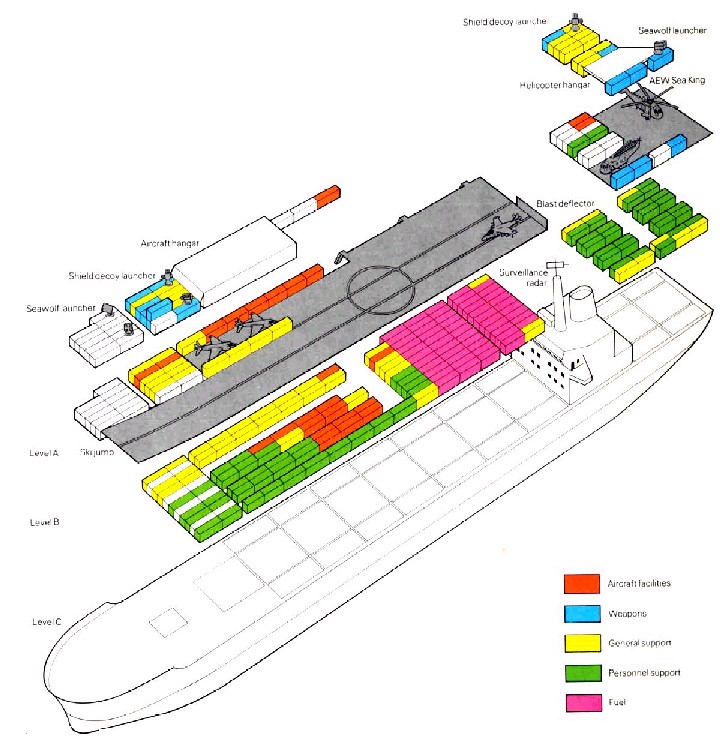
http://home.planet.nl/~alder010/Future/Future.html
Future and Specials
In the late 1960s the U.S. Navy had conceived the "Arapaho" programme, under which a container ship would be modified to permit testing of its suitability to operate special mission helicopters. The aim at that time was to allow a significant proportion of wartime convoy escort and sealane protection tasks to be performed by such ships, manned by USN reservists. The Arapaho concept involved an LPD-size flight deck 200 feet (61m) long and 64 feet (19.5m) wide, and a 4,000 sq ft (372m²) hangar large enough to accommodate four Sea King [amphibious] helicopters. The complete installation weighed 900 tons, and could be installed on a container vessel in less than 18 hours.
In 1982 such an installation was emplaced on the 18,000-ton Export Leander, and 178 helicopters landings and take-offs were performed. In the following year the Arapaho equipment was leased by McDonnell and installed by Camel Laird at Birkenhead on the 27,900-ton MV Astronomer (subsequently renamed RFA Reliant) for tests in the South Atlantic.
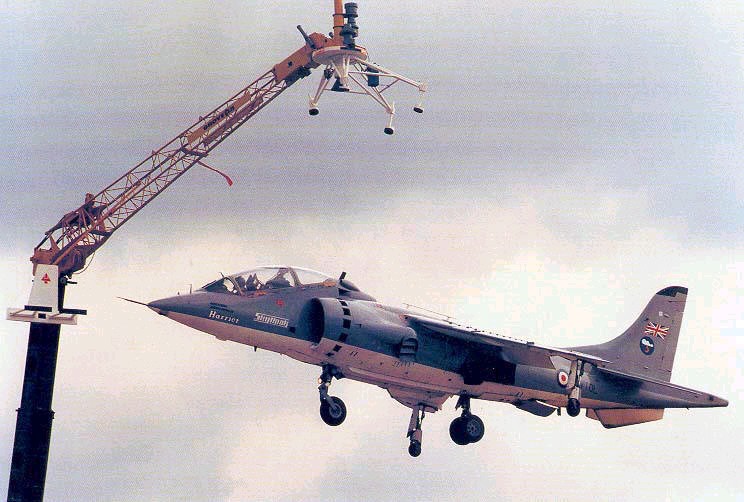
In efforts to exploit the sales potential of the Sea Harrier, which rested largely on its ability to operate from small, inexpensive ships, British Aerospace proposed the installation of ski-jump decks on commercial vessels, and the 'Skyhook' concept that would allow such aircraft to operate in the VTOL mode from ships without any form of aircraft deck.
'Skyhook' was invented by Heinz Erwin Frick (a BAe test pilot of Swiss descent) and the corresponding specification No.2104014 was filed with the British Patent office in 1982. Frick had been struck by the ease with which a Sea Harrier can be hovered with great precision, regardless of wind variations. It occurred to him that if this hovering accuracy could be combined with a space-stabilised 'Skyhook' on a ship, then it could provide the means for the aircraft to recover to a highly mobile deck. If the design of the ship precluded the use of a ski-jump take-off, then the aircraft could depart from the 'Skyhook', although its warload radius performance would then be much more limited.
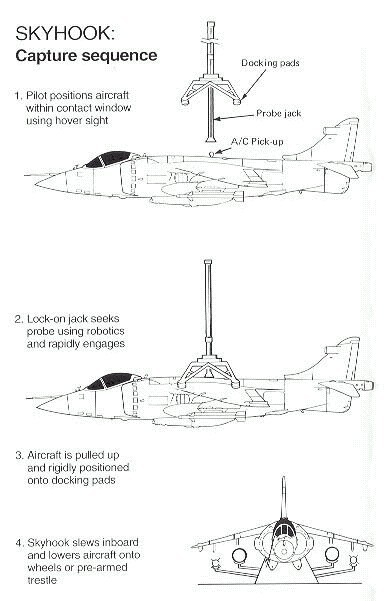
The concept required very little modification to the aircraft itself - simply a hoisting point above the centre of the gravity and possibly some local strengthening. If the operator wanted to refuel the aircraft while suspended from the "Skyhook", this would require modification of the fuel system, but it would still represent a minor expense. The major development task would be the advanced technology crane, presumably with an inertial platform in its base sending commands to a fast-acting hydraulic system that would keep the head of the crane moving linearly through space.
The computations for the crane system were based on the RN's 4,250-ton Sheffield class of destroyers, and the design allowed for sea state 6, to give uninterrupted operations in the North Atlantic for 97% of the time. Using a special form of display attached to the crane head to assist the pilot to hover accurately, it was concluded that the aircraft could easily be placed within the 'capture envelope' of the "Skyhook". Engagement was to be performed by a robot system, scanning IR-absorbent patches bonded to the upper surface of the aircraft around the pick-up probe, and moving the hook accordingly. An IR engagement-control system was proposed in order that the aircraft could be illuminated in night recoveries without affecting the pilot's night vision.
Despite the very limited warload-radius performance available from the "Skyhook" launch (which would be less restricted in the case of an AV-8B), the concept undoubtedly has some potential in the context of convoy protection and in providing an outer defensive perimeter by making use of radar picket ships around a conventional carrier. However, BAe estimated in the mid-1980s that the system would cost around $12 million to develop. The company also insisted on acting as prime contractor for "Skyhook", rather than granting a licence (eg, to a company in Japan, where the concept might have special attractions). In the event, UK-MoD showed no great interest and BAe was unwilling to invest its own funds in the project, so "Skyhook" has been filed away, at least for the present.
www.secretprojects.co.uk/forum/index.php?topic=1304.msg11194
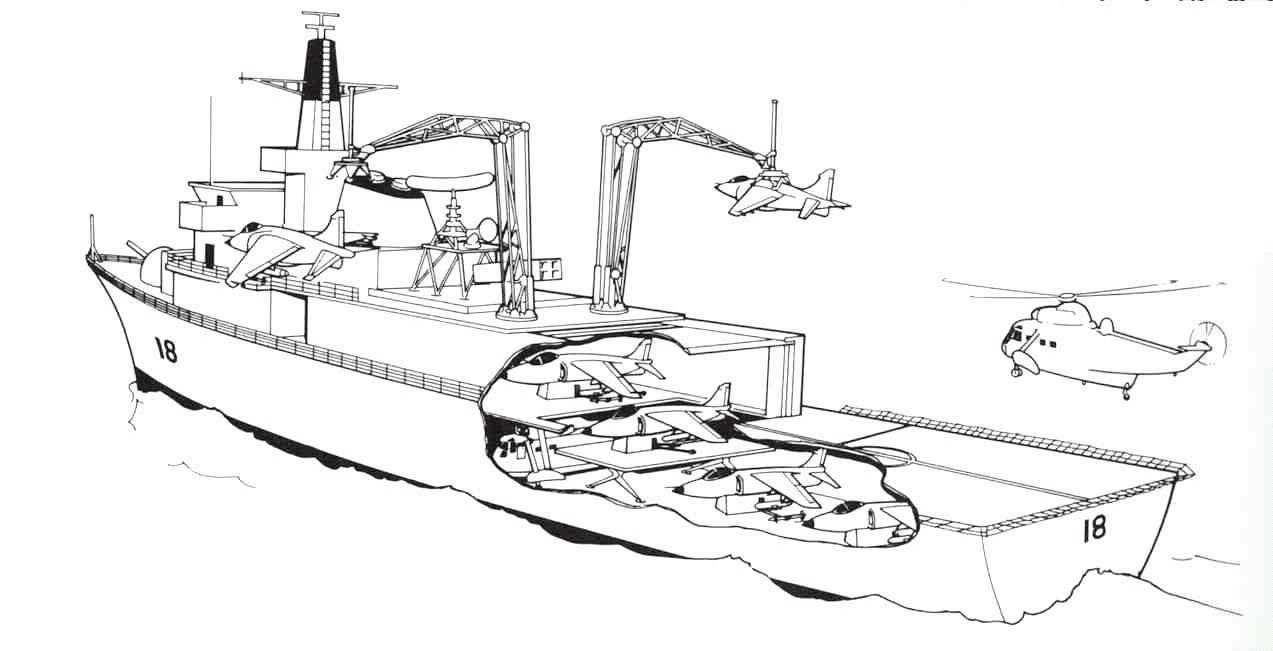
After the idea of SCADS BAe also came up with the SkyHook idea. The initial idea saw BAe propose two ships, one in their patent application (www.google.com/patents?vid=USPAT4523729&id=IcEyAAAAEBAJ&pg=PP2&dq=heinz+frick) and one used in publicity brochures.
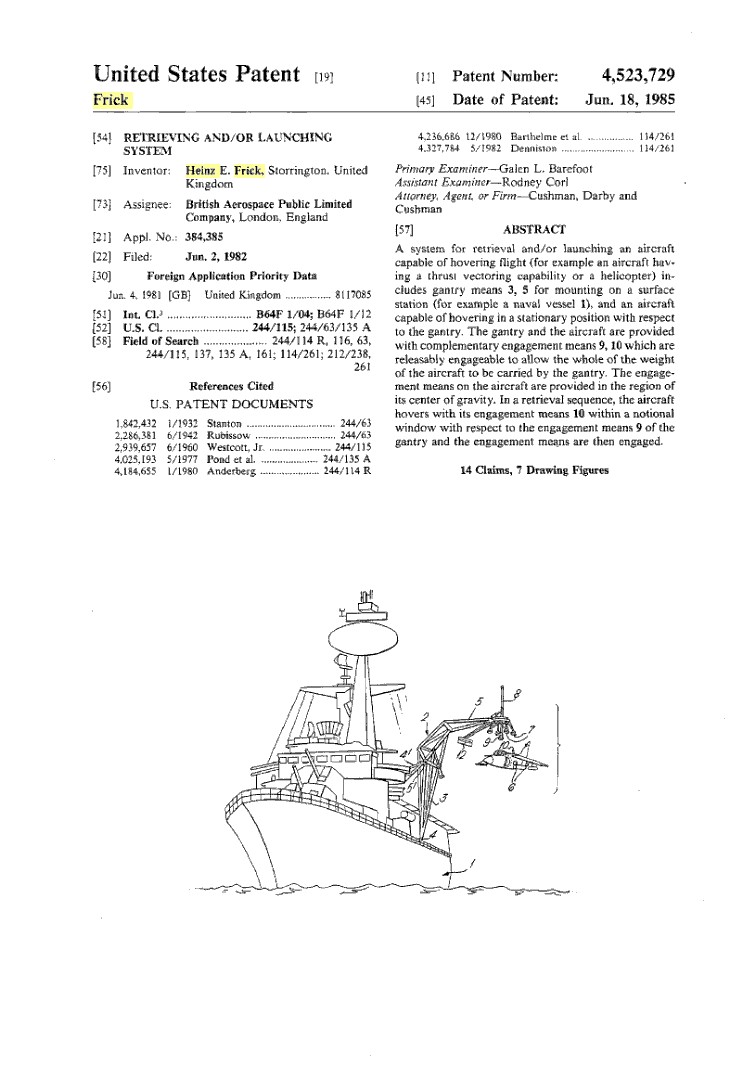
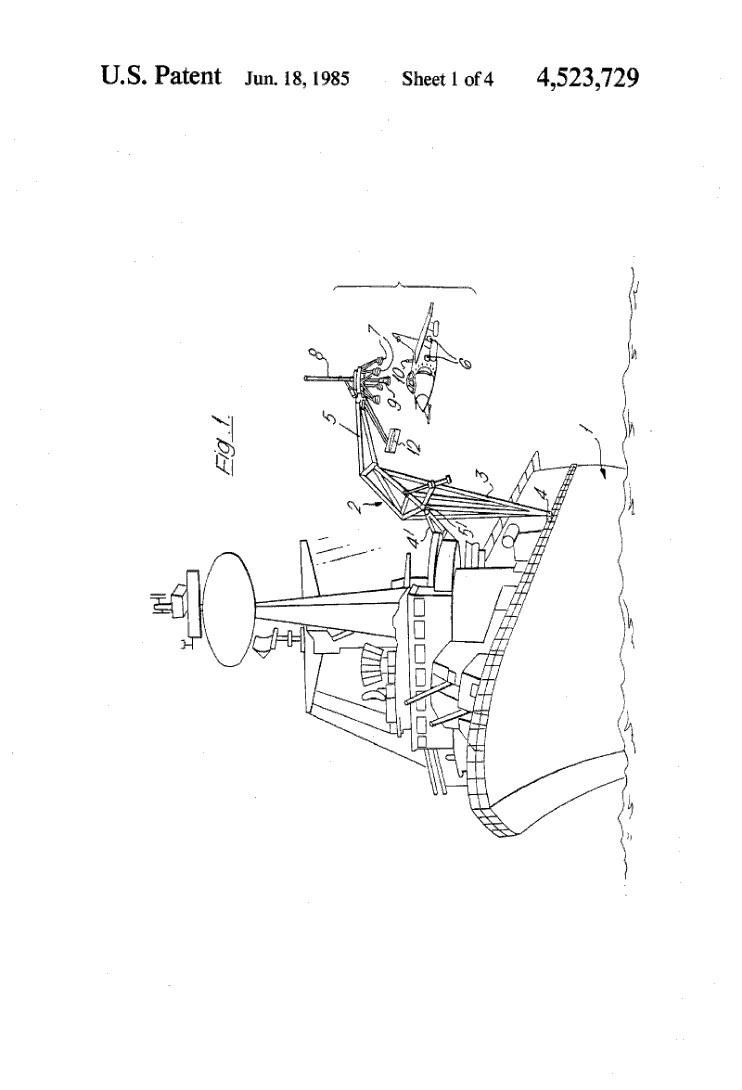
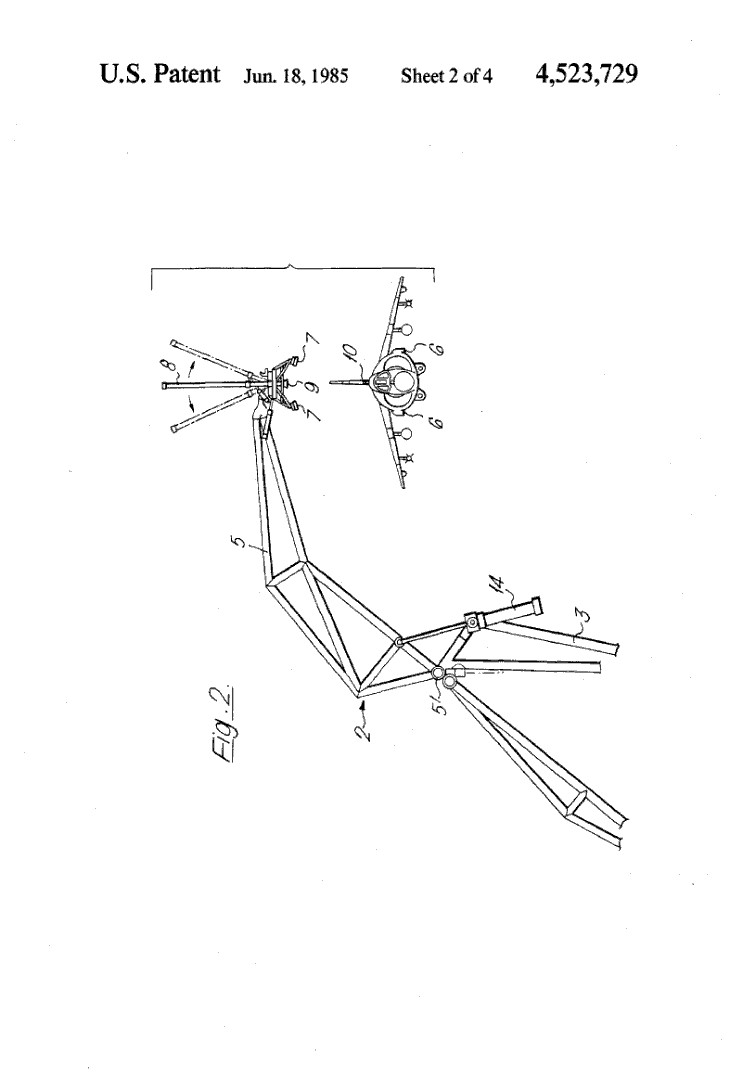
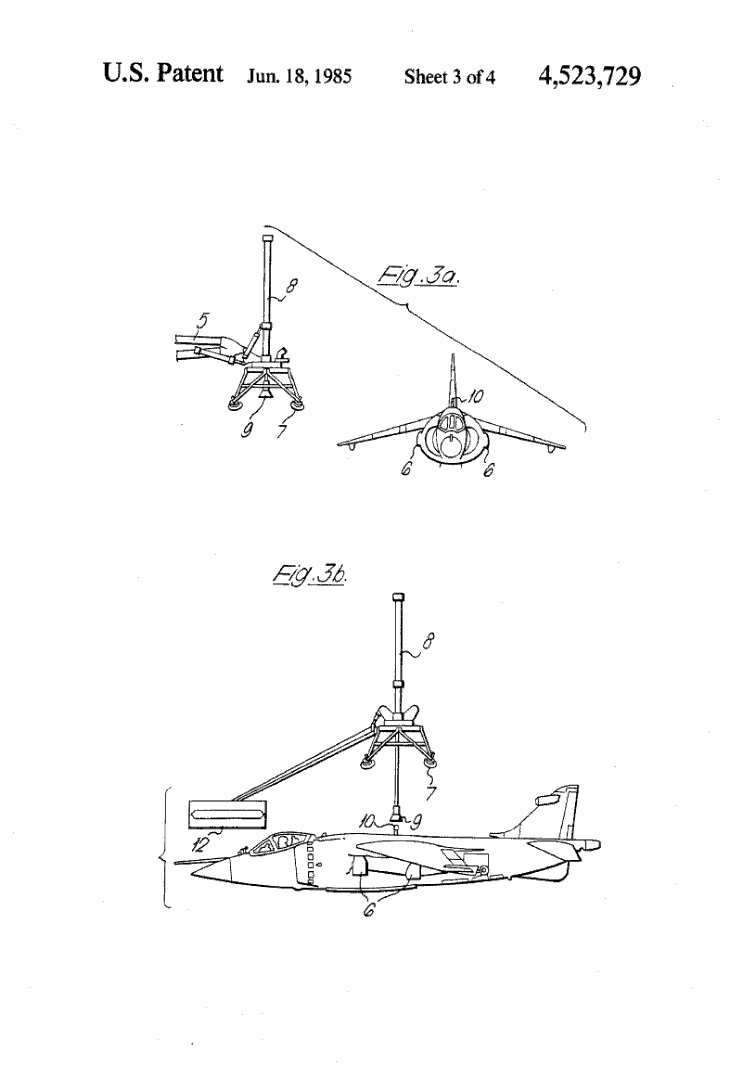
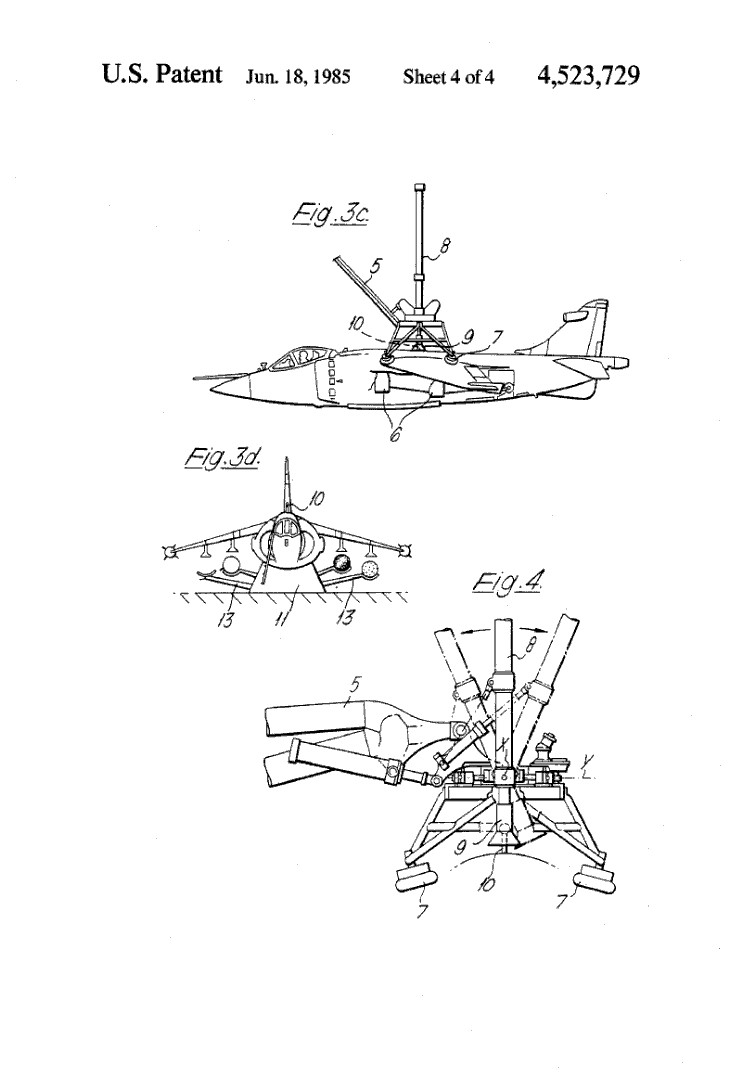
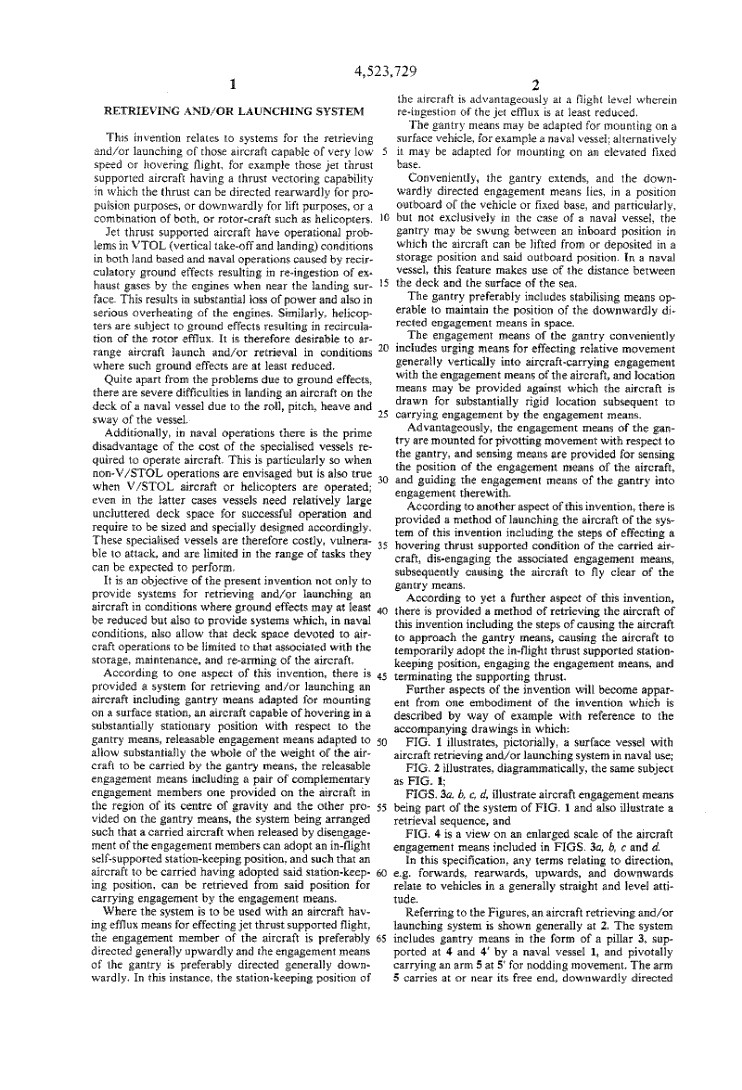
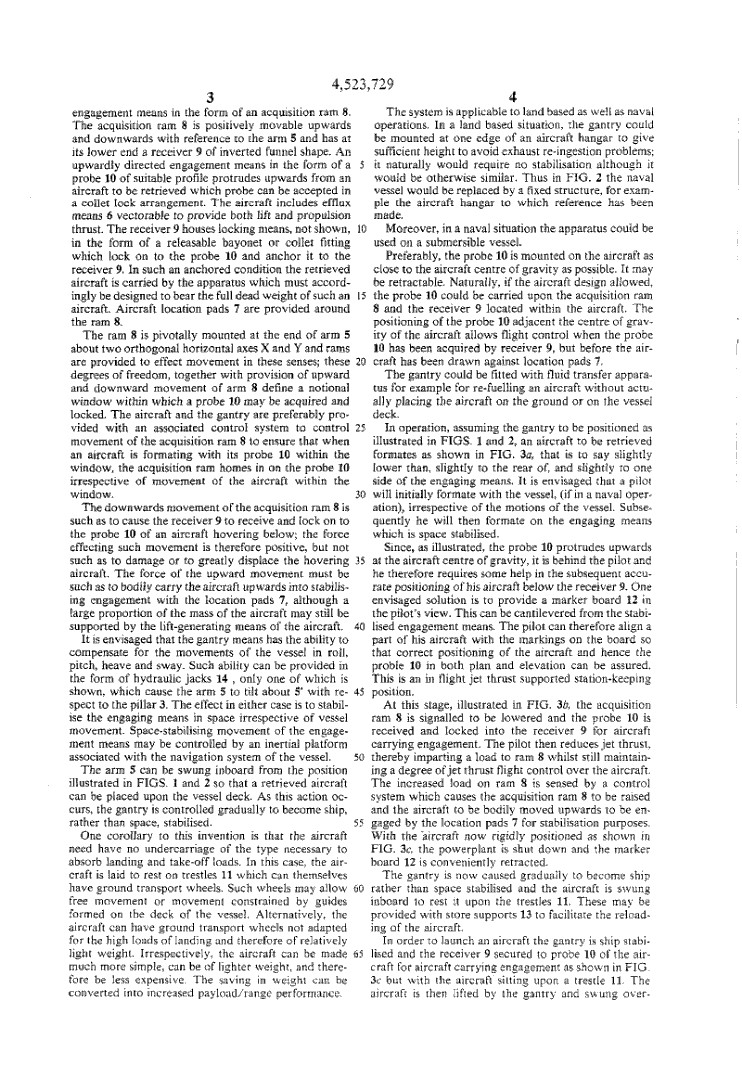
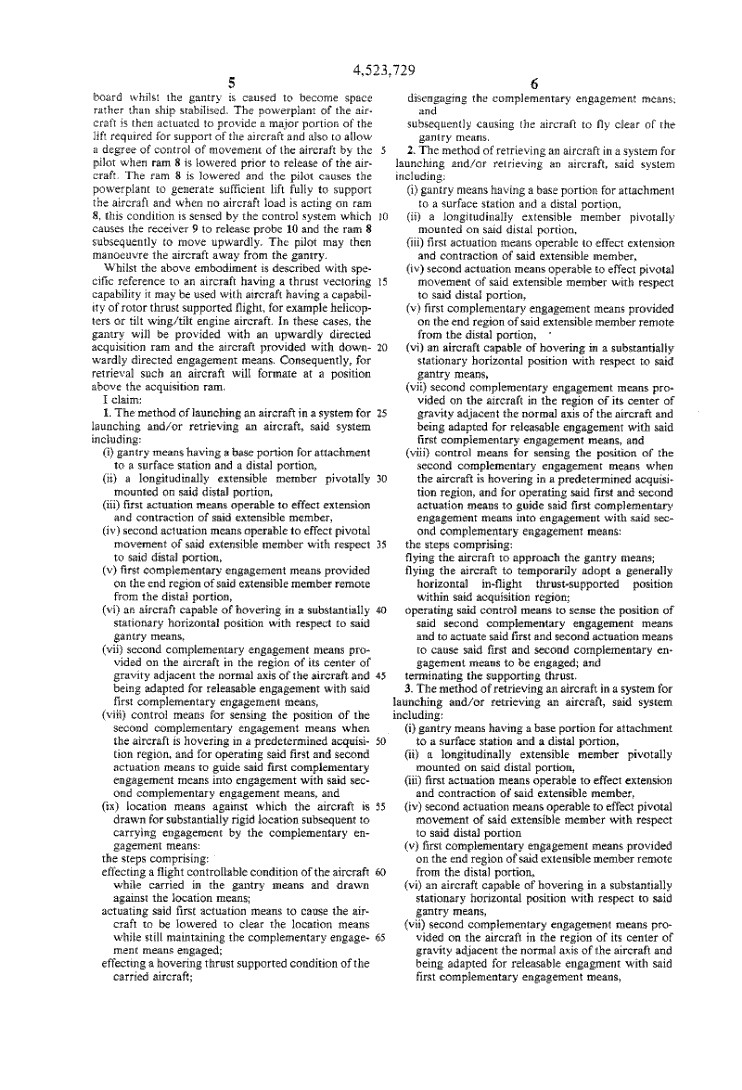
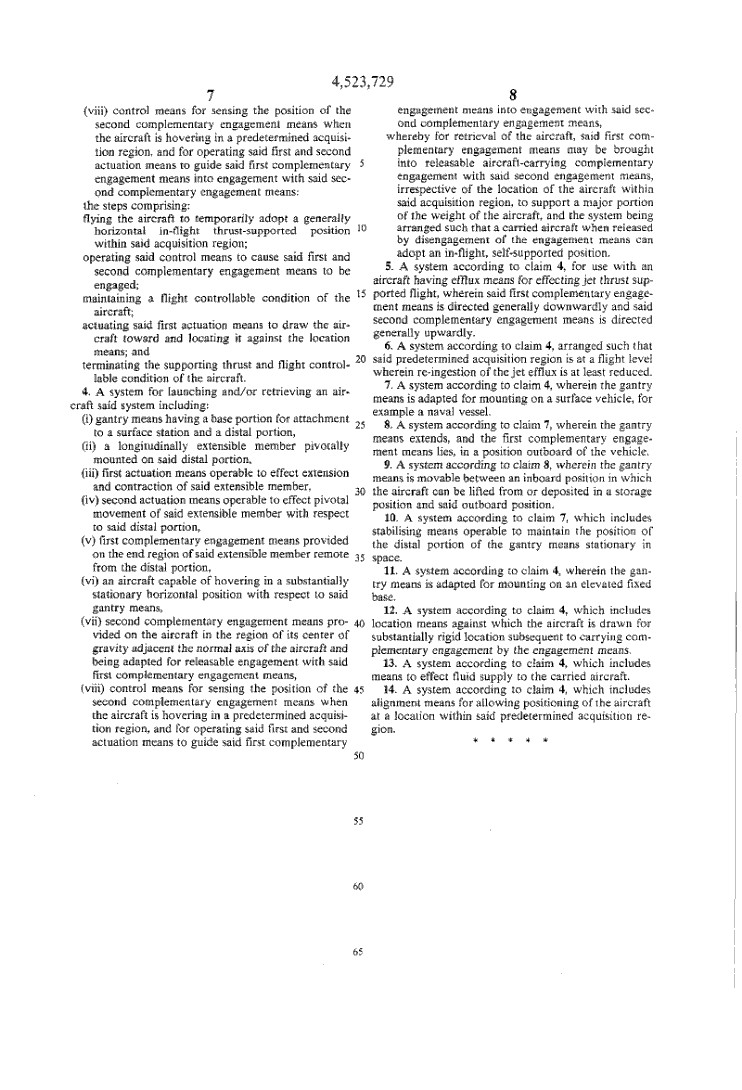
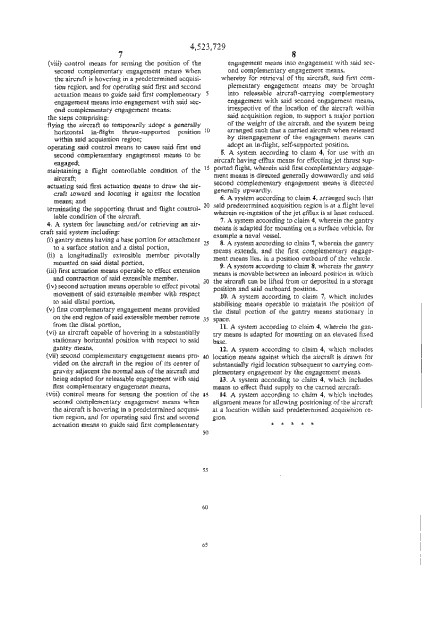
Both relied on SkyHook for take-off and landing, probably not too practical.
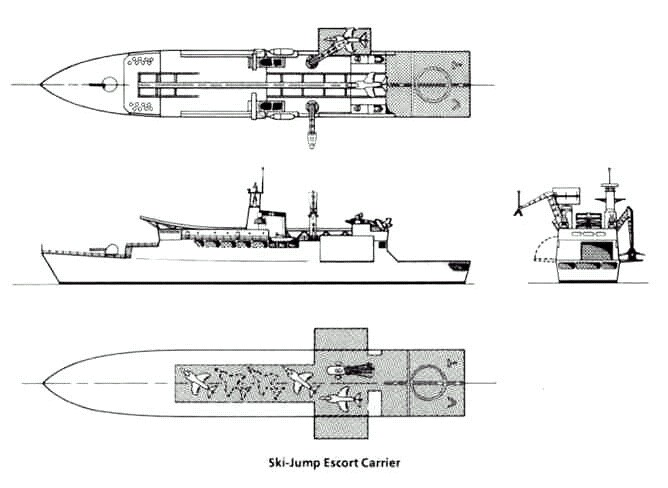
However, VT designed a "proper" ship around the concept and this featured a skeletal ski-jump atop the supersturcture for take-off. This increased payload, with recovery via SkyHook. Aircraft were stowed in a hangar with lateral doors for entry/exit, SkyHook being used to move aircraft to the launch position.
2x 25mm Sea Dragon CIWS, 1 medium gun, plus 16 x VLS missiles for defence.
5,200 tons diplacement, 416 feet 8in OA
45,000 shp = 26kts
5 x Sea Harriers, one helo.
The idea was to use the ship as a "forward base", allowing greater endurance in CAP patrols, with the aircraft returning to a large carrier for major maintenance. In other words, a naval version of the Harrier's land-based use of forward operating strips.
On Military Sealift Command (MSC) ships we could build entire aircraft carriers/seaplane tenders!
Strike Aircraft Cruisers: still a good idea, and they fit through the Panama Canal!
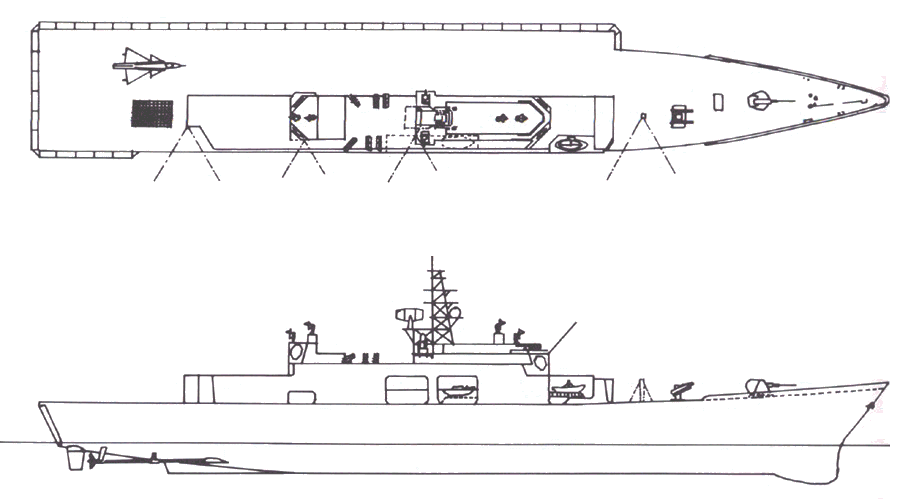
The "supercarrier" madness has placed our nation's maritime defense in jeopardy and bankrupted our Navy. We have less than a dozen large carriers that in time of war have to sail all the way around the tip of South America because they were made too large to fit through the Panama Canal. The Japanese in WW2 wanted to launch submarine seaplane fighter-bombers to take-out the Panama Canal...we have done them one better! WE HAVE SHOT OURSELVES IN THE FOOT BY MAKING SUPERCARRIERS THAT CANNOT EVEN FIT!
We have met the enemy.
He is US.
LARA 2: What Would a "Clean Sheet" Design for a Seaplane Observation/Attack Fighter Look Like?
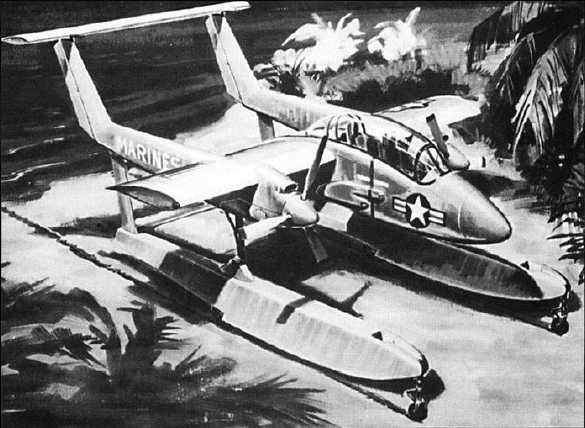
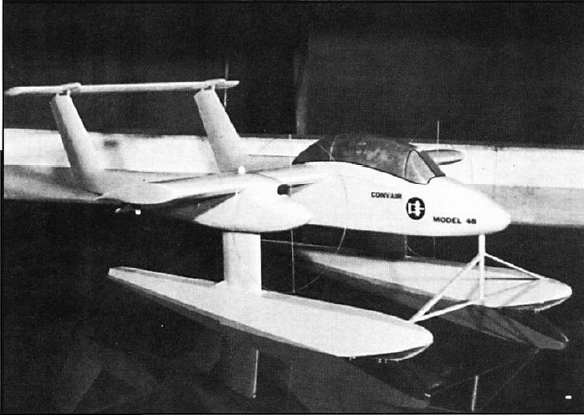
Skis Please: almost ANY aircraft can be a Seaplane
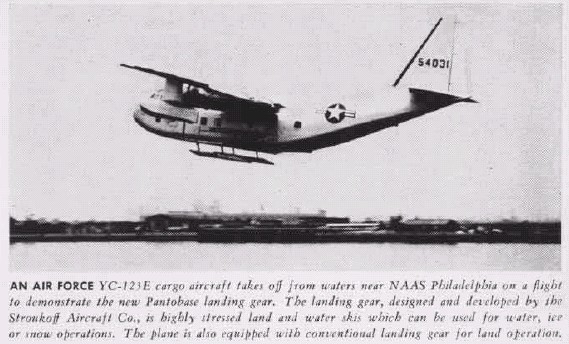
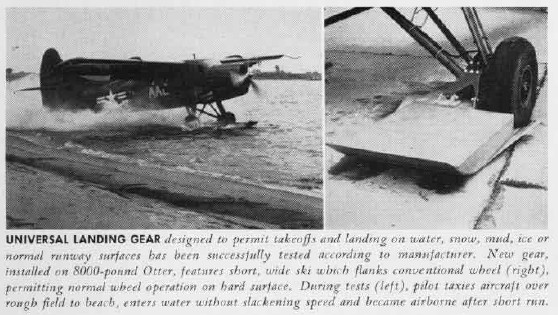

The SeaDart program was right on track until the aircraft carrier mafia stopped it. One of the tragic consequences of incorporating helicopters into the U.S. Army and marines is that egos drive everything and now we had egomaniacs who want their platform to get all the attention and budget. When non-adult narcissists comprise your military service they are not likely to have the HUMILITY needed to admit that their one platform cannot do it all and needs other complimentary platforms operated BY OTHER PEOPLE to get important overlapping capabilities to achieve the strongest synergy possible with minimum weakness enemies can exploit. Before too-fast jet jocks and too-slow "rotor-head" egomaniacs took over and ruined both Navy/Mc and Army Aviation, we could do STOL very well with fixed-wing aircraft to include landing on the water.
The reality that any aircraft could land on the water without a boat hull or floats has been SUPPRESSED from the general public by the military ego club racketeers who want to not get wet or dirty while on the taxpayer's dole. The emasculated military that physically wants to avoid direct interface with the earth is getting creamed in Iraq/Afghanistan and bodes ill for the future survival of the U.S.
One way to achieve sealanding capability for jets at least for emergencies is to exploit the A-4 SkyHawk double droptank effect which enabled them to act as defacto landing gear skids resulting in the A-4 receiving ZERO damage.
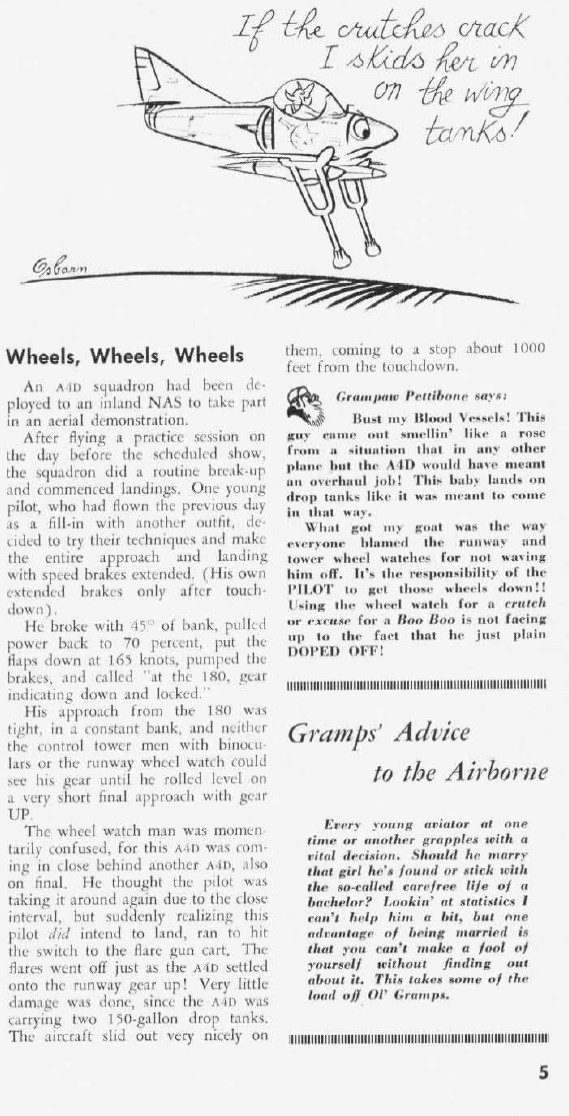
If we created special fuel tanks with pop-out skis and floatation bages we could have this capability without having to modify the aircraft itself (see "Non-Aircraft Carrier Seaplane Defense of Surface Ships" slides above for details).
Got ASW? Got AAW Air Cover? Want to NOT get sunk?
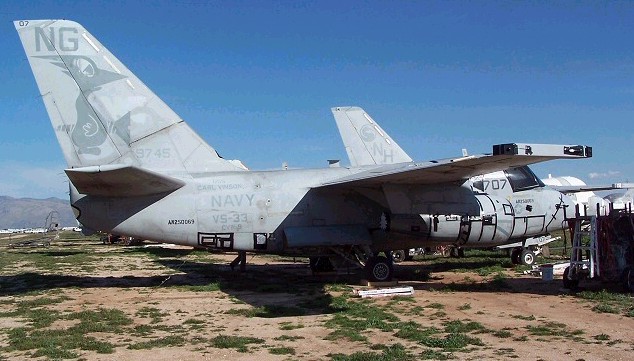
1. Quantity of at-sea ASW: unintended consequence of failing to field contraprops
Let's get the basics down here. In 1955, with the failure of the U.S. to make a working contra-rotating prop twin turbine powerplant work to create COMPACT ASW, AEW, COD and attack prop planes sans torque and side-by-side engine woes, the side-by-side S-2F Tracker ASW planes was fielded on the USS Antietam declared sole purpose was to be an ASW carrier. A squadron of 12 x Trackers were deployed though the ship specs say 90-100 single engined planes could be carried. Giving the USN the maximum benefit of a doubt, this means the Antietam could have operated 45-50 x twin-engined Trackers. Correct? Or if they gobble the deck space in a ratio of 1 x Tracker in the deck space of 3 s WW2 single engined planes, this means 30-33 x Trackers or 3 squadrons.
We gave up on ASW carriers so the above is moot until we wake up again to the need, hopefully not too late. Our point is that if we are going to "B-25" off SMALL aircraft carriers derived from container ships it CAN be done especially using catapults so the entire length of the deck is not needed to get take-off lift.
We only built 186 x S-3 Vikings to replace the S-2F Trackers so that's a maximum of 15 squadrons. We have roughly a dozen stuporcarriers, so this means 1 squadron of ASW fixed-wing planes at sea each when we have a modicum of smarts. Now we are asking for an ass kicking and we look like we deserve it, too with our hubris.
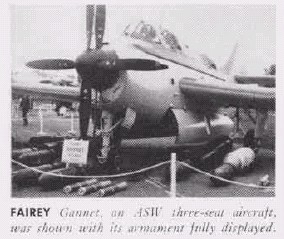
The point here is that had we been HUMBLE and asked for HELP from the British, we could have got their Mamba contraprop engines to power a twin-engine but VERY COMPACT ASW plane and gotten 2 x squadrons for a total of 24 on each supercarrier and these could have also been ATTACK planes to do MAS ie; SKYRAIDER IIs. Or we could have simply joined the British and BOUGHT THEIR FAIREY GANNETS with Mamba contraprop engines. We bought their Canberra light bombers, remember?
2. Quality of at-sea ASW/AAW: unintended consequence of retiring catapult seaplanes from destroyers/cruisers/battleships
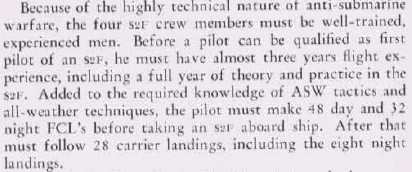
The USN boasts that their carriers and carrier aircraft are "all weather" then out of their other side of the mouth whine about storms causing them to be unable to fly.
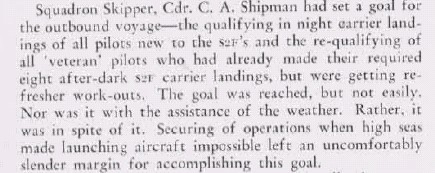
Which is it?
Is "ALL" weather meaning "ALL" or some more lying narcissist BS? We know jets can't fly through thunderstorms or hurricanes well and props can. However, lightning, bird strikes and wind shears can down the props, too. So "all weather" is a lying aviator narcissist boast. If they were honest we have "Most Weather" planes and "Good Weather" planes, not "ALL" weather planes. No I am not down on aviators because I am not one, the typical self-centered ad hominum attack diversionary ploy to dodge the facts. I am down on them for lying about the true situation and clouding the force structure issue. When the weather is BAD, aircraft carriers CANNOT OPERATE AIRCRAFT. This leaves them DEFENSE LESS at the outer ring even if they had fixed-wing ASW planes, which we do not have now, anyway. It also means we don't have helicopters flying at the inner ring, either. An enemy submariner could during bad weather proceed to sink our unarmored destroyer/cruiser "cans" at the outer ring and then gleefully move in to sink the stupor carrier and everyone else around them in the naval clusterfuck of hubris and American triumphalistic smugness. Oh, did I mention this means the entire Carrier Victim Group also has no AIR COVER from enemy aircraft attack using ASMs? Iron Bombs? Kitchen sinks?
We offer an alternative.
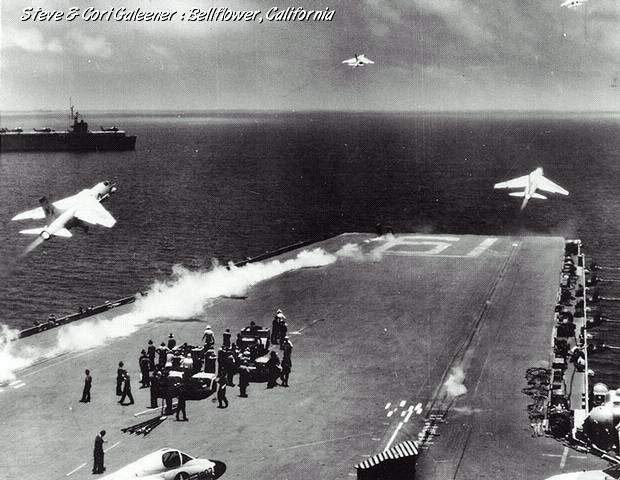
Instead of rolling on the pitching aircraft carrier deck a fixed-wing ASW plane (we don't have) to try to get it into position to be connected to a steam catapult and launching at best 4 planes, and then worrying about how they will land later on a slippery, pitching deck, we LAUNCH A CONTRAPROP SEAPLANE FROM A CATAPULT IT ALREADY IS CONNECTED TO* FROM EACH OF OUR DESTROYER/CRUISERS/BATTLESHIPS TO CREATE AN OUTER ASW/AAW DEFENSIVE RING.
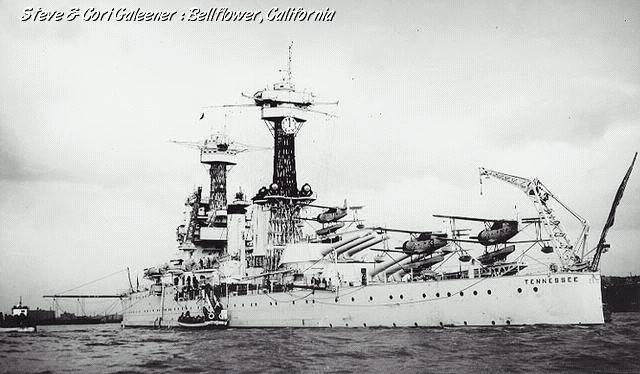
Each one could catapult simultaneously 3 seaplane fighters like the WW2 ships could that had a catapult on top of a gun turret in addition to two amidships or at the stern.
Now we have some air cover and an ASW outer ring EVEN IN "UNFLYABLE" weather.
You may say the seaplanes can't land in the water and will be lost...not necessarily so.
1. if they have wheels and a tail-hook they could land back onto the stuporcarrier
2. their ships could turn and create a path of undisturbed water to land on and taxi onto a sea sled/mat
3. if they have air cushion landing gear they will not be curtailed from sea landing
4. if they are a F-35 JSF** they could HOVER and be winched down to the rear landing pad like LAMPS helicopters can do now or;
5. a crane/cherry picker snags the F-35B at a hover and then lowers them to the rear flight deck
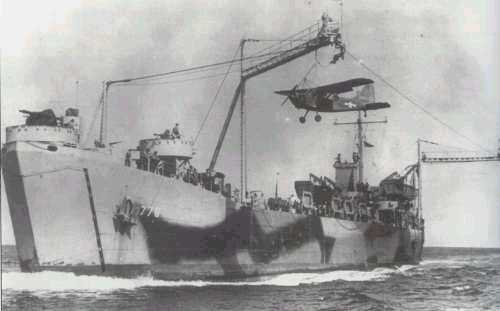
6. Brodie wire system: if the seaplane has a low stall speed like a grasshopper it could hook an overhead wire and be recovered at sea like was done many times in WW2
CAVEATS:
* some kind of quick release restraints could also enable a F-35B JSF to take-off vertically even in extremely bad weather
** the problem with the F-35B JSF is that its a fuel hungry jet so its short-ranged and doesn't have a 2nd seat for a sensor operator to ASW sub hunt but it would be satisfactory for shooting down enemy planes (AAW)
SO THE ANSWER ALL ALONG WAS TO KEEP ON OPERATING CATAPULT-LAUNCHED SEAPLANES, U.S. NAVY!!!
en.wikipedia.org/wiki/S-3_Viking
From Wikipedia, the free encyclopedia
Type Anti-submarine aircraft
The Lockheed S-3 Viking is a jet aircraft originally used by the United States Navy to identify, track, and destroy enemy submarines. In the late 1990's, the S-3B's mission focus shifted to surface warfare and aerial refueling. After the retirement of the A-6 Intruder and A-7 Corsair II, the Viking was the only airborne refueling platform organic to the the Carrier Air Wing(s) until the fielding of the F/A-18 E/F Super Hornet. It also provides electronic warfare and surface surveillance capabilities to the carrier battle group. A carrier-based, subsonic, all-weather, multi-mission aircraft with long range, it operates primarily with carrier battle groups in antisubmarine warfare roles. It carries automated weapon systems, and is capable of extended missions with in-flight refueling. Because of the engines' high-pitched sound, it is nicknamed the "Hoover" after the brand of vacuum cleaner.
Contents
1 Development
Development
S-3 launches from the USS Nimitz.
The S-3 Viking was designed by Lockheed with the assistance from Ling-Temco-Vought and UNIVAC to fit the United States Navy VSX (Heavier-than-air, Anti-submarine, Experimental) requirement for a replacement for the piston-engined Grumman S-2 Tracker. Since Lockheed had no experience in building carrier-based aircraft, LTV was responsible for construction of the folding wings and tail, the engine nacelles, and the landing gear which was derived from A-7 Corsair II (nose) and F-8 Crusader (main). UNIVAC built the onboard computers which integrated input from sensors and sonobuoys.[1] The first prototype flew on 1972-01-21 and the S-3 entered service in 1974. During the production run from 1974 to 1978, a total of 186 S-3As were built.
Description
The S-3 is a conventional monoplane with a high-mounted cantilever wing, swept 15°. It is powered by two TF-34 turbofan engines mounted in nacelles under the wings. The aircraft can seat four crew members with the pilot and the copilot/tactical coordinator (COTAC) in the front of the cockpit and the tactical coordinator (TACCO) and sensor operator (SENSO) in the back. All crew members sit on upward-firing Douglas Escapac zero-zero ejection seats. At the end of the 1990's the sonar operators were removed from the crew. In the tanking crew configuration, the S-3B typically flies with only a crew of two (pilot and COTAC). The wing is fitted with leading edge and Fowler flaps. Spoilers are fitted to both the upper and the lower surfaces of the wings. All control surfaces are actuated by dual hydraulically boosted irreversible systems. The aircraft has two underwing hardpoints that can be used to carry fuel tanks, general purpose and cluster bombs, missiles, rockets, and storage pods. It also has four internal bomb bay stations that can be used to carry general purpose bombs, torpedoes, and special stores (B57 and B61). Fifty-nine sonobuoy chutes are fitted, as well as a dedicated Search and Rescue (SAR) chute. The S-3 is fitted with the ALE-39 countermeasure system and can carry up to ninety rounds of chaff, flares, and expendable jammers (or a combination of all) in three dispensers. A retractable magnetic anomaly detector (MAD) boom is fitted in the tail.
Operational history
An S-3B Viking of the "Shamrocks" launches from the USS Nimitz.
On 20 February 1974, the S-3A officially became operational with the VS-41 Shamrocks Fleet Replacement Squadron. The first operational cruise took place in 1977 with VS-21 Fighting Redtails aboard USS Constellation (CV-64).
Starting in 1991, some of these were upgraded to the S-3B with a number of new sensors, avionics, and weapons systems, including the capability to launch the AGM-84 Harpoon anti-ship missile. The S-3B can also be fitted with "buddy stores" external fuel tanks that allow the Viking to refuel other aircraft. Sixteen S-3As were converted to ES-3 Shadows for carrier-based electronic reconnaissance (ELINT) duties. A few aircraft, designated US-3A, were also converted for utility and limited cargo duty.[1] Plans were also made to develop the KS-3A carrier-based tanker aircraft to replace the retired KA-6 but these were ultimately cancelled.
Since the submarine threat has been perceived as reduced, the Vikings have had the majority of their antisubmarine warfare equipment removed and are now used primarily for sea surface search, sea and ground attack, over-the-horizon targeting, and aircraft refueling.[1] As a result, crews are now usually limited to two, though three person crews are not unusual with certain missions.
A number of recent upgrade programs have been implemented. These include the Carrier Airborne Inertial Navigation System II (CAINS II) upgrade, which replaced older inertial navigation hardware with ring laser gyroscopes and additional GPS systems, and added electronic flight instruments (EFI). The Maverick Plus System (MPS) added the capability to employ the AGM-65E laser-guided or AGM-65F infrared-guided Maverick air-to-surface missile, and the AGM-84H/K Stand-off Land Attack Missile Expanded Response (SLAM/ER). The SLAM/ER is a GPS/inertial/infrared guided cruise missile that can be controlled by the aircrew in the terminal phase of flight if an AWW-13 data link pod is carried by the aircraft.[1]
The S-3B saw extensive service during the 1991 Gulf War, performing attack, tanker, and ELINT duties, and launching ADM-141 TALD decoys. The aircraft also participated in the Yugoslav wars in the 1990s and in Operation Enduring Freedom in 2001.
As the surviving S-3 airframes were forced into sundown, a Lockheed Martin full scale fatigue test was performed and extended the service life of the aircraft by approximately 11,000 hours. The current Navy plans call for the retirement of all Vikings by 2009 so new aircraft can be introducted to recapitalize the aging fleet inventory. Their missions will be spread among the other battlegroup fixed-wing and rotary-wing aircraft. During FIDAE 2006 aerospace and defense trade show, the U.S. Navy offered retired airframes to the navies of Argentina, Brazil, Chile and Peru, with deliveries beginning in 2009.
Notable flights
On May 1, 2003, U.S. President George W. (Nero) Bush rode in the co-pilot seat of a Viking that landed on the aircraft carrier USS Abraham Lincoln, where he delivered his "Mission Accomplished" speech announcing the end of major combat in the 2003 invasion of Iraq. This was the only Navy flight to date to use the call sign "Navy One". The pilot was the Executive Officer of VS-35, Navy Commander John "Skip" Lussier.
Variants
S-3A
First production version, 186 built.
S-3B
Upgraded avionics, AN/APS-137 inverse synthetic aperture radar, Joint Tactical Information Distribution System, AGM-84 Harpoon launch capability, first flight 13 September 1984, 119 converted from S-3As.
ES-3A Shadow
ELINT aircraft, AN/APS-137 inverse synthetic aperture radar, first flight 15 May 1991, 16 converted from S-3A.
KS-3A
Proposed dedicated air tanker with fuel capacity of 4,382 US gal (16,600 L), one converted from YS-3A, later converted to US-3A.
KS-3B
Proposed air tanker based on S-3B and utilizing the buddy refueling system, not built.
US-3A
S-3A modified for carrier onboard delivery, capacity for six passengers or 4,680 lb (2,120 kg) of cargo, retired in 1998.
Alladin Viking
Classified modifications, used in the Bosnian War
Beartrap Viking
S-3Bs fitted with still-classified modifications.
Callypso Viking
Proposed anti-smuggling variant, not built.
Gray Wolf Viking
One aircraft fitted with AN/APG-76 radar in a modified cargo pod under the wing. Also dubbed SeaSTARS in reference to E-8 Joint STARS.
Orca Viking
Avionics testbed.
Outlaw Viking
One S-3B fitted with Over-the-horizon Airborne Sensor Information System (OASIS III), returned to regular S-3B in 1998.
Specifications (S-3A)
Data from Standard Aircraft Characteristics[2]
General characteristics
Crew: 4
Unfolded: 68 ft 8 in (20.93 m)
Powerplant: 2× General Electric TF34-GE-2 turbofans, 9,275 lbf (41.26 kN) each
Internal fuel capacity: 1,933 U.S. gal (7,320 L) of JP-5 fuel
Performance
Maximum speed: 429 knots (493 mph, 795 km/h) at sea level
Mach 0.73, 447 knots (514 mph, 828 km/h) at 20,000 ft (6,100 m)
Armament
Up to 4,900 lb (2,220 kg) on four internal and two external hardpoints, including:
10× 500 lb (227 kg) Mark 82 bombs
The two underwing hardpoints can also be fitted with unguided rocket pods or 300 U.S. gal (1,136 L) fuel tanks.
Avionics
AN/APS-116 sea search radar, maximum range 150 nm (173 mi, 278 km)
OR-89 forward looking infrared (FLIR) camera with 3x zoom
AN/ARS-2 sonobuoy receiver with 13 blade antennae on the airframe for precise buoy location
AN/ASQ-81 magnetic anomaly detector (MAD)
AN/ASN-92 inertial guidance system with doppler radar navigation and TACAN
Up to 60 sonobuoys
References
Goebel, Greg (2005-05-01). The Lockheed S-3 Viking. Air Vectors. Retrieved on 2006-05-11.
Standard Aircraft Characteristics. Navy Model S-3A Aircraft. Navair 00-110AS3-1.
Related content
Wikimedia Commons has media related to: S-3 Viking
Related development
ES-3 Shadow
Designation sequence
S-2 - S-3
Seaplane UAVs: what is good for the goose, should be AOK for the gander, huh?
S-3 Viking
Manufacturer Lockheed Corporation
Maiden flight 1972-01-21
Introduced 1974
Status Limited use; 2009 retirement
Primary user United States Navy
Produced 1974-1978
Number built 187
Unit cost US$27 million (1974)
Variants ES-3 Shadow
1.1 Description
2 Operational history
2.1 Notable flights
3 Variants
4 Specifications (S-3A)
5 References
6 Related content
Length: 53 ft 4 in (16.26 m)
Wingspan:
Folded: 29 ft 6 in (9.00 m)
Height: 22 ft 9 in (6.93 m)
Wing area: 598 ft² (55.56 m²)
Empty weight: 26,581 lb (12,057 kg)
Loaded weight: 38,192 lb (17,324 kg)
Max takeoff weight: 52,539 lb (23,831 kg)
External fuel capacity: 2x 300 U.S. gal (1,136 L) tanks
Cruise speed: 350 knots (405 mph, 650 km/h)
Stall speed: 97 knots (112 mph, 180 km/h)
Combat radius: 2,765 nm (3,182 mi, 5,121 km)
Service ceiling: 40,900 ft (12,465 m)
Rate of climb: 5,120 ft/min (26.0 m/s)
Wing loading: 68.5 lb/ft² (334 kg/m²)
Thrust/weight: 0.353
4× Mark 46 torpedos
6× mines or depth charges
2× B57 nuclear bombs
CP-140 Aurora
Comparable aircraft
S-2 Tracker
Fairey Gannet
Breguet Alizé
www.youtube.com/watch?v=YQtPAaY5d1c
Cormorant MPUAV vs. Scud Surface-to-Surface Missile Fantasy Mission (Narrated)
(chances of soda straw UAVs finding mobile transporter-erector launchers is about nil)
www.youtube.com/watch?v=wIbOoBtqA-I
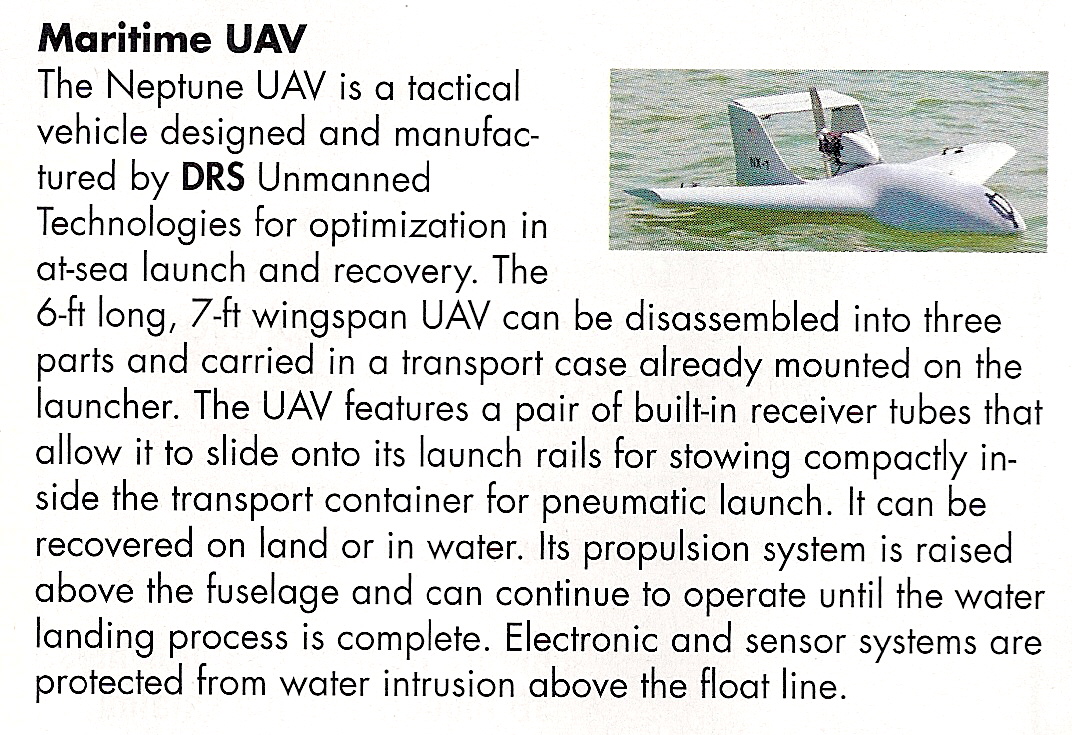
The one good thing about seaplane UAVs is they bypass pilot flyboy ego prejudices and remind us WHAT IS POSSIBLE again. Here, Paul has found a seaplane UAV. Perhaps, if we strip away the egomaniac from the equation, we can see the FUNCTIONAL UTILITY again of the seaplane, and zero length launches etc. and someday wake-up and apply them back to manned aircraft where they should have been all along.
A 1st TSG (A) member writes:
From: xxxxxxxxxxxxxxx
To: itsg@hotmail.com
Subject: seaplane UAVs, Chinese container assault shipsDate: Mon, 12 Feb 2007 02:19:54 +0000
I'm just sending some links about the growing trend of seaplane UAVs. You have to ask the question: "if water landing and take-off is good enough for UAVs, what about manned aircraft?"
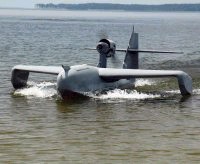
Oregon Iron Works Successfully Completes First Auto-Landing Test of Sea Scout Unmanned Seaplane
Portland, OR - May 8, 2006 - Oregon Iron Works, Inc. (OIW), an innovative small business defense solutions provider, recently completed a successful flight test of the Sea Scout unmanned seaplane in southeast Texas. The flight test included two completely autonomous water landings.
"Our research indicates this is the first time a seaplane has ever been auto- landed in the United States," said Josh Pruzek, program manager for the Sea Scout. An on-board LADAR provided altitude and water surface data to the autopilot during the landing approach and touchdown. "Both landings were picture perfect - as good as they get," said Pruzek.
The Sea Scout air vehicle, under development for nearly two years, is the result of a Naval Air Systems Command (NAVAIR) sponsored Phase III Small Business Innovative Research (SBIR) contract. The aircraft was flown at a gross weight of 300 lbs and carried 25 pounds of ballast in order to simulate a payload. A 38 HP Wankel engine powers the 10-foot span air vehicle.
Geneva Aerospace, of Carrollton, Texas, is OIW's technology partner in the development of the air vehicle. Geneva supplied their flightTEK(r) avionics and VACS(tm) guidance and control software necessary to fly the plane. Geneva leveraged their core auto landing technology developed under a separate NAVAIR SBIR program which has been demonstrated in land-based tests earlier this year.
OIW believes seaplanes have a viable position in the modern Navy and are developing the craft for EO/ISR and communications relay missions. "With so much of the earth's surface covered in water," remarked Pruzek, "utilizing that surface for take off and landing opens up a tremendous opportunity for unmanned aircraft that previously could not have been supported."
While seaplane technology is not new, there has been little development work in terms of new design in the last half century. The Sea Scout is a spiral development program intended to provide the Navy with a ship-based unmanned asset that minimizes the need for complicated launch and retrieval gear such as catapults and recovery nets.
The next steps for OIW include refining the air vehicle aerodynamics and hydrodynamics, as well as expanding the operating envelope of the aircraft, both on the water and in the air.
Oregon Iron Works, Inc. is a cutting edge specialty-manufacturing firm with commercial, marine, aerospace, hydroelectric, and defense manufacturing divisions. Founded in 1944 in Portland, Oregon, the company has been under the same management since 1974. The small business has nearly 400 employees and is now headquartered in Clackamas, Oregon, with additional manufacturing facilities in Vancouver, Washington. For more information, visit www.oregoniron.com.
Geneva Aerospace designs breakthrough technologies for unmanned aerial vehicles, providing unprecedented autonomy and control. The firm offers advanced flight controls, software, systems integration services and complete unmanned aerial vehicle systems. Based outside Dallas, Geneva's extensive client list includes the largest U.S. aerospace companies and government agencies. Learn more at www.genaero.com.
www.genevaaerospace.com/pdf/Seaplane_UAV_NavyLeague.pdf
Sea Power
July 2005Revival Plan
A veteran maker of naval aircraft would bring back the seaplane as an unmanned vehicle outfitted for a multitude of missions
By RICHARD R. BURGESS, Managing Editor
A one-time maker of hundreds of tactical aircraft for the U.S. Navy is proposing a small unmanned seaplane to perform several naval missions including strike, surveillance and the forward deployment of unmanned underwater vehicles for mine countermeasures and other tasks.
Called the Kingfisher II, the single-engine jet seaplane is envisioned as a simple straightwing, V-tailed monoplane built with composite materials and equipped with sophisticated control and mission systems. It would operate from the Navy's future Littoral Combat Ship (LCS) and other vessels. Vought Aircraft Corp. envisions the aircraft as a replacement for, or companion to, other unmanned aerial vehicles (UAVs) being purchased by the Navy.
Christopher Wilt, Vought's director of technology business development, said the Kingfisher II provides "a lot more range and payload, but you can still get it on and off the ship." At a top cruise speed of 345 knots, the Kingfisher II would be much faster than a helicopter UAV such as the Northrop Grumman Fire Scout, which has a maximum speed of approximately 125 knots and is being developed for operations aboard the LCS.
The Kingfisher II, which is under development, would have a maximum payload of 2,500 pounds, more than the Fire Scout's [puny] payload of 600 pounds. The Kingfisher II design features wings that fold rearward, allowing the aircraft to be winched up a ramp and stored in a shipboard hangar being designed for the LCS.
Located in Dallas, Vought once built a variety of tactical aircraft for the Navy, including the A-7 Corsair II. Today, it specializes in the manufacture of nacelles, wings and other components for airplanes including the C-17 and C-130J transports, the B-2 bomber and the F/A-18 family of tactical aircraft. One of Vought's more famous craft was the World War II OS2U Kingfisher scout floatplane that operated from surface ships for observation, gunfire spotting and rescue work. Wilt said that old floatplane was the inspiration for the Kingfisher II.
However, Vought faces a challenge as it attempts to convince the [lazy] Navy of the modernday value of seaplanes. The Fire Scout appears to be the Navy's aircraft of choice [EDITOR: because they are morons] for many of the roles Vought envisions for the Kingfisher II. Vought is leveraging a $497,000 contract from the Defense Advanced Research Projects Agency (DARPA) to advance the Kingfisher II concept.
Van Olinger, the project's manager at DARPA, said "DARPA's current interest is limited to the feasibility of an unmanned seaplane demonstrating autonomous takeoffs and landings." The Naval Air Systems Command "is interested in seaplanes as a sea basing technology and is following the DARPA effort," said Amy Behrman, a spokeswomen for the command. "However, we do not have an active seaplane [technology] effort at this time."
The Navy operated seaplanes, including flying boats, floatplanes and amphibians, for 65 years and retired its last patrol seaplanes, the Martin SP-5B Marlins, in 1967. Its last amphibian, the Grumman HU-16, capable of operation from sea or land, was retired in 1976.
Seaplanes were phased out for [allegedly] good reasons. [EDITOR: they are lazy egomaniacs who are selective in what is "hard" for them. The 5, 000 men slaving over the aircraft carrier is AOK but a few hundred for a dozen seaplanes is suddenly "too much work". The magazine writer is an establishment excusemonger]. Corrosion of metal from the intense salinity of the ocean environment demanded constant attention. [EDITOR: SO? so does brushing your teeth in the "demanding sugar water environment". You are a lying fuck]Operations from sea always were inherently hazardous, especially in high sea states, stormy conditions and at night. Increased numbers of airfields gave worldwide reach to conventional aircraft.
Helicopters, which are easier on shipboard operations and able to rescue people without lighting on the water, replaced floatplanes. [EDITOR: you mean when they themselves are not crashing and running out of gas you liar. They ain't gonna be rescuing anyone is they can't reach them with their gas hog short ranges.]
However, the composite materials commonly used in building modern aircraft are resistant to salt-water corrosion and Vought hopes their use in the Kingfisher II will help foster new interest in the seaplane concept. [EDITOR: we're sure they lying Navy aircraft carrier assholes will conjure up a new excuse to not do what's most efficient]
To demonstrate the capability, Vought is modifying a Dakota, a rugged 200-pound UAV built by Geneva Aerospace of Carrollton, Texas, with floats and a flight computer designed for UAVs that will be adapted for operations from water. The Dakota was designed by Daedelus Research Inc. during the 1980s as a rugged test-bed for the Naval Research Laboratory, according to David Duggan, vice president of business development for Geneva. Daedelus went out of business and Geneva later bought the rights to build the Dakota.
The adaptation by Geneva involves integration of a motion-sensing device into the tiny flightTEK computer to calculate wave motion and allow the UAV to land on the backside of a wave. The flightTEK computer "is being used on a lot of different unmanned systems," Duggan said, including the Navmar Applied Sciences Corp. LR-3 Tigershark UAV, as well as others he declined to name for reasons of security classification.
Duggan told Seapower the Dakota built for Vought was flight-tested on May 18 and would be shipped to Vought for installation of floats. Water-borne tests are planned for November.
The payload capability of the Kingfisher II would allow the UAV to carry two Mk54 anti-submarine torpedoes and land in the water to deploy them. With positive mission control, the Kingfisher II could deploy sonobuoys, taxi on the water to a submarine's updated position, activate a dipping sonar and more accurately launch the torpedo.
Wilt said the Kingfisher II would be ideal for delivery and retrieval of unmanned underwater vehicles such as mine countermeasures vehicles. "We can get them out farther and faster," he said The Kingfisher II also could be armed with Hellfire air-to-surface missiles or the Joint Common Missile now under development, as well as small-diameter bombs and smallcaliber machine guns for strike roles. In addition, the aircraft could perform search-andrescue operations, deliver high-priority supplies or parts to ships at sea, or transport special operations forces in emergency circumstances.
DATE: 29/03/05
SOURCE: Flight InternationalVought aims for U.S. Navy with seaplane UAV concept
Jet-powered Kingfisher II intended to challenge Fire Scout for LCS support role
Vought Aircraft Industries is studying the feasibility of launching its first all-new aircraft in decades, proposing a seaplane unmanned air vehicle concept to the U.S. Navy called the Kingfisher II.
Vought seeks to enter the UAV market with a design that offers an alternative to the USN's plans to support the future Littoral Combat Ship (LCS) with helicopter UAVs - namely, the Northrop Grumman RQ-8B Fire Scout.
"We want to support ships, too, but don't want to take off vertically," says Chris Wilt, Vought's business development director for research, development and technology programmes.
An infant technology programme, backed by a small grant from the U.S. Defense Advanced Research Projects Agency (DARPA), is seeking tools for akingautonomous take-offs and landings on the water, which the company believes would be a breakthrough capability in the UAV field.
Flying demonstrations later this year using a manned surrogate aircraft are intended to stir interest in follow-on funding by DARPA or the USN to fund more basic engineering work and perhaps develop a prototype.
Vought is also seeking to partner a prime contractor for full-scale development. Talks have started with Lockheed Martin.
The jet-powered Kingfisher II would be Vought's first new-start since the A-7 Corsair II in the 1960s. Performance projections are based on an above-fuselage-mounted 4,100lb-thrust (18kN) Pratt & Whit-ney Canada PW525B. The concept calls for a 250 kt (460km/h) [300 mph] cruise speed at 20,000ft (6,100m) with a 2,500lb (1,135kg) payload.
"The wingspan would measure 41 feet, with overall length about 38 feet," says Wilt.
The design calls for retractable wingtip floats, variable incidence/variable camber wings and all-flying V tail. The payload is optimised to carry a surveillance package and a 750lb Mk54 torpedo, says Wilt.
STEPHEN TRIMBLE/WASHINGTON DC
An intereting article on Chinese use of container ships to invade Tiawan!
www.americanthinker.com/2005/04/chinas_container_ship_fleet_an.html
Seaplanes on Destroyers: the saga of the USS Pringle
www.usspringle.org/Kingfisher.htm
The USS Pringle - the first U.S. Destroyer to use a Kingfisher OS-2U aircraft launched from a catapult
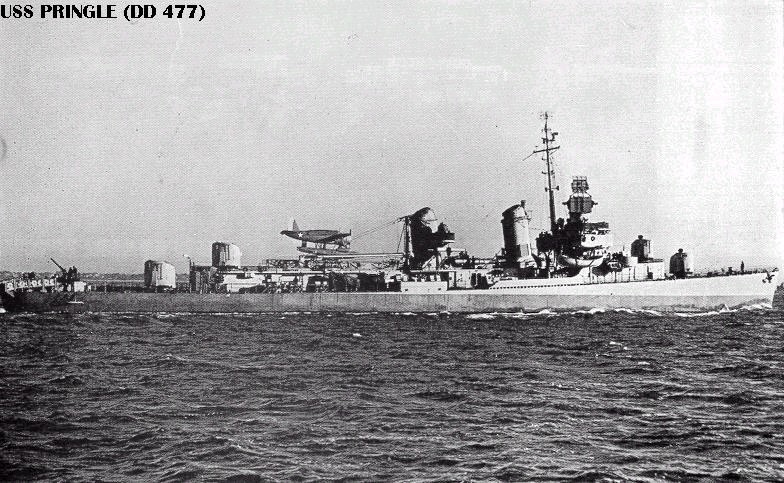
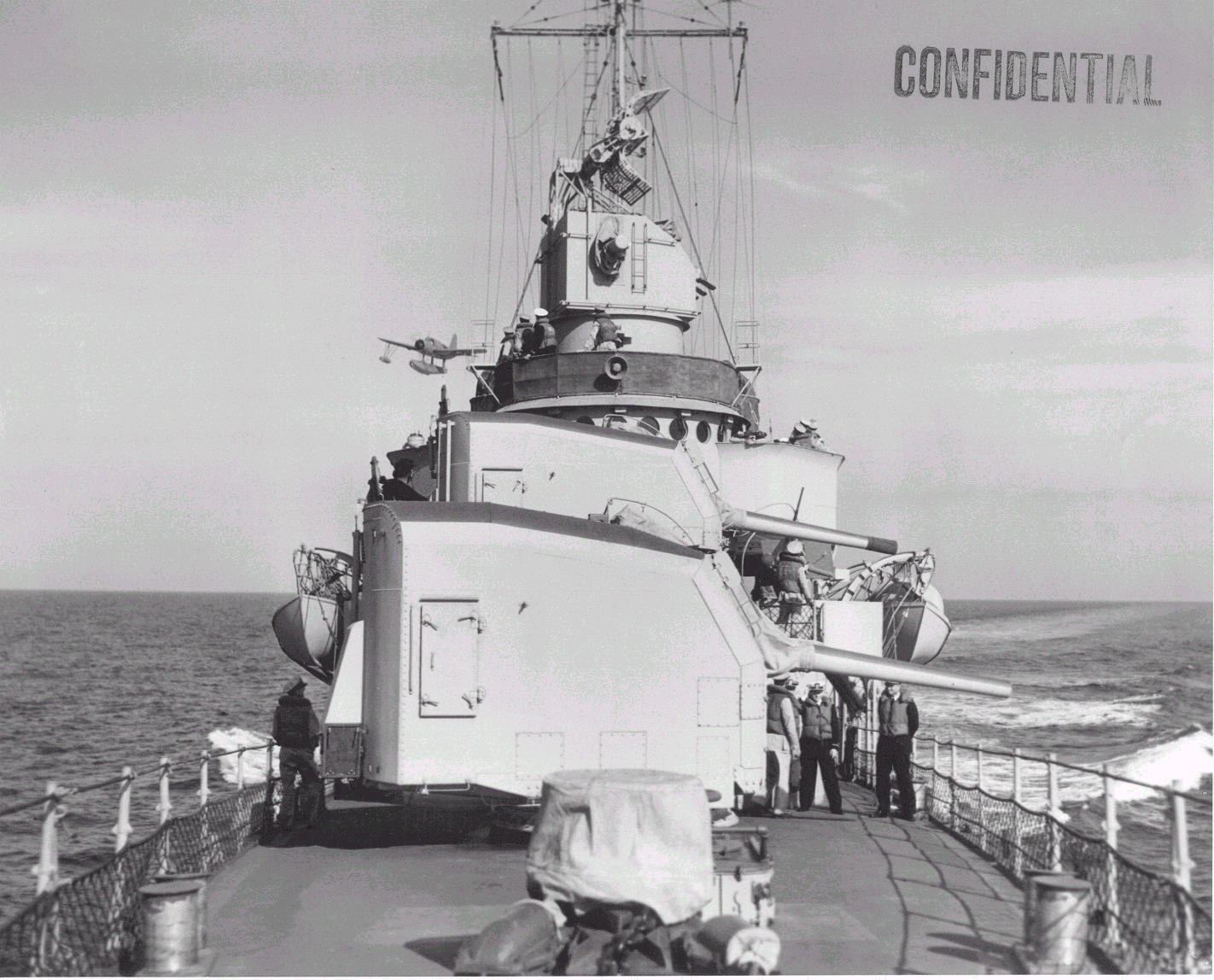
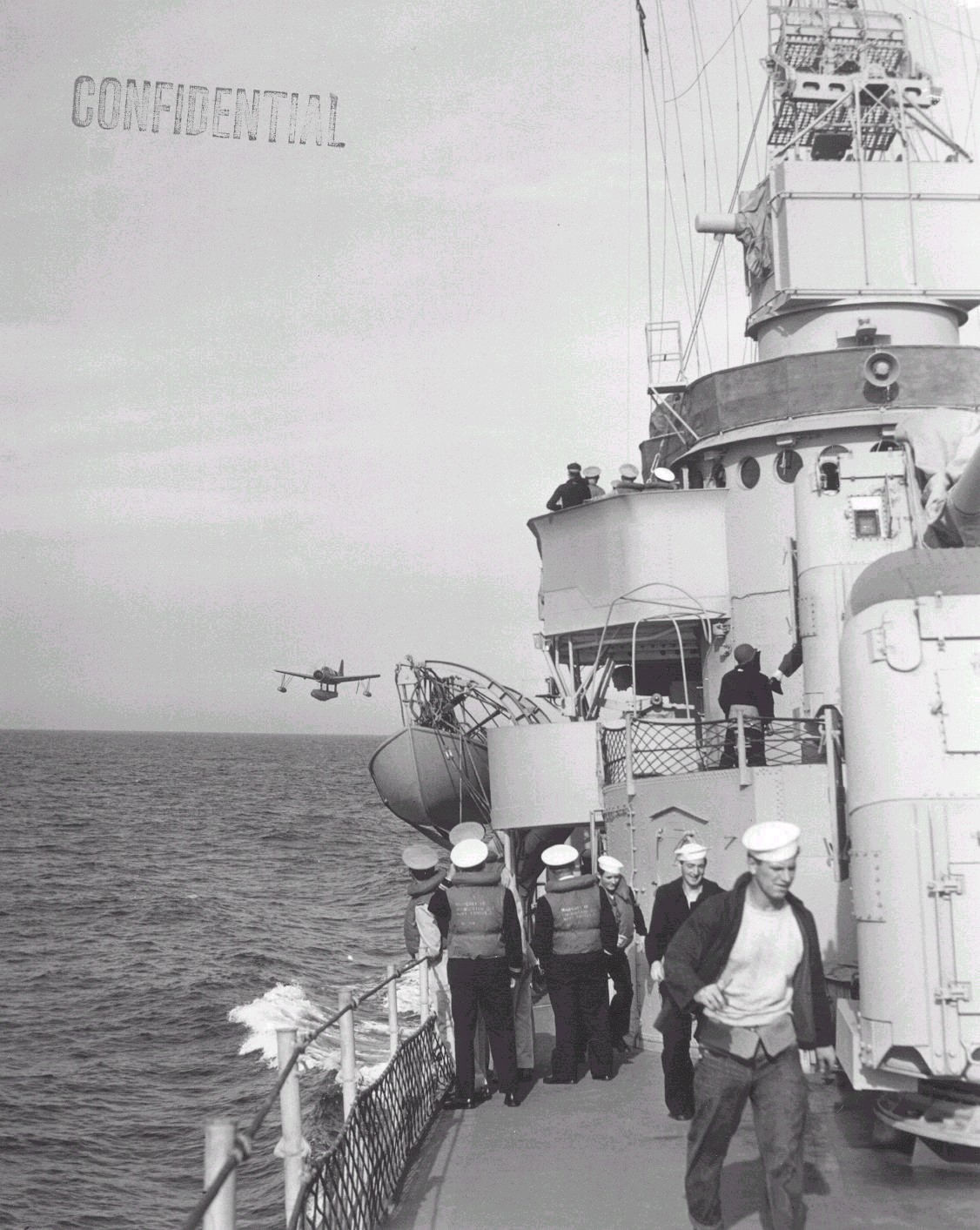
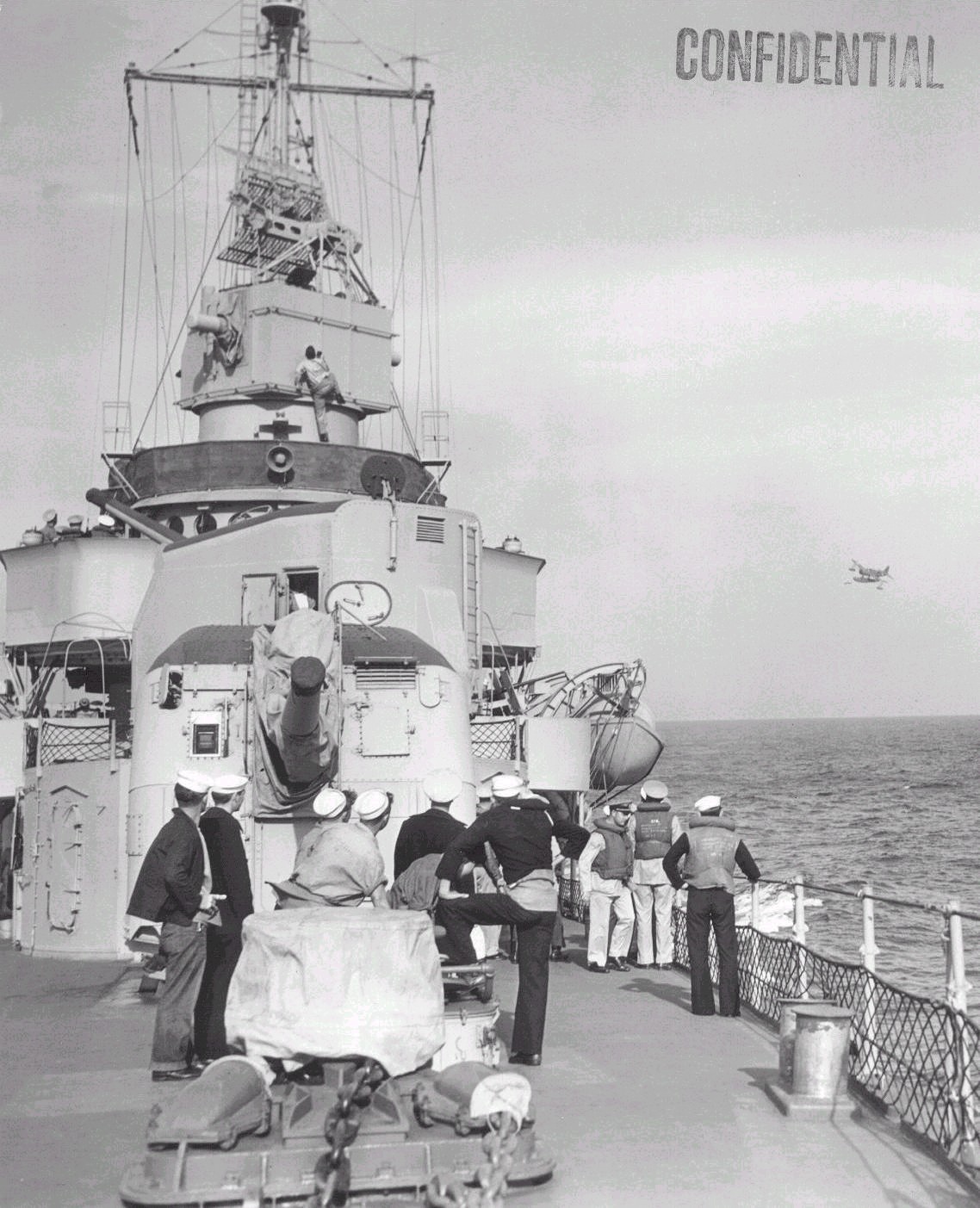
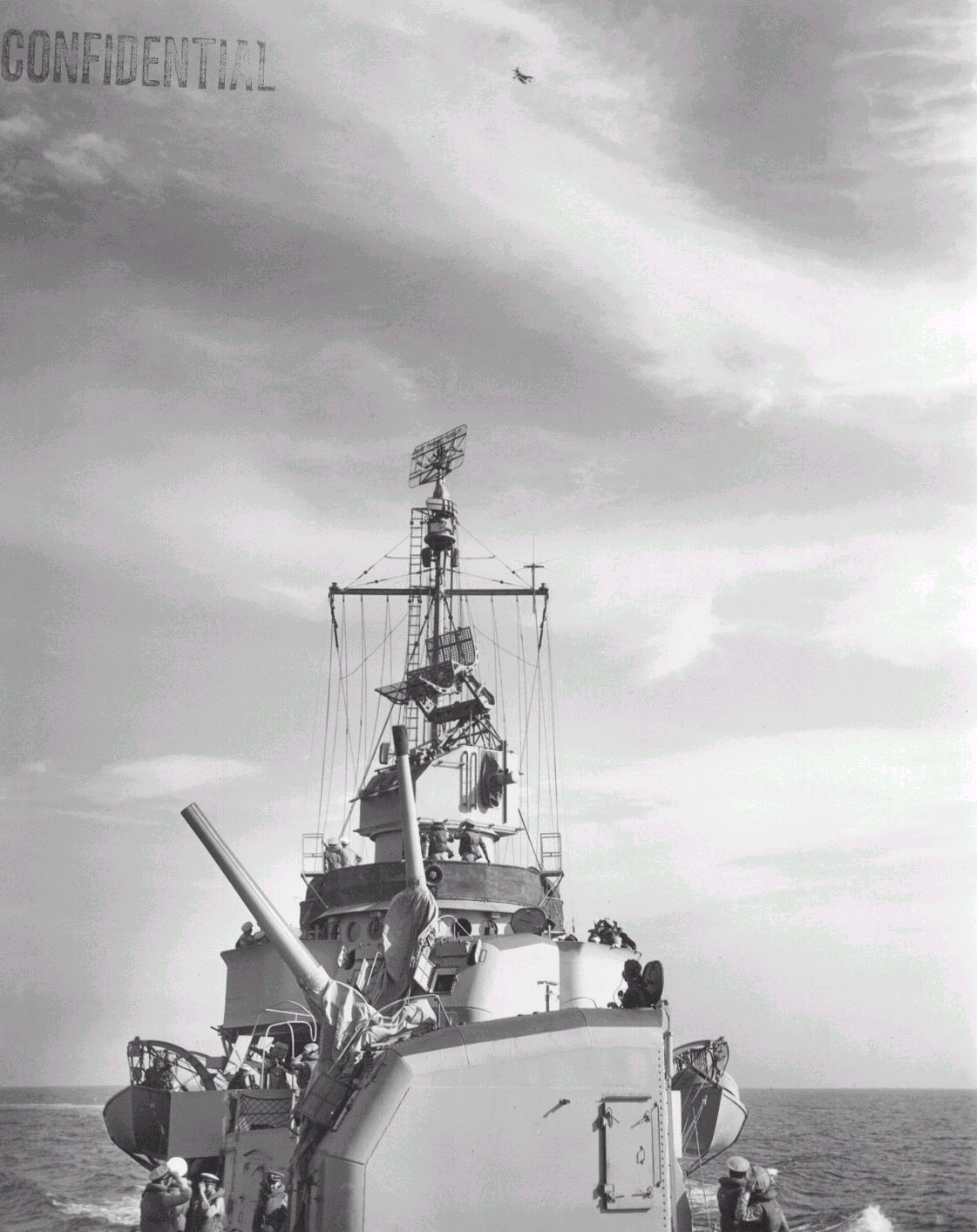
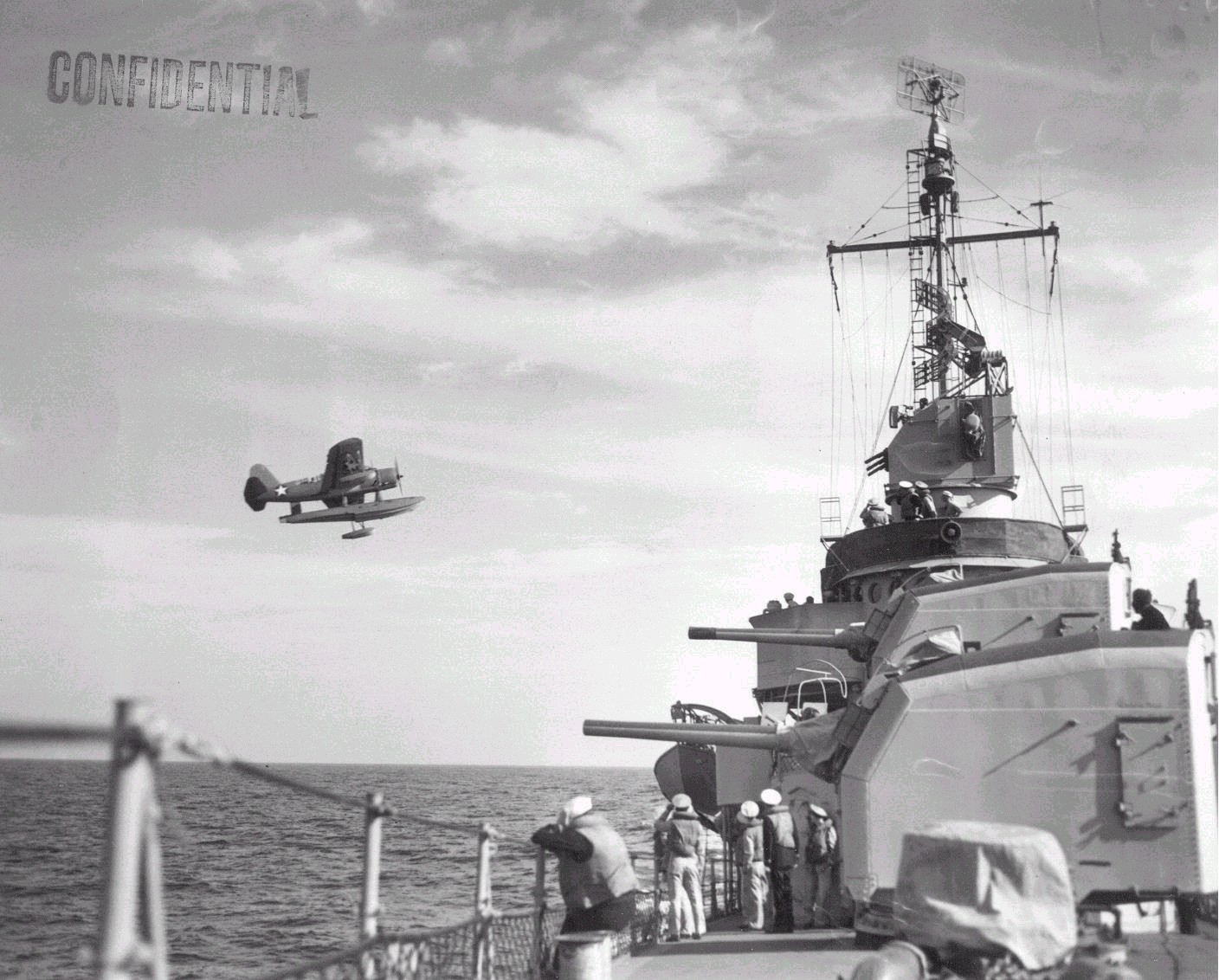
A requirement came down that 6 x Fletcher Class Destroyers be outfitted with an aircraft. These aircraft would provide gunfire spotting during bombardment roles and for general scouting duties when operating without the support of heavier units that normally provided air support. There was considerable opposition from old line Captains and Admirals, but somehow the idea prevailed. The arrangement was at the loss of a 5" 38 cal. DP gun, a dual purpose 40mm gun mount and a set of torpedo tubes. Of the 6 proposed, only 3 were built, The USS Pringle DD477, The USS Stevens DD479, and the USS Halford DD480. The Stevens and the Pringle were built in the Charleston Navy yard, while the Halford was built in the Philadelphia Navy Yard. After a few short months of operations, the aircraft configuration "did not prove feasible" and in early 1943, they were sent to Mare Island for conversion back to standard Fletchers.
1. Small surface ships CAN operate floatplanes
There is nothing physically preventing this from being done in the past or today.
Yet read the American whining that operating seaplane is too hard?
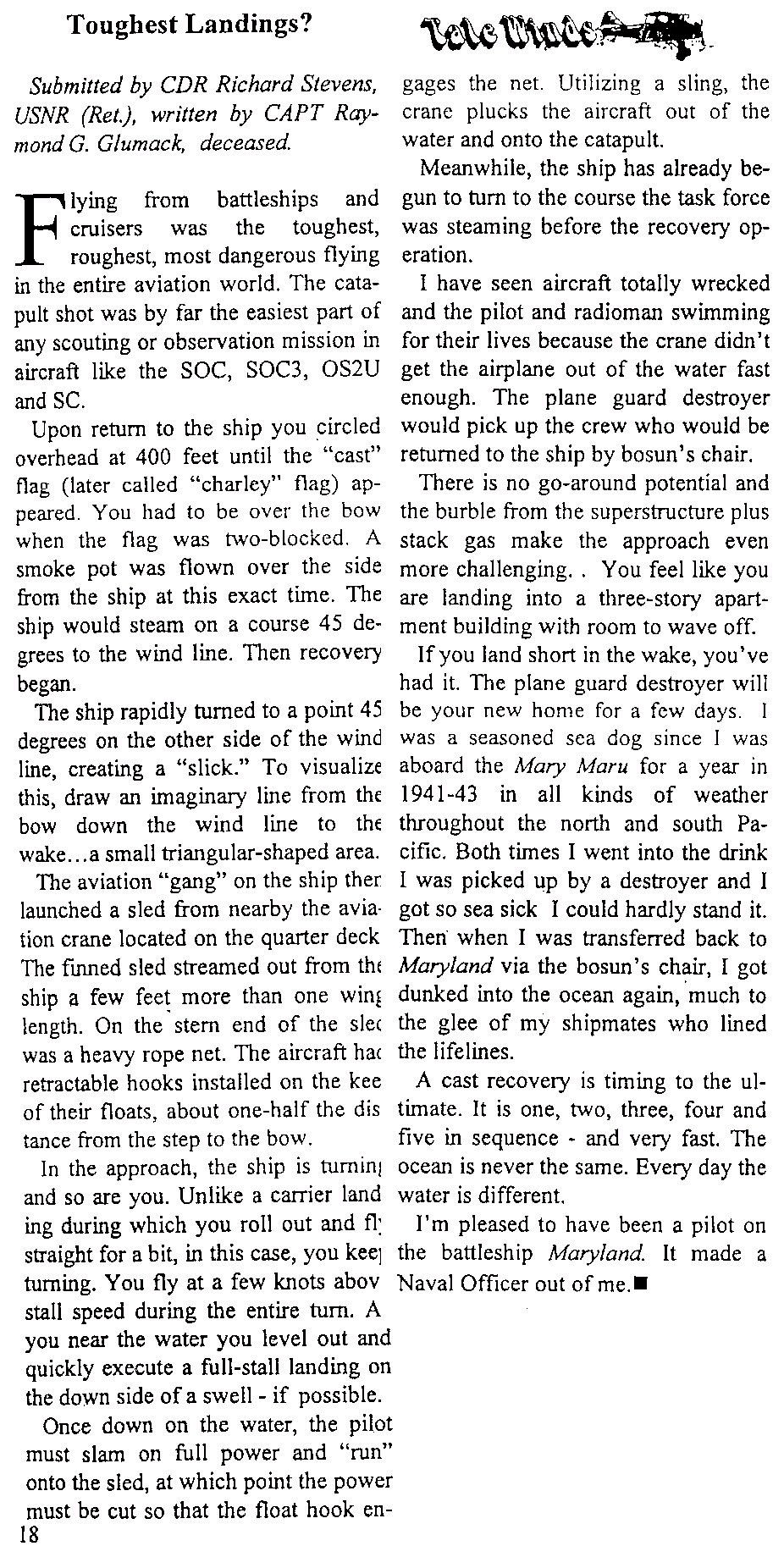
Now Compare this to the German/Japanese floatplanes, did they have it so hard or did WE make it harder than it has to be? I don't remember them using landing mats and what not. Or are we just plain lazy?
Commander Long reveals there were SEVERAL WAYS TO OPERATE SEAPLANES FROM SURFACE SHIPS. The pilot whining in the web page above is DISHONESTLY PORTRAYING THE CHARLIE TECHNIQUES AS THE ONLY WAY TO LAUNCH/RECOVER SEAPLANES. How convenient. Battleship/Cruiser seaplanes saved HUNDREDS OF LIVES in WW2, let's ask asll those they saved and their families if operating seaplanes was "not feasible" or worth it. We could start with WW1 flying ace, Captain Eddie Rickenbacker whose B-17 was forced to ditch into the water in 1942.
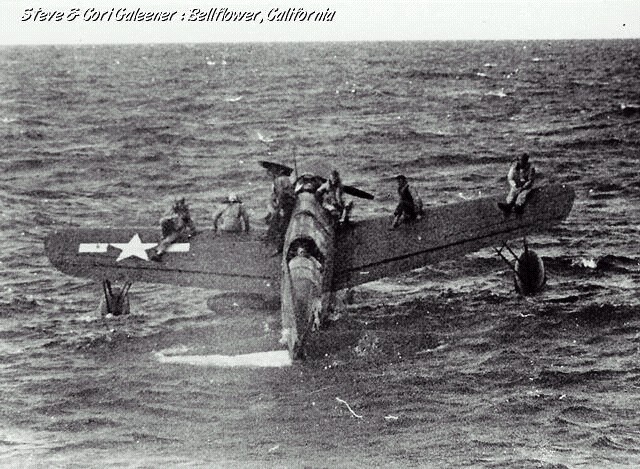
2. Had the American Navy not been slackers (see Admiral Larson's pics of their slacker state of dress/undress) and defeatists by 1945, the USS Pringle would have had a SC-1 SeaHawk fighter seaplane that could have SPOILED the Kamikaze attacks that resulted in her being sunk. Just one SeaHawk could have spoiled the 3 bomb-laden Kamikazes that sank the Pringle. Even a Kingfisher could have done this.
3. The lack of body armor, floatation gear and ship camouflage (no dazzle paint) in typical U.S. Navy practice and the desire to gunfight duel until the Jap planes are upon you like it is a Western movie is a set-up for failure now continued by the missile madness at the inner ring
4. Note the many times surface destroyers, frigates and cruisers operate with NO AIR COVER CAP, again demanding that the illusion of having an aircraft carrier available to provide it be faced
5. Note the seaplane PBY "Black Cats" finding the enemy fleet and relaying this info so the surface ships can attack, use smokescreens, turn away at 40 mph and spit out torpedoes. The fighting ethos of the destroyer is admirable, why not extend that to a seaplane fighter you own yourself?
6. Notice the Pringle's ship wake at high and low speed. WHY don't we experiment with ship sterns until we can eliminate ship wake as a visible tell to the enemy?
7. Is it not possible with air conditioning to have ALL THE SHIP'S HATCHES CLOSED and ALL Navy crews IN FULL COMBAT GEAR ALL THE TIME WHEN ON DUTY? In other words, stop this BS feel-good Khaki and scrambled eggs on visors crap straight out of a WW2 movie. Everyone wear Nomex dark blue jumpsuits and full body armor/floatation gear and helmet WHENEVER ON DUTY. Off duty, you want to run around in your jumpsuit, fine, better have at least a floatation belt at your waist in event ship gets exploded and you are tossed into the water. Don't you think that if we stop being half assed and got used to wearing full combat gear and opening and closing hatches not only would the MEN GET TOUGHER we'd be far more efficient once the real shooting starts?
Kamikaze = Guided Missile
1945: Okinawa: 33 U.S. ships sunk, 50 damaged, 4, 907 American dead, 4, 824 wounded
USS Pringle History & Needless Tragedy
www.usspringle.org/NavalRecordsHistpg1.htm
www.usspringle.org/NavalRecordsHistpg2.htm
www.usspringle.org/NavalRecordsHistpg3.htm
www.usspringle.org/NavalRecordsHistpg4.htm
www.usspringle.org/NavalRecordsHistpg5.htm
www.usspringle.org/NavalRecordsHistpg6.htm
The "politically correct" history of small seaplanes written in 1961 to CYA the aircraft carrier brass who have over the years suppressed the fact that aircraft at sea are actually most efficiently operated by means other than $BILLION dollar "supercarriers".
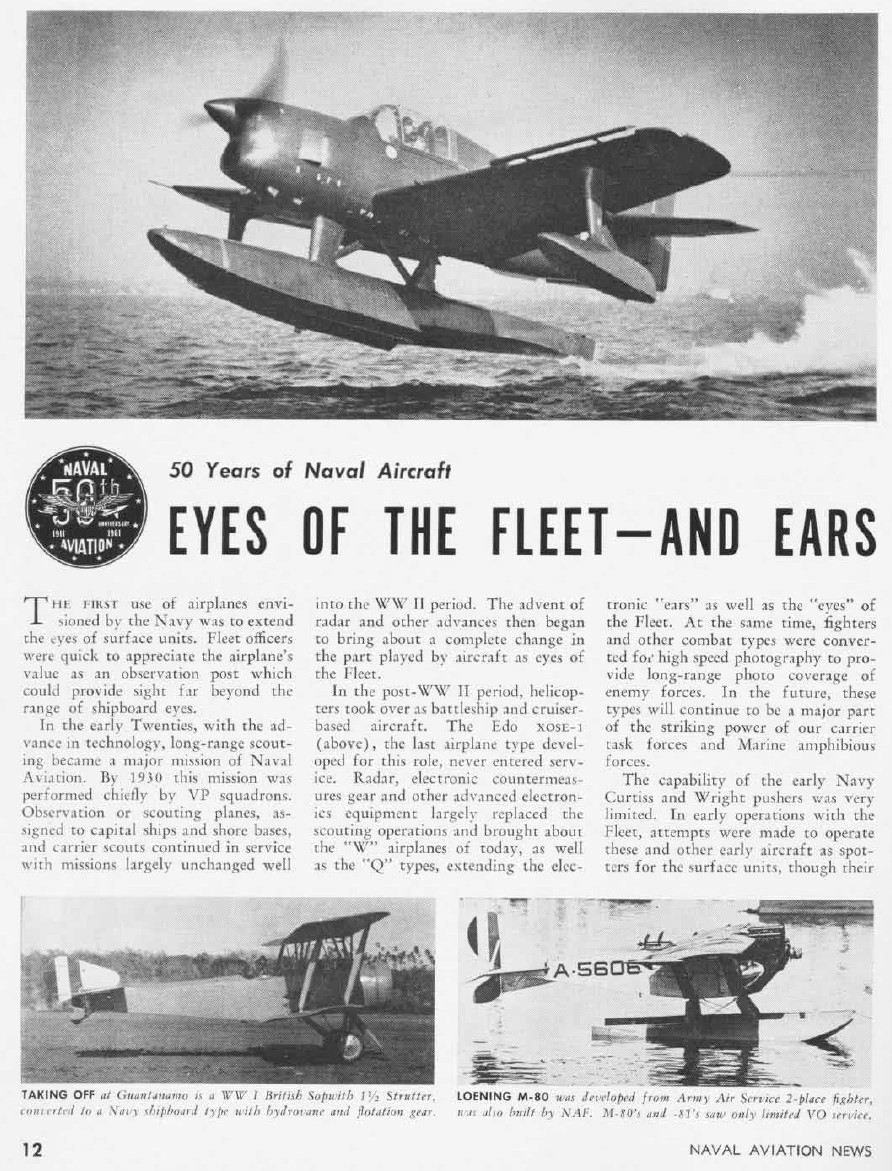
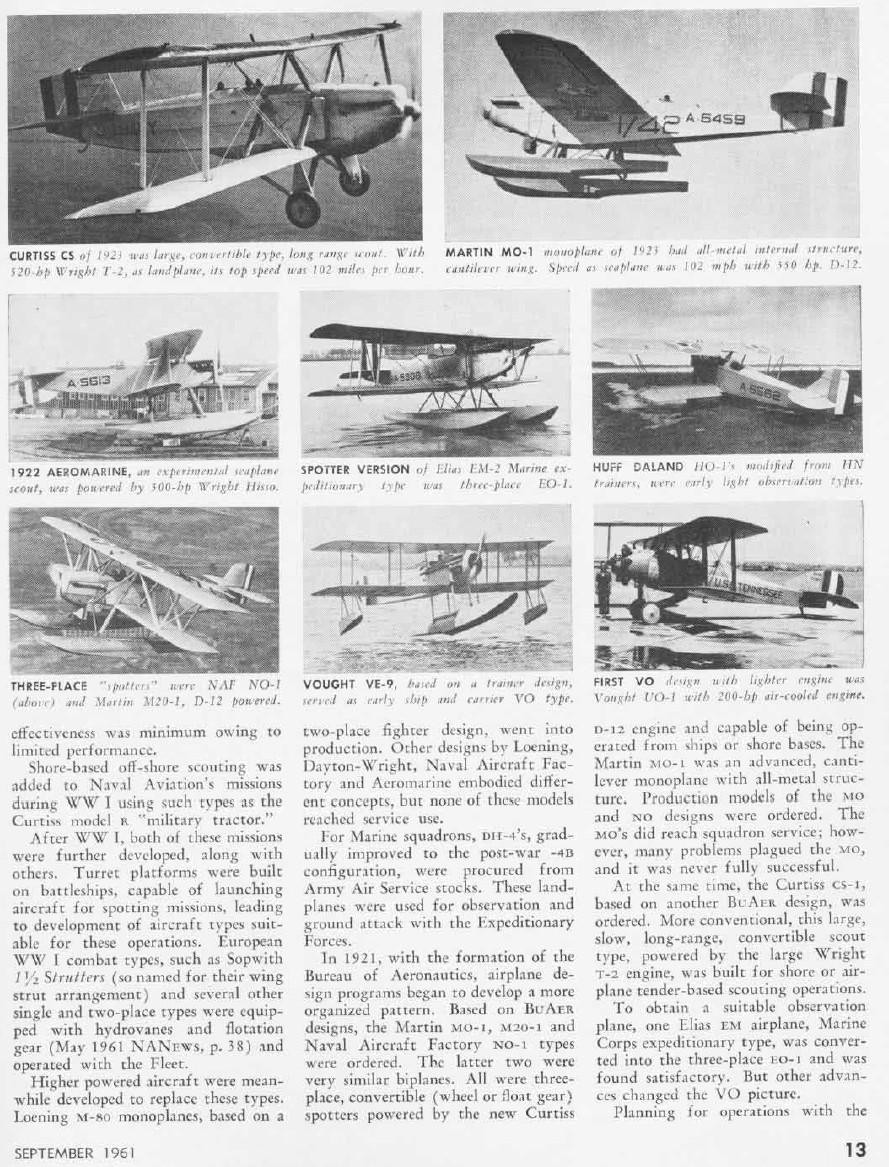

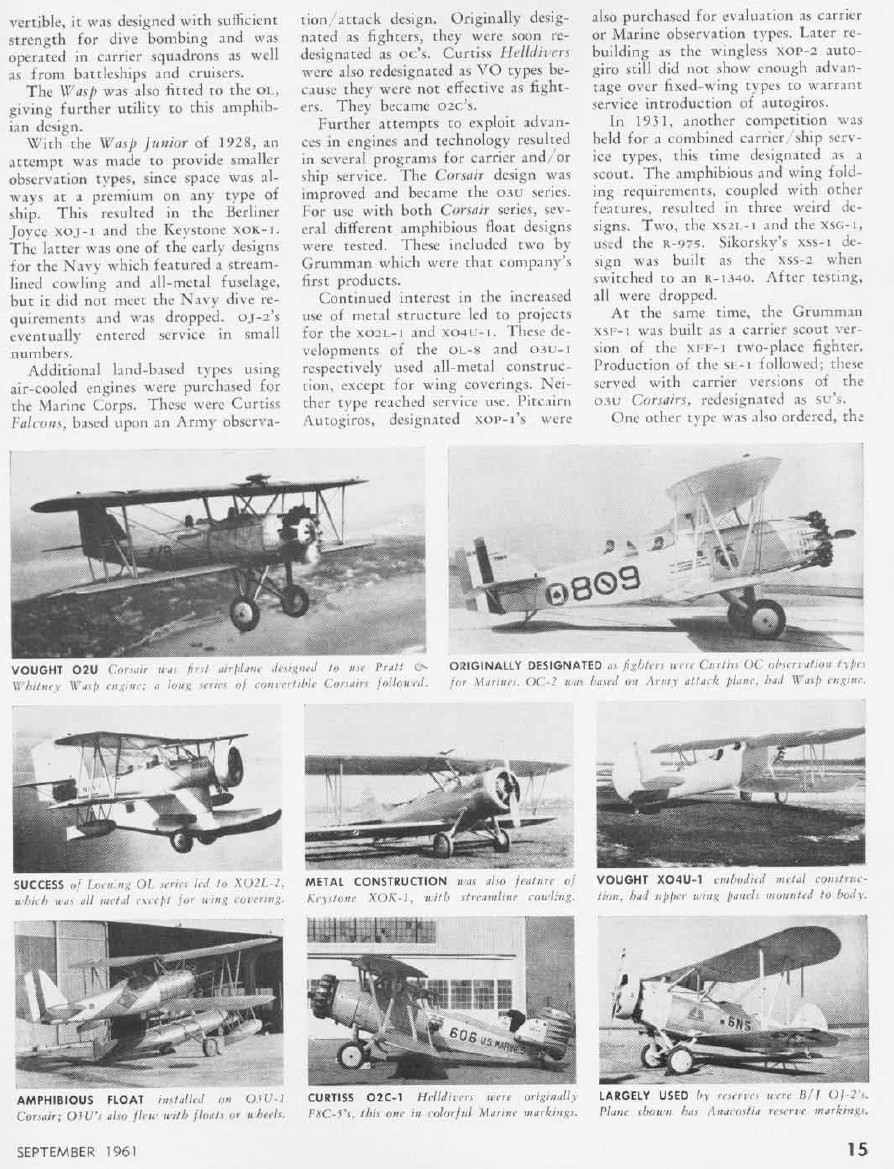
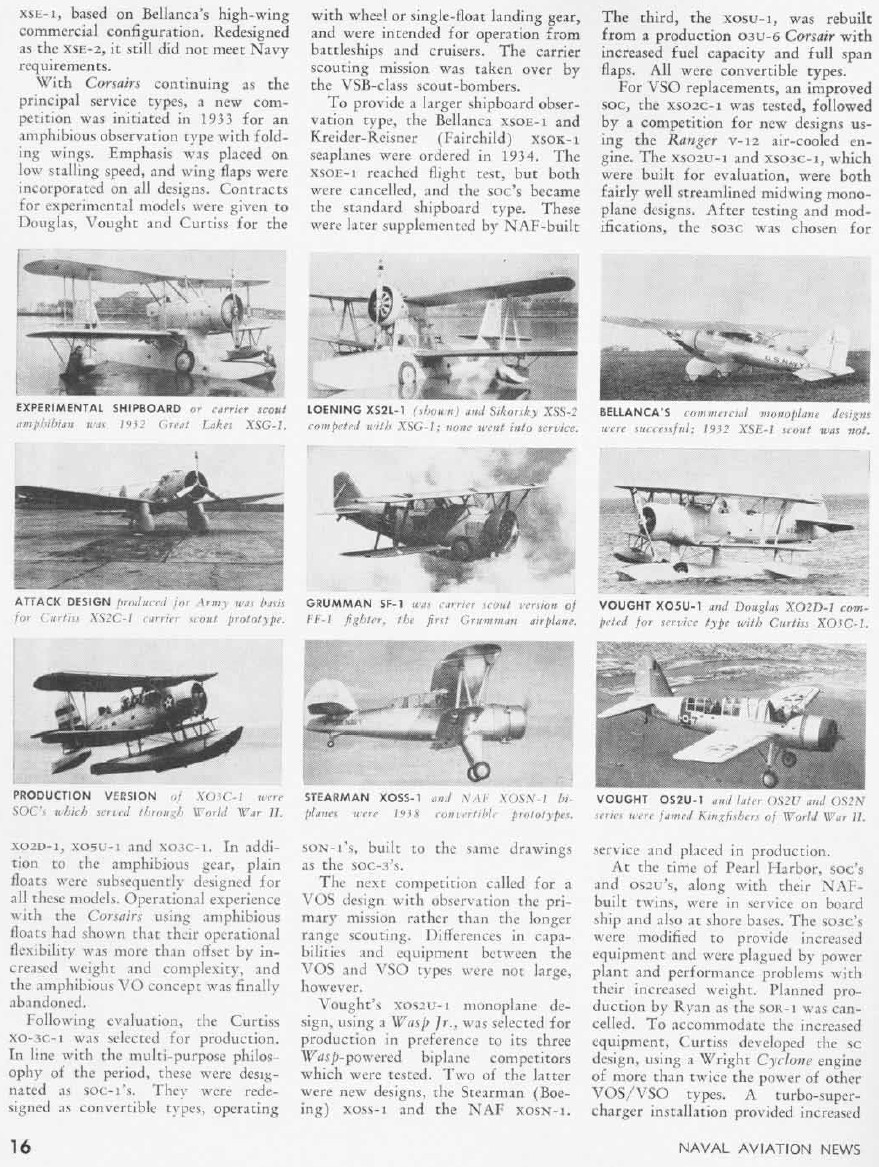
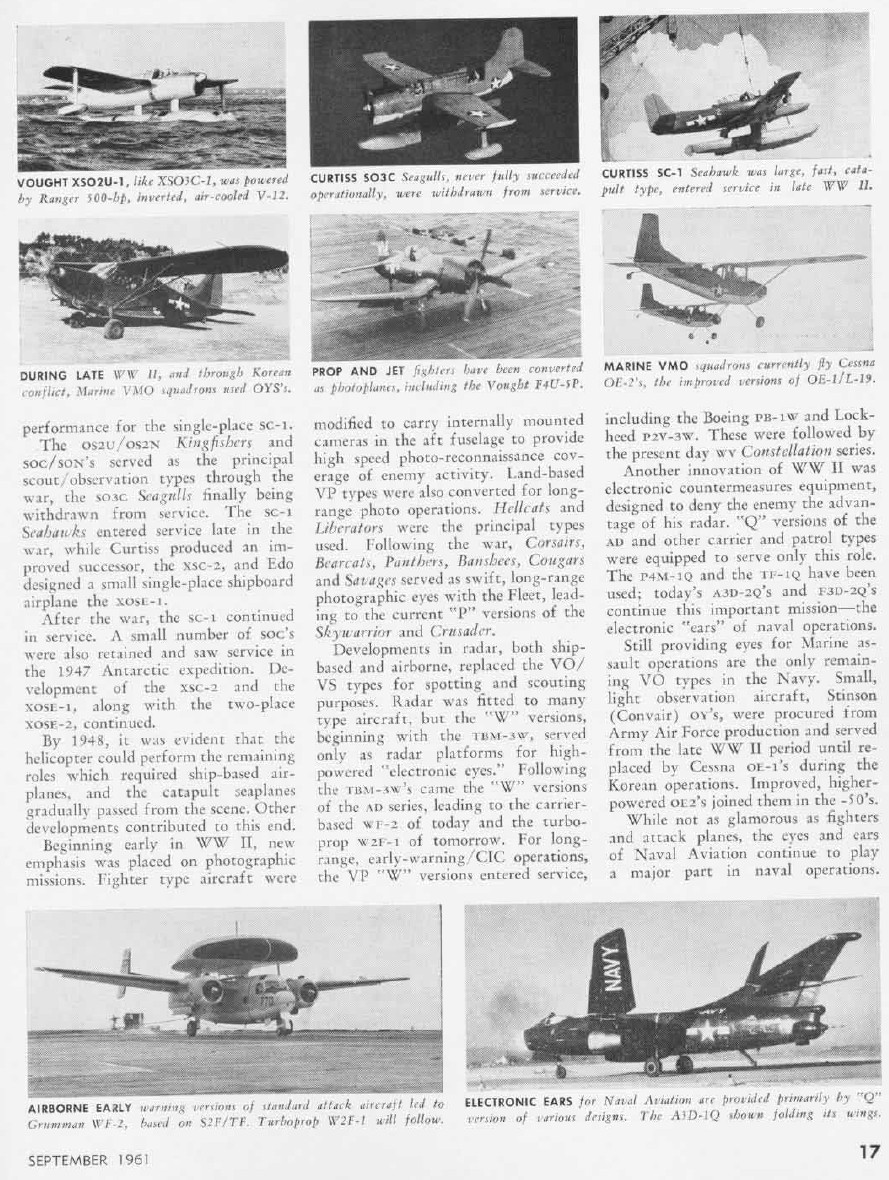
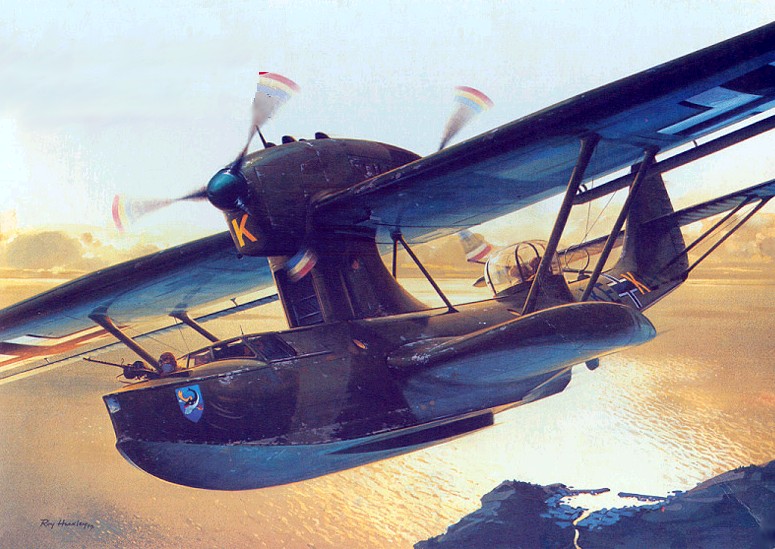
1938-1939
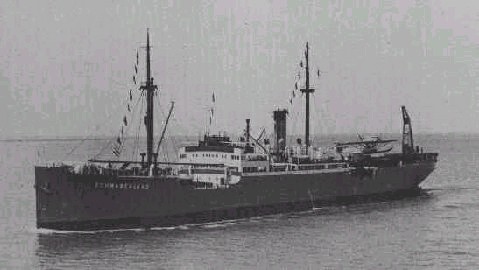
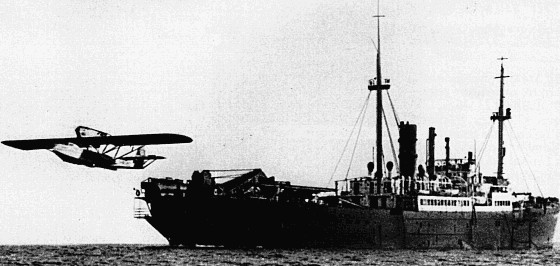
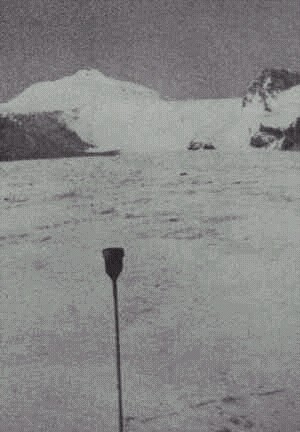
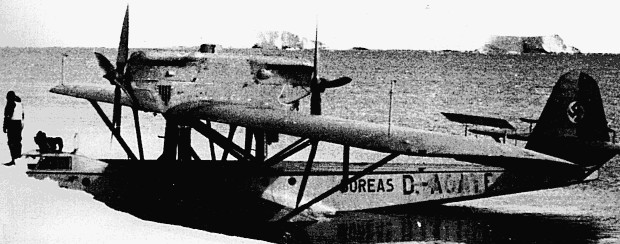
The German ship Schwabenland launches Dornier WA-30 Super Wal seaplanes over Antarctica to seize control of the South Pole. Markers are dropped with German swistika all over eastern Antarctica. Plans begin to colonize there by creating under-ice and underground bases and studying animal life there for food use.
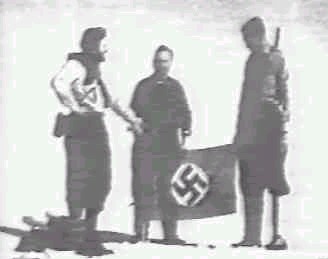
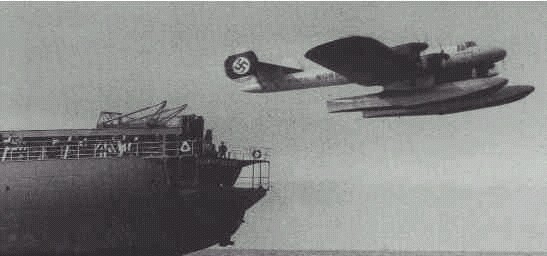
1940
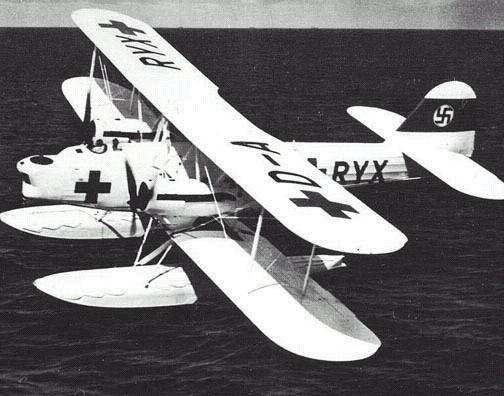
HE-59 multi-role seaplanes land German infantry and engineers to seize the Waalhaven bridges in Holland in a special operation.
1939-1945

If you strip away the sexy labeling and just look at things for what they are physically, the German merchant ships of WW2 were in actuality defacto cruisers. Physically they weighed about 5-10, 000 tons the weight of a light cruiser. What they lacked first off was ARMOR and SPEED. Maybe no armor isn't so bad if you're full of floatation foam so holes in your hull don't sink you? I didn't say a lack of MANEUVER because the RANGE of a German merchant ship with diesel engines was 50, 000 miles @ 15 mph!!! So while a warship might be able to do 35-40 mph it constantly needs to be refueled unless its nuclear powered.
So you have these German raider supply ships masquerading at times like Allied cargo ships but armed with large caliber guns, torpedoes to sink our individual supply ships not in convoys for protection prowling all over the world during early WW2. They even had float planes and small motor boats to scout ahead.
www.reocities.com/pentagon/2833/luftwaffe/seaplane/ar231/ar231.html
In WW1 these ships were called "Q" ships. The question is could we today do supply ship and special operations from disguised container ships even better with seaplanes and ASMs? Here's an example from the excellent German Military web site at geocities.com/pentagon/2833:
KMS Stier Technical Information
Name: KMS Stier, Schiff 23, Hilfskreuzer VI.
Type: light auxiliary cruiser.
Ex-name: Cairo, freighter.
Owner: Atlas-Levant Line.
Builder: Krupp-Germania Werft, Kiel.
Date of construction: 1936.
Converted by: WOK.
Date of conversion: 1941-42.
Date of commission: 10 May 1942.
Tonnage: 4,778 tons.
Displacement: 11,000 tons.
Length: 134 meters (Lloyds Register).
Beam: 17.3 meters.
Draught: 7.2 meters.
Freeboard: 10.3 meters.
Fuel type: oil.
Fuel capacity: 3,200 tons.
Speed: 14 knots.
Range: 50,000 nautical miles at 12 knots.
Cruising endurance: 173 days at 12 knots.
Maximum horse power: 3,750, turbines.
Propulsion: one 7-cylinder-Diesel.
Propellers: 1.
Number of decks: 2.
Number of holds: 5.
Number of compartments: 7.
Crew: 324.
Aircraft carried: 2 x Ar-231s.
Mines carried: ?
Armament: 6 x 5.9 inch guns (6x1), 2 x 37mm (1x2), 4 x 20mm (2x1), 2 x 21-inch torpedo tubes (2x1).
Length of cruise: 142 days, 9 May 1942 to 27 September 1942.
Ships sunk or taken:
Nationality Type Name Tonnage Date Result
Great Britain Freighter Gemstone 4,986 4 June 1942 Sunk
Panama Tanker Stanvac Calcutta 10,170 6 June 1942 Sunk
Great Britain Freighter Dalhousie 7,072 9 August 1942 Sunk
United States Freighter Stephen Hopkins 8,500 27 September 1942 Sunk
Grand total 4 ships 30,728
www.geocities.com/pentagon/2833/luftwaffe/seaplane/ar231/ar231.html
Auxiliary Cruisers Raiding Tactics
[General] [Aircraft] [Motor Launch] [Joint Operations]
The various tactics employed by the raiders are as different as their captains' personalities. Commanding an auxiliary cruiser and raiding are often described as fighting behind enemy lines. The lonely raiders were in action every minute they were at sea. Each captain had to adopt and adjust his tactics to increase the chance of survival and cause as much damage and confusion as possible.
General Tactics
Atlantis's captain Bernhard Rogge used the classic, traditional tactics of raiders. First he would signal the victim to stop. If the victim did not comply, then warning shots would be fired across the prey's bow. Usually the very lightly armed merchantmen would surrender, but many decided to fight, radio, or at least, run. This of course resulted in gunfire from the raider. The fight often lasted less than several minutes. The optimal places to hit were the victim's bridge, radio operating room and at the waterline; these were the targets for the larger-caliber guns. Anything else that moved on the deck would become targets for the 20mm and 37mm flak guns. Sometimes torpedoes were launched also, but too often they missed their targets. When the victim started lowering lifeboats and lit the white lantern, the German captain would order cease fire and start picking up survivors. These were standard procedures and used by many captains besides Rogge.
Widder's Hellmuth von Ruckteschell preferred attacking at night. This was rather risky for a raider, for it exposed the raider to close range return gunfire. It also required excellent lookouts, accurate navigational plotting and a lot of nerve. However, night attack enabled the raider to suppress a ship in the shortest time with the least ammunition while giving the smallest opportunity for the victim to fight or radio. He would sight a vessel during daytime, shadow and track all day, and emerge from darkness at extremely close ranges to deliver an overwhelming amount of gunfire. The only losers were the merchantman, which was fired upon whether it resisted or not, and the survivors, who were difficult to locate in dark water. Later Ruckteschell refined his tactics when he commanded the raider Michel. He would still attack at night, but now he would approach from the darkest part of the horizon, and if possible, run right into the victim to further prevent its escape. At about 2,000 yards from the prey, Michel would fire a star shell to illuminate the scene and let loose all guns to silence any and all potential resistance. The new technique was so effective that some vessels surrendered immediately without anyone getting hurt.
On the other hand, Kormoran's Theodor Detmers preferred warning shots during the day. This gave the merchantman a chance to stop without getting hurt. If the victim chose to stop this would save ammunition; if not, the warning shots would find the victim's range, serving a practical purpose.
Using the Seaplane
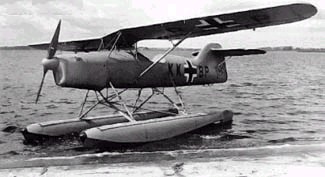
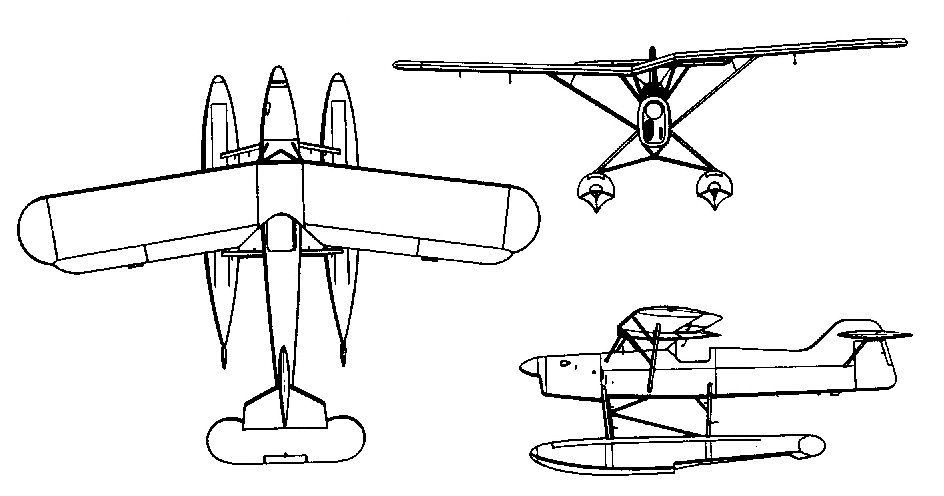
The ship-borne aircraft allowed a little more variety in tactics. Of course the aircraft greatly increased the spotting range of the raider. A typical aerial search involved the pilot flying a parallelogram search pattern. The seaplanes were sometimes disguised as British, but on at least one occasion the Nazi swastika was carelessly left on the tail. When a ship was sighted, the pilot would fly directly back to the raider, while trying to avoid being seen himself. Rogge's pilot introduced a new trick when he used a trailing hook to tear off a freighter's aerials, preventing it from radioing. If this was not enough, a couple bombs and machine-gun shells would usually convince the merchant captain to give up. This certainly saved many lives and greatly reduced the risk of the raider, which could remain unseen throughout the process. Pinguin's pilot had once played British and dropped a weighted message onto a freighter, informing the captain that a raider was near by and he should steer eastward, that is, straight toward the raider. Despite the obvious advantages of equipping ships with aircraft, only one raider (KMS Hansa) had a catapult, and it never had a chance to enter combat.
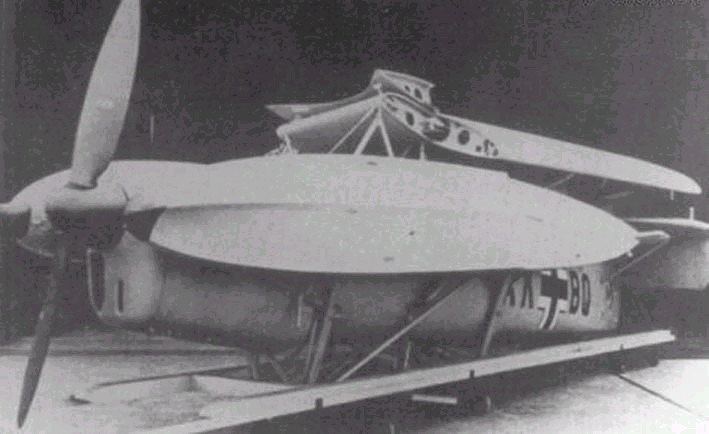
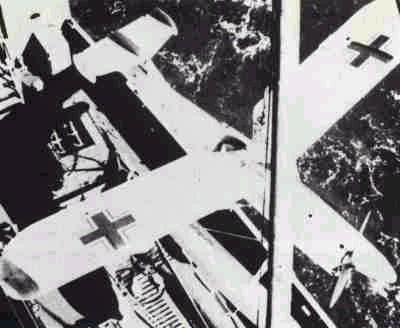
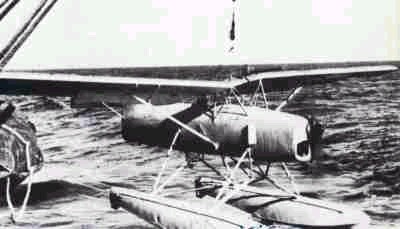
The Ar-231 was not excellent but decent enough to serve the raiders in the early days. The only good thing about the Arado Ar-231 is that it was small, very small.
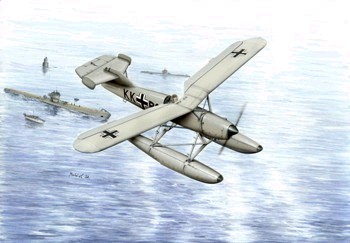
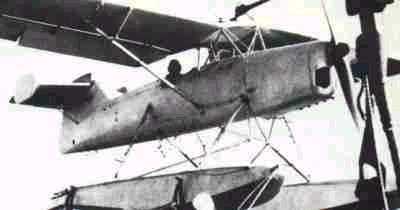
In fact it was so tiny that, after having folded one wing on top of the other, the Ar-231 could be stored in a submarine's watertight, cylindrical compartment, which was, of course, the intended purpose of the aircraft. The plane was, however, very difficult to handle in the air, even more so on water since it was so delicate and fragile. The Ar-231 could not take off save in the lightest winds and calmest seas. In addition, it was inadequately powered and sometimes the radio had to be removed and fuel drained to reduce weight. The program was dropped after some testing in 1941-42, six having been built. The auxiliary cruiser KMS Stier took two Ar-231s with her
Using the Motor Launch
Some of the raiders were also equipped with motor launches, but none was used better than Michel's Esau. It was frequently sent to stalk and shadow the prey, and if conditions were right, to torpedo it. On one occasion, Michel was able to attack two ships in one night by sending Esau to slow one of them. On another, Esau's men tried to play British and convince a merchantman to stop, but their white uniform betrayed them -- wearing white on motor launches was not a standard Royal Naval practice. The versatile little boat could also silently torpedo merchantmen at night, making it look like a U-boat attack and causing the victim to send erroneous messages. Esau could also be armed with depth charges and act as an escort against submarines, which was done when Michel was racing towards Japan for the first time.
Fast motor launch LS 4, christened Esau, before being put aboard the auxiliary cruiser Michel. This was the only one of the three LS boats carried by auxiliary cruisers which actually went into action.
Joing Operations amongst Raiders
For security and practical reasons, raiders rarely worked with each other. Two merchantmen sailing together would look awfully suspicious to Allied aircraft and warships. If they were caught, Germany would lost two or more precious raider at once -- too heavy a price for whatever advantages joint operations could bring. In reality, however, the raiders had frequently rendezvoused with each other and even fought jointly on two occasions. Usually they just sailed to pre-designated meeting points to exchange supplies, prisoners, intelligence and a hip-hip-hurrah. In the first joint operation, Komet and Orion sank several ships together. In the second, Michel and Stier tried but caught nothing. The general tactics for joint operations called for the raiders to sandwich the victim and close in from both sides. The risks were great, for if the victim radioed, then two raiders would be exposed to danger, but the chance of sinking a merchantman was not much better than a lonely raider's. Thus joint operations were carried out only in low-risk waters for short periods of time.
German Ar-196 Floatplanes
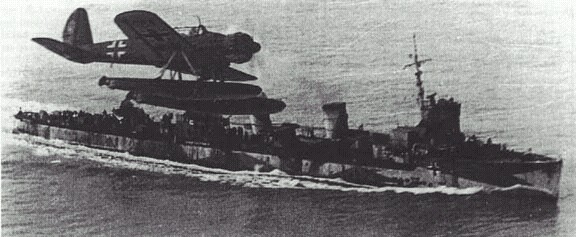
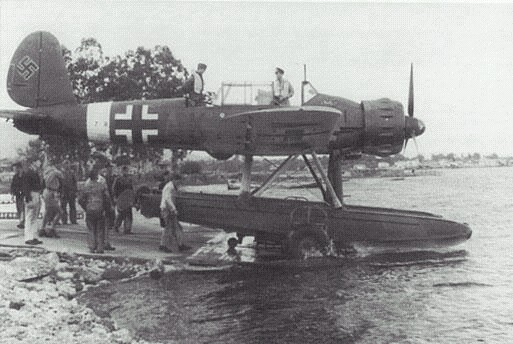
The German surface ships when they got into action past the Royal Navy blockade made great use of their Ar-196 seaplanes, which were even used on their own from shore bases. Had the battleship Bismarck's Ar-196 been able to intercept and shoot down the larger RAF PBY Catalina seaplane, she might have made it to France and not been sunk.
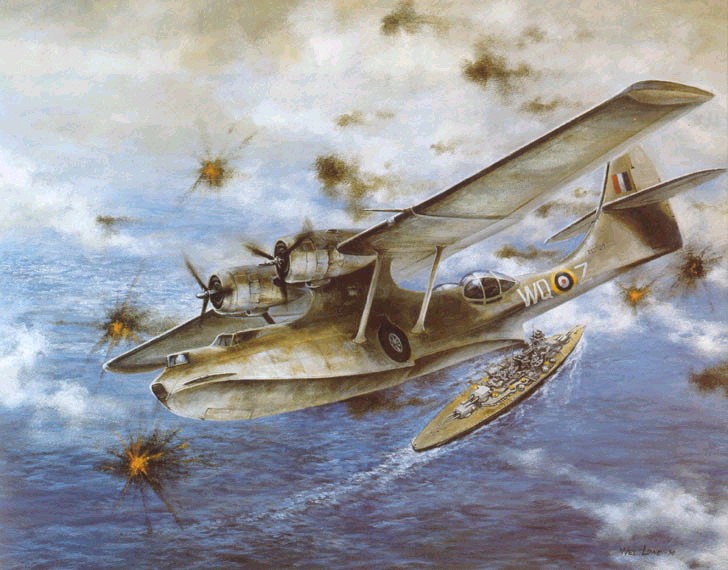
For those who may have not read the story in the "Stories of Japanese Aircrews" section, below is a link to a short story about a German Ar-196 that was based in the Pacific. Thanks to Hiroyuki Takeuchi for posting this story!
WWW.J-AIRCRAFT.COM/research/stories/yasunaga1.html
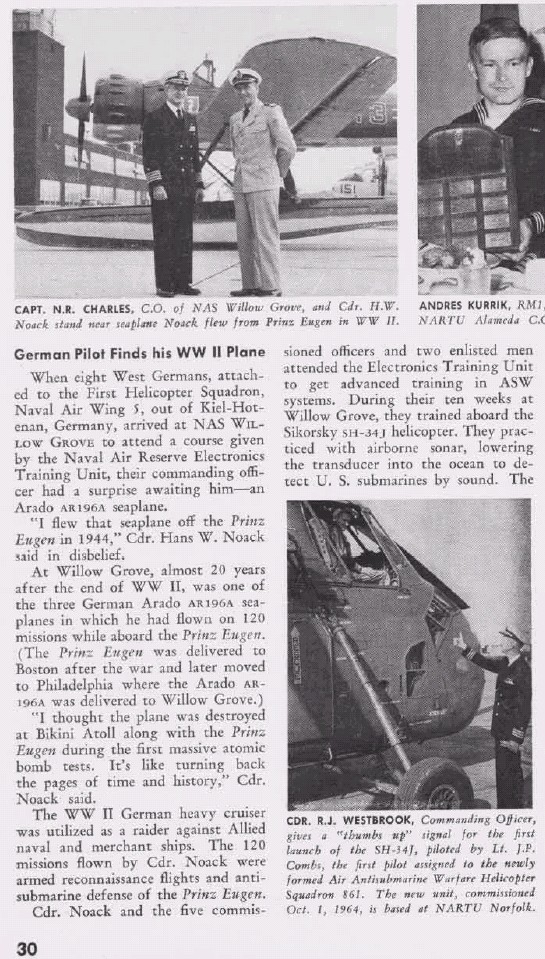
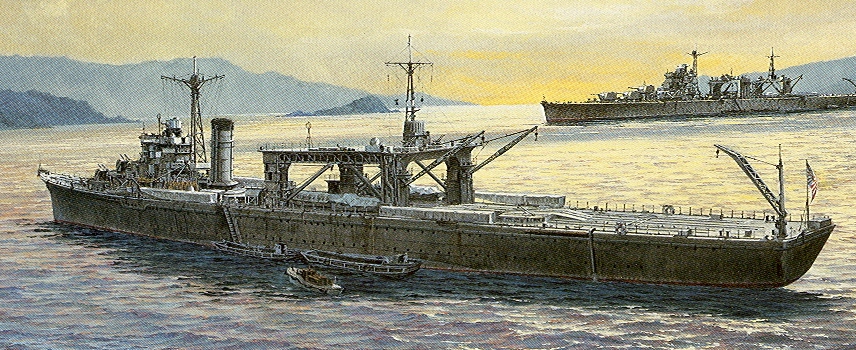
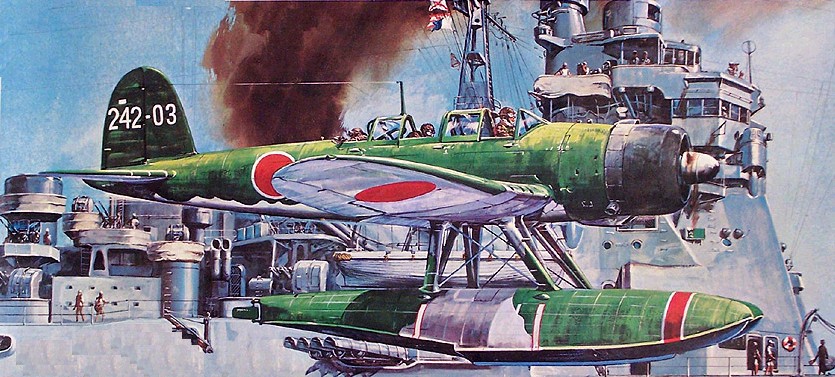
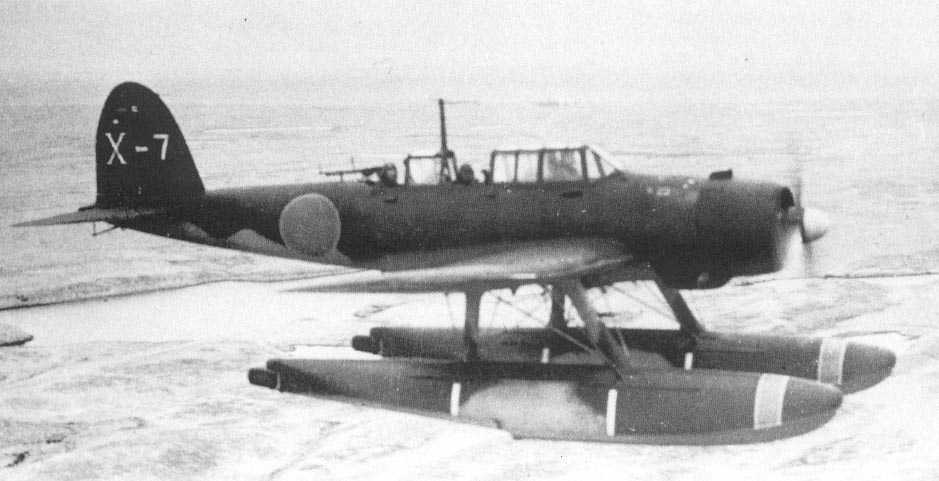
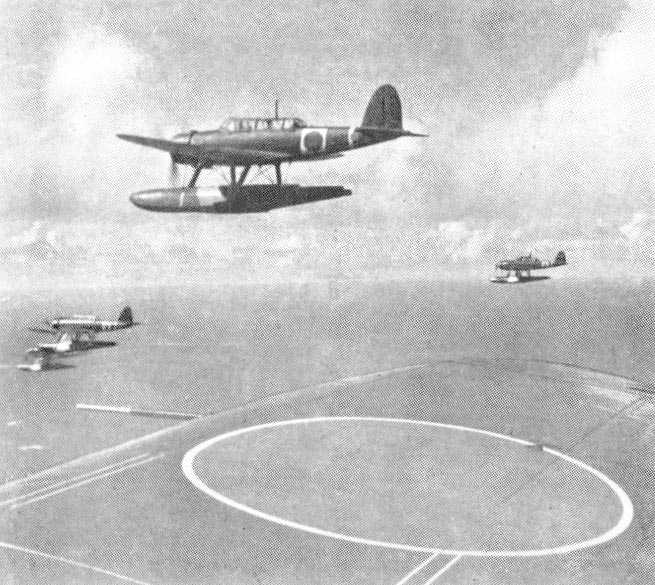
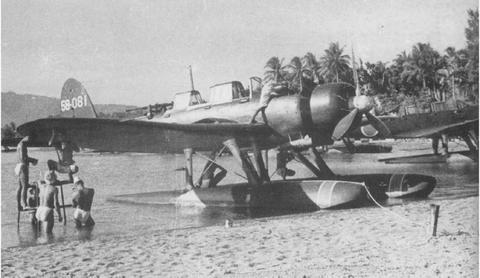
An Aichi E-13A "Jake" reconnaissance floatplane of the Imperial Japanese Navy (IJN)
www.youtube.com/watch?v=yL2gDP2FyUQ
In June 1937, The Imperial Japanese Navy issued a specification to the Aichi, Nakajima, and Kawanishi companies calling for a two-seat reconnaissance floatplane of monoplane configuration to replace the aging Kawanishi E-7K2 "Dave" three-seat twin-float seaplane. The three manufacturers responded with three prototype designs designated E-12A, E-12N, and E-12K, respectively. But even as these three designs were being created, a new specification was issued calling for a larger, three-seat monoplane reconnaissance seaplane, with higher speed and longer range for convoy escort duty. Three additional designs were created by the engineering teams of the companies involved, intending to compliment rather than replace earlier designs. These were designated Aichi E-13A, Nakajima E-13N, and Kawanishi E-13K. Aichi was the only one to build both of its designs with Nakajima deciding to concentrate on the two-seat version while Kawanishi concentrated on the three-seat version.
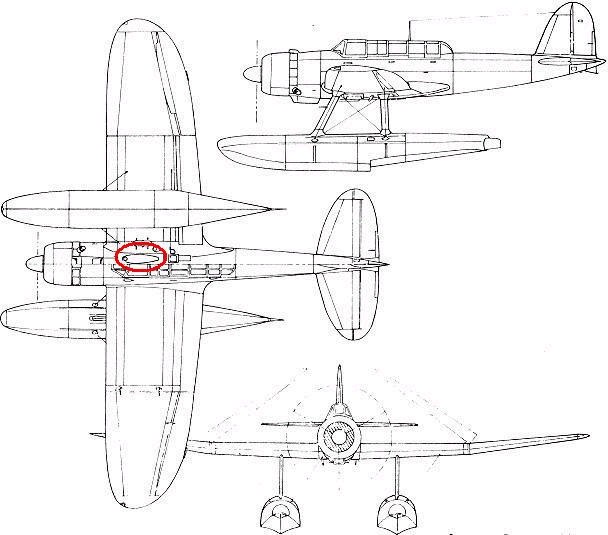
Kishiro Matsuo's design team created both the E-12A and the E-13A, the latter being merely a larger and more powerful version of the former. The first E-13A was completed in late 1938 and powered by a 1,080 hp (805 kW) Mitsubishi Kinsei 43 14-cylinder air-cooled radial (which was retained throughout the life of the type). During manufacturer's test flights, it became plain that the E-13A was superior to the smaller E-12A. Not withstanding its larger size and heavier weight, it was much more stable and manoeuvrable, and also had far better performance. By this time, the Navy had decided they wanted a three-seat aircraft and not a two-seater, so development of the two-seat E-12A and E-12N was halted. Service test pilots flew the prototype E-13A in competition against two prototype E-13Ks built by Kawanishi. In December 1940, the E-13A was formally declared the winner and was accepted for production as the Navy Type 0 Reconnaissance Seaplane Model 11, or E-13A1 Model 11.
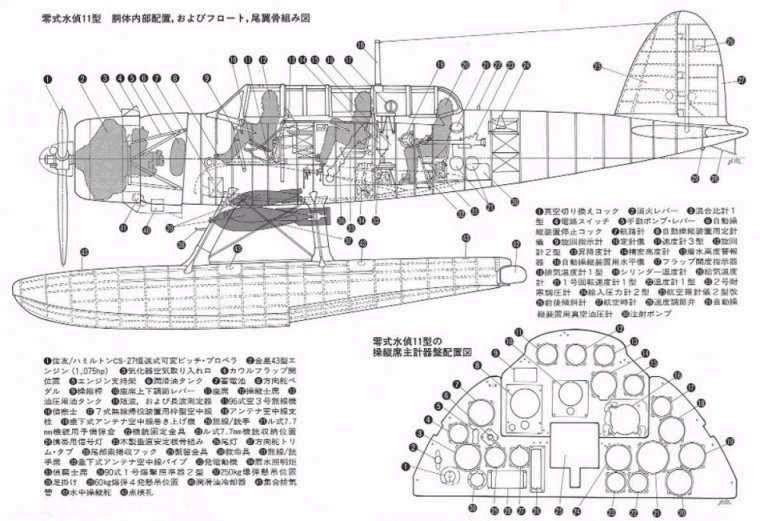
Aichi built 133 x E-13A1s through early 1942, when they were ordered to concentrate on building the Yokosuka-designed D-4Y carrier dive bomber and recon plane. At that time, primary builder of the E-13A became the Watanabe Tekkosho (Watanabe Ironworks Company Limited) which in 1943 was re-organized as Kyushu Hikoki KK (Kyushu Airplane Company Limited). Total aircraft production was 1,418 aircraft. Aichi Tokei Denki KK building 133 aircraft from 1939-42, Watanabe/Kyushu building 1,237 aircraft from 1942-45 and Dai-Juichi Kaigun Kokusho (11th Naval Air Arsenal) building 48 aircraft from 1940-42.
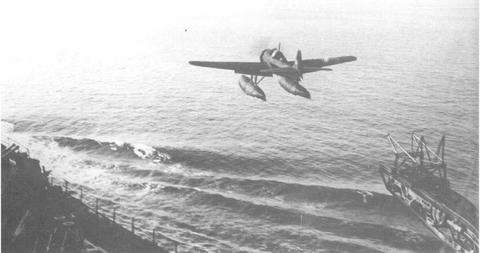
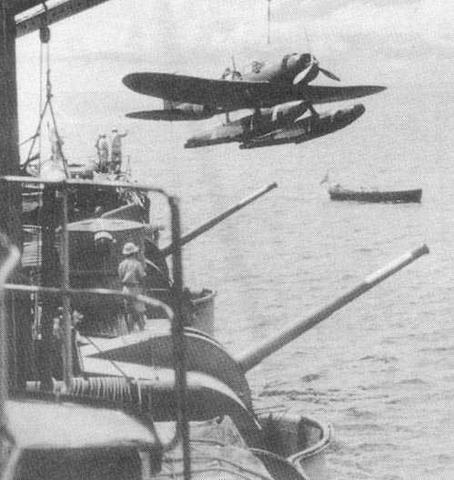
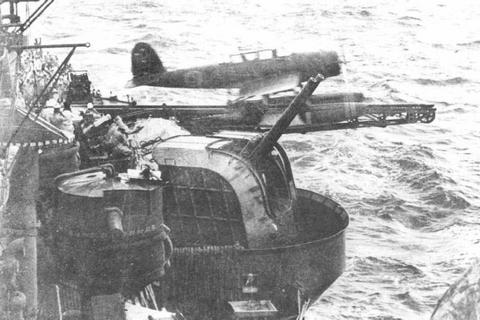
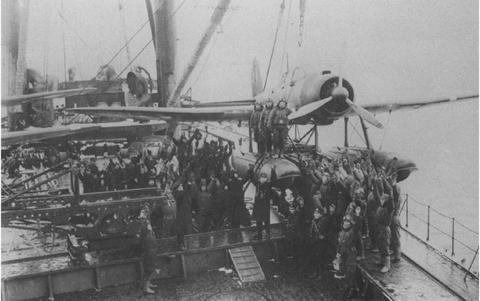
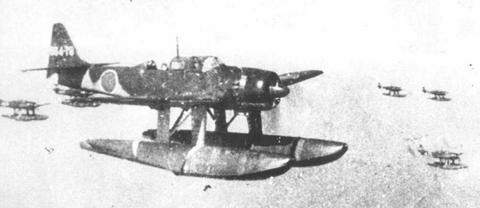
The Aichi E-13A1 made its combat debut over China in the autumn of 1941. Operating from the catapults of cruisers and seaplane tenders, aircraft of this type made air attacks on the Canton-Hankow Railroad, and also flew anti-shipping patrols along the China coast. Its next combat sorties were flown over Hawaii, launched from the cruisers Tone, Chikuma, and Kinugasa. Aichi E-13A1s flew reconnaissance over the area of Pearl Harbour shortly before the attack, pinpointing the positions of the American ships in the harbour and noting that all was quiet, and the Americans were not on alert. From then on, E-13A1s were committed wherever the Japanese Navy was operating. Flying from either ships or shore bases, as required, the E-13A1 was quite successful as long as Allied fighter opposition was limited, despite its poor fuel and crew protection and its pitiful defensive armament (a single 7.7 mm (0.303 in) machine gun in the rear cockpit). It could carry either one 551 lbs (250 kg) bomb under the fuselage between the floats, or four wing-mounted 132 lbs (60 kg) bombs or depth charges. Its maximum endurance was almost fifteen hours, giving it a useful range for patrol and reconnaissance missions. In addition to limited bombing strikes and long-range patrol sorties, the "Jake" as she was code-named, also was used for staff transport, air-sea rescue, anti-shipping attack, and, later in the war Kamikaze attacks.
For nearly four years, the Jake was built without any changes from the original prototype. In November 1944, two new subtypes were introduced, differing externally from the regular E-13A1 only by the additions of a propeller spinner for the three-bladed propeller, and two extra pairs of inward-sloping bracing struts for the twin underwing floats. The E-13A1a Model 11A received improved radio equipment, while the E-13A1b Model 11B was fitted with an air-to-surface search radar, with antennae protruding from the fuselage sides and from the wing leading edges. Either of these versions could be fitted with exhaust flame dampers for night operations, and for anti-shipping attack (usually against surfaced submarines or PT boats), a single flexible Type 99 20mm cannon, firing downwards and forwards from the fuselage belly, could be mounted, as well. Some Jakes were also fitted with an aerial magnetic submarine detection device, called Jikitanchiki, which required the aircraft to fly at a very low 30-40 ft (9-12 m) above the sea's surface to get any decent results.
Due to the theatre the Japanese operated in and the vast expanses of ocean it encompassed, long-range seaplanes were crucial to the Japanese war effort. The Aichi E-13A served from Pearl harbour to some of the last Kamikaze attacks of the war. Although easy fodder for Allied fighters the Aichi E-13A and its crews performed their missions well throughout the Pacific War.
Variants
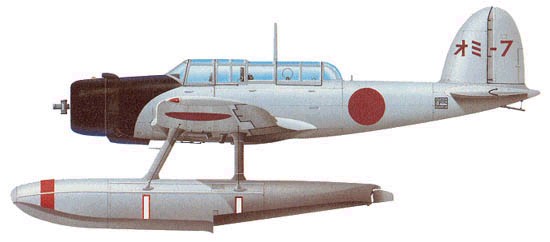
Aichi E-13A1a Model 11A - Introduced in late 1944 this type featured two extra pairs of inward-sloping bracing struts for the twin underwing floats, a propeller spinner and more advance radio equipment.
Aichi E-13A1b Model 11B - Based on the Aichi E13A1a Model 11A but fitted with ASV radar with antennae protruding from the fuselage sides and from the wing leading edges and usually equipped with the Type 99 20mm cannon. Either of these versions could be fitted with exhaust flame dampers for night operations against allied shipping.
(Navy Type 0 Reconnaissance Seaplane Model 11 - Aichi E-13A1)
Allied Codename: Jake
Type: Three Seat Long Range Reconnaissance Floatplane
Design: Aichi Tokei Denki Kabushiki Kaisha Design Team led by Kishiro Matsuo
Manufacturer: Aichi Tokei Denki KK in Funakata (133 aircraft from 1938-1942) then Watanabe Tekkosho (Watanabe Ironworks Company Limited) in Zasshonokuma later re-organized in 1943 as Kyushu Hikoki KK (Kyushu Airplane Company Limited) (1,237 aircraft from 1942-1945) and Dai-Juichi Kaigun Kokusho (11th Naval Air Arsenal) at Hiro (48 aircraft from 1940-1942).
Powerplant: One Mitsubishi Kinsei 43 14-cylinder air-cooled twin-row radial engine rated for 1,080 hp (805 kW) at 6,560 ft (2000 m) and 1,060 hp (790 kW) at take-off.
Performance: Maximum level speed 233 mph (375 km/h) at 7,150 ft (2180 m); cruising speed 137 mph (220 km/h) at 6,560 ft (2000 m); service ceiling 28,640 ft (8730 m); climb to 9,845 ft (3000 m) in 6 minutes 5 seconds.
Range: 1,299 miles (2090 km) on internal fuel.
Weight: Empty 5,825 lbs (2642 kg) with a maximum take-off weight of 8,025 lbs (3640 kg).
Dimensions: Span 47 ft 6 3/4 in (14.50 m); length 37 ft 0 3/4 in (11.30 m); height 15 ft 8 1/2 in (4.78 m); wing area 387.51 sq ft (36.00 sq m); wing loading 20.7 lbs/sq ft (101.1 kg/sq m); power loading 7.6 lbs/hp (3.4 kg/hp).
Armament: One 7.7 mm (0.303 in) Type 92 medium machine-gun on flexible mount in aft position, plus up to 551 lbs (250 kg) of bombs. A Type 99 20mm cannon could be mounted on a ventral flexible mount for anti-shipping strikes.
Variants: E-13A (prototype), E-13A1 Model 11, E-13A1a Model 11A (improved bracing and a more advanced radio), E-13A1b Model 11B (ASV radar).
Avionics: (E-13A1b Model 11B) ASV radar. Some Jakes were also fitted with an aerial magnetic submarine detection device, called Jikitanchiki.
History: First flight late 1938; entered service (navy) late 1941; production (E-13A1a) late 1944.
Operators: Japan (Imperial Japanese Navy)
Units: Aircraft Tenders - Chitose, Chiyoda, Kimikawa Maru. Battleship - Haruna. Cruisers - Kinugasa, Atago, Takao, Chokai, Maya, Kumano, Chikuma, Tone, Suzuya, etc. Kokutais - 5th, 7th, 19th, 21st, 36th, 40th, 901st, 932nd, 955th, Chichijima and Sasebo.
As you may know, Japanese submarines chose to attack our warships not our supply ships. Was this the reason they didn't put a floatplane on their own merchant/supply ships to protect them from our marauding patrol PBY Catalina seaplanes and Gato class diesel-electric submarines with gunfire and depth charges?
Unlike the Hurricat, a Japanese float seaplane could be RECOVERED and USED AGAIN and again, the Hurricat was a one-way mission followed by a ditching at sea. If they had emphasized ASW their floatplanes could have had a small search radar or magnetic anomoly detector (MAD) to help them hunt down American subs. We know a few E-13A1 "Jake" seaplanes were fitted with MAD and radar gear but not in great numbers nor on supply ships to defeat our submarines.
Thank God, the Japanese were narrow-minded and saw war as only a duel between combatants, neglecting the logistical aspects.
Pete and other floatplanes were used in a concerted effort against allied submarines and other naval targets of opportunity from military ships and lagoon seaplane bases. Often it was a case of patrolling floatplanes launched from IJN warships finding targets as they arose--visually. Nearly every one of their seaplane aircraft carriers were SUNK BY U.S. SUBMARINES! So they could defend themselves from air attack, but with neither their aircraft or their hulls fitted with sonar and depth charges, they were vulnerable to fatally submarines. Unlike the Allies vanquishing the German U-Boats, the Japanese never came up with a formula to defeat American subs even though the latter were shooting defective torpedoes and the former had the best seaplanes of the war to do ASW IF they had made an effort to maximize their potential.
Japanese Small Seaplane Exploits in WW2
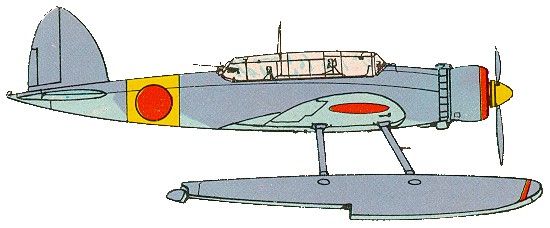
Here are U.S. submarines/ships Japanese float planes successfully attacked, damaged and sunk. If more of them had been properly equipped with ASW/ASuW Jikitanchiki MAD/radar they might have been decisive like our planes were against their shipping and submarines. For Jikitanchiki MAD to detect submarines the aircraft had to fly no higher than 60 feet above the water.
USS Amberjack - 958 Ku (E-13A1 Jake) assisted
USS Grenadier - 936 Ku (E-13A1 Jake/B-5N2 Kate)
USS Wahoo- Ominato Ku (E-13A1 Jake) Yet to be confirmed) assisted
USS Cisco - 954 Ku (F-1M2 Pete) assisted (Probably sunk)
USS Gudgeon - 901 Ku (E-13A1 Jake) Unassisted
USS Harder - 901 Ku (E-13A1 Jake) assisted
USS Scamp - 453 Ku (A-6M2N Rufe) Yet to be confirmed - unassisted
USS Bullhead - 73rd FCS (Ki-51) Unassisted
www.ww2pacific.com/java.html
1942
27 February
www.chuckhawks.com/heavy_cruisers.htm
February of 1942 found [British heavy cruiser HMS] Exeter, along with four other Allied cruisers (total: two heavy, three light) and nine destroyers of the ABDA (American, British, Dutch, Australian) striking force, in the Java Sea. They were attempting to interdict the Eastern Japanese amphibious landing force heading for Java, and were engaged by the covering force of four Japanese cruisers (two heavy and two light) and thirteen destroyers.
The battle on February 27th was a long and complicated series of gun and torpedo duels that lasted from 4:16 PM in the afternoon to almost midnight. At 5:08 PM Exeter was hit in the boiler room by an 8in shell, which caused her to sheer out of line in a 90 degree turn to port. Her speed was reduced to 16 knots. Admiral Doorman (ABDA force commander) ordered Exeter to Surabaya, escorted by one destroyer. She took no further part in the battle, which ended hours later with the loss of two Allied light cruisers, and three destroyers (plus Exeter heavily damaged). The Japanese suffered no losses. They were greatly aided by their float planes, which were able to spot their fall of shot for them, and keep track of the position of the Allied force. The ABDA force had no float planes, having landed them in anticipation of a night battle.
March
Battle of Sunda Straight
U.S. destroyer Pope (DD-225), the third ship in the force, escapes the Japanese cruisers but is located and damaged by floatplanes from two seaplane carriers and carrier Ryujo; scuttling is in progress when two heavy cruisers deliver the coup de grace with gunfire.
9 Apr 42. PT-34 is bombed and strafed by floatplanes from Japanese seaplane carrier Sanuki Maru and destroyed off Cauit Island, P.I.
29 May 42. The Japanese submarines I-10, I-16 and I-20 arrived in area around Madagascar island off the eastern edge of Africa where the British were landing troops. I-10's reconnaissance plane spotted the battleship HMS Ramillies at anchor in Diego Suarez harbour but, the plane was seen and Ramillies changed her berth. I-20 and I-16 launched two midget submarines, one of which managed to enter the harbour and fired two torpedoes, while under depth charge attack from two corvettes. One torpedo seriously damaged Ramillies, while the second sank an oil tanker (British Loyalty, later refloated). Ramillies was later repaired in Durban and Plymouth.
There were other seaplane and landplane attacks that forced American submarines to abort entire patrols. Most notable was a rare MAD-equipped G-3M Betty that damaged the USS Salmon so badly, she never returned to service!
Offensive actions against land and sea targets?
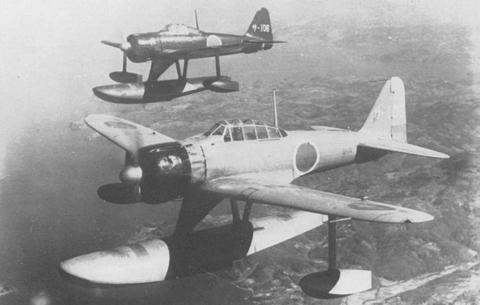
It has been fairly well known that at least a big part of the reason for the advent of the Rufe was to support troops in extreme forward areas where no land bases existed and since the IJN didn't have many aircraft carriers. The A-6M2N was was designed for a mission which resulted from tactical considerations. How it was included in the global strategy of the Imperial Navy?
First the global strategy of the IJN, under the influence of Admiral Yamamoto, was to BUY TIME. Yamamoto was well aware of the definitive handicap of his country in the industrial field. Clearly, the only chance to preserve the essential was for him to neutralize the allies in the Pacific long enough to permit the Empire to exploit its conquests to come. This was to be done by a kind of two-pronged movement. One in the Central Pacific area (of which Pearl was the first manifestation) with a strictly tactical aim and one to the south with mainly economical aims. Then having neutralized the military power of the allies in the Pacific for some years and having stretched to the limit their abilities to go in contact with their opponents considering the state of the technology at this time, to obtain a kind of peace by compromise to let them keep the territories/resources they had stolen. (Yamamoto was never as foolish as to think of a total military victory).
To achieve these goals, though the IJN was only slightly more powerful with aircraft carriers, the IJNAF knew perfectly they would have to fight in airfield-less archipelagos in SWPA with the ever-present menace for the landing parties of the intervention of American troops backed by long-range heavy bombers and Catalina seaplanes with bombing capabilities. There was no equivalent in efficiency between the Japanese pioneers and the USN Seabees. The movie "Bridge over the River Kwai" reveals a typical Japanese impatience for engineering and to try to make do with expedients. The Japanese pioneers heavily relied on their hands and hand tools, while the Seabees on fossil fuel-powered machinery like Caterpillar tracters and their achievement in airfield construction was stunning even for the US. Remember Henderson field at Guadalcanal was originally an unfinished Japanese airfield and no airfield was available beside those far North in Rabaul and New Guinea! ... The IJN knew also very well that there were not enough carriers to cover such a bewildering surface area that they had taken.
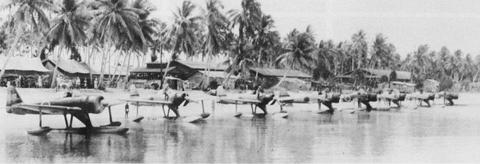
So was born the idea to use a very flexible fighter force on floats which, attached to tenders, could operate from any relatively quiet water, from a lagoon to a sheltered bay. The purpose of this fighters on floats was not pure air-to-air combat point defense with U.S. fighters supposedly absent from the theater of operation. They were designed to intercept the heavy bombers and long-range seaplanes that should interfere with their troop landing operations (and until the high altitude B-29s came they fairly well succeed in so doing) and like their land planes counterparts they were also to perform strafing and light bombing operations as close air support aircraft for the troops in contact. Thus, they were supposed to gain air supremacy and provide a valuable "flying artillery" when their was no enemy airfield so near as to permit fighter operations and to replace scarce carriers that should be employed elsewhere when the defensive potential of the target included a fighter force and no "friendly" airfields was available for a land based fighter force.
Technically and tactically the concept was very valuable if things had happened the way Yamamoto anticipated. The loss of aerodynamic flight performances was minimal and only critical when fighter opposition was present. Facing a bomber of the B-17 - B-24 generation it was by no mean a handicap to perform interception.
Unfortunately for the Japanese, these ideal conditions failed to materialize. For example with Henderson field and Cactus Air Force at hand the Santa Isabel based floatplane fighters were just considered "pesky" and tough opponents, but not able to establish air superiority.
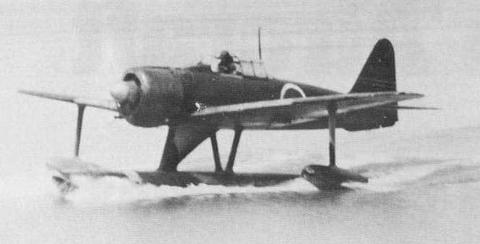
Beside, the Type 2 Floatplane Fighter was to be only an interim model before a specifically developed aircraft became available with much more power to compensate for the loss in performance induced by the floats. This was to be the Kawanishi N-1K1 Kyofu. But when it finally became operational the tactical situation has changed to a point it was useless (the reason for which, though technically successful, it was produced in such a small number).
After gaining some successes as bomber interceptors (and few in TIC flying artillery as its entry in operational service was almost contemporary to the end of Japanese expansion), the most useful role these models performed was probably convoy escort with depth charges or bombs against the submarines (though the plane was deprived of ASW detection devices) and with more capabilities to intercept allied modern long range snoopers than the Pete. Their last successes in aerial combat were obtained in defense of the oil fields of the then occupied NEI against bombers as long as allied carrier-based fighters didn't put an end to their activities. The Kyofu [Rex] was then the troublemaker as the Type 2 was now relegated to training or convoy escort duties.
All in all, it was a clever idea that never had a chance to win. As an offensive weapon they came too late to be really useful. As a lagoon-based air power concept, seaplanes were rapidly not needed because of the Seabees unexpected efficiency that came as a surprise and permitted the allies to have a fighter support in the most remote areas where no airfield was available before as quick as they advanced. Nevertheless, they were ever respected by their foes as potentially dangerous and surprisingly good performers.

The allies tried to develop similar ideas (Spitfire, Wildcat to quote but of a few) but abandoned them before they entered service because they knew they had better to rely in fast airfield construction capabilities which permitted the use of current fighter designs with no loss in performance.
CAM "Hurricats"
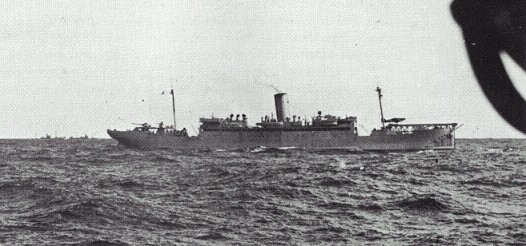
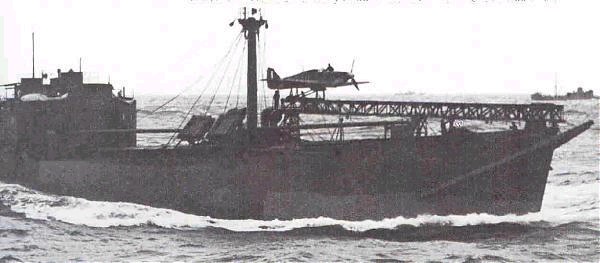
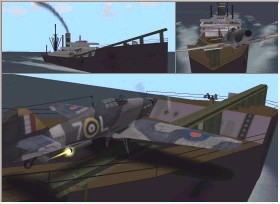
What's weird is they didn't think of using these fighter seaplanes instead of the throw-away Hurricats on their CAM ships.
Once again a clever Japanese idea has been defeated by the industrial capacity of the allies to overwhelm them with numbers.
Floatplanes were used in minor operations during 1942. The 32 Ku was involved in clearing out pockets of resistance in Zamboangoa in March 1942, and in April, the Chitose did the same thing in Northern New Guinea. Elsewhere, in July 1942 in the Kai/Aru/Tanimbar islands by Sanyo Maru, and she lost one F-1M2 to ground fire. But the most well known one was a flight of 6 Rufe's on a bombing mission to Amchitka, losing 2 of their number, while hitting nothing of value.
Floatplanes were used more in a defensive posture in the areas they were assigned.
What's AMAZING is that the Japanese did EXACTLY what we proposed for the SeaHawk II with their E-15K! They made the outer floats fold up to reduce drag and used contra-rotating props, but not with turbine engine power...Its had outer floats retract, reducing aerodynamic penalty for being a seaplane to just one large float underneath...in essence like a large fuel drop tank...it had counter-rotating props to eliminate torque problems on landing/take-off and increase power...is listed as being able to fly 285 mph...
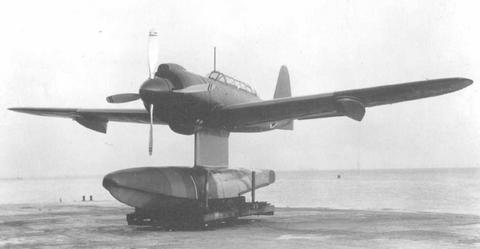
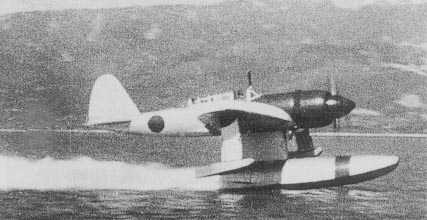
http://avia.russian.ee/air/japan/kawanishi_e15k.html
MODEL E-15K1 Norm

CREW 2
ENGINE 1 x Mitsubishi MK4S "Kasei-24", 1390kW
WEIGHTS
Take-off weight 4100-4900 kg
Empty weight 3165 kg
DIMENSIONS
Wingspan 14 m
Length 11.59 m
Height 4.95 m
Wing area 30 m
PERFORMANCE
Max. speed 460 km/h
Cruise speed 290 km/h
Ceiling 9830 m
Range 3320 km
ARMAMENT
2 x 7.7mm MMGs, x 60-kg bombs
www.j-aircraft.com/faq/floatplanes.htm
JAPANESE FLOATPLANE'S AIR-TO-AIR KILLS
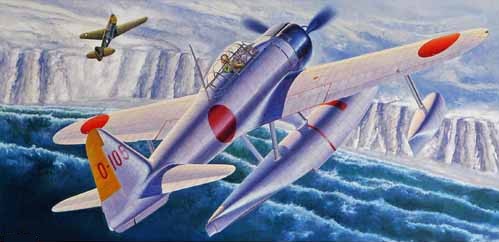
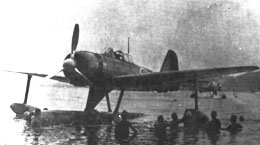
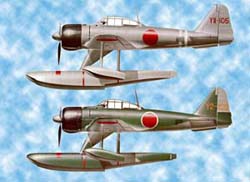
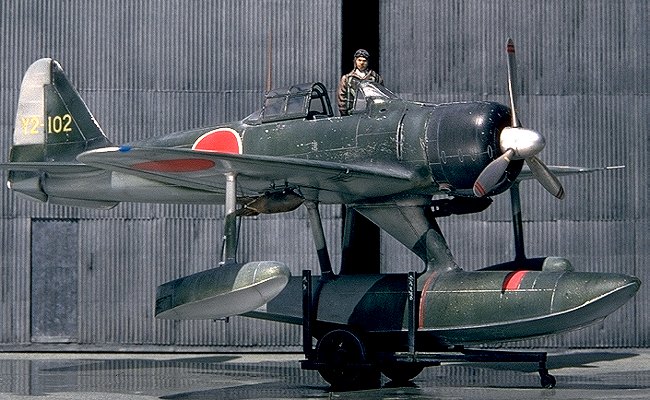
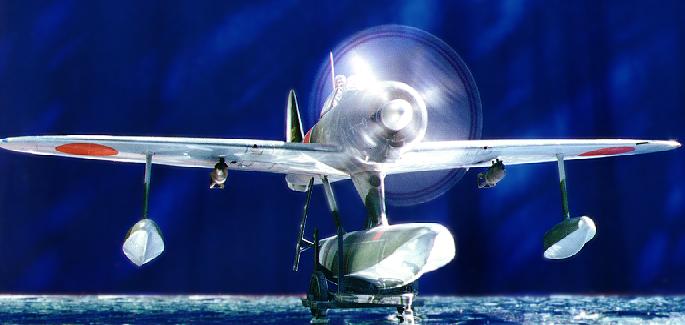
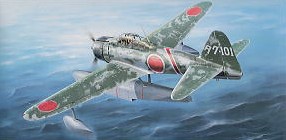
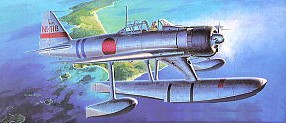
One floatplane pilot was an ace with 26 kills: only a handful of American pilots did better than him in WW2!
http://users.accesscomm.ca/magnusfamily/ww2jap.htm
Hidenori Matsunaga 934 Ku; floatplane pilot, many shares and probables included; Source: Imperial Japanese Navy Aces 1937-45, Osprey Aircraft of the Aces 22, Henry Sakaida, Osprey Pub.
The nimble E-13 Jake and AM-2 Rufe were credited with many aerial victories. Quoting from Asahi Journal 4.2, the top profile on page 14 shows a Pete from the CHITOSE seaplane tender. The caption states: "CHITOSE opened the Pacific War in the Philippines. Later, her F-1M's shot down a PBY on the heels of the Midway battle. Her #23 Reikan is credited with bringing down a B-17 by head-on collision on 10-4-1942, while escorting NISSHIN up The Slot. The aircrew survived, although the Reikan did not."
AIR ENTHUSIAST 31 (July - November 1986) with the article: "Fighting Floatplanes of the Japanese Imperial Navy" (Izawa Yasuho with Christopher Shores). Focuses on the RUFE and GEORGE but has good historic detail:
5th, later 452nd Kokutai (Aleutians and Northern Japan)(disbanded 1 Oct 1943) with A-6M2N - credited with 17 aircraft destroyed, 6 probables losses - 8 A-6M2N and 6 pilots in air-to-air combat; 4 pilots lost to AA fire and unknown losses KAMIKAWA MARU fighter unit and 14th, later 802nd Kokutai fighter unit (Solomons, SW Pacific) (assigned to 902nd Kokutai at Truk Oct 1943) KAMIKAWA MARU with A-6M2N - 14 kills claimed plus one probable 4 Sep -7 Nov 1942 (9 pilots lost) 14th/802nd Kokutai with A-6M2-N - 13 kills, 1 shared kill plus 8 probables 13 Oct 1942 - 14 Feb 1943 (13 aircraft and 7 pilots lost in combat)
Highest individual score: NAP3/c Jito Hisao, three kills
NEI Indies stuff is a little confusing, can't readily find total kills and losses
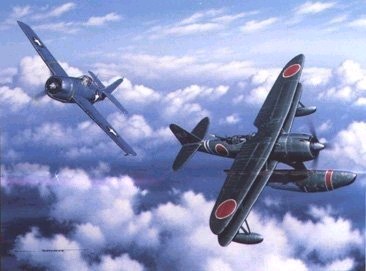
Capt. Joe Sailer (CO of VMSB-132, a marine SBD squadron) became a victim of a Pete seaplane on 12/7/42, while leading an attack against shipping in the Slot off Guadalcanal. If we count tail gunners, leave us not forget Joe Foss was shot down in his Wildcat by an ill-fated Pete rear gunner.
While most of your High Profile actions were around the Solomons and Kiska, there was another little hot spot where Type O observation aircraft and Type 2 Sea Fighter were involved. That was in the Kai and Aru area along the Barrier Rim. The Australian War Memorial can provide an excellent account of the actions of Dutch, Aussie and a squadron of U.S. B-24's encountering these float types. Indeed, B-24's were brought down by these wily floatplanes. Those Australians, piloting their Beaufighters, had their collective hands full. While their exploits were overshadowed by the above areas, these little floats were not lacking in aggression. 934 Ku was credited with bringing down 2 B-24's, 4 B-25 Mitchells and 3 Beaufighters during their period in the area. Only the PBY appears to have escaped these attacks as the RAAF operated this type at night.
Indeed, it is sad that we tend to glorify one area but overlook another. Only late in the war, did the 936 Ku have an opportunity for a victory, where two Rufes encountered aircraft from TF 69 Saratoga/Illustrious) on a strike on Sabang. Fortunately the SBD's from Saratoga were only slightly damaged from this encounter, but no floats were brought down either. Another area was Truk, as two Type O's attempted to intercept TF 58 on February 17th. They failed to return to base. One can only conclude that they were quickly overcome by the Hellcat's of TF 58.
And at Chichi Jima, had the Sasebo Ku had warning of an impending strike, they too undoubtedly would have intercepted Jocko Clark's aircraft, instead of being caught on the water with 21 being either destroyed or damaged beyond repair.
I thought about the Rufes that were based at Lake Biwa (in theory to intercept B-29's). I wonder if they had any aerial success against escort types or other Allied aircraft in the area?
The Ostu Ku that was based on Lake Biwa. To my knowledge, they never were able to attain attack position to bring down a B-29, but it wasn't for lack of trying.
AE 31 again, "Surviving pilots [from a forward detachment sent to Chichi Jima] returned to the Sasebo Ku, later participating without any success in interceptions of China-based B-29s."
Article notes that on 16 Feb 1945, two victories were claimed by A-6M2N pilots (no specific unit given) against a raid by F-6Fs from VF-12 and VBF-12 against Kashima and Konoike. The Americans claimed 6 floatplanes shot down.
Years ago, there was a Japanese float plane displayed outdoors along the fenceline of Willow Grove Naval Air Station, near Philadelphia, Pennsyvania. When last I visited (this past summer), it and other WWII aircraft (including an Me-262) were no longer present. Anyone know the whereabouts of these unique planes?
Kawanishi N1K1 Kyofu "REX"
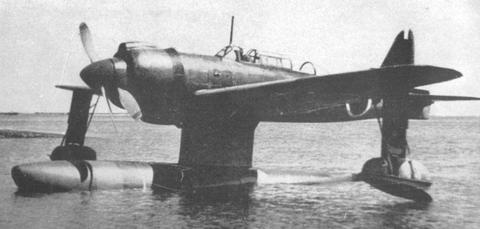
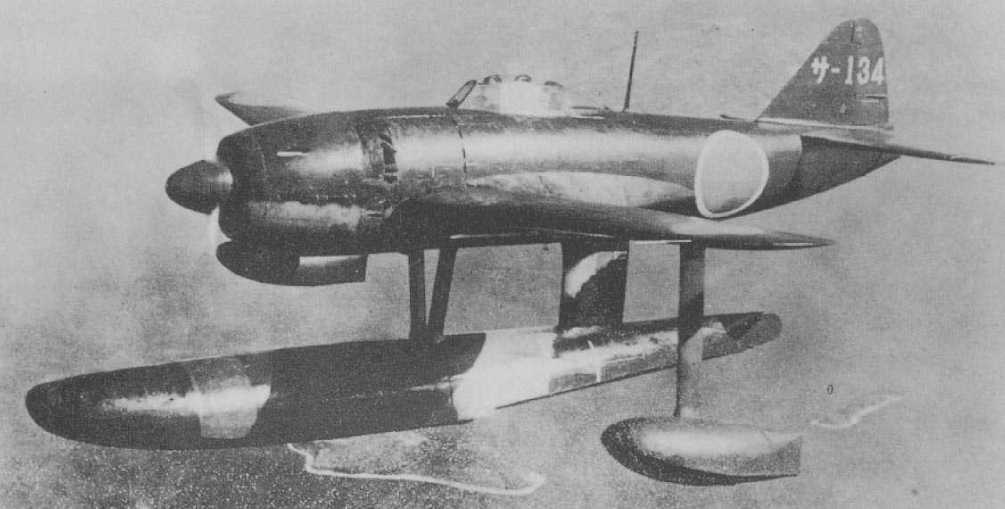
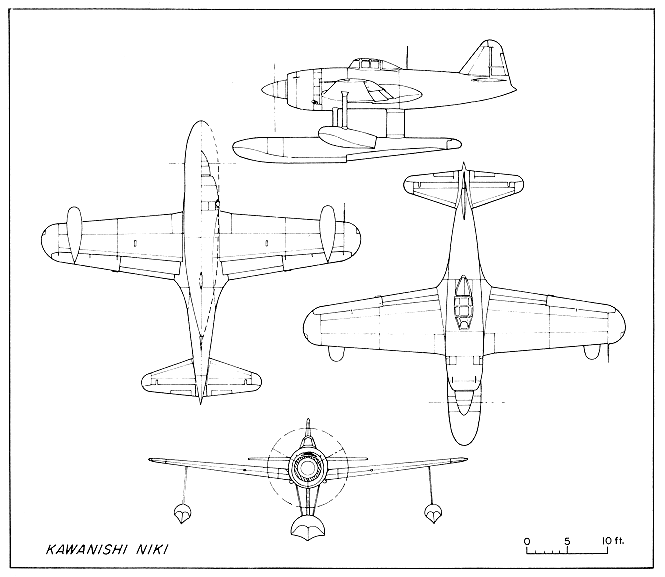
www.j-aircraft.com/walk/walkarou.htm
It has been sent to the U.S. Naval Aviation Museum at Pensacola for storage and preservation. As for the other airplanes, i do not know their whereabouts, but the Me-262 was moved from Willow Grove to Ft. Worth Texas' Texas Aeroplane Factory and used as a pattern for the initial fabrication of the five replica Me-262s that are now being finished by a different outfit in Seattle, (actually Everett), Washington. The Navy lent the TAF the Me-262 as a pattern aircraft in return for it's restoration of serious corrosion from the elements all these years. It's current location is unknown by me.
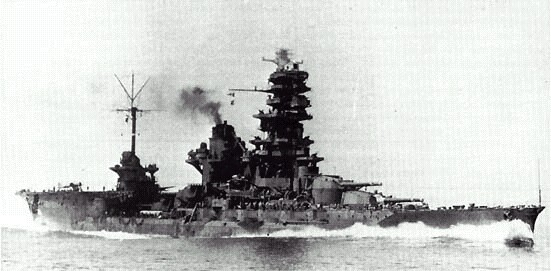
The conversion of Ise and Hyuga to "battleship aircraft carriers" is hotly debated whether it was a good idea or not--clearly if you have no aircraft carriers it beats having nothing to put seaplanes into the air. Being that the conversions were done later in the war we imagine that the aircraft variety was limited-page 73 (top) of FAOW#47 shows a Paul seaplane being launched off of Hyuga. The lower photo caption shows what appears to be the kanji for Hyuga as well, the aircraft are marked 634-xx on the tail.
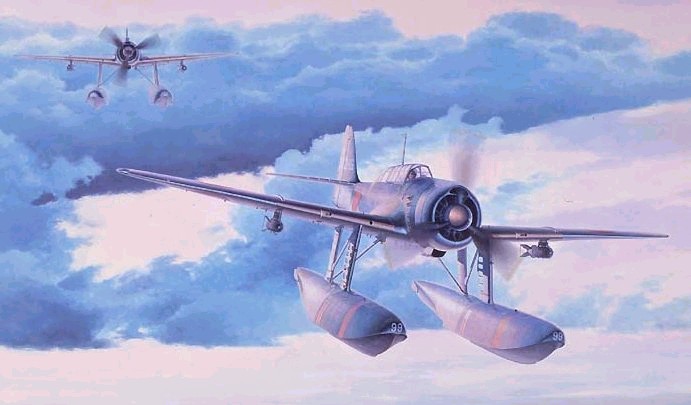
I imagine that it is a safe assumption that Ise also carried the Paul-is there any reference that states what aircraft types were carried, and if possible unit codes and total aircraft carried?
I have looked in my copy of Watts' "Japanese Warships of World War II", and it does not shed any light on types of a/c carried. It did however, say that it carried 22 aircraft. Also in a photo on page 13 (Ise) it appears that there is a monoplane of some sort on the deck. The photo was taken on 8-24-43, it looks like a Rufe but I know it can't be, can it? Anybody else has seen this photo?

After conversion into hybrid BB/CVs, they were originally scheduled to carry twenty-two 13-shi experimental wheel landing gear bombers (Judy), but this was changed to 14-shi floatplane dive bombers (Paul). However, the absence of trained pilots meant that they never carried any aircraft in combat. During trials Ise appears to have had some Aichi D-3A1 "Vals" aboard while running full speed trials on 24 August, 1943.
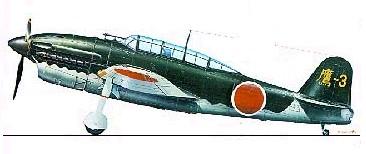
If they were in theory to carry Judys what kind of mission profile did that entail as it seems they would not have been able to land again on the small decks of the Ise class?
I suppose then that the photo in FAOW #47 shows a Paul being launched in trials and not actual operations
If I recall correctly, Ise & Hyuga were intended to be used in unison with "regular" fleet carriers. The conversions were one of those post-Midway decisions made by panicking Navy brass, who wanted to increase the number of "aircraft carriers" as quickly as possible. Of course the "Judys" were intended to land on the "regular" fleet carriers after the mission. Also, I remember reading several years ago that the complement of aircraft intended to be used on the hybrids was changed several times. At one point there were supposed to be 22 x Judys, then 22 x Pauls and also a mixed bag of 11 machines of each type.

The plan for the Judys was interesting to say the least. Would have been a real task getting the aircaft back to the Ise class ships after landing on a normal CV- some type of transfer would have to take place or else a "one shot" type of plan similar to the British Hurricat CAM ships.
Both ships are discussed at some length in The Hybrid Warship (R D Layman and Stephen McLaughlin)(1991) ISBN 1-55750-374-5 Naval Institute Press (originally published by Conway's)
As I understand past readings from W.D. Dickson, one of the lessons the IJN studied was the fact that flight decks of dedicated CVs would be relieved due to losses.
Therefore, any wheel landing gear equipped aircraft launched from the hybrid carriers would have decks to land upon -- assuming they were not shot down. So the purpose of the small decks provided by the hybrids appears to have been to augment the strength of the CVs during launch phase and any surviving aircraft would then land upon the CV flightdecks.
As far as I know, Ise and Hyuga belonged to the 4th Koku Sentai (Radm. Matsuda) of the 3rd Fleet (Vadm. Ozawa) in late 1944, and E-16A Zuiuns of 634th ku would be carried on both ships. (634th ku became "usual" floatplane flying corps although the number "6" meant carrier flying corps.) But as you know, no planes had ever been carried on both ships in combat due to a lack of Japanese pilots. And as many people know, D-4Y Suisei Model 21s and Model 22s would be launched from their catapults, but this plan did not realize also.
The major problem is about the concept of the air group (634). Apart the 2 pictures of a Paul launched by Hyuga in summer 1944( I am still sure that they are extract from a film), there is no picture evidence of a Judy (D4Y -radial or inline engine?) aboard Ise/Hyuga. It could be very interesting to get a picture of a Judy with wheel landing gear on a catapult. Some books give trials with E-13 Jake, F-1M Pete or even E-15 Norm (I am sure for this case that the answer is negative) but there is no picture evidence.
My guess is that there were some Paul sdeaplanes on Hyuga and Ise and that is all. The use of D-4Y was only a concept. I have no much documentation on D-4Y Judy but pictures are numerous and I never see any prototype for a catapult launch (there must be some fixing points and reinforcements of the structure).
INRO WARSHIP INTERNATIONAL gives
Ise : E-16 Paul 634-01 to 634-10 D-4Y Judy 634-201 to 634-212
Hyuga: E-16 Paul 634-11 to 634-20 D-4Y Judy 634-213 to 634-224
Ise and Hyuga have often been referred to as "seaplane carrier", but this was not the designers' intention. The 22 machines were originally to be Yokosuka D-4Y Suisei (Comet) dive bombers (Judy). It began life as a high-speed carrier-based reconnaissance plane, as the IJN had finally come to the conclusion that its carriers needed a few aerial scouts of their own. It was developed, with several variants, into a dive-bomber to replace the Aichi D-3A.
The D-4Ys could not, of course, take off from or land on the hybrid BBs' small aircraft decks; they were to be launched by the catapults and either alight on accompanying carriers or fly to land bases. The decks were for aircraft handling, and were fitted with a system of rails, turntables, tie-down spots and trolleys similar to the arrangements on Mogami. It was calculated that this would permit an aircraft launching every 2 minutes on each catapult. Under ideal conditions, therefore, with both catapults functioning simultaneously, the entire complement could be in the air in somewhat less than 30 minutes. However, Rear Admiral Chiaki Matsuda, who commanded the two hybrids, noted that the airplanes were launched "broad on the the bow into the wind", so that both catapults could NOT be used at the same time. Theoretically, the ship could zigzag back and forth across a base course into the wind, using first one catapult, then coming about nearly 90 degrees to use the other; but it seems unlikely that she could have done so in the nominal 60 seconds between launches. One way or another, launching would probably have taken at least 45 minutes, and under operational conditions...it probably would have taken an hour or more. No such mass launchings were ever attempted.
Somewhere along the line it was decided that the ships should have some more easily recoverable and reusable aircraft, so the complement was altered to include a number of seaplanes. The type chosen was the Aichi E-16A Zuiun (Auspicious Cloud) (Paul). It was designed as a shipboard reconnaissance type, but was also fitted out as a dive bomber. Its respectable bomb load could have augmented the already hefty punch of the Suiseis.
Most references give the complement of the hybrid BBs as 12 x Suiseis/Judys and 10 x Zuiun/Pauls, but Admiral Matsuda told the American questioners during a post-war interrogation that there were 11 of each type per ship, half carried in the hangar and half on deck, with a mix of types in both places.
Ise began working up in Nov, 1943 and Hyuga in Dec, 1943, but it would be months before they received any aircraft. In May 1944 the two hybrids and the carriers Junyo and Ryuho were formed into the Fourth Air Squadron under Admiral Matsuda.
By mid-August 1944 the 634th Air Group had been formed to provide Matsuda's command with a total of 130 aircraft, but most of the aviators were inexperienced and required lengthy training in deck flying. This was still in progress when the American Invasion of the Philippines began. Because the fliers were judged unqualified for shipboard operations, all of Matsuda's planes and half of those from the other carriers were flown off to Formosa. The hybrid BBs, devoid of aircraft, acted purely as surface escorts, Ise screening Zuikaku and Zuiho, Hyuga guarding Chiyoda and Chitose.
Source: "The Hybrid Warship: The Amalgamation of Big Guns and Aircraft", by R.D. Layman and Stephen McLaughlin.
What floatplanes were catapult launched?
The E-7K2, E-8N, E-13A, E-15K, E-16A and F-1M from warships and the E-14Y and M6A1 from submarines. Whether the A-6M2N, the N-1K1 and the E-11A1 were (a) capable of catapult launching and (b) so launched in action. Francillon doesn't say, AFAIR; anyone knows?
The Japanese had four large, purpose-built Seaplane Tenders. They were Chitose, Chiyoda, Mizuho and Nisshin. They all had 4 catapults with a capacity of 24 aircraft. Of the four, Chitose and Mizuho were used extensively throughout the Indies Campaign. Chiyoda and Nisshin were converted to carry midget submarines until Nisshin would be sunk and Chiyoda would be converted to a Light Carrier. Mizuho also would be sunk, but Chitose remained at her role until converted also to a Light Carrier.
Small IJN Seaplane Tenders


The smaller Maru Tenders which operated 6 x seaplanes had cranes to lift aircraft on and off their decks, but those would revert to their former roles as transports.
Chitose and Kamikawa Maru were in the Midway invasion force, equipped with A-6M2-Ns and F-1Ms. Did the seaplane tenders carry (or were they intended to carry) N-1Ks later in the war? Neither Chitose or Kamikawa Maru carried the Type 2 Seafighter (A-6M2N) during the "Midway" Battle. Most sources say that Kamikawa Maru had embarked 8 Type 0 Observation (F-1M2 Pete) and 4 Type 0 (E-13A1 Jake), while Chitose embarked 16 and 4 of the types. Kamikawa Maru did transport the Type 2 to Kiska in July and did tender the type out of the Shortlands in the latter part of 1942. With regard to the N-1K1, that type was never embarked on tenders. It operated out of anchorage in Ambon, Manokwari, Balikpapan, Chichi Jima and other places late in the war. All converted tenders were converted back to their former roles early in 1943, and had no role with the "N-1K1".
Derived from the web page on www.combinedfleet.com/Kamikawa%20Maru_t.htm
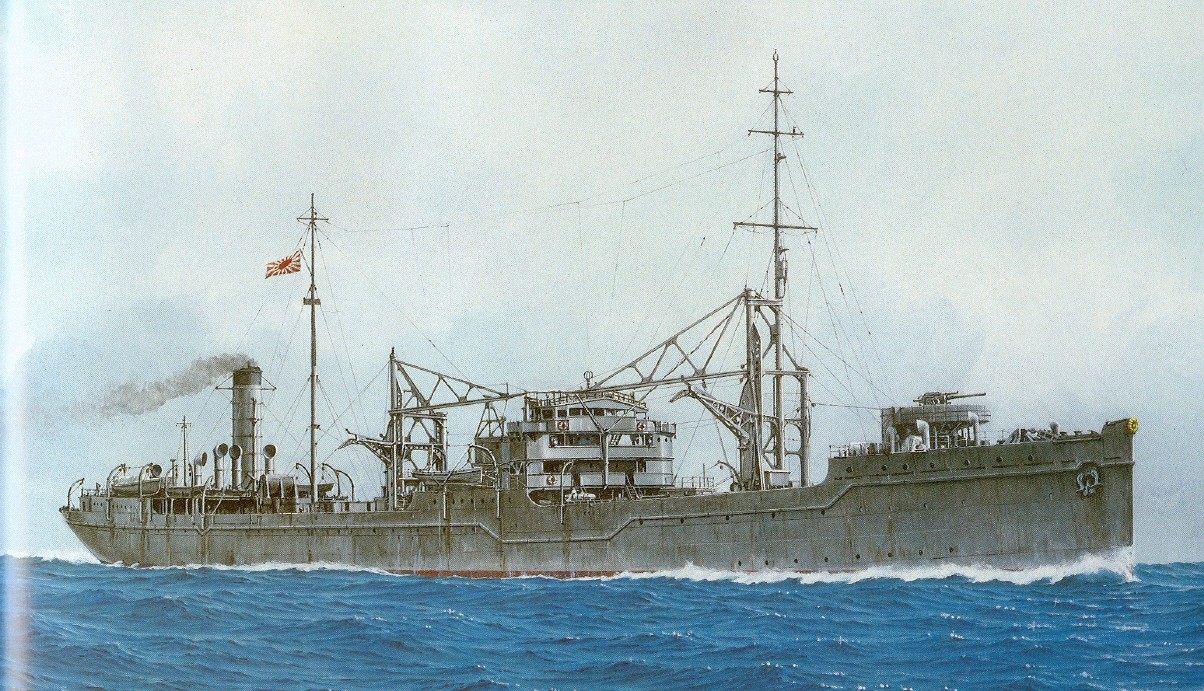
(NOTORO by Takeshi Yuki scanned from "Color Paintings of Japanese Warships")
IJN Seaplane Tender KAMIKAWA MARU:
Tabular Record of Movement
By Bob Hackett, Sander Kingsepp and Allan Alsleben.
Revision 7
5 August 1936:
Kobe. Laid down at Kawasaki's dockyard.
13 December 1936:
Launched and named KAMIKAWA MARU.
15 March 1937:
Completed by Kawasaki as a merchant vessel for the Kawasaki Kisen K. K. Line.
7 July 1937: The Marco Polo Bridge (Sino-Japanese) Incident:
Lugouqiao, China.
Japanese troops are on night maneuvers at the bridge. They fire blank cartridges. Chinese troops fire back, but do not cause injuries. At morning roll call, the Japanese discover a Soldier missing and assume the Chinese captured him. The Japanese demand entry to Beijing to look for the Soldier. The Chinese refuse. The Japanese then bomb the city. An undeclared war on China begins.
10 August 1937:
The 22nd Sea Scout Unit is embarked aboard oiler TSURUMI and departs Sasebo. Later, the 22nd establishes a seaplane base in the Ma-an Islands, off China.
18 September 1937:
In response to the Sino-Japanese Incident, the IJN requisitions KAMIKAWA MARU for naval service as a flying boat tender. She is registered (commissioned) in the IJN in the Sasebo Naval District. Captain (later Vice Admiral) Omori Sentaro [41](former CO of YUGIRI) is posted as the Commanding Officer.
1 October 1937:
Attached to the Third Fleet.
5 October 1937:
Departs Kure to operate off the central Chinese coast.
9 October 1937:
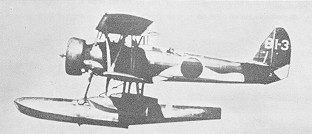
The 22nd Sea Scout Unit's Type 95 Nakajima E-8N2 "Dave" reconnaissance float biplanes are transferred to KAMIKAWA MARU.
1 December 1937:
Reassigned to the 3rd Air Flotilla. Captain (Vice Admiral, posthumously) Arima Masafumi [43] (former CO of ASAMA) is posted as the Commanding Officer. Captain Omori is reassigned as the Chief Instructor of the IJN's Torpedo School.
26 December 1937:
Arrives at Takao, Taiwan.
28 December 1937:
Departs Takao to operate off the southern coast of China.
1 February 1938:
Reassigned to the 3rd Air Flotilla, Fifth Fleet.
13 March 1938:
At Mako, Pescadores.
1 July 1938:
Attached to the Third Fleet.
21 July 1938:
Tsiangtsin, China. The Japanese begin operations with aerial reconnaissance of the city followed by aerial bombardment of Chinese positions. At dawn the next day, the IJA's 106th Division lands a reinforced infantry brigade south of Tsiangtsin. The Chinese launch many counterattacks, but are repelled by the IJA assisted by air cover.
24 July 1938:
That night, Rear Admiral (later Vice Admiral) Kondo Eijiro's (36)(former CO of KAGA) Yosuko Force lands troops of the Kure No. 5 Special Naval Landing Force (SNLF) on the banks of the Yangtze. Gunnery support is provided by Kondo's 11th Battle Division. Minelayer YAEYAMA leads the van with TorpBoatDiv 1, MinesweepDiv 1's and MinesweepDiv 2. Kondo's Guard Unit is made up of TorpBoatDiv 11 and TorpBoatDiv 21. Air cover is provided by KAMIKAWA MARU and NOTORO. Threatened with envelopment, the Chinese withdraw.
1 September 1938:
Captain (later Rear Admiral) Yokokawa Ichihei [43] is posted the Commanding Officer. Captain Arima is reassigned as the CO of the Sasebo Air Group.
1 October 1938:
Operates out of the Shanghai or Whangapoa Estuary, patrols the coastline, or is "on call" to support the Army.
5 December 1938:
Commissioned in the IJN. Begins service as an aircraft transport. Attached to the China Area Fleet.
15 December 1938:
KAMIKAWA MARU is attached to the 5th Fleet's newly formed 16th Seaplane Tender Division with the 14th Naval Air Group's (NAG) assets. Operates off Hainan Island in support of operations in the Canton area.
15 November 1939:
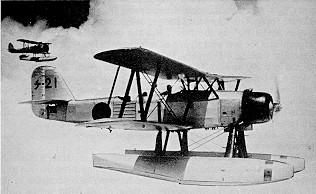
Completes conversion to a 17-knot 6,853-ton seaplane carrier/tender. Six Ten Year type 120mm (4.7-inch)/45 cal. high angle guns are installed. She carries four Type 94 Kawanishi E-7K2 "Alf" and eight Type 95 Nakajima E-8N2 Dave floatplanes. She is assigned call sign JNJL. KAMIKAWA MARU's aircrafts' tail code is "ZI-xx." She is re-rated a Seaplane Tender and assigned in the Sasebo Naval District.
Captain (later Rear Admiral) Ando Shigeaki [43] (former XO of HOSHO) assumes command. Captain Yokogawa is reassigned as the CO of HIRYU. The 16th Seaplane Tender Division is deactivated. That same day, the 3rd, 4th and 5th fleets are renamed the China Expeditionary Fleet. KAMIKAWA MARU departs for Hainan Island to begin operations in the Canton area.
1 April 1940:
Attached to the Second China Expeditionary Fleet.
1 July 1940:
Captain (Vice Admiral, posthumously) Yamada Michiyuki [42] (former CO of Suzuka Air Group) assumes command. Continues operations in the Canton area.
9 November 1940:
At Mako.
15 November 1940:
Reassigned to Captain Imamura Osamu's [40] (former CO of NOTORO) new 6th NAG and directly attached to the Combined Fleet with fleet oiler/seaplane carrier NOTORO. Captain (later Rear Admiral) Hattori Katsugi (former CO of KAMOI) assumes command. Captain Yamada is reassigned as the CO of the Oita Naval Air Group.
1 December 1940:
Nagasaki. Drydocked at Mitsubishi's Yard.
20 December 1940:
Undocked.
27-29 January 1941:
KAMIKAWA MARU becomes the temporary flagship of 6th NAG instead of NOTORO.
26 February 1941:
At Nakagusuku Bay, Okinawa.
25 March 1941:
At Sasebo.
10 April 1941:
Reassigned to Captain Imamura's 12th NAG, Second China Area Fleet with tender SANYO MARU for operations in the Shanghai area.
17 April 1941:
At Mako.
4 May 1941:
Sasebo Navy Yard. Drydocked.
15 May 1941:
Undocked.
2 June 1941:
Designated as the flagship of the 12th Seaplane Tender Division. That same day, the flag is transferred temporarily to aircraft transport FUJIKAWA MARU.
20 September 1941:
Captain (later Rear Admiral) Shinoda Tarohachi [44] (former CO of AO SHIRYA) assumes command.
22 November 1941:

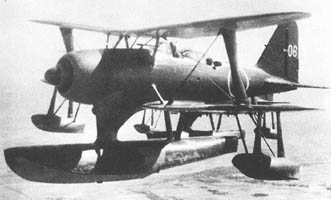
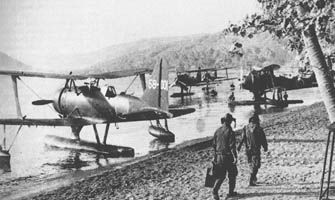
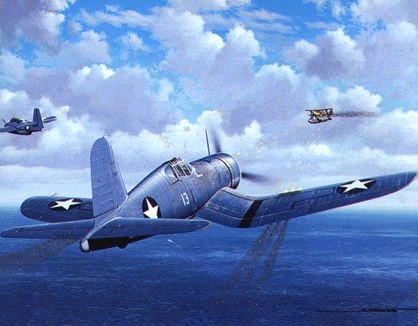
"Pete" biplane floatplane
Departs Sasebo for Samah, Hainan Island. KAMIKAWA MARU now carries 14 x Aichi Type 0 E-13A1 "Jake" reconnaissance floatplanes and Mitsubishi F1M2 "Pete" scout float biplanes.
27 November 1941:
Arrives at Samah.
November 1941:
KAMIKAWA MARU is assigned to 12th NAG, Third Fleet and moves to Camranh Bay, Indo-China.
4 December 1941:
Operation "E" - The Invasion of Malaya:
KAMIKAWA MARU departs Samah, Hainan Island with SANYO MARU and the No. 1 Malaya Invasion Convoy carrying the IJA 5th Infantry Division and heads south.
6 December 1941:
Kota Bharu, Malaya. At 1030, a flight of three Lockheed "Hudson" light bomber patrol planes of No. 1 RAAF Squadron takes off on a reconnaissance flight over the South China Sea.
185 miles E of Kota Bharu. About noon, the crew of one of the Hudsons spots three Japanese ships steaming west. Fifteen minutes later, the same crew spots and reports sighting the main IJN convoy consisting of a battleship, five cruisers, seven destroyers and 22 transports.
KAMIKAWA MARU launches a Pete floatplane to intercept the Hudson, but it is spotted and the Hudson takes cover in the clouds.
A few minutes later, a second Hudson also spots and reports details on the convoy.
At 1400, Air Chief Chief Marshal Sir Robert Brooke-Popham, CINC, Far East, is advised of the sightings. Brooke-Popham is unsure of the meaning of the movements of the Japanese ships: perhaps they are just testing British defenses or perhaps they are heading for Siam. In any event, lacking authority from London to do anything unless Allied Forces are actually attacked, he places all his forces in Malaya on full alert. He orders continued surveillance of the convoy by his recce aircraft.
Off Occupied French Indo-China (Vietnam). A floatplane from KAMIKAWA MARU sights the American Yacht ISABEL (PY-10). ISABEL was dispatched to reconnoiter the coast of Indo-China by Admiral (later Senator) Thomas S. Hart, CINC, U.S. Asiatic Fleet, on orders from President Franklin D. Roosevelt. Later that day, ISABEL is ordered to return to Manila.
7 December 1941:
Off Malaya. At 0300, Admiral Ozawa Jisaburo orders patrols in the area between the convoy and Malaya. The convoy is then 100 nautical miles off Kota Bharu. There is heavy rain and zero visibility. The Southern Expeditionary Fleet has two seaplane carriers, KAMIKAWA MARU with 14 x E-13A1 Jakes and F-1M2 Petes and SAGARA MARU with six F-1M2 Petes and two E-8N2 Daves. Both ships catapult off 11 x F-1M2s and six x E-13A1s, but the planes report nothing.
Gulf of Siam. 20 miles WNW of Panjang Island.
At 0820 (local), an E-13A1 coded ZI-26 from KAMIKAWA MARU's Air Unit, piloted by Ensign Ogata Eiichi, spots Consolidated PBY "Catalina" reconnaissance seaplane W8417, coded "FY-W"of the RAF's 205 Squadron piloted by Warrant Officer William E. Webb, RAF. Ogata attacks the PBY from the rear and succeeds in damaging the seaplane. With their radio destroyed, the 8-man Aussie crew can not report . Ensign Ogata shadows the Catalina for 25 minutes until five Type 97 Kawasaki Ki-27 "Nate" fighters from the JAAF's 1st Sentai arrive and quickly shoot down the PBY about 0845. WO Webb and his crew become the first casualties of the Pacific War.
8 December 1941: Operation "E" - The Invasion of Malaya:
Japanese forces land on the Kra Isthmus of Thailand and NE Malaya.
Off Kota Bharu, Siam (Thailand). KAMIKAWA MARU operates with SAGARA MARU covering Malaya convoys. That day, Lt Mizuno Teinosuke [64], a KAMIKAWA MARU floatplane pilot, is reported as lost in action.
11 December 1941:
Arrives at Cam Ranh Bay, Indochina.
13 December 1941: Operation "B" - The Invasion of British Borneo:
Covers the British Borneo Invasion Force with CruDiv 7's KUMANO, SUZUYA, light cruisers YURA and KINU, DesDiv 11's FUBUKI, DesDiv 12's MURAKUMO, SHINONOME and SHIRAKUMO and DesDiv 20's SAGIRI, subchaser CH-7 and minesweepers W-6 and W-7.
17 December 1941:
Miri, northern Borneo. Under KAMIKAWA MARU's Air Officer, Cdr Miura Kintaro, her floatplanes provide air cover for the invasion landings.
North of Miri, near Seria.
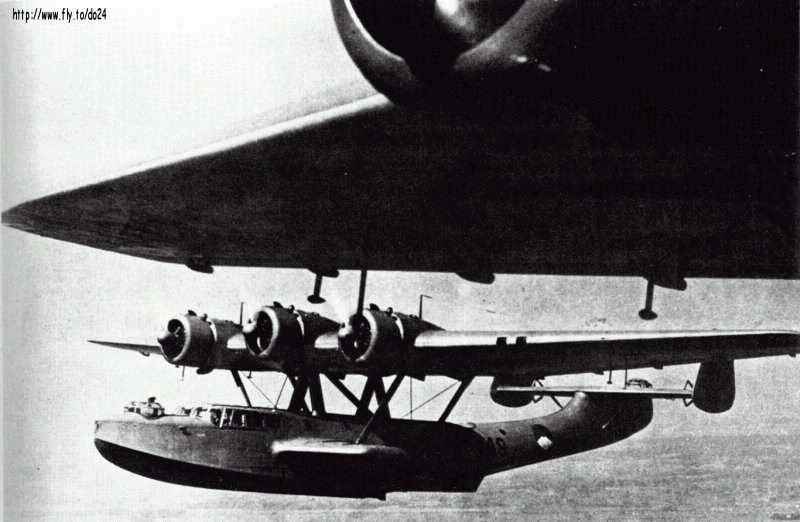

In the darkness, SHINONOME completes escorting the minesweeper W-7 and troop transport HIYOSHI MARU to this landing site. Just after dawn, steaming alone off shore, SHINONOME is attacked by Dutch Dornier Do-24 K-1 seaplane X-32 of Aircraft Group GVT-7 based at Tarakan, E Borneo. Of five x 200-kg bombs she drops, the X-32 scores two direct hits and a near-miss. An explosion severs SHINONOME's stern and she sinks quickly with all hands - the first FUBUKI-class destroyer sunk in WWII.
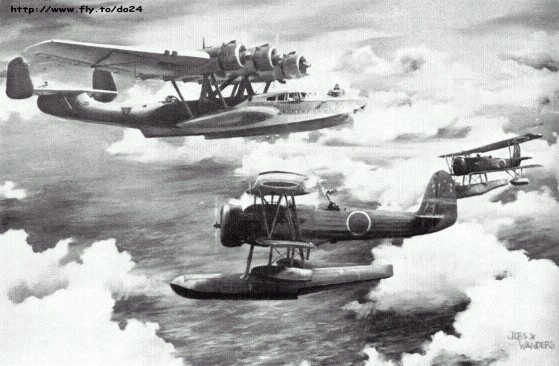
A Do-24 X-34 seaplane of GVT-7 attacks a vessel, but is intercepted by a Type O Mitsubishi F-1M2 "Pete" from KAMIKAWA MARU. The Dornier is forced to make an emergency landing with two of its crew dead. Two hours later, in bad weather conditions.
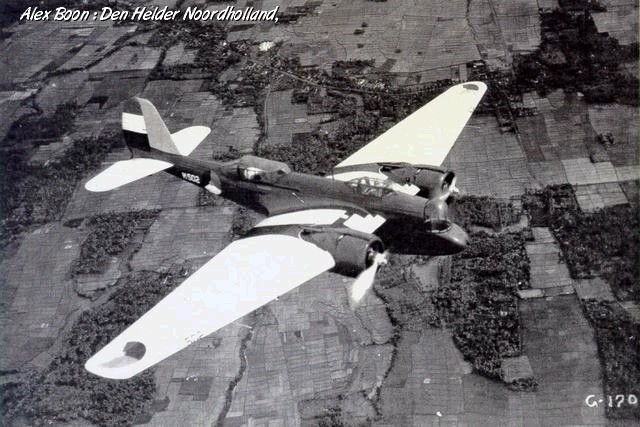
Six Dutch Glenn Martin B-10 bombers of 2-VIG-I, also attack. A Pete from the KAMIKAWA MARU attacks the Dutch bomber formation, but they escape. [1]
[EDITOR: Notice the seaplane fighter SPOILS the attack of the enemy bombers, saving the ship. In the earlier attack, the SHINONOME does not have a seaplane to air defend her and gets sunk.]
The invasion force goes ashore almost unopposed at Miri, Seria and Lutong. The 2,500 men of MajGen Kawaguchi Kiyotake's "Kawaguchi Detachment" and the No. 2 Yokosuka Special Naval Landing Force (SNLF) quickly capture Miri's airfield and oil fields.
19 December 1941:
Miri.

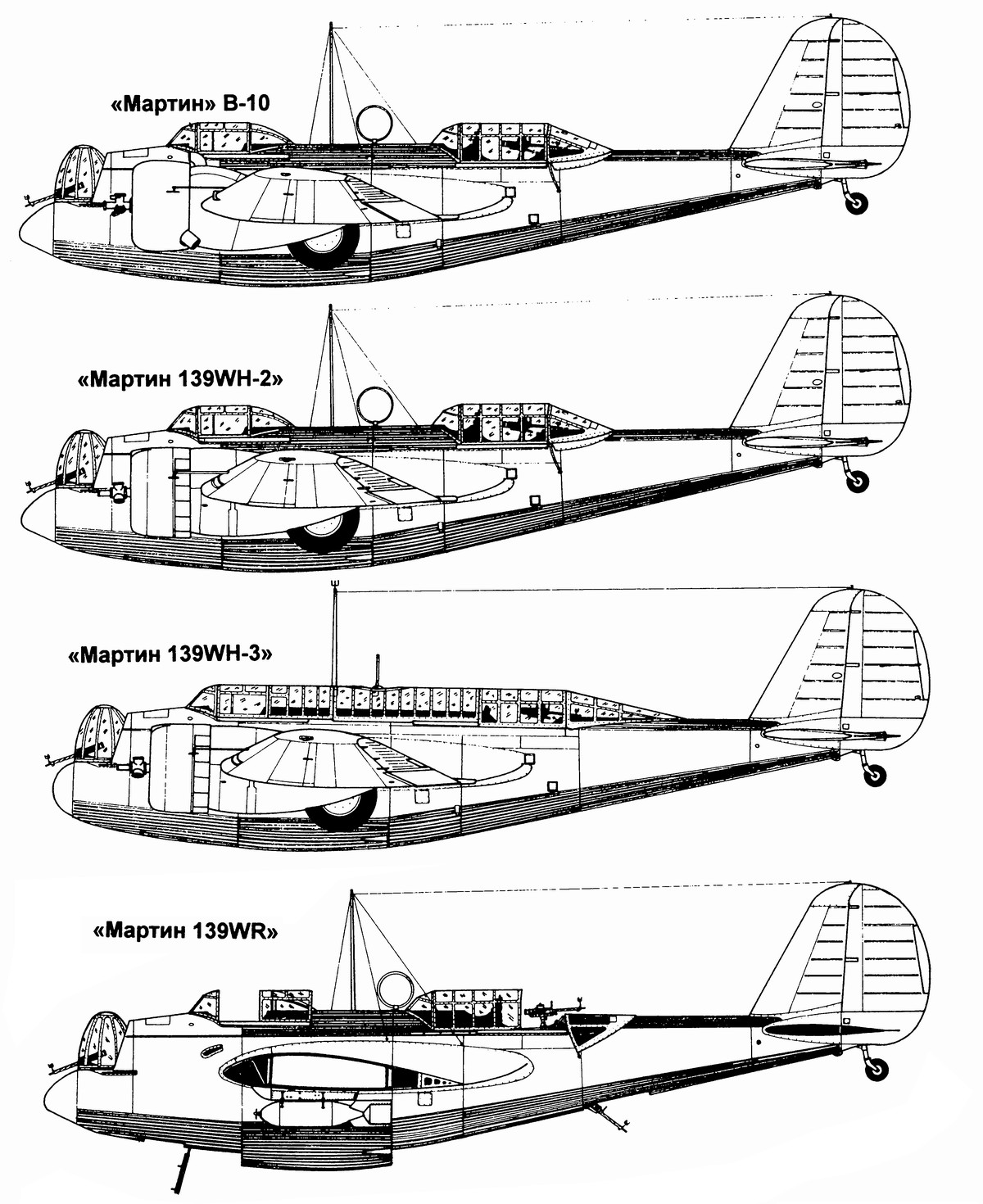
In the morning, Glenn Martin B-10 medium bombers from 1-VIG-I and 2-VIG-I based at Samarinda and Singkawang attack the invasion shipping. Four of KAMIKAWA MARU's F-1M2 "Pete" floatplanes intercept separate trios of bombers that appear at 15-minute intervals. The Petes' pilots claim downing Glenn Martin M-571 of 2-VIG-I.
[EDITOR: again, another successful ship defense against air attack only possible because they are seaplanes!]
20 December 1941:
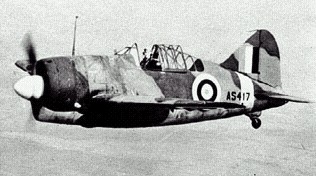
Miri. About midday, six Glenn Martin B-10s of 2-VIG-I escorted by two obsolete Brewster "Buffalo" fighters attack Japanese shipping off Miri. The bomber crews miss a cruiser. F-1M2s from KAMIKAWA MARU intercept and claim one bomber. The Buffaloes escape with heavy damage.
[EDITOR: another air defense by seaplanes]
That same day, an E-13A1 Jake from KAMIKAWA MARU fails to return from a reconnaissance mission.
23 December 1941:
Northern Borneo.
F-1M2 Petes from KAMIKAWA MARU and Type 0 Mitsubishi A-6Ms "Zekes" of the 22nd Air Flotilla's based at Miri patrol over a convoy. A Dutch Do-24 X-35 seaplane of GVT-1 based at Java is spotted shadowing the convoy. The Dornier is engaged and damaged by a Pete, but escapes and returns to Surabaya.
[EDITOR: successful counter-maritime reconnaissance by seaplane fighter]
27 December 1941:
An F-1M from KAMIKAWA MARU fails to return from a morning patrol. An E-13A1 Jake is dispatched on a search and rescue mission, but finds nothing. While landing near KAMIKAWA MARU, the Jake capsizes and sinks.
Departs for Camranh Bay, Indo-China.
4 January 1942:
At Cam Ranh Bay.
20 January 1942:
Off Singora/Patani, Thailand with tender SAGARA MARU. Provides air cover for a convoy of 11 transports that left Cam Ranh for Singora and Patani carrying troops of the IJA's 18th Infantry Division.
1 February 1942:
The 12th Seaplane Tender Div is disbanded. KAMIKAWA MARU is assigned directly to the Third Fleet.
13 February 1942: The Invasion of Palembang, Sumatra.
Off Bangka Island with SAGARA MARU.
14 February 1942:
Operation "J" - The Invasion of Java, Netherlands East Indies:
Cam Ranh Bay.
KAMIKAWA MARU is in Vice Admiral Takahashi Ibo's (former CO of YAMASHIRO) Third Fleet, Southern Force, Netherlands East Indies Force. The Western Force under Vice Admiral Ozawa Jisaburo (former CO of HARUNA), together with an airborne assault by paratroopers, captures the oil refineries at Palembang, Sumatra.
KAMIKAWA MARU with the light cruisers NATORI and YURA and the seaplane tender SANYO MARU provide distant cover of the Western Java Seizure Force.
16 February 1942:
Java Sea, Muntok, Bangka Island. A detachment of F-1M2 Petes from KAMIKAWA MARU and the SAGARA MARU are operating out of Bangka. Dutch Glenn Martin B-10s of the Java-based 3-VIG-III sortie to attack Japanese shipping in the Moesi River, Sumatra. During the afternoon, F-1M2s and Ki-27s of the 1st Sentai intercept four x twin-engined bombers over the shipping. One bomber is shot down in southern Sumatra. A Pete is also shot down and lands in the sea, 40 miles West of Muntok, but destroyer HATSUYUKI picks up the pilot and his observer.
[EDITOR: another anti-shipping attack thwarted by seaplane fighters!]
1 March 1942:
KAMIKAWA MARU provides air cover for 56 invasion transports carrying the IJA's 2nd Infantry Division.Ozawa's Western Force lands troops at Bantam Bay, Merak and Ereten Wetan, Java.
In the morning, three of KAMIKAWA MARU's F-1M2 Petes and three of her E-13A Jakes fly to Bantam Bay, Java. Two of the F-1M2s go on to Eretan Wetan. Two Petes from SANYO MARU join them there. In the early afternoon, five Hawker "Hurricanes" of 605 Squadron engage a lone Pete floatplane. After the combat, the Pete's pilot claims three Hurricanes downed.
Later, that same day, a lone Hurricane finds two of KAMIKAWA MARU's F-1M2s at anchor in Bantam Bay. The Hurricane, although under fire from IJN AA positions, strafes the Petes and sets one on fire while badly damaging the other.
3 March 1942:
Off Eretan Wetan, Java with SANYO MARU.
5 March 1942:
Troops of the IJA's 2nd Infantry landed by Ozawa's Western Force take the capital of Batavia, Java.
10 March 1942:
Reassigned to the Fourth Fleet at Rabaul.
11 March 1942:
Departs for Kure.
16 March 1942:
Arrives at Kure.
24 March 1942:
Arrives at Sasebo.
27 March 1942:
Drydocked.
4 April 1942:
Undocked.
18 April 1942:
Departs Sasebo for Truk.
24 April 1942:
Arrives at Truk. Assigned to the screening force of the Port Moresby Occupation Force with Rear Admiral (later Vice Admiral) Marumo Kuninori's (former CO of ASHIGARA) CruDiv 18's light cruisers TENRYU, TATSUTA, YUBARI and three gunboats.
28 April 1942:
Operation "MO"- The Invasion of Tulagi and Port Moresby (The Battle of Coral Sea):
Departs Truk via Rabaul for the south Solomons.
30 April 1942:
Arrives at Queen Carola anchorage, Kieta, New Ireland.
2 May 1942:
Solomons. Covers the landings on Santa Isabel Island.
3 May 1942:
At Rekata Bay, Santa Isabel Island. KIYOKAWA MARU's (undergoing repairs in Japan) Air Unit is based aboard KAMIKAWA MARU and provides air cover over Tulagi and Guadalcanal.
4 May 1942:
100 miles South of Guadalcanal. The IJN had previously begun construction of a seaplane base at Tulagi, Florida Island, British Solomons. Task Force 17's Rear Admiral (later Admiral) Frank J. Fletcher (MOH '14/former CO of USS VERMONT, BB-20) receives a signal that IJN transports are disembarking troops and equipment at Tulagi.
At 0701, USS YORKTOWN (CV-5) launches her first strike of 18 x Grumman F-4F3 "Wildcats" fighters of VF-42, 12 x Grumman TBD-1 "Devastator" torpedo-bombers of VT-5 and 28 x Douglas SBD-3 "Dauntless" dive-bombers from VS-5 and BY-5.
The YORKTOWN's Air Group 5 makes three attacks on ships and shore installations at Tulagi and Gavutu. They sink the destroyer KIKUZUKI, minesweeper TAMA MARU Maru and auxiliary minesweepers Wa-1 and Wa-2 and four barges.
The YORKTOWN's planes also damage destroyer YUZUKI, minelayer OKINOSHIMA, transport AZUMASAN MARU and cargo ship KOZUI MARU for the loss of three planes.
Air Group 5 also destroys two of the Yokohama NAG's E-8N2 Daves based at Tulagi and three F-1M2 Pete floatplanes shot down by VF-42's F-4Fs while enroute from Shortland to reinforce the seaplanes at Tulagi.
YORKTOWN's losses are two F-4F's and one TBD.
5 May 1942:
Rekata Bay. KIYOKAWA MARU's Air Unit replenishes KAMIKAWA's aircraft losses, then KAMIKAWA MARU departs for Deboyne Island in the Louisades.
6 May 1942:
At Deboyne Island, Louisade Archipelago. KAMIKAWA MARU is detached from CruDiv 18.
7 May 1942:
Deboyne Island. At 0630, several floatplanes are dispatched on an air search. At 0820, a search plane spots an enemy cruiser fleet 150 miles SSW of DeBoyne.
10 May 1942:
Departs Deboyne.
13 May 1942:
KAMIKAWA MARU is reassigned to the No. 3 Air Force Force, Bismarck Area Defense Force attached to the Fourth Fleet.
20 May 1942:
Reassigned to 11th Seaplane Tender Division, Combined Fleet. Departs Rabaul for Saipan.
24 May 1942:
Arrives at Saipan.
28 May 1942:
Departs Saipan with Vice Admiral (later Admiral) Kondo Nobutake's (former CO of KONGO) Midway Invasion Force in Rear Admiral (later Vice Admiral) Fujita Ruitaro's (former CO of FUSO) 11th Seaplane Tender Group with seaplane carrier CHITOSE. KAMIKAWA MARU carries fourteen F-1M2 Petes and four E-8N2 Daves to be based at Eastern Island, Midway.
Accompanies Rear Admiral (later Vice Admiral) Tanaka Raizo's (former CO of KONGO) Transport Group: KIYOZUMI, ZENYO, ARGENTINA, BRAZIL, AZUMA, KEIYO, GOSHU, KANO, HOKUROKU, KIRISHIMA and NANKAI MARUs, TOA MARU No. 2 and oiler AKEBONO MARU.
The Transport Group is also escorted by Tanaka's DesRon 2's light cruiser JINTSU, DesDiv 15's KUROSHIO, OYASHIO, DesDiv 16's AMATSUKAZE, HATSUKAZE, TOKITSUKAZE and YUKIKAZE, DesDiv 18's destroyer-transports ARARE, KASUMI and SHIRANUHI.
3 June 1942:
Operation "MI" - The Battle of Midway:
The convoy is bombed by nine B-17s, but KAMIKAWA MARU is undamaged. Then the convoy is attacked by torpedo-carrying PBY "Catalina" amphibious patrol planes. KAMIKAWA MARU is again undamaged, but AKEBONO MARU is torpedoed and KIYOZUMI MARU is strafed.
5 June 1942:
Operation "AL"- The Invasion of the Western Aleutians:
Twenty ships of the Vice Admiral Hosogaya Boshiro's (former CO of MUTSU) Fifth Fleet, including the light cruisers KISO and the TAMA, three destroyers, three corvettes, three minesweepers and four transports land Rear Admiral (later Vice Admiral) Omori Sentaro's Occupation Force on Attu, Aleutians without opposition.
6 June 1942:
At 2020, the KAMIKAWA MARU is detached from Kondo's force with BatDiv 3's KONGO and HIEI, CruDiv 8's TONE, CHIKUMA, carrier ZUIHO, DesDiv 4's HAGIKAZE, MAIKAZE and NOWAKI to join Vice Admiral Hosogawa's fleet, after refueling, for the invasion of the Aleutians.
9 June 1942:
KAMIKAWA MARU is reassigned to the Northern Force, Seaplane Force, 11th Seaplane Tender Division, attached to directly the Combined Fleet.
15 June 1942:
Arrives at Kiska. Joins light cruiser KISO, tender KIMIKAWA MARU and destroyers and auxiliaries that arrived earlier. Also present at Kiska is a detachment of the Toko Kokutai with six Type 97 Kawanishi H6K "Mavis" flying boats under Captain Ito Sukemitsu.
KAMIKAWA MARU off-loads her floatplanes to the beach where a seaplane base has been set up. KAMIKAWA MARU's floatplanes fly three-hour ASW and reconnaisance patrols.
19 June 1942:
Frequent air raids on Kiska by the USAAF 11th Air Force cause KAMIKAWA MARU to take refuge at MacDonald Bay, Agattu Island, Aleutians with KIMIKAWA MARU.
27 June 1942:
Arrives at Ominato, Japan, refuels and replenishes, then patrols with her escort destroyer HOKAZE and the fleet SW of the Aleutians.
3 July 1942:
Agattu Island. A flight of seven USAAF B-24 "Liberators" bombs the anchorage harboring KAMIKAWA MARU, KIMIKAWA MARU, oiler FUJISAN MARU and six destroyers. KAMIKAWA MARU is not damaged, but several crewmen aboard KIMIKAWA MARU are killed by a bomb near-miss.
4 July 1942:
Departs Agattu. LtCdr (later Rear Admiral) Charles C. Kirkpatrick's USS Triton (SS-201) sinks KAMIKAWA MARU's escort, DesDiv 21's NENOHI. KAMIKAWA MARU then departs the area for Paramushiro, Kuriles.
July 1942:
Arrives at Hashirajima.
14 July 1942:
Departs Hashirajima.
That same day, KAMIKAWA MARU is assigned to the 11th Seaplane Tender Division, Second Fleet with seaplane carrier CHITOSE. Her aircrafts' tail code is changed to "YII-xx."
15 July 1942:
Arrives at Sasebo. Loads Type 95 Daves and Type 0 Petes.
7 August 1942:
American Operation "Watchtower" - The Invasion of Guadalcanal, British Solomons: Rear Admiral (later Admiral) Richmond K. Turner's Amphibious Task Force 62, covered by Vice Admiral (MOH '14/later Admiral) Frank J. Fletcher's (former CO of VERMONT, BB-20) Task Force 61 and Rear Admiral (later Admiral) John S. McCain's (former CO of RANGER, CV-4) Task Force 63's land-based aircraft, lands Maj Gen (later Gen/MOH/Commandant) Alexander A. Vandergrift's 1st Marine Division on Florida, Tulagi, Gavutu, Tanambogo and Guadalcanal opening the campaign to retake the island.
9 August 1942:
Arrives at Yokosuka from Sasebo.
10 August 1942:
KAMIKAWA MARU is assigned to the 11th Seaplane Tender Division (Base Air Force), Second Fleet.
23 August 1942:
Departs Yokosuka. Transports Type O Nakajima A-6M2N "Rufe" single-seat float fighters to operate from the Shortland Islands, Bougainville.
28 August 1942:
Shortland Islands. The Eighth Fleet creates the "R" Area Air Force (Homen Koku Butai) under Rear Admiral Jojima Takatsugu (former CO of SHOKAKU). KAMIKAWA MARU is in No. 1 Group of the 11th Seaplane Tender Division with CHITOSE.
The seaplane unit is to augment the IJN's land-based aircraft in the Guadalcanal area. The unit uses Aichi E-13A1 Jake monoplanes for long-range reconnaissance and anti-submarine missions, A-6M2N float fighters and F-1M2s for light bombing, convoy-escort duty and to complement the A6M2-Ns in the fighter role. The R-Area Air Force is based in Shortland Harbor, but Rekata Bay on Santa Isabel Island, 135 miles NW of Lunga Point on Guadalcanal, serves as the unit's forward staging base.
1 September 1942:
Arrives at Rabaul. KAMIKAWA MARU is reassigned to the Southeastern Area Force, Bismarck Area Air Force (11th Seaplane Tender Division, Second Fleet), under the tactical command of the CINC, 8th Fleet.
4 September 1942:
Arrives at Shortlands. KAMIKAWA MARU's A6M2-N floatplane fighters detachment is skippered by Lt Ono Jiro (former Hikocho of CHIKUMA at Pearl Harbor). From this day until 7 November, the unit fliies 360 sorties in 211 separate missions claiming 14 victories and one probable for the loss of 9 of its pilots.
12 September 1942:
KAMIKAWA MARU's Air Unit's strength is 11 A6M2-N Rufes and two F1M2 Petes.
13 September 1942:
Guadalcanal, Solomons. KAMIKAWA MARU's Warrant Officer Kawamura Makio, flying a Rufe with his wingman, shoots down a Douglas SDB "Dauntless" dive-bomber preparing to land at Henderson Field.
14 September 1942:
Guadalcanal. During an attempt to retake Henderson Field, the R-Area Air Force provides air support. The tenders CHITOSE and KAMIKAWA, SANYO and SANUKI MARUs launch 19 F1M2s, each armed with 60-kilogram bombs, escorted by two of KAMIKAWA MARU's A6M2-N Rufes. At 1730, near Lunga Point, Guadalcanal, Gruman F4F-4 "Wildcats" intercepts the Rufes.
That day, three of KAMIKAWA MARU's A6M2-N pilots, including WO Kawamura and Lt (jg) Kawashima Masashi are lost. One Rufe escapes and the pilot claims two F4Fs, although none are lost.
19 September 1942:
Arrives at Shortland. KAMIKAWA MARU off-loads floatplanes, then departs for Rabaul.
21 September 1942:
Arrives at Rabaul.
23 September 1942:
Departs for Yokosuka.
1 October 1942:
Arrives at Yokosuka. Captain (Rear Admiral, posthumously) Matsuda Takatomo [45] (former CO of IRO) assumes command. Captain Shinoda is reassigned (later CO of TAIYO). During her stay at Yokosuka, she has radar installed.
4 October 1942:
Solomons. An IJN troop convoy bound for Guadalcanal in bad weather is being escorted by A6M2-Ns and F1M2s. The convoy is attacked by USN and Marine aircraft from Henderson Field and USS HORNET (CV-8). As five F4F-4 "Wildcat" fighters of HORNET 's VF-72 are attacking the convoy, one of KAMIKAWA MARU's F1M2s Petes takes off and climbs under the Americans. Several Wildcats attack the Pete, but its pilot ditches SE of Ballale Island, Bougainville.
8 October 1942:
KAMIKAWA MARU's Air Unit strength is down to five A6M2-Ns.
12 October 1942:
Departs Yokosuka via Rabaul for Shortland Islands.
18 October 1942:
Arrives at Shortlands, then departs.
19 October 1942:
Arrives at Buin, Bougainville. Bombed by Fifth Air Force B-17 bombers. No damage.
21 October 1942:
Buin. Bombed again by Fifth Air Force B-17 bombers, but not damaged.
30 October 1942:
Buin. Bombed by Fifth Air Force B-17 bombers. No damage.
31 October 1942:
Buin. Bombed by Fifth Air Force B-17 bombers. No damage.
1 November 1942:
Bombed by Fifth Air Force B-17 bombers and slighty damaged.
November 1942:
Shortland. KAMIKAWA MARU's aircrafts' tail code is changed to "L1-xx."
3 November 1942:
Shortland. Designated as the flagship of the 11th Seaplane Tender Division.
7 November 1942:
At Shortland.
Solomons. ComDesDiv 15 Captain (Rear Admiral, posthumously) Sato Torajiro (former CO of SHINONOME) leads a "Tokyo Express" troop reinforcement convoy of 11 destroyers bound for Guadalcanal. His air cover is provided by six A6M2-N Rufes of the 802nd NAG and four of KAMIKAWA MARU's F1M2 Petes. Sato's convoy is attacked by seven marine SDB dive-bombers of VMSB-132, three USN Grumman TBF "Avenger" torpedo-bombers of HORNET's VT-8 and eight Bell P-39 "Airacobra" fighter-bombers of the USAAF's 67th Fighter Squadron. The American force is escorted by 21 marine F4F Wildcats of VMF-121. The P-39's jettison their bombs and engage the floatplanes as do the F4Fs.
Captain Joseph J. Foss is leading eight of the escorting marine Wildcats. His Wildcats engage the Rufes and prepare to strafe the destroyers. Foss climbs to protect his flight and engages a Pete. He shoots it down, but is shot down by the Pete's rear gunner. Foss' parachute keeps him afloat until twilight when a native in an outrigger canoe from nearby Malaita Island rescues him. The next day, he is picked up by a PBY "Catalina" flying boat.
The Army pilots claim five floatplanes destroyed that day and the marines also claim five, including the one by Foss. In fact, rather than 10 floatplanes shot down that day, as claimed by the Americans, the IJN suffers but one of KAMIKAWA MARU's F1M2s lost. The American's attack on the destroyer convoy is unsuccessful, however; and most of the IJA's 1,300 troop reinforcements are landed at Cape Esperance and Tassafaronga, Guadalcanal.
10 November 1942:
Vice Admiral (later Admiral) Kondo Nobutake's (former Co of KONGO) plans to land 14,500 men, heavy weapons and supplies of the IJA's 38th "Hiroshima" Infantry Division and the 8th Special Naval Landing Force on Guadalcanal. Rear Admiral (later Vice Admiral) Tanaka Raizo's (former CO of KONGO) DesRon 2's twelve destroyers will escort an 11-ship high-speed reinforcement convoy.
11 November 1942:
Departs Shortland.
20 November 1942:
Arrives at Yokosuka.
28 November 1942:
Departs Yokosuka.
4 December 1942:
Arrives at Truk.
5 December 1942:
Departs Truk.
7 December 1942:
Arrives at Shortland.
13 December 1942:
Shortland.
KAMIKAWA MARU, depleted of pilots, is assigned as the tender of the 802nd Air Group.
15 December 1942:
Departs Shortland.
18 December 1942:
Arrives at Truk.
19 December 1942:
Departs Truk.
25 December 1942:
Arrives at Sasebo.
27 December 1942:
Sasebo. Drydocked.
15 January 1943:
Undocked.
21 January 1943:
Departs Sasebo for Shortland via Yokosuka-Truk-Rabaul escorted by DesDiv 22's FUMIZUKI, NAGATSUKI and SATSUKI.
29 January 1943:
Arrives at Shortland.
1 February 1943:
13th Air Force B-17s with escorting P-38s and P-40s attack shipping off Shortland Island. Twenty Japanese aircraft intercept the Americans and claim nine aircraft destroyed. Bombs damage KAMIKAWA MARU. That same day, KAMIKAWA MARU's Air Unit's strength is seven E13A1 and three F1M2s.
February - March 1943:
Departs Shortland for temporary repairs at Rabaul, probably by repair ship YAMABIKO MARU. Later, departs Rabaul for Truk for more repairs by repair ship AKASHI.
5 February 1943:
Arrives at Truk. Undergoes repairs, then departs for Yokosuka.
11 February 1943:
Arrives at Yokosuka.
16 February 1943:
Transferred to Yokohama.
18 February 1943:
Drydocked.
1 March 1943:
KAMIKAWA MARU and KUNIKAWA MARU merge into the 938th Air Group. KAMIKAWA MARU serves as an aircraft transport for the Group.
March 1943:
Solomons.
F-1M2 "Petes" of the 11th Seaplane Tender Division's KAMIKAWA MARU (under repair in Japan) and KUNIKAWA MARU make nocturnal harassment raids on Guadalcanal. Their engine noise and the explosions of their 60-kg bombs make sleep impossible for American troops around Henderson Field.
15 March 1943:
Undocked. Departs Yokohama for Yokosuka.
22 March 1943:
Departs Yokosuka for Rabaul.
23 March 1943:
Three floatplanes attack Lunga Point, Guadalcanal and Tulagi on nearby Florida Island.
25 March 1943:
Two floatplanes attack Tulagi Harbor.
27 March 1943:
A single floatplane attacks Cape Esperance, Guadalcanal. Meanwhile, photo-reconnaissance missions flown by the USAAF's 17th Reconnaissance Squadron's Lockheed F-5As (P-38s) pinpoint the Faisi-Poporang area in the Shortland Islands as the principal IJN seaplane base in the Solomons.
28 March 1943:
A reconnaissance photo shows 27 floatplanes at their moorings in the Shortlands.
29 March 1943:
Poporang Island, Shortlands. A joint-service fighter sweep by led by Captain Tom Lanphier with eight Lockheed P-38 "Lightnings" of the 70th Fighter Squadron, USAAF and eight marine Chance-Vought F-4U-1 "Corsairs" of VMF-124, USMC hits the Faisi-Poporang seaplane base. They set fire to five to seven Pete floatplanes originally attached to KAMIKAWA and KUNIKAWA MARU and strafe Subchaser No. 28 on their way back to base.
Stop those Pesky Japanese Seaplanes: Mission To The ShortlandsDuring late March 1943, Imperial Japanese naval floatplanes attached to the Eleventh Seaplane Tender Division (No.11 Koku Sentai), consisting of the tenders Kamikawa Maru and Kunikawa Maru, had been making a thorough nuisance of themselves. Known locally as "Louie the Louse," the Mitsubishi Type 0 Observation Seaplanes (F1M), code named Pete, were being used for nocturnal harassment raids. The engine noise and the explosions of the 60-kg bombs dropped by "Louie the Louse" made sleep impossible for the American troops on Guadalcanal and around Henderson Field.
On the night of March 23, the Tulagi and Lunga areas were attacked by three floatplanes followed by a pair, which attacked Tulagi Harbor on the evening of the twenty-fifth. A single raider, off Cape Esperance, carried out another attack the night of the twenty-seventh.
Photographic missions flown by Lockheed F-5As of the 17th Reconnaissance Squadron had pinpointed the Faisi-Poporang area in the Shortland Islands as the principal enemy seaplane base in the Solomons.
One photograph, taken March 28, revealed twenty-seven floatplanes at their moorings. Consequently an attack order was issued for a joint service fighter sweep of the base at daybreak on the twenty-ninth. The force scheduled for the mission consisted of eight Lockheed P-38 Lightnings from the 70th Fighter Squadron, USAAF, to be led by Captain Thomas Lanphier, and eight Chance-Vought F-4U-1 Corsairs attached to VMF-124, USMC. The circuitous route to be followed by the pilots, the time of take-off, the flight procedures to be followed en-route, and, even the size of the force, would later serve as a model for a more important mission which included some of the same participants. A similar mission was initiated on the morning of April 18 which ended the life of the Commander-In-Chief of the Imperial Japanese Navy, Admiral Isoroku Yamamoto.
The following account of the mission to the Shortlands is related by one of the participating pilots, Major General Robert L. Petit, USAF (Retired).
"A Nice Faisi Roast Well Done"
"For the previous several months we pilots of the 70th Fighter Squadron had been flying and fighting together in the skies over the Solomons. On March 29, 1943, we took off in our P-38s from Fighter Two on Guadalcanal for a fighter sweep of the Japanese floatplane base in the channel between Faisi-Poporang and Shortland (Alu) islands. The departure from base had been scheduled so that a combined force of eight P-38s and eight marine Corsairs would arrive at the target area at first light, shortly before sunrise.
After takeoff we promptly formed up in a section of two flights. The marines of VMF-124, including Ken Walsh, had also taken off from their base, but they had difficulty in making their rendezvous in the darkness. Captain Tom Lanphier, who was leading our section of eight, circled the area waiting for the marines to show up. Since they did not appear to be making any progress toward assembly, Tom struck out independently. En route, my wingman experienced mechanical trouble and turned back. However, one of the marines (1st Lt. Eben Dale), joined up with us near the Russells and became a part of my flight. Our formation now consisted of Tom's flight of four, with Lt. Rex Barber on his left wing and Lts. Joe Moore and George Topoll on his right; and my flight, with Lts. A.J. Buck and Jim McLanahan to my right and the lone marine on my left.
We flew a few hundred feet above the water in complete radio silence. We did not take a direct course to Faisi-Poporang, but veered out to sea, about fifty miles west of New Georgia Island, then turned north. Maintaining formation in the darkness and beyond sight of land required extreme concentration. Near the Treasury islands we turned northeast toward our target. On our approach we ran into low scud and keeping visual contact with each other became more difficult, even though we were coming into a first light or predawn condition. Because we were in and out of clouds and near a jumble of islands at low altitude, it became a very dicey run. Finally, we broke into the clear and, looking around, I realized that Buck and McLanahan had lost us and must have returned to base. Tom quickly oriented himself and set course for Faisi. Our attack force had dwindled from sixteen scheduled to Tom's flight of four and my inter-service element of one Lightning and one Corsair!
Quickly our target area came into view and Tom put us into trail formation. I remember looking to my right and seeing a large harbor with many warships and transports at anchor or alongside docks. Also, in the harbor, there were ten or twelve large four-engine seaplanes. To my left was an island covered with a thick growth of trees (Shortland). We paralleled this island for a short time, skimming just above the water. We popped up to five or six hundred feet over land and reversed course. There, in a narrow neck of water, were the moored floatplanes. We commenced our attack. I was fifth in line. By the time I started my run, three floatplanes along the left shore were already on fire and others smoking, so I took the planes moored on the opposite shore.
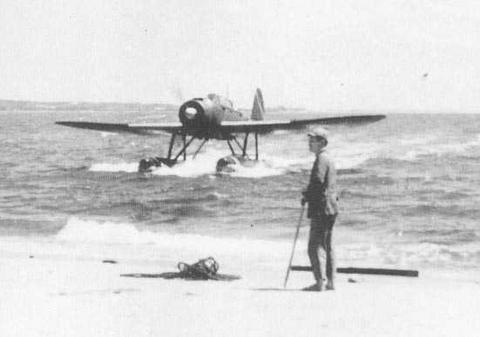
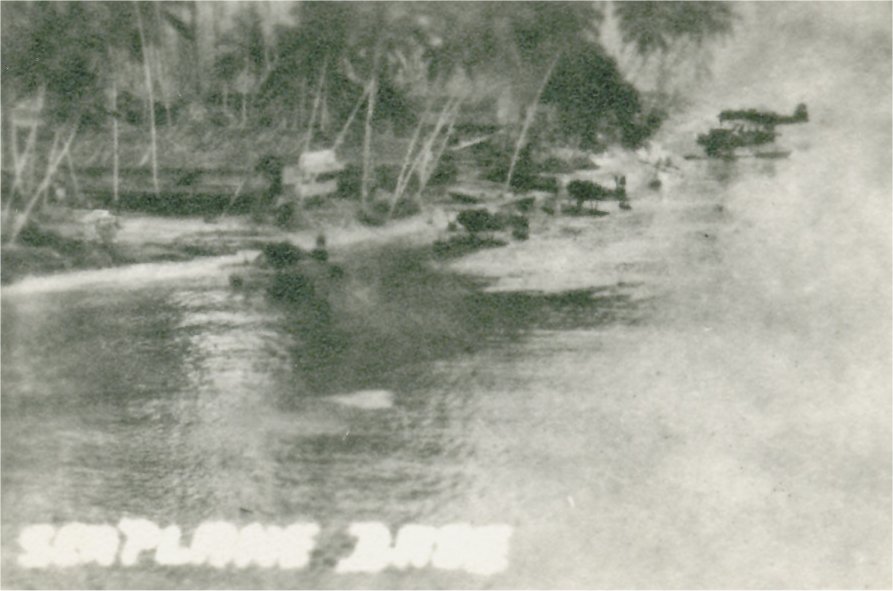
Numerous anti-aircraft guns were situated on both sides of the long, narrow channel where the floatplanes rested. The element of surprise no longer existed. The enemy guns seemed to be zeroing on me for my view on either side was filled with tracers. The effect was somewhat like entering a tunnel with arcing Roman candles flashing over your head. The thought crossed my mind that, normally, ammunition in that type of weapon was loaded with four regular rounds for every tracer and, surely, there were even more rounds heading my way than I could see! But, my mind and sight were now focused on the targets in front of me. I do not recall having fright or any real concern ...that came later! Youth and inexperience were in control of my emotions and good fortune was at my side. I walked my rounds into the row of floatplanes and saw the flashes of the strikes. Completing my attack, I turned to the right and, hugging the treetops of the island, started my exit. I looked back and counted seven burning planes.
As we came off the target area and about nine miles south of Shortland (Alu), Tom, Rex, and I all spotted what we thought was a Japanese destroyer. We bore down on the ship, which was broadside to use. Tom, to my right, attacked the stern; I attacked amidships; and Rex, bringing up the rear, attacked the bow. The strafing proceeded in a somewhat coordinated manner... at least we did not shoot each other down! Moore, Topoll, and the marine made their runs, as Tom, Rex, and I regrouped for another attack. We kept in touch by radio and positioned ourselves for each run. After several passes, the ship was in obvious trouble. It was listing, smoke was pouring out, and the hatch openings were jammed with sailors. The men topside wanted below to escape our [heavy] machinegun fire, while those below wanted topside away from the flames and smoke. It does not seem possible that a pilot actively engaged in an attack could see this detail. Yet, this vignette of the sailors struggling in the hatchways is very clear in my mind when many details of other combat missions are fading from memory.
It was on the last pass that Rex stayed on his firing run a fraction of a second too long. By the time he pulled up, Rex had lost over forty inches of his left wing on the radiomast! We returned to base without further incident. Our last view of the ship was of a vessel spewing smoke from bow-to-stern with a substantial list. We were informed the next morning that a recon plane had flown over the area and that "the destroyer had sunk." After the war, official Japanese records revealed that we had actually attacked Subchaser No.28, not a destroyer, and, "though it suffered numerous casualties and had been badly damaged", it had not sunk. On the same day as the mission, ComAirSols, Rear Admiral Mitscher, issued the following dispatch:
29008FIVE LIGHTNINGS ONE CORSAIR ATTACKED FLOATPLANE BASE FAISI AT 0620 SETTING FIVE TO SEVEN PLANES ON FIRE. EXCEPTIONALLY HEAVY AA OPENED UP AFTER ATTACK HAD BEEN MADE. ON RETURN OUR PLANES SIGHTED DD NINE MILES SOUTHEAST ALU ISLAND AND MADE REPEATED STRAFING ATTACKS LEAVING SHIP SMOKING. ONE LIGHTNING HAD THREE FEET ONE WING SHEARED OFF BY DD MAST WHICH ADVERSELY AFFECTED NEITHER FLYING QUALITIES NOR LANDING PERFORMANCE THIS PLANE. ALL PLANES RETURNED.
On April 1, we also received an airmailgram from Admiral Halsey, Commander, South Pacific Forces:
CONGRATULATIONS ON A NICE FAISI ROAST WELL DONE. WORTH THE TIP. REFER TO COMAIRSOLS 290008.Postscript: For their roles in their attack on the floatplane base at Faisi-Poporang, 1st Lt. Benjamin E. Dale, USMC, and 1st Lt. Joseph H. Moore, USAAC, received the Award of the Silver Star. Captains Thomas G. Lanphier, Jr. and Robert L. Petit, and 1st Lt. Rex T. Barber, USAAC, received the Oak Leaf Cluster to their previous Award of the Silver Star. 1st Lt. George G. Topoll, USAAC, received his official recognition posthumously. Topoll was killed in his Lightning as he attempted an emergency landing shortly after takeoff for an evening patrol on April 6, 1943.
KAMIKAWA MARU departs Truk for Rabaul escorted by light cruiser YUBARI.
1 April 1943: Operation "I-Go" - The Reinforcement of Rabaul: KAMIKAWA MARU arrives at Rabaul. She is reassigned to the Southeast Area Fleet in the 11th Seaplane Tender Division.
That same day, Admiral (Fleet Admiral, posthumously) Yamamoto Isoroku, CINC, Combined Fleet, orders aircraft from CarDiv 1's ZUIKAKU and ZUIHO to reinforce the 11th Air Fleet's base at Rabaul and CarDiv 2's HIYO and JUNYO to reinforce the base at Ballale Island, near Buin.
15 April 1943:
Reassigned directly to the Southeast Area Fleet.
18 April 1943:
Departs Rabaul with destroyers AKIGUMO and YUGUMO.
21 April 1943:
Arrives at Truk.
22 April 1943:
Departs Truk.
26 April 1943:
Recalled Captain-Retired Hara Seitaro [35] (former CO of KIYOKAWA MARU) is appointed the new CO. Captain Matsuda is reassigned and later is CO of TAIYO.
29 April 1943:
Arrives at Yokosuka.
14 May 1943:
Departs Yokosuka about 1300 (JST). Joins transports HAKOZAKI MARU and TONEI MARU to form convoy No. 3415.
22 May 1943:
Joined by the kaibokan OKI.
23 May 1943:
Arrives at Truk about 1400 (JST). Discharges aircraft, fuel, military equipment and bombs.
26 May 1943:
Departs Truk for Rabaul about 0900 (JST) with remaining cargo of provisions, canteen goods, preserved sake, general cargo and some passengers, escorted by subchasers Ch 12 and 37.
28 May 1943:
North of Kavieng, New Ireland. KAMIKAWA MARU is en route to Palau. At about 1000 (JST) she is attacked at 01-42N, 150-18E by a B-24 that is driven off.
255 nautical miles north northwest of Kavieng, New Ireland, near Emirau Island. KAMIKAWA MARU is attacked by LtCdr (later Rear Admiral-Ret) Walter G. Ebert's submarine the USS Scamp (SS-277). At 1203 (JST) at 01-42S 150-18E, in the midst of a heavy squall, she is hit by three torpedoes starboard side; the first in No. 1 hold, second amidships in the engine room and the third in No. 4 hold. She floods, loses engine power and begins settling by the stern. Attempts to take KAMIKAWA MARU in tow are unsuccessful. Abandon Ship is ordered and her crew take to the lifeboats.
[EDITOR: even if you have aircraft, they cannot necessarily fly in bad weather to protect you]
29 May 1943:
NNW of Kavieng, New Ireland. At midnight, KAMIKAWA MARU is attacked again by Scamp. At 0016 she takes another hit at point-blank range portside in her No.2 hold. The list increases rapidly and she rolls over to port. At 0021, KAMIKAWA MARU sinks with 39 sailors and 3 Army civilian employees at 01-36S, 150-24 E.
Captain Hara is KIA. He is promoted Rear Admiral, posthumously.
Scamp survives attacks by one of the submarine chasers escorting her, CH-12 or CH-37.
15 July 1943:
Removed from the Navy List.
Authors' Note:
[1] The survivors float in their dinghy for three weeks, finally getting ashore 260 miles to the south, where they become POWs. In 1945, shortly before the Japanese capitulation, the crew is executed.
[EDITOR: WHY WERE THEY EXECUTED? This is corrupt.]
Special thanks for assistance in developing this TROM go to Mr. Andrew Obluski of Poland and Mr. Jean-Francois Masson of Canada.
- Bob Hackett, Sander Kingsepp and Allan Alsleben.
EDITORIAL COMMENTS BY THE 1st TSG (A) STAFF
FEEDBACK!
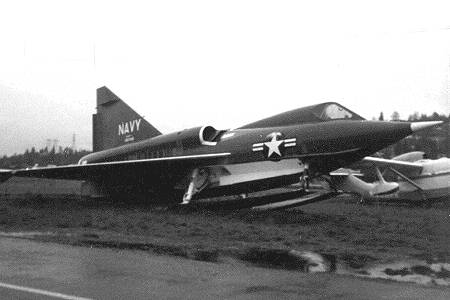
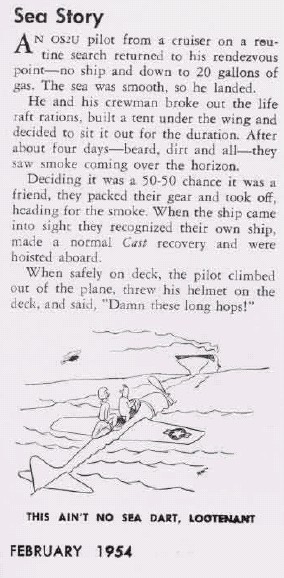
From CUNY web site:
Joe Bulloch
joecool.yeababy@sbcglobal.net
Sacramento, CA
"My Step-Father flew the OS2Us on the USS Tennessee 1942 to 1943. His name is William PENDOLA former Lt. Cmdr USN. We just celibrated his 87th birthday . When asked about the days as a pilot on the TENNESSEE during WW2 he replied 'I must have been crazy, there is no way I would ever allow myself to be shot off a catapult again. When your young , it`s all about the excitement'!
Anybody out there who knew him or was part of the maintenance crew who worked on the catapult or the Kingfisher itself , I would like to hear from you."
Simper Fi , Joe Bulloch
04/16/2006 @ 19:55
Jeffrey Schleifer
devmark@quixnet.net
Bridgewater, VA
"I work at Bridgewater Retirement Community in Bridgewater, VA. One of our residents is Dan Geiser who flew an OS2U off the USS Alabama during the battle of the Phillipines. On a search mission for downed fighter pilots Dan was awarded the DFC for rescuing a pilot. Dan remained in the Reserve, kept flying, and retired after a distinguished career as a professor at Bridgewater College, and and Dept. Head for Physical Education at American University. Any one remember Dan? He would like to hear from you through me. (devmark@quixnet.net)
01/27/2006 @ 13:22
Kevin Bonwell
kb747@insightbb.com
Dublin, IN
"My father Charles Bonwell was a Kingfisher pilot on the USS New York BB-34. He won the DF Cross w 7 clusters and the Air Medal during battle for Iwo Jima. He is now 81. Just wondering if there are any more New York crew out there.
Thanks,
11/27/2005 @ 18:21
Roy Lewis
rllewis@zoomlynx.com
Waynesboro, PA
"There's a nice Kingfisher on display at Air & Space museum outside of Washington D.C."
07/25/2004 @ 13:46
Bug Hunter
i_m_sharper@yahoo.com
Freeport, TX
"I am doing research on the remaining Kingfishers. There are at least nine still with us!!!!!!!!! Yanks Air Museum 'to be restored', Palm Springs Air Museun 'restored', Whale World, Albany, Western Australia, 'to be restored', Santiago`s Aeronautecs Museum, Chile 'Restored', Museo de la Revolucion, Havana, Cuba, 'Fixed gear' 'Restored' and the four other in the USA"
02/20/2003 @ 13:00
Si Reid
sireid@aol.com
CT
"My father-in-law was a Kingfisher Pilot off the North Carolina - Lt. White, W. K. Jr. He's now 86 and we'd like to know if there are any others out there He also flew the Avenger off the the USS Saginaw Bay after his tour on the North Carolina... same question as above.
If you write me, please indicate in the subject line, 're: Kingfisher or Avenger' or I will not open any response.
Thank you and Semper Fi (a former marine)
Si
08/07/2002 @ 23:11
John W. Juechter
jwjuechter@cox.net
East Greenwich, RI
"Plans for both 1/5 and 1/4 size OS2U's were available from a gentleman of Scotch descent living in Granby, Massachusetts. He also has plastic parts available."
